This page is nearly full and will soon be replaced by Media 2, now renamed Media as this page is archived.
Jewish Eurovision Transsexual Dana International Video – Video Results
Transsexual Dana International as Iconic Eurovision Singeraol.com
- 1:08Dana International back in Eurovisiondailymotion.com
- 0:29RTÉ One – Dana International on the #LateLatefacebook.com
- 0:58Dana International back in Eurovisionyoutube.com
- 10:30Dana International – Live @ Channel 3youtube.com
- 2:47Dana International Ding dong Eurovision 2011 Israel Official videoyoutube.com
- 2:59Eurovision 2011 Israelyoutube.com
- 1:55Eurovision Winning – BBC World Reportyoutube.com
Jewish Eurovision Transsexual Singer Winner – Video Results
Luke Kelly Sings ‘On Raglan Road’ – YouTube
Liza Veiga – A Whiter Shade Of Pale – YouTube
www.youtube.com › watch
Preview3:12May There Always
Be SunshineracruYouTube – 4 Feb 2007Preview4:24May There Always
Be Sunshine-
Russian Folk SongMiss Cindys MusicYouTube – 1 Apr 20203:32May There Always
Be Sunshine
German/Russian/
English …

Showing results for Green Fields of France video song
Search instead for Green Filelds of France video song
The Green Fields Of France – YouTubewww.youtube.com › watch5:584 May 2007 – Uploaded by anarchynotchaosSong by The Fureys and Davey Arthur. … Your browser does not currently recognize any of the video formats …
The Green Fields of France | Ireland’s Favourite Folk Song …www.youtube.com › watch6:3226 Apr 2019 – Uploaded by RTÉ – IRELAND’S NATIONAL PUBLIC SERVICE MEDIA… Folk Song bespoke performance of ‘The Green Fields of France‘ by … Your browser does not currently …
The Fureys – Green Fields of France – YouTubewww.youtube.com › watch5:5720 Sep 2014 – Uploaded by Video SongsEnjoy the videos and music you love, upload original content, and share it all with friends, family, and the …
Eric Bogle – The Green Fields of France – YouTubewww.youtube.com › watch6:315 Mar 2013 – Uploaded by Grant O’NeilA wonderful song by Eric Bogle expressing the futility of lives lost in the Great War. For a high … Your browser …
Finbar Furey & Christy Dignam – “Green Fields of France …www.youtube.com › watch3:2120 Jan 2017 – Uploaded by The Late Late Show
Liza Veiga – A Whiter Shade Of Pale – YouTube
Liza Veiga – A Whiter Shade Of Pale – YouTubewww.youtube.com › watch4:22Liza Veiga is a portuguese soprano singer. This is the video for “A Whiter Shade Of Pale” a legendary …9 Nov 2006 – Uploaded by Grupo Chiado
A WHITER SHADE OF PALE, Procol Harum Cover – YouTube
Van Morrison Purple Heather – YouTube
YouTube · Akeldama חקל דמא
Videos
2:47Cove – Purple
Heather (Wild
Mountain Thyme)
by Traditional …Cove AKA CovergeistYouTube – 18 Aug 20175:44Purple HeatherVan Morrison – TopicYouTube – 14 Apr 2017Preview2:56van morrison and
paddy reilly – will ye
go lassie go [wild …kieran owensYouTube – 10 Jan 2015Preview5:00ROD STEWART –
PURPLE
HEATHER.Electricchris1YouTube – 13 Mar 2012Preview5:48Van Morrison
Purple Heather (full
HD)Steve NoakesYouTube – 16 Dec 2015View all
Van Morrison Purple Heather | Van Morrison 30 Best Songs …www.telegraph.co.uk › … › Music › What to Listen to12 Apr 2016 – PURPLE HEATHER: Van Morrison’s cover versions of other artists form a … it was our arrangement of the McPeake song Wild Mountain Thyme.” Morrison once performed in London with the McPeake’s in a benefit concert for …Missing: video | Must include: video

VAN MORRISON-THE CHIEFTAINS – Raglan Road – bbc tv …
www.youtube.com › watchLyricsOn Raglan Road on an Autumn Day,
I saw her first and knew
That her dark hair would weave a snare
That I may one day rue.… MoreSource: MusixmatchAvailable on
“On Raglan Road” is a well-known Irish song from a poem written by Irish poet Patrick Kavanagh named after Raglan Road in Ballsbridge, Dublin. In the poem, the speaker recalls a love affair that he had with a young woman while walking on a “quiet street”. WikipediaArtists: Van Morrison, Paddy MoloneyAlbum: Irish HeartbeatReleased: 1988Genre: CelticOther recordings of this songOn Raglan RoadSinéad O’Connor · 1996Raglan RoadLoreena McKennitt · 2006On Raglan RoadThe Dubliners · 1999People also search forView 5+ moreStar of the County DownVan MorrisonMarie’s WeddingVan MorrisonCarrickfergusVan MorrisonVanlose StairwayVan MorrisonCrazy LoveVan MorrisonCeltic RayVan MorrisonThese Are the DaysVan MorrisonFeedback
Van Morrison – Raglan Road – original – YouTubewww.youtube.com › watch4:37Your browser does not currently recognize any of the video formats available. Click here to visit our frequently …31 Dec 2011 – Uploaded by vanthemanxx
Grave New World October 1st 2020
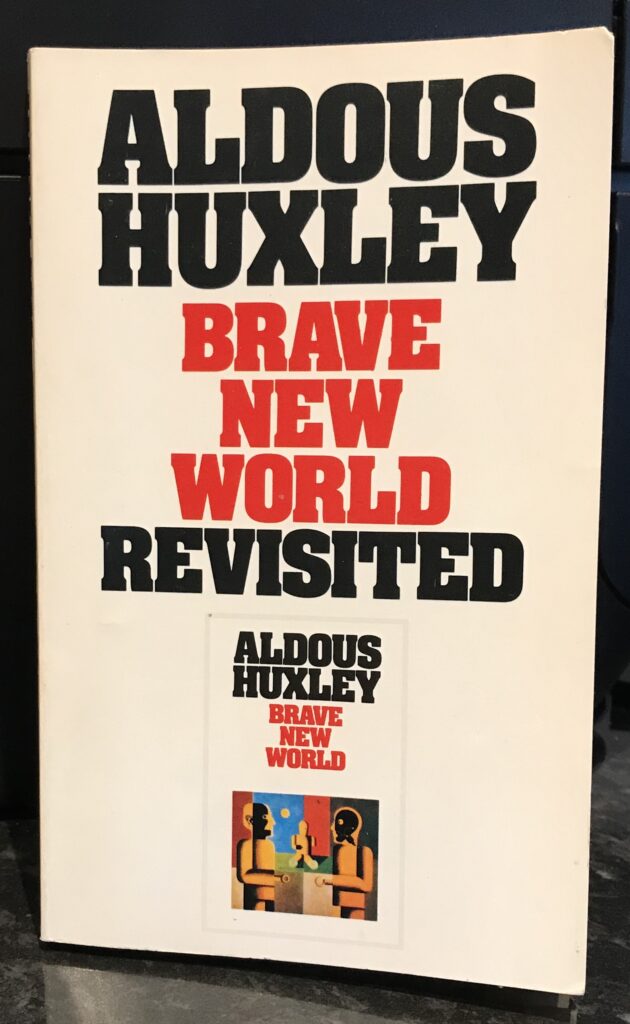
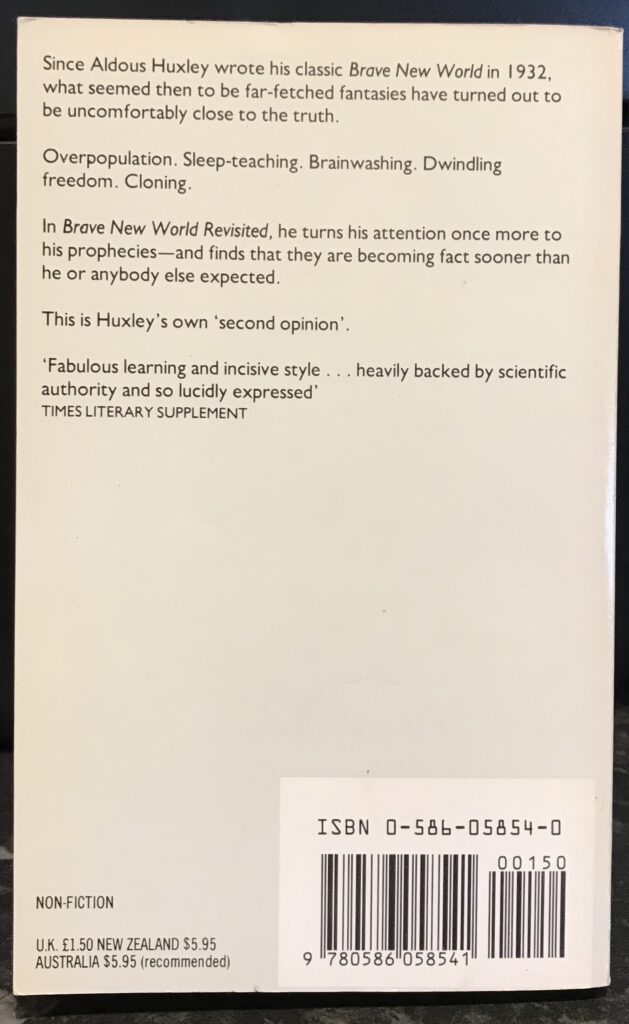
Chris Deerin: Impermeable self-belief of upper class a perilous trait as revolution gathers pace Posted September 30th 2020
by Chris Deerin September 22, 2020, 8:00 am

In the mid 2000s, I moved from Glasgow to London to join The Sunday Telegraph. I was daunted, and not only because I was about to enter the hallowed halls of Fleet Street.
I would be running the comment section of the High Tory bible, which was filled with illustrious names. I’d been told the weekly leader conference, which decided the paper’s editorial positions on the issues of the day, was attended by Charles (now Lord) Powell, who had been Margaret Thatcher’s chief adviser, and the historian Andrew Roberts. Both were posh, globally renowned, Oxbridge brainiacs. Powell even pronounced his surname “Pole”.

And now, um, me – a provincial state-school kid who had failed his journalism HND (record shops, girlfriend) and who had subsequently panicked his way up the ranks in Scottish newspapers. The gap, in my mind, was one not just of ability and experience, but of social class. It was like Sid Vicious joining the London Philharmonic.
There was only one thing for it – I bought a duffel coat. If I were to move into a world of Conservative grandees, of aristocratic scions and society gossip, of Boris Johnson and Auberon Waugh and Bill Deedes, then there was just enough of the chippy Scot in me to make a futile statement. I was a Hyndland indie kid on a crazy adventure, and I wouldn’t forget it amid the pinstripes.
The Telegraph, it turned out, was largely staffed by ordinary Joes. But there were plenty of Old Etonians and Oxford PPE-ers, too.
There were cut-glass accents and gentlemen’s clubs and country weekends. There was breathtaking social and intellectual self-confidence, some of it even justified.
The English gentry get nervous around gruff, sweary Scots, so I adopted a persona that was part Bill Shankly, part Taggart. I cajoled and argued and took the mickey. By the time I left, a decade later, I had found my place and, I think, acquitted myself well enough.
But I never quite got used to, or bridged, the class divide. I was never going to, of course. Our work experience kids had names like Peregrine and Camilla, and were often louchely arrogant.
My better-off colleagues glided through life. The wealthy upper classes live and work differently – a job is a way to pass the time or to fulfil their inevitable destiny, not a lifeline between survival and catastrophe. There is often an easiness, a lightness, to them.
Sasha Swire’s fatally indiscreet diaries of life in David Cameron’s clique, published this month, bring much of it back. “Diary of an MP’s Wife” is a view from the inner circle of the gilded few, displaying all the snobbishness and entitlement that is so intolerable to the rest of us.
For people like the Swires, politics is a game in which the fate of the little people is rarely the first priority. Rather, it’s about social standing and getting your due.
Sir Hugo Swire, Sasha’s husband, is an Old Etonian and former Army officer. Under his pal Cameron, he held middle-ranking jobs at the Northern Ireland Office and the Foreign Office, but climbed no higher, much to the couple’s chagrin.
Sasha at least has some self-awareness. Looking round the Camerons’ Christmas party in 2011, she observed: “We all holiday together, stay in each other’s grace-and-favour homes, our children play together… There are old rows, forgiven betrayals and historic rivalries. This is a very particular, narrow tribe of Britain and their hangers-on. It’s enough to repulse the ordinary man, already angered by the continuing hold of the British class system.”
After Brexit forces him from Downing Street, notes Sasha, “Dave is making loads of money, and has no interest in taking on a big public job like Nato. Lots more time to chillax, put on weight and play the golf courses of the southern states of America… As for all the dosh, he says every time he looks for a loophole to stash it away, he realises that George and he closed it, and laughs.” It’s hard to imagine Gordon Brown cracking that gag.
Since the end of the last Labour government Britain has regressed weirdly in terms of who holds power. The upper classes have reasserted their right-to-rule. Cameron and Boris Johnson, especially, have governed with a coterie of the privileged. Both men have their talents but, at their worst, have shown the worst aspects of their class – condescension, cockiness and, unfortunately for the rest of us, catastrophically bad judgment cocooned by impermeable self-belief.
This is a dangerous game. Around them a revolution is taking place. The statues of the historical British Establishment and its empire are falling. Campaigns for minority rights have descended into brutal and saddening culture wars. The Covid-19 crisis has exposed both the possibilities but also the ineptitude of government. The Union wobbles. The class problem plays an integral part.
We have a right to expect merit, integrity and empathy from our rulers. Self-interest and blithe indifference to consequences cannot be squared away by charm and rhetorical optimism. Frankly, it all makes me want to don my duffel coat and head for the barricades.
Covid Mad Britain September 29th 2020






Major International Banks Involved in Money Laundering Schemes September 26th 2020



More to come later, on economics page.
Reading Matters September 22nd 2020
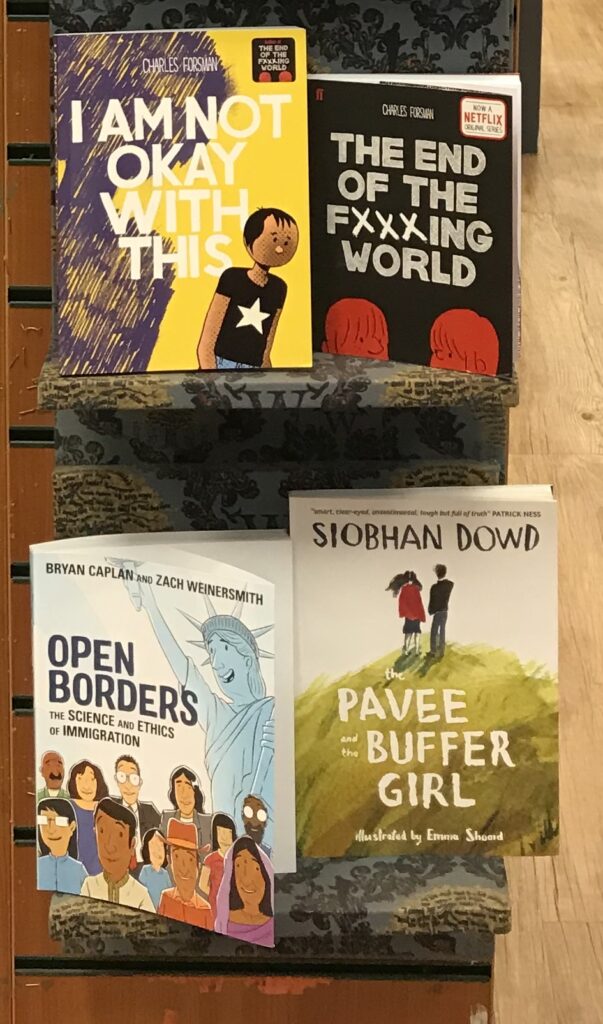
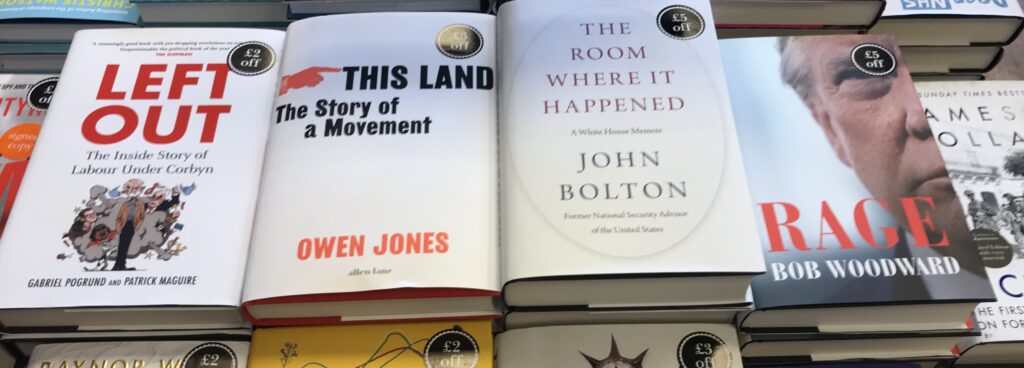
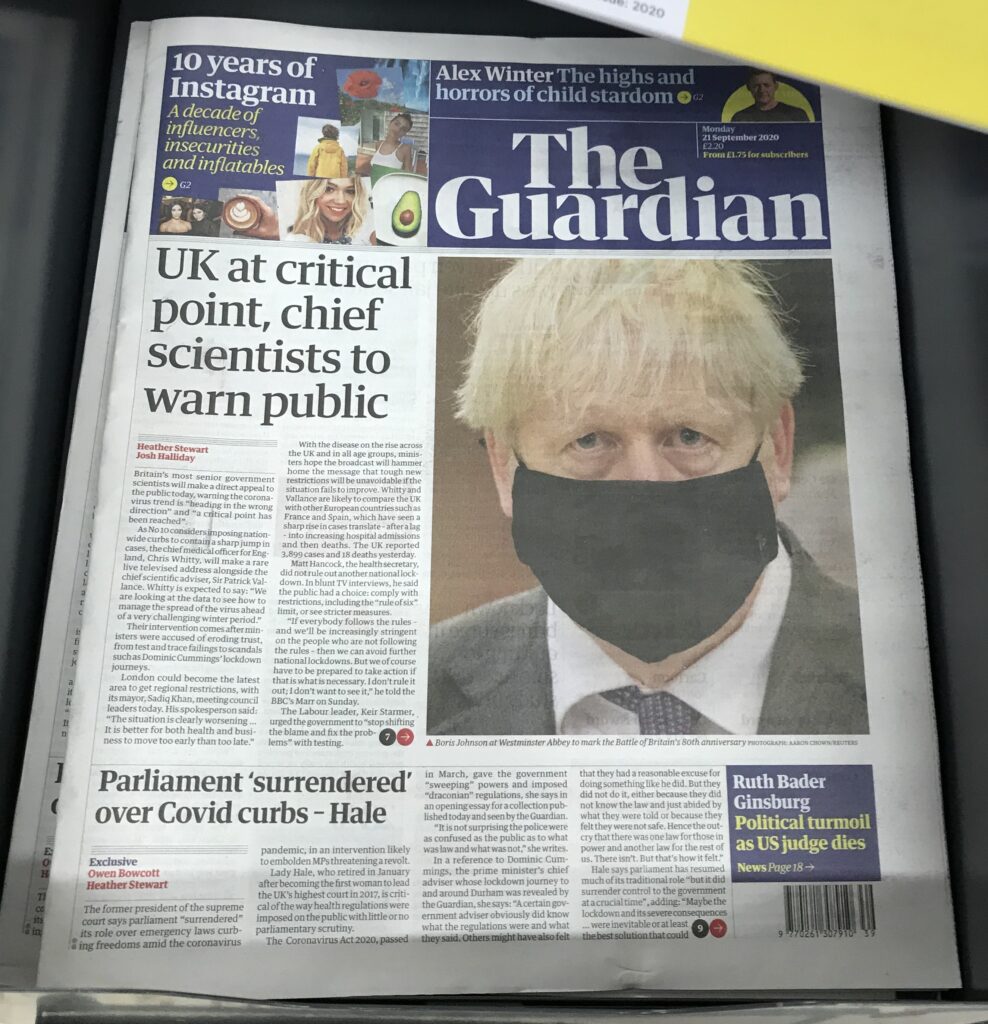
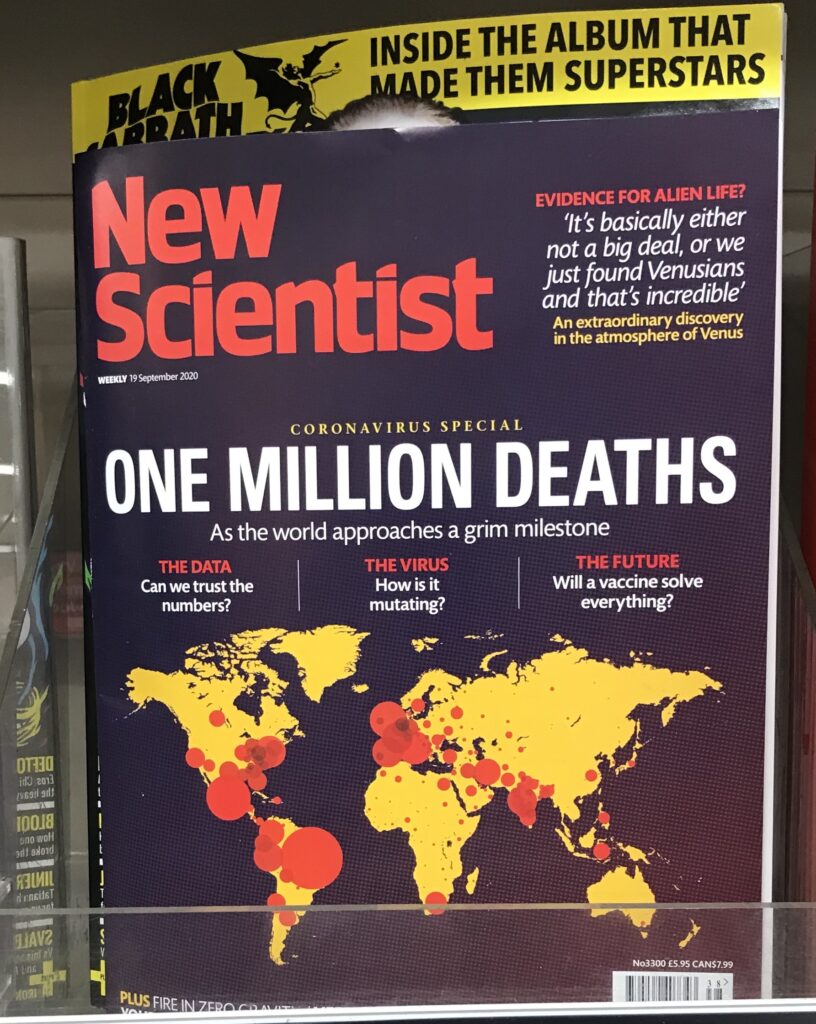
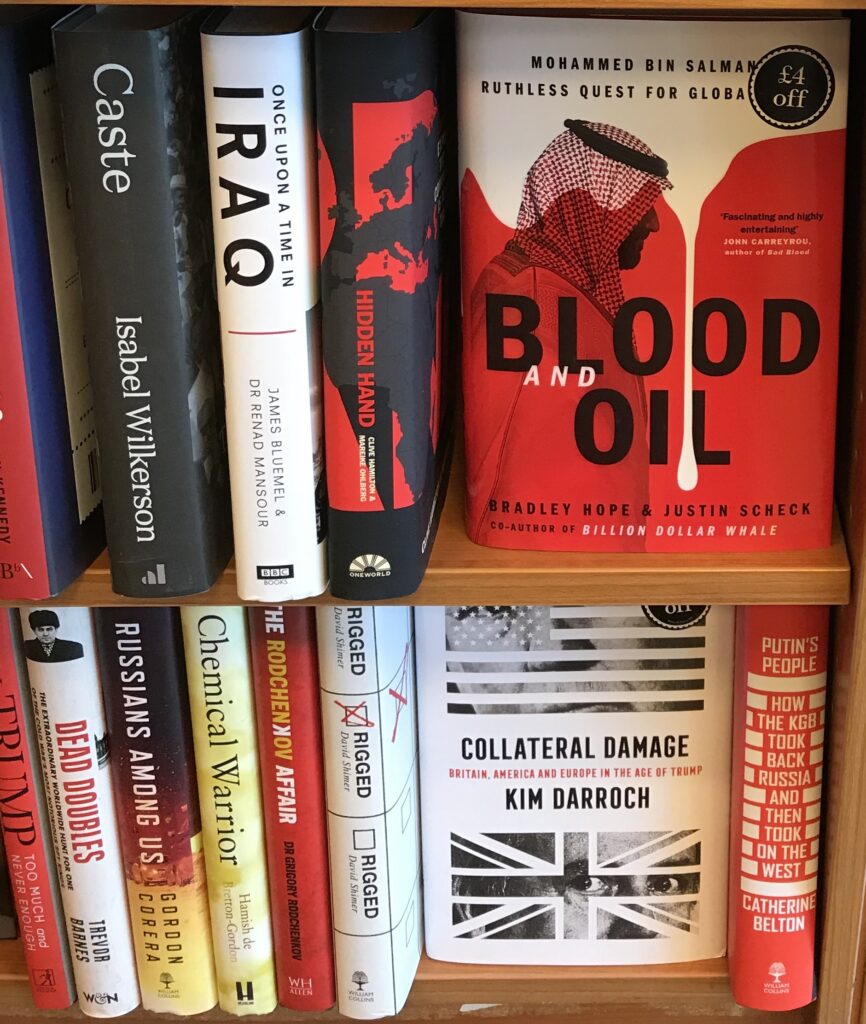
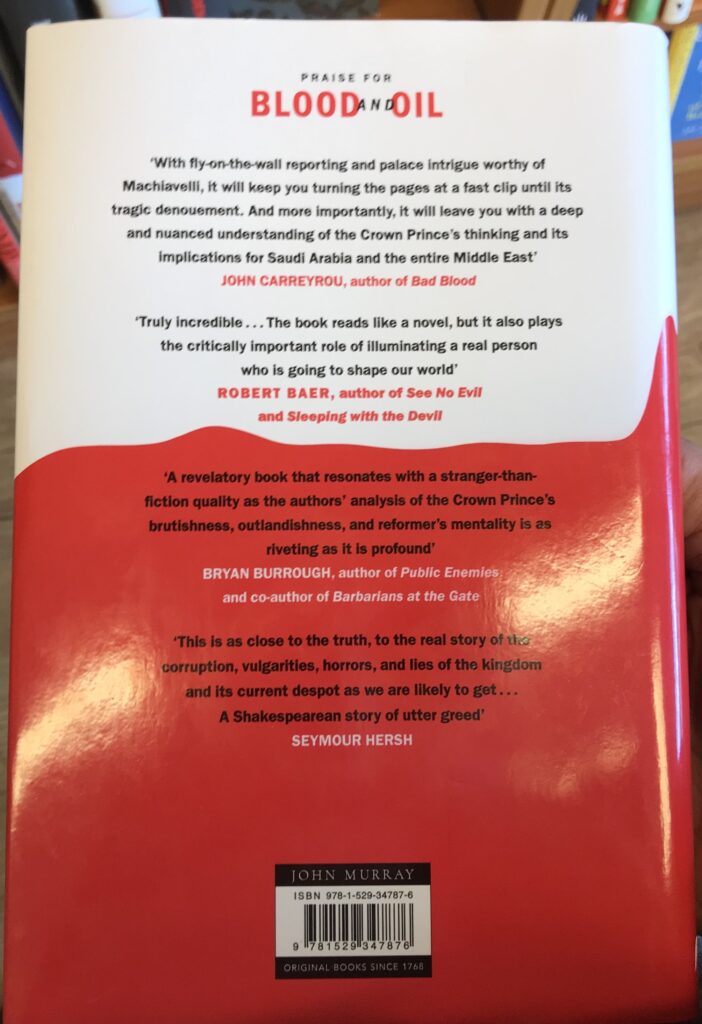

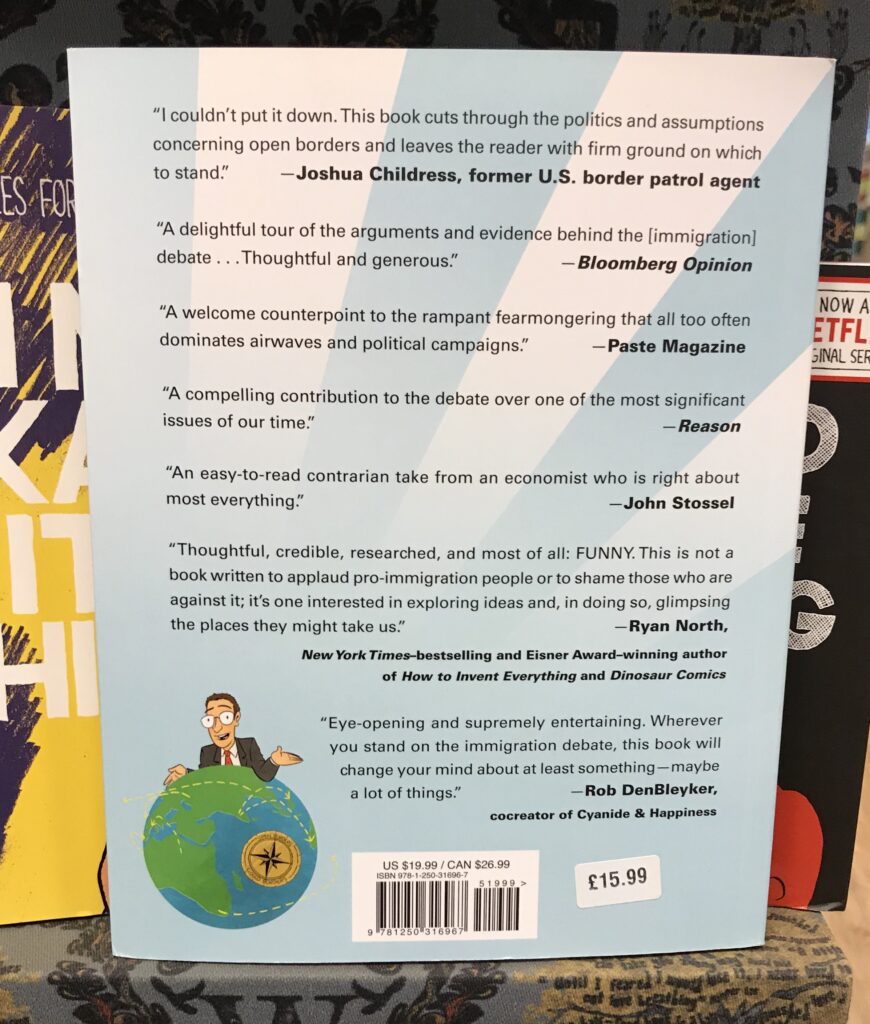
Covid 19 The Hidden Agenda and The Tabloids September 21st 2020

Second Wave is Coming Asserts Boris ‘Karloff’ Johnson and his right handy man Matt Handycockup. “Nothing feels so good as a good handycockup” says Roberta Jane. September 19th 2020

Boris Johnson is a big disappointment with his bombastic windbag Churchill fanatsies.
Boris just follows his pseudo science advsiers, along with the
( Third )World Health Organisation ( TWHO ). These smug selfrighteous self important morons have created a juggernut of destructive stupidity and fear. R.J Cook.
Image Appledene Photographics/RJC

Roberta Jane Cook ‘s Image by Mustafa Khalid

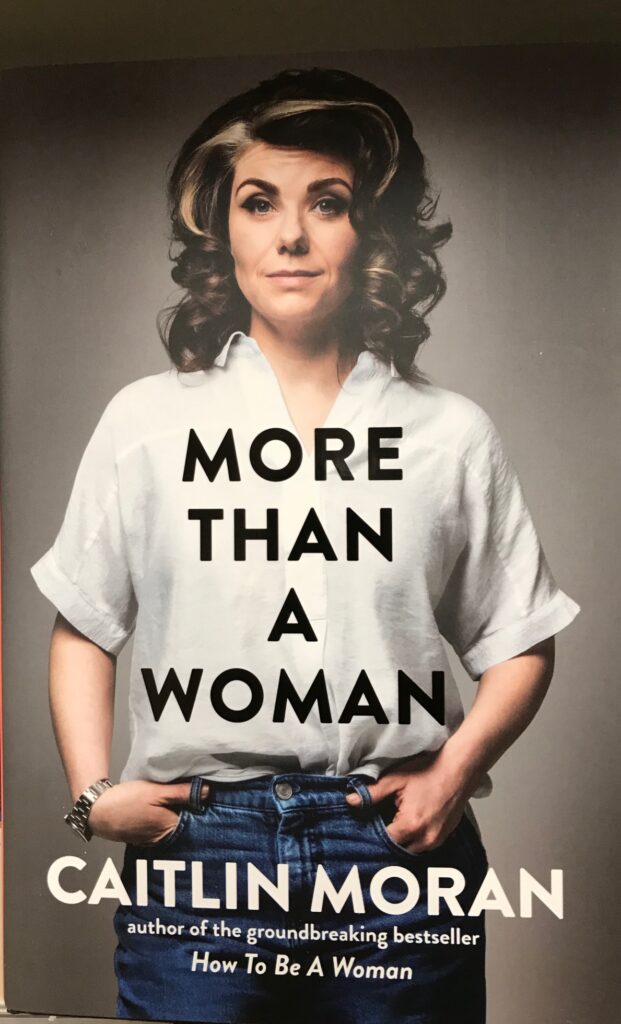
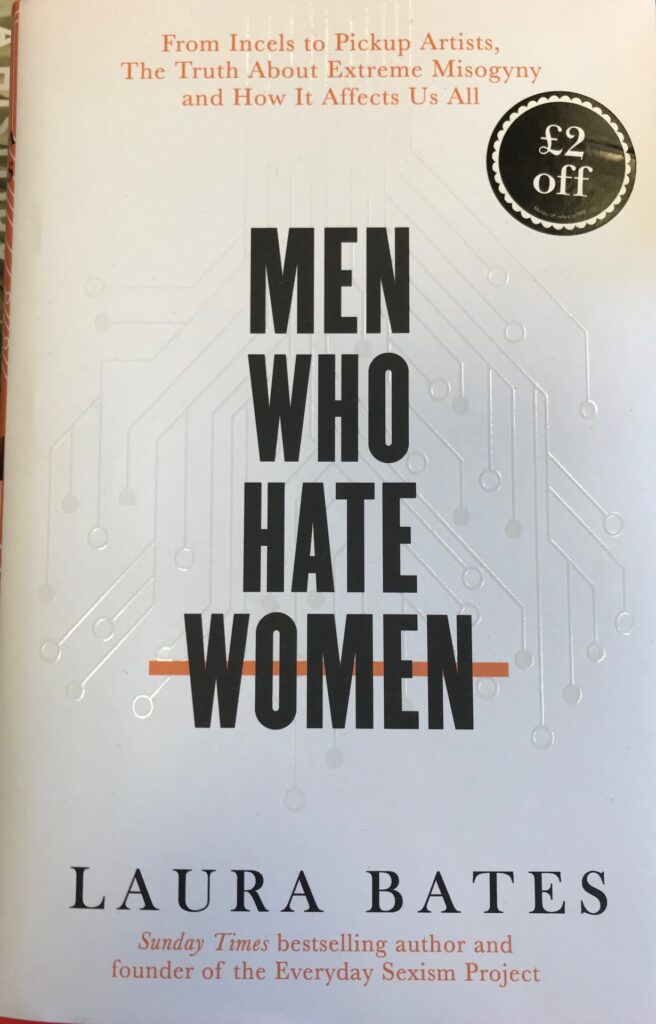
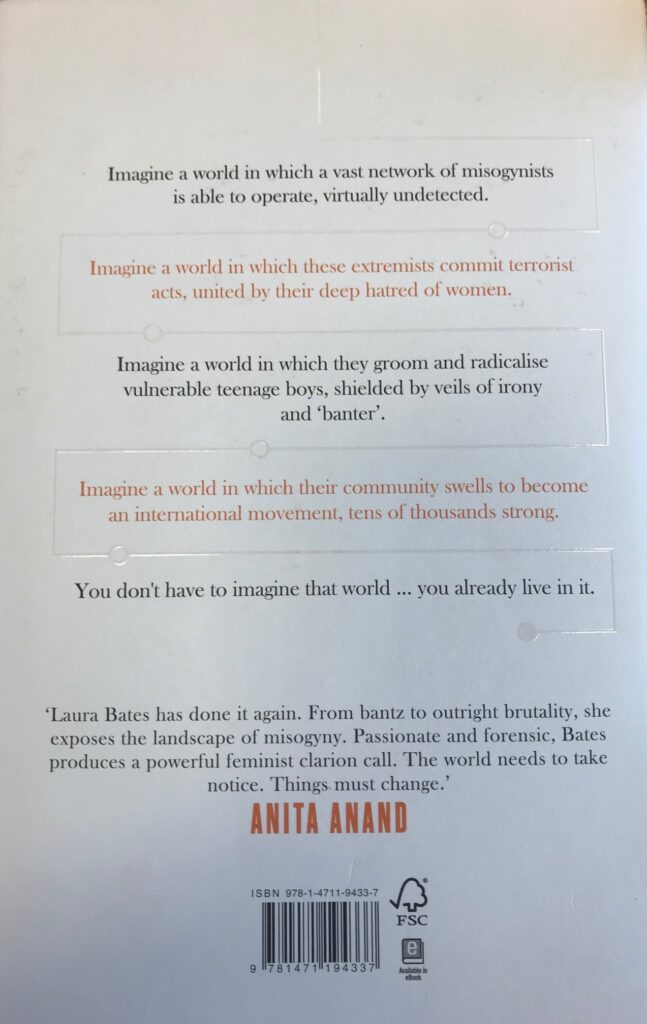
The Man Who Wanted Everything Posted September 17th 2020
A gossipy, rackety, roller-coaster history of Rolling Stone and its founder, Jann Wenner.
- James Wolcott

Jann Wenner and Elton John at a party hosted by Bette Midler at the Waldorf Astoria Hotel, New York City, October 2005. Photo by Patrick McMullan / Getty Images.
The first issue of Rolling Stone to bop me between the eyes at the newsstand bore a black border on the cover. It framed an obituary portrait of the guitarist Jimi Hendrix, the quantum mechanic of psychedelic rock, who had died of an overdose of barbiturates or sleeping pills at the age of twenty-seven, an early extinguishing more befitting a Romantic poet. The next issue of Rolling Stone also carried a black border, this one memorializing the blues rocker Janis Joplin, the queen of husky catarrh, whose death mirrored Hendrix’s: overdose at age twenty-seven. It was 1970, and a scant three years after the Summer of Love the counterculture was filling the coffins.
Founded in 1967, based in San Francisco, Rolling Stone was in the hairy thick of the tribal youth tumult, reporting on hippie hedonism, radical protest, and, in a notorious cover story, the floating seraglio of rock groupies whose thrift-shop splendor and Twiggy eyelashes made them style icons for those seeking backstage passes. But other publications were also bumming it to Haight-Ashbury and rolling around in “dope, sex, and cheap thrills.” It was in its formal expressions of generational mourning, its neo-Victorian decorum in honoring its fallen heroes, that Rolling Stone found stature and distinguished itself from the kaleidoscopic collage of underground papers and New Left organs on the news racks. Addressing a national audience instead of just a fervent sect, Rolling Stone made itself the designated mourner of rock royalty, the grief counselor of Woodstock Nation, and keeper of the tablets. A year later, Jim Morrison of the Doors would be framed in a black border on the cover, the Lizard King having reached the fatal cut-off age of twenty-seven.
My freshman impression of Rolling Stone may have been unduly inked in grim tidings, yet it’s remarkable how often in Sticky Fingers, Joe Hagan’s gossipy, rackety, roller-coaster history of Rolling Stone and its founder, Jann Wenner, death rouses the magazine from its fortnightly routine to a reckoning moment. When John Lennon was murdered in December 1980 in front of the Dakota, where he lived with wife, Yoko Ono, Wenner, who had featured Lennon on the cover of Rolling Stone’s debut issue (and later, to spectacular effect, put a nude John and Yoko on the cover, an instant sellout), was as distraught and unstrung as anyone—“up all night making phone calls to friends, trying to make sense of it like everyone else,” and attending the impromptu vigil in Central Park with other fans, then pulling himself and his staff together to assemble a tribute issue that would be a fitting burial shroud.
“For the first issue of the Reagan presidency, Wenner put [photographer Annie Leibovitz’s] image of John Lennon wrapped around Yoko Ono on the cover without any text other than the logo. Every page was dedicated to John Lennon,” including inside the seam of the magazine’s binding, where Wenner published a private message to Lennon that, as Hagan notes, could be read only with a magnifying glass. “The January 22, 1981, issue of Rolling Stone was Jann Wenner’s single greatest triumph as a magazine editor and a sculptor of rock legend,” Hagan writes. “It was an homage to a man but also to a time and to a generation.” Under such crisis conditions the two jostling journalistic modules of Wenner’s personality—the idealistic fanboy who wanted to swing with the stars and the kingpin whose ambition, he once confided to an associate, “was to become the Henry Luce of the counterculture,” the print tsar of the enlightened rabble—joined together to produce greatness.
A complicated character without being inherently interesting, Wenner, a Berkeley dropout who found a spot on the iconoclastic radical monthly Ramparts and worked on the spinoff Sunday edition that would become the prototype for Rolling Stone, was fundamentally a hustler who knew when to pounce, a Machiavellian intriguer with the ravenous munchies, an opportunist whose antennae told him when something was about to break big in the mainstream (such as Saturday Night Live in 1975).
Hagan’s biography is a tireless account of a velociraptor appetite. Wenner’s was omnivorous—for fame, glory, sex, drugs, food (in a ravenous frenzy, he once ate frozen food straight out of the icebox and was sped to the hospital when it expanded in his stomach, like some David Cronenberg beast), social status, cultural recognition, political clout, and luxury furnishings—and in its chewy path of creative destruction there was a notable absence of what the cultural theorist Irving Babbitt called the “inner check.” Wenner was capable of great strokes of generosity, such as footing the hospital bills for a Rolling Stone editor sick with AIDS, but primarily he put himself first at the feeding trough. In the advertising-plush heyday of Rolling Stone, Wenner, discarding his scruffy origins, “intended to live like a sultan.” That meant a full-time driver, a Downton Abbey staff of servants and nannies, a $4.2 million brownstone in Manhattan, a Georgian manor in the Hamptons, and a private jet (a Gulfstream II, eventually upgraded to a Gulfstream IV).
Satchel Paige’s evergreen piece of advice—“Go very light on the vices, such as carrying on in society. The social ramble ain’t restful”—is one to which Wenner paid no nevermind in his pursuit of more-more-more. Sticky Fingers offers a comprehensive record of personal and business betrayals, double-dealing, excursions into the polyamorous (Wenner and his wife Jane, a major influence on him and the magazine, both detoured into same-sex dalliances), showboating, and bingeing that leaves former friends and associates for roadkill and takes a toll on Wenner’s beanbag constitution. After attending the funeral of one of comedy’s most ballistic talents and overindulgers, John Belushi, who had died of an overdose after a night of hard partying at the Chateau Marmont, Wenner was hospitalized with a gallbladder infection: “He had grown fat and unhealthy, bloated from alcohol and cocaine abuse, which exacerbated his psoriasis.” No, the social ramble ain’t restful, and Wenner’s accelerated dissipation was proof that the rock star lifestyle is best left to the pros, who learn how to pace themselves between tailspins with carcasses intact. Keith Richards, take a crooked bow.
The cult of the male rock star as Dionysian codpiece, vaunted oracle, or guitar-wielding thunder god has fizzled out in this century, thank goddess, but it was formative in forging Wenner’s ideal of the perfect make of stardom he aspired to hang with and cultivate. Rock chicks need not apply. (Hagan notes how Joplin, Joni Mitchell, and other female artists were sexistly slagged off in Rolling Stone’s columns.) Wenner courted the crafty, misanthropic Bob Dylan, befriended U2’s Bono, the Who’s Pete Townshend, and Bruce Springsteen, and won over John Lennon, scoring the coup of the revelatory “Lennon Remembers” interview of 1970, in which the former Beatle, having recently undergone Arthur Janov’s “Primal Scream” treatment, torched his former bandmates (“the biggest bastards on earth”), their fans (“idiots”), and the con job that was Sixties idealism (“nothing happened except that we all dressed up”). Lennon, however verbally candid he might be, maintained an ascetic aloofness that Yoko tended with an iron touch. Not so the elusive yet attainable butterfly who flutters most tantalizingly through these pages—that eternal tease, Mick Jagger. (Hagan’s book takes its title from the 1971 Rolling Stones album whose original cover, designed by Andy Warhol, fronted a tight pair of jeans with a working zipper that housed a prominent bulge that, erroneous rumor had it, belonged to Jagger.)
As in so many rom-coms, the Jann-and-Mick relationship was initially sparked by an irritable spat: “When he first saw it, Mick Jagger was startled by the audacity of Rolling Stone—to name a newspaper after his band and not even put the Rolling Stones on the cover of the first issue? It was an affront that would stick with Jagger for the next fifty years.” Adding insult to affrontery was Jon Landau’s scornful pan of the Stones’s wobbly magic-carpet-ride LP Their Satanic Majesties Request and the complete dearth of cover stories on the band while the Beatles were given darling preference. A former student of the London School of Economics, Jagger knew how to exploit an opening to maximum advantage and hung a threatened lawsuit for copyright infringement over Wenner’s woolly head, an excellent way to hold someone’s attention. In 1968 the Stones were mixing their next album, Beggars Banquet, in Hollywood:
Wenner arrived bristling with bonhomie, eager to win Jagger over for an interview and to broach the sticky issue of the Rolling Stone trademark. After Wenner scribbled detailed notes about the new album, Jagger invited him back to his rented house in Beverly Hills, where they listened to an acetate of the first album by the Band, Music from Big Pink, ate pizza and talked business. Wenner was in heaven, basking in Jagger’s luminous stardom.
Jagger proposed that Wenner come to London to discuss the possibility of publishing the British version of Rolling Stone, with Jagger as half owner. In business with Mick! What could be more loverly?
The British cousin of Rolling Stone was a ham-fisted botch, a rack rag heaved into the printing presses with an almost contemptuous lack of oversight. Not only did Jagger’s editorial staff manage to misspell the name of the Kinks’ Ray Davies in a headline—sacrilege!—but it bungled the spelling of Bob Dylan’s name too. Wenner flew over to London to instill some professional rigor in the enterprise, but was basically given the piss-off by Jagger’s pirate crew, whose antics escalated from carelessness to reckless endangerment. The staff hosted a record-industry party where the punch bowl was spiked with LSD, propelling several guests on bad acid trips to the hospital, including T. Rex’s Marc Bolan. Jagger, off shooting the kangaroo western Ned Kelly in Australia, was blithely indifferent to the shambles he had left behind, leaving Wenner to do all the fuming. The plug was finally pulled on Rolling Stone UK, and the lopsided partnership ended.
Jann and Jane Wenner at home in San Francisco, December 1970. Photo by Robert Altman.
Shortly after, the Rolling Stones would perform a free concert at Altamont Speedway that would be one of the defining vampire stakes of the decade. Once again, death was the spur. A young man named Meredith Hunter was fatally stabbed by Hells Angels whom the Stones had fecklessly hired to provide security. Long before New York Times editor Howell Raines popularized the phrase “flooding the zone,” Wenner executed the drill, putting all the resources of Rolling Stone into action to cover the debacle, eleven writers in all: “Even the record critics, like Lester Bangs and Greil Marcus, were conscripted into service.” It was both a major fact-finding mission and a fault-finding inquiry fueled by reportorial urgency and personal payback. The special issue was Rolling Stone’s coming-out moment as a major journalistic contender; in The New York Times, pop essayist Albert Goldman compared its scale and detail to “a muckraking masterpiece on the Robber Barons.” And the biggest mucker was Mick. Hagan writes: “Through an alchemical mix of petty business grievance and self-preservation, Jann Wenner nailed Mick Jagger’s hide to the wall with vindictive aplomb.”
Jagger’s hide was too nimble and slithery to stay nailed for long. He wouldn’t have the longevity he’s enjoyed in show business if he wasn’t cagey, adaptable, and fluent in the art of wooing. It was in both their interests that the rupture be mended, and Jagger made the opening move, inviting Wenner to be the first earthling to see a screening of Performance, in which he was making his film acting debut in a hothouse tale of louche criminality, androgynous couplings, and heavy lipstick applications. Rolling Stone’s staff was furious at what they saw as a pandering about-face from their fearless leader. Their vote didn’t count:
However hypocritical he appeared, Wenner wasn’t interested in further alienating Jagger. It was an astute business decision. Mick Jagger would be the most important and iconic face in Rolling Stone’s history, appearing on more Rolling Stone covers than any other artist (thirty-one times), always a consistently high seller.
Eventually, Wenner and Jagger enjoyed a mutually beneficial bromance, with Jagger visiting Wenner’s apartment to inhale coke and partake in jam sessions, Wenner and his wife Jane vacationing with Mick and Bianca Jagger in Barbados. Advancing age does not fade Wenner’s infatuation: “A man in his sixties, Jann Wenner still liked to go backstage at Rolling Stones concerts, flip through Mick Jagger’s costume rack, and squeeze into a pair of the singer’s pants. ‘They don’t quite fit me that well,’ he admitted.” Perhaps not, but getting into Jagger’s pants at all must be something of a dream fulfilled.
Like Harold Hayes’s Esquire, Willie Morris’s Harper’s, and other New Journalism rocket launchers of the 1960s, Rolling Stone provided an expansive stage for a succession of keyboard virtuosi whose high-velocity prose and/or incredible access to their subjects turned their appearances into events. Nearly all of these wordslingers were men: among them, Cameron Crowe, the wunderkind who covered the Allman Brothers on tour when he was sixteen and went on to become an accomplished screenwriter-director (Jerry Maguire, Almost Famous, Vanilla Sky); rock critic mandarins Greil Marcus and Paul Nelson; Republican party animal P.J. O’Rourke; David Foster Wallace, who hit the 2000 presidential campaign trail with John McCain; the Edwardian dandy of Céline ellipses and leaping italics, Tom Wolfe, whose novel Bonfire of the Vanities was feverishly dashed off Dickens-style as a serial for Rolling Stone; not to mention authors going for a muskier persona, such as fur-bearing Joe Eszterhas, future screenwriter of Basic Instinct and Showgirls, who had a buck knife strapped to his leg in case of an Apache attack in the elevator. Eszy had no time for schoolmarm writers. When editor Marianne Partridge pitched feminist writer and activist Ellen Willis’s article on rape at an ideas meeting, relates Hagan, “Joe Eszterhas snickered and said, ‘Why don’t you just lean back and enjoy it and it wouldn’t be a rape?’” To his credit, Wenner didn’t laugh, OK’d the article, and gave it considerable placement in the magazine.
In his hombre bravado and disregard for letting trifling facts get in the way of a ripping yarn, Joe Eszterhas was following in the burnt rubber tracks of Hunter S. Thompson, the original gangster of gonzo journalism, whose chemically induced epic jag of dissociation, Fear and Loathing in Las Vegas, illustrated by Ralph Steadman with what looks like blood jets of ink, set so many writers on a wayward course of sensory overload and rampant overwriting. Thompson’s brilliance in Fear and Loathing was inimitable, a perfect storm of writer, subject, locale, scurrilous attitude, and zeitgeist, a feat Thompson rode into legend but found impossible to top, apart from extended flashes in Fear and Loathing on the Campaign Trail ’72. But through the meat of the 1970s, he and Wenner made the perfect team, a pair of users complementing each other to produce a powerful noise in print, the Don Simpson–Jerry Bruckheimer of journalistic showmanship.
It was too incendiary a partnership of monomaniacs to last: Thompson chafed under Wenner’s cheapskate niggling while Wenner steamed over Thompson’s ballooning expenses and diminishing output, assisted by Thompson’s prodigious drug intake. Hagan writes: “Cocaine became part of his writing life, which soon became a non-writing life.” Dispatched by Rolling Stone to Zaire to cover the “Rumble in the Jungle” championship fight between Muhammad Ali and George Foreman, Thompson “dumped a bag of pot in the hotel swimming pool and floated around in it, missing the fight entirely.” The trip cost Rolling Stone thousands of dollars and yielded nothing publishable. (By contrast, Norman Mailer, there covering the same bout for Playboy, bashed out what became one of the very best examinations of boxing as an existential test, The Fight.)
Cocaine is an ego drug, and Thompson’s ego, already straining at the seams, biggened into full-blown grandiosity as he played being Hunter S. Thompson to the hilt, pulling malicious pranks, firing off his .44 Magnum, engaging in cryptic streams of Kurtz-in-Heart-of-Darkness mumbling, and basking in his own words being read aloud to him by, among others, film star and devotee Johnny Depp. Living up (or down) to his own legend wasn’t really living; it was a carny act requiring ever-gaudier stunts. Creatively desiccated, chronically ill, depressed, aging fast, Thompson found no way out of his condition except for the one F. Scott Fitzgerald called the Big Out. He would go out with a literal bang. When Thompson committed suicide by gunshot to the head in 2005, it was treated less as an American tragedy (as Hemingway’s suicide was) than as the most Hunter S. Thompson exit he could have made, the inevitable capper. The private memorial service in Colorado, presided over by Wenner, was a “multi-million-dollar bacchanal” paid for by Depp.
A year later, Wenner presided over another bacchanal, his own. He threw himself a gala birthday party whose guests included Yoko Ono, Bette Midler, then Senator John Kerry, and Hamptons neighbor Larry David. The hosts were Wenner’s wife Jane and his lover (later husband) Matt Nye, the latter’s presence prompting a drunken Robin Williams to launch into a raunchy riff about Jann and Matt doing their own Brokeback Mountain do-si-do as a pair of “rump wranglers” out on the “jizzum trail.” Al Gore, man of probity, tried vainly to put a stop to this spew, but Williams was undeterrable, and Wenner himself loved the routine. He was quite regaled: “Indeed he had never been happier—that is, until Bruce Springsteen got up and performed a song he wrote especially for Jann Wenner.” Being serenaded by the Boss must have made Wenner hug himself in his mind, to borrow a line from James Boswell.
For many, this evening would have been the capper to a life and career, the golden fade-out in a personal highlight reel and a fitting finale for an American success story. But Wenner’s appetite for greater fame, wealth, reach, and brand extension continued to rumble. He bought a nearly $6 million Gothic Revival manor in upstate New York, chopping down hundreds of trees without a permit to afford himself a baronial view of the Hudson River, a detestable deed. He made plans for an international chain of Rolling Stone hotels, whose flagship resort in Las Vegas would feature a “Gonzo Club” and a musical version of Fear and Loathing in Las Vegas, with animatronic lizards just like the ones in Thompson’s hallucinations. “The groundbreaking was scheduled for late 2008.”
2008 had different plans in store. The financial crisis of that year blindsided Wenner, as it did most of Wall Street and the world, and Wenner’s personal and business holdings took a huge gut punch. The value of Wenner Media (Rolling Stone, Men’s Journal, Us Weekly) imploded. The international hotel project was shelved. Compounding the crisis was a $300 million debt load Wenner had taken on in a buyback of his former stake in Us Weekly, which he had sold to Disney. Hagan writes: “Like the banks that once showered him with low-interest cash, Wenner had badly overleveraged himself and lived as if there were no tomorrow, and then tomorrow showed up like a motherfucker.” That may not be how they discuss financial issues in Barron’s, but it does get the point across. Draconian cost-cutting was instituted at Rolling Stone. The size of the magazine shrunk, and Wenner had to kiss his Gulfstream goodbye and fly in the plebeian discomfort of commercial airlines.
Even in its spartan condition Rolling Stone was unable to make a sharp rebound because the aftershock of the financial crisis coincided with the rising mind-share of digital websites and social media, which left legacy titles fighting for their very existence. Then, when the magazine was at its most rickety, in 2014, came a near-fatal body blow: an exposé of an alleged gang rape by a posse of fraternity brothers at the University of Virginia. The story was harrowing in its details and caused a national outcry. Problem was, it was a phantasm. It took only a little digging for the account of events that night to unravel. A reporter from The Washington Post investigating the incident found a slew of inconsistencies and blank walls. “Simple fact-checking queries were proving that no fraternity party had occurred on the night in question.”
No profile in courage, Wenner confronted the crisis by heading off to Sun Valley and skiing for sixty days, an ostrich burying its head in the snow. Libel lawsuit begat libel lawsuit, and no sooner was one of them settled (with the UVA fraternity for $1.65 million) than calamity struck. Wenner fell while playing tennis with his son Noah and broke his hip, then had a heart attack: “He would need a triple bypass operation and a hip replacement.” Wenner would survive the procedures, just as Rolling Stone would survive its damaged credibility and legal ordeal, but the golden years have gone a little gray and prospects will never be as bright again for any of us fortunate wretches who grew up on print, vinyl, cathode tubes, and silver nitrate.
It’s understandable that Hagan is a bit winded when he gets to the final furlong of his biographical journey. I was feeling pretty beat myself. All those interviews, all those anecdotes, all those famous gargoyle faces bobbing in and out of view, all those reams of office lore (sex on the desk, nervous breakdowns in the bathroom stall)—what does it all signify in the clammy eye of posterity? What is Rolling Stone’s legacy? What’s it all about, Alfie?
At one time, holding Rolling Stone was like holding a piece of hot shrapnel from the cultural explosion of the 1960s while it still glowed with feeling and meaning…. The rock-and-roll story lit the way. Don’t stop thinking about tomorrow. But those visions had morphed into the Me Decade, and the Me Decade had turned into Me Decades, and finally the falcon could no longer hear the falconer, not even in the pages of Rolling Stone.
The falcon isn’t the only thing flapping in that passage, which sounds like Bill Moyers going extra sonorous on us, but Hagan can be forgiven for failing to find a suitable epiphany to wrap everything up in a fancy bow. He even attempts to draw a parallel between Wenner and Donald Trump, an almost poignant sign of desperation. Character analysis is wasted on such motion machines. Trying to sum up Wenner, Hagan might have been better off just adopting Marlene Dietrich’s world-weary shrug at the end of Touch of Evil when she eulogizes Orson Welles’s police captain, floating belly up in the dark water below: “He was some kind of a man. What does it matter what you say about people?”
James Wolcott is a columnist for Vanity Fair.
More from The New York Review of Books
- Can Journalism Be Saved?1,795 saves
- James Baldwin & the Fear of a Nation958 saves
- The Anger of Ta-Nehisi Coates1,009 saves
How philanthropy benefits the super-rich Posted September 14th 2020
There are more philanthropists than ever before. Each year they give tens of billions to charitable causes. So how come inequality keeps rising? By Paul Vallelyby Paul VallelyTue 8 Sep 2020 06.00 BST
Last modified on Fri 11 Sep 2020 15.47 BST
Philanthropy, it is popularly supposed, transfers money from the rich to the poor. This is not the case. In the US, which statistics show to be the most philanthropic of nations, barely a fifth of the money donated by big givers goes to the poor. A lot goes to the arts, sports teams and other cultural pursuits, and half goes to education and healthcare. At first glance that seems to fit the popular profile of “giving to good causes”. But dig down a little.
The biggest donations in education in 2019 went to the elite universities and schools that the rich themselves had attended. In the UK, in the 10-year period to 2017, more than two-thirds of all millionaire donations – £4.79bn – went to higher education, and half of these went to just two universities: Oxford and Cambridge. When the rich and the middle classes give to schools, they give more to those attended by their own children than to those of the poor. British millionaires in that same decade gave £1.04bn to the arts, and just £222m to alleviating poverty.
The common assumption that philanthropy automatically results in a redistribution of money is wrong. A lot of elite philanthropy is about elite causes. Rather than making the world a better place, it largely reinforces the world as it is. Philanthropy very often favours the rich – and no one holds philanthropists to account for it.
The role of private philanthropy in international life has increased dramatically in the past two decades. Nearly three-quarters of the world’s 260,000 philanthropy foundations have been established in that time, and between them they control more than $1.5tn. The biggest givers are in the US, and the UK comes second. The scale of this giving is enormous. The Gates Foundation alone gave £5bn in 2018 – more than the foreign aid budget of the vast majority of countries.
Philanthropy is always an expression of power. Giving often depends on the personal whims of super-rich individuals. Sometimes these coincide with the priorities of society, but at other times they contradict or undermine them. Increasingly, questions have begun to be raised about the impact these mega-donations are having upon the priorities of society.
There are a number of tensions inherent in the relationship between philanthropy and democracy. For all the huge benefits modern philanthropy can bring, the sheer scale of contemporary giving can skew spending in areas such as education and healthcare, to the extent that it can overwhelm the priorities of democratically elected governments and local authorities.
Some of this influence is indirect. The philanthropy of Bill and Melinda Gates has brought huge benefits for humankind. When the foundation made its first big grant for malaria research, it nearly doubled the amount of money spent on the disease worldwide. It did the same with polio. Thanks in part to Gates (and others), some 2.5 billion children have been vaccinated against the disease, and global cases of polio have been cut by 99.9%. Polio has been virtually eradicated. Philanthropy has made good the failures of both the pharmaceutical industry and governments across the world. The Gates Foundation, since it began in 2000, has given away more than $45bn and saved millions of lives.
Yet this approach can be problematic. Bill Gates can become fixed on addressing a problem which is not seen as a priority by local people, in an area, for example, where polio is far from the biggest problem. He did something similar in his education philanthropy in the US where his fixation on class size diverted public spending away from the actual priorities of the local community.
Other philanthropists are more wilfully interventionist. Individuals such as Charles Koch on the right, or George Soros on the left, have succeeded in altering public policy. More than $10bn a year is devoted to such ideological persuasion in the US alone.

David Koch at an Americans for Prosperity summit in Washington DC in 2011. Photograph: Chip Somodevilla/Getty Images
The result has been what the late German billionaire shipping magnate and philanthropist Peter Kramer called “a bad transfer of power”, from democratically elected politicians to billionaires, so that it is no longer “the state that determines what is good for the people, but rather the rich who decide”. The Global Policy Forum, an independent policy watchdog that monitors the work of the United Nations general assembly, has warned governments and international organisations that, before taking money from rich donors, they should “assess the growing influence of major philanthropic foundations, and especially the Bill & Melinda Gates Foundation … and analyse the intended and unintended risks and side-effects of their activities”. Elected politicians, the UN watchdog warned in 2015, should be particularly concerned about “the unpredictable and insufficient financing of public goods, the lack of monitoring and accountability mechanisms, and the prevailing practice of applying business logic to the provision of public goods”.
Some kinds of philanthropy may have become not just non-democratic, but anti-democratic. Charles Koch and his late brother, David, are undoubtedly the most prominent example of rightwing philanthropy at work. But there are scores of others, most particularly in the US, who embrace causes which many find controversial and even distasteful. Art Pope has used the fortune he has amassed from his discount-store chain to push for a tightening of the law to prevent fraud in elections, even though such fraud is negligible in the US. Pope’s move, which would require voters to show ID at the polls, effectively disenfranchises the 10% of the electorate who lack photo ID because they are too poor to own a car and are unlikely to go to the expense of getting a driving licence or other ID simply to vote. Such voters – many of them black – are statistically unlikely to vote for the arch-conservatives that Art Pope smiles upon.
But do such philanthropic activities manipulate the democratic process any more than do the campaigns of the billionaire financier George Soros to promote accountable government and social reform around the world? Or hedge-fund billionaire Tom Steyer’s funding of a movement to encourage more young people to vote on climate change? Or the attacks by the internet billionaire Craig Newmark on fake news? In each case these rich individuals are motivated to intervene by something arising from their own lived experience. By what yardstick can we suggest that some are more legitimate than others?
David Callahan, the editor of the Inside Philanthropy website, puts it this way: “When donors hold views we detest, we tend to see them as unfairly tilting policy debates with their money. Yet when we like their causes, we often view them as heroically stepping forward to level the playing field against powerful special interests or backward public majorities … These sort of à la carte reactions don’t make a lot of sense. Really, the question should be whether we think it’s OK overall for any philanthropists to have so much power to advance their own vision of a better society.”
The idea that a philanthropist’s money is their own to do with as they please is deep-rooted. Some philosophers argue that each individual has full ownership rights over their resources – and that a rich person’s only responsibility is to use their resources wisely. John Rawls, one of the most influential philosophers of the 20th century, saw justice as a matter of fairness. He argued that citizens discharge their moral responsibility when they contribute their fair share of the taxes which governments use to take care of the poor and vulnerable. The better-off are then free to dispose of the rest of their income as they like.
But what the rich are giving away in their philanthropy is not entirely their own money. Tax relief adds the money of ordinary citizens to the causes chosen by rich individuals.
Most western governments offer generous tax incentives to encourage charitable giving. In England and Wales in 2019, an individual earning up to £50,000 a year paid 20% of it in income tax. For those earning more, anything between £50,000 and £150,000 was taxed at 40%, and anything above £150,000 was taxed at 45%. But gifts to registered charities are tax free. So a gift of £100 would cost the standard taxpayer only £80, with £20 being paid by the government. But the highest-rate taxpayer would need to pay out only £55, because the state would provide the other £45. Super-rich philanthropists, therefore, find themselves in a position where a large percentage of their gift is funded by the taxpayer. Thus it becomes far less clear whether the money philanthropists give away can rightfully be regarded as entirely their own. If taxpayers contribute part of the gift, why should they not have a say in which charity receives it?
In Britain, the total cost to the state of the various tax breaks to donors in 2012 was estimated by the Treasury at £3.64bn. Tax exemptions for charities have existed in the UK since income tax was introduced in 1799, though charities had been largely exempt from certain taxes since the Elizabethan age. Indeed, British tax relief is still largely confined to the categories of charity set out in the 1601 Charitable Uses Act, which lists four categories of charity: relief of poverty, advancement of education, promotion of religion, and “other purposes beneficial to the community”. There are even fewer limitations on bodies wishing to become tax-exempt charities in the US, beyond a requirement not to engage in party politics.
Both countries offer additional incentives where donations are made to endow a charitable foundation. This enables a philanthropist to escape liability for tax on the donation, yet also retain control over how the money is spent, within the constraints of charity law. The effect of this is often to give the wealthy control in matters that would otherwise be determined by the state.
Yet the priorities of plutocracy, rule by the rich, and democracy, rule by the people, often differ. The personal choices of the rich do not closely match the spending choices of democratically elected governments. A major research study from 2013 revealed that the richest 1% of Americans are considerably more rightwing than the public as a whole on issues of taxation, economic regulation and especially welfare programmes for the poor. Many of the richest 0.1% – individuals worth more than $40m – want to cut social security and healthcare. They are less supportive of a minimum wage than the rest of the population. They favour decreased government regulation of big corporations, pharmaceutical companies, Wall Street and the City of London.
“There is good reason to be concerned about the impact on democracy if these individuals are exerting influence through their philanthropy,” wrote Benjamin Page, the lead academic on the study. The disproportionate influence of the mega-wealthy may explain, it concluded, why certain public policies appear to deviate from what the majority of citizens want the government to do. The choices made by philanthropists tend to reinforce social inequalities rather than reduce them.
There is therefore a strong argument that the money donated by philanthropists might be put to better use if it were collected as taxes and spent according to the priorities of a democratically elected government. In which case, should the state be giving tax relief to philanthropists at all?
The case for tax reform – to abolish these subsidies entirely, or ensure the rich can claim no more than basic tax payers can – has been made from both the right and the left. Tax breaks distort market choices, argues a prominent libertarian, Daniel Mitchell, of the Cato Institute, a thinktank funded by the conservative philanthropist Charles Koch. At the other end of the political spectrum, Prof Fran Quigley, a human rights lawyer at Indiana University, argues that charitable tax deductions should be ended – to free up billions of dollars for increased public spending on “food stamps, unemployment compensation and housing assistance”. But they should also end because they bolster the morally dubious illusion that charity “constitutes an effective and adequate response to hunger, homelessness, and illness”.
Yet attempts by politicians to limit the amount of tax relief – let alone abolish it entirely – have met with public disapproval ever since William Gladstone tried to cut it in 1863. The same thing happened when the British government tried to address the issue in 2012. When chancellor George Osborne tried to limit the amount of tax relief the rich could claim on their giving, he provoked a mass outcry from philanthropists, the press and from charities. Similar attempts at reform by President Barack Obama in the US met the same fate.
An alternative solution might be to impose restrictions on the kind of causes for which tax exemptions can be claimed. At the last election, the Labour party under Jeremy Corbyn floated the idea of removing charitable status from fee-paying schools. Others go further. “Donations to college football teams, opera companies and rare-bird sanctuaries are eligible for the same tax deduction as a donation to a homeless shelter,” complains Quigley. One of the most thoughtful contemporary defenders of philanthropy, Prof Rob Reich, director of the Center on Philanthropy and Civil Society at Stanford University, who has described philanthropy as “a form of power that is largely unaccountable, un-transparent, donor-directed, protected in perpetuity and lavishly tax advantaged”, sees the answer in restricting tax relief to a hierarchy of approved causes.
But who decides that hierarchy? The problem comes in finding a mechanism that would better align charitable giving with generally agreed conceptions of the common good. Of course, it could be left to the state. But as Rowan Williams, the former Archbishop of Canterbury, told me: “That’s giving the state a dangerously high level of discretion. The more the state takes on a role of moral scrutiny, the more I worry … and the history of the last 100 years ought to tell us that a hyper-activist state with lots of moral convictions is pretty bad for everybody.”
Others have seen the solution as simply increasing taxes on the mega-rich. When the Dutch economic historian Rutger Bregman was asked at Davos in 2019 how the world could prevent a social backlash rising from the growth of inequality, he replied: “The answer is very simple. Just stop talking about philanthropy. And start talking about taxes … Taxes, taxes, taxes. All the rest is bullshit, in my opinion.”
The idea of greater taxes on the rich is gaining purchase politically all over the world. During the Democratic party presidential primaries, several candidates set out proposals for raising taxes on the assets or income of the super-rich. The growing economic populism across Europe and in the US will increase that pressure. So will the need to increase public revenue to meet the cost of the coronavirus crisis.
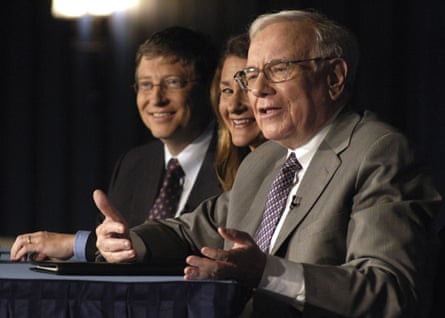
From left: Bill Gates, Melinda Gates and Warren Buffett in New York in 2006. Photograph: Nicholas Roberts/AFP/Getty Images
A number of prominent philanthropists, including Warren Buffett and Bill Gates, have publicly backed the idea. “I’ve paid more taxes than any individual ever, and gladly so. I should pay more,” Gates has said. Buffett says “society is responsible for a very significant percentage of what I’ve earned”, so he has an obligation to give back to society. Another rich entrepreneur, Martin Rothenberg, founder of Syracuse Language Systems, spells out how public investment makes private fortunes possible. “My wealth is not only a product of my own hard work. It also resulted from a strong economy and lots of public investment, both in others and in me,” he said. The state had given him a good education. There were free libraries and museums for him to use. The government had provided a graduate scholarship. And while teaching at university he was supported by numerous research grants. All of this provided the foundation on which he built the company that made him rich.
All of this undermines the argument that the rich are entitled to keep their wealth because it is all a result of their hard work. Indeed, some overtly acknowledge the existence of this social contract. In the UK, Julian Richer, founder of the hi-fi chain Richer Sounds, transferred 60% of the ownership of his £9m company to his employees in a partnership trust in 2019. Asked why he had made this decision, he replied that the staff had demonstrated loyalty over four decades, so he was now “doing the right thing” because that way “I sleep better at night.”
The growth in philanthropy in recent decades has failed to curb the growth in social and economic inequality. “We should expect inequality to decrease somewhat as philanthropy increases … It has not,” writes Kevin Laskowski, a field associate at the National Committee for Responsive Philanthropy. Indeed, as Albert Ruesga, president and CEO of the Greater New Orleans Foundation, has noted, “the collective actions of 90,000+ foundations … after decades of work … have failed to alter the most basic conditions of the poor in the US.”
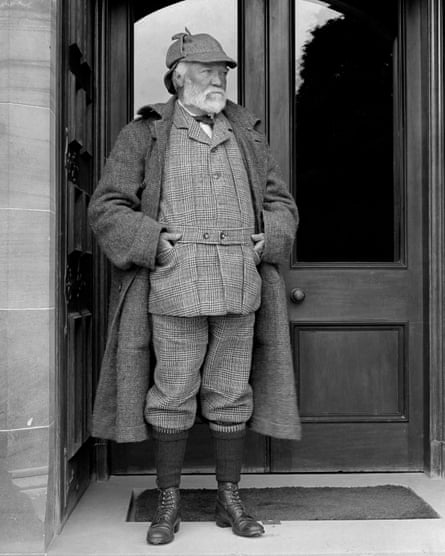
Steel magnate and philanthropist Andrew Carnegie. Photograph: PA
Why? The answer lies in the template that was established by the men who transformed modern philanthropy through the sheer scale of their giving in the late 19th and early 20th centuries. For all their munificence, the steel magnate Andrew Carnegie and the great industrial philanthropists of that era were notable – even in their own day – for avoiding the whole question of economic justice. Then, as now, a huge percentage of wealth was in the hands of a tiny few, almost completely untrammelled by tax and regulation. Carnegie and his fellows, their critics said, neglected the great ethical question of the day, which centred on “the distribution rather than the redistribution of wealth”. Carnegie, then the richest man in the world, was criticised in his day for distributing his unprecedented largesse because his fortune was built on ruthless tactics such as cutting the wages of his steel-workers. Carnegie’s greatest contemporary critic, William Jewett Tucker, concluded there is “no greater mistake … than that of trying to make charity do the work of justice”.
Carnegie built a network of nearly 3,000 libraries and other institutions to help the poor elevate their aspirations, but social justice was entirely absent from his agenda. More than that, he and his fellow “robber baron philanthropists” faced questions on the source of the money with which they were so generous – for it had been accumulated through business methods of a new ruthlessness. Like many of today’s tech titans, they amassed their vast fortunes through a relentless pursuit of monopolies. Teddy Roosevelt’s judgement on John D Rockefeller was that “no amount of charity in spending such fortunes can compensate in any way for the misconduct in acquiring them”. It is an insight that has found renewed traction in our times – as was shown by the ostracism of the Sackler family as leading international art philanthropists in 2019, and the boycotting of BP’s sponsorship by cultural leaders including the Royal Shakespeare Company. Roosevelt’s judgment on reputation-laundering through philanthropy is gaining new currency.
Philanthropy can be compatible with justice. But it requires a conscious effort on behalf of philanthropists to make it so. The default inclines in the opposite direction. Reinhold Niebuhr, in his 1932 book Moral Man and Immoral Society, suggests why: “Philanthropy combines genuine pity with the display of power [which] explains why the powerful are more inclined to be generous than to grant social justice.”
How can philanthropists break away from this default position? By nurturing the plurality of voices that are essential to hold both government and the free market to account. Philanthropy can even act as an agent of resistance, the American historian of philanthropy Benjamin Soskis suggested, immediately after the election of Donald Trump. “The fundamental liberal values, those of tolerance and respect for others, of decency, charity, and moderation, have been enfeebled in our public life,” Soskis said. “Philanthropy must be a place in which those values are preserved, defended, and championed.”
Philanthropy can recover a genuine sense of altruism only by understanding that it cannot do the job of either government or business. For it belongs not to the political or commercial realm, but to civil society and the world of social institutions that mediate between individuals, the market and the state. It is true that philanthropy can weaken elected governments, especially in the developing world, by bypassing national systems or declining to nurture them. And it can favour causes that only reflect the interests of the wealthy. But where philanthropists support community organisations, parent-teacher associations, co-operatives, faith groups, environmentalists or human rights activists – or where they give directly to charities that address inequality and specialise in advocacy for disadvantaged groups – they can help empower ordinary people to challenge authoritarian or overweening governments. In those circumstances, philanthropy can strengthen rather than weaken democracy.
But to do this, philanthropists need to be cannier about their analysis and tactics. At present, most philanthropists with concerns about disadvantage tend to focus on alleviating its symptoms rather than addressing its causes. They fund projects to feed the hungry, create jobs, build housing and improve services. But all that good work can be wiped out by public spending cuts, predatory lending or exploitative low levels of pay.
And there is a deeper problem. When it comes to addressing inequality, a well intentioned philanthropist might finance educational bursaries for children from disadvantaged backgrounds, or fund training schemes to equip low-paid workers for better jobs. That allows a few people to exit bad circumstances, but it leaves countless others stuck in under-performing schools or low-paid insecure work at the bottom of the labour market. Very few concerned philanthropists think of financing research or advocacy to address why so many schools are poor or so many jobs are exploitative. Such an approach, says David Callahan of Inside Philanthropy, is like “nurturing saplings while the forest is being cleared”.
By contrast, conservative philanthropists have, in the past two decades, operated at a different level. Their agenda has been to change public debate so that it is more accommodating of their neoliberal worldview, which opposes the regulation of finance, improvements in the minimum wage, checks on polluting industries and the establishment of universal healthcare. They fund climate change-denying academics, support free-market thinktanks, strike alliances with conservative religious groups, create populist TV and radio stations, and set up “enterprise institutes” inside universities, which allows them, not the universities, to select the academics.
Research by Callahan reveals that more liberal-minded philanthropists have never understood the importance of cultivating ideas to influence key public policy debates in the way conservatives have.How much is an hour worth? The war over the minimum wageRead more
Only a few top philanthropic foundations – such as Ford, Kellogg and George Soros’ Open Society Foundations – give grants to groups working to empower the poor and disadvantaged in such areas. Most philanthropists see them as too political. Many of the new generation of big givers come out of a highly entrepreneurial business world, and are disinclined to back groups that challenge how capitalism operates. They are reluctant to back groups lobbying to promote the empowerment of the disadvantaged people whom these same philanthropists declare they intend to assist. They tend not to fund initiatives to change tax and fiscal policies that are tilted in favour of the wealthy, or to strengthen regulatory oversight of the financial industry, or to change corporate culture to favour greater sharing of the fruits of prosperity. They rarely think of investing in the media, legal and academic networks of key opinion-formers in order to shift social and corporate culture and redress the influence of conservative philanthropy.
Rightwing philanthropists have, for more than two decades, understood the need to work for social and political change. Mainstream philanthropists now need to awaken to this reality. Philanthropy need not be incompatible with democracy, but it takes work to ensure that is the case.
This is an edited extract from Philanthropy – from Aristotle to Zuckerberg by Paul Vallely, published by Bloomsbury on 17 September and available at guardianbookshop.com
• This article was amended on 9 September 2020 to clarify that other forms of ID apart from a driving licence can be used to vote. It was further amended on 10 September 2020. An earlier version said a quote warning about the growing influence of rich donors had come from the UN general assembly; it has now been correctly attributed to the Global Policy Forum.
• Follow the Long Read on Twitter at @gdnlongread, and sign up to the long read weekly email here.
How to Read Fewer Books
Extracted from ‘The School of Life’ Website September14th 2020 with following comment by Roberta Jane Cook
The modern world firmly equates the intelligent person with the well-read person. Reading books, a lot of books, is the hallmark of brilliance as well as the supreme gateway to prestige and understanding. It’s hard to imagine anyone arriving at any insights of value without having worked their way through an enormous number of titles over the years. There is apparently no limit to how much we should read. We might – logically and ideally – be reading all the time and get ever cleverer with every moment we do so. The number of books we have managed to read by the day we die will tell us pretty much all we need to know about the complexity and maturity of our minds.
This so-called maximalist philosophy of reading enjoys enormous cultural prestige. It is backed up by enormous publishing and journalistic industries that constantly parade new titles before us – and imply that we might be swiftly left behind and condemned to a narrow and provincial mindset if we did not rush to read four of this year’s major prize winning books as well as seven fascinating titles that have received ardent reviews in the Sunday supplements since March. As a result, our shelves are overburdened and our guilt at how far behind we are intense.
Yet amidst this pressure to eat our way through an ever-larger number of titles, we might pause to reflect on a fascinating aspect of the pre-modern world: it never put people under any pressure to read very much at all. Reading was held to be extremely important, but the number of new books one read was entirely by the by. This wasn’t principally an economic point. Books were very expensive of course, but this wasn’t really the issue. What mattered was to read a few books very well, not squander one’s attention promiscuously on a great number of volumes.
The premodern world directed us to read so little because it was obsessed by a question modernity likes to dodge: what is the point of reading? And it had answers. To take a supreme example, Christians and Muslims located the value of reading in a very specific and narrow goal: the attainment of holiness. To read was to try to approximate the mind of god. In each case this meant that one book, and one book only – the Bible or the Koran – was to be held up as vastly and incomparably more important than any other. To read this book, repeatedly and with great attention, probably five or so pages every day, was thought more crucial than to rush through a whole library every week; in fact reading widely would have been regarded with suspicion, because most other books would – to some extent – have to prove misleading and distracting.
Similarly, in the Ancient Greek world, one was meant to focus in on a close knowledge of just two books: Homer’s Odyssey and his Iliad, because these were deemed the perfect repository of the Greek code of honour and the best guides to action in military and civilian affairs. Much later, in 18th century England, the ideal of reading came to be focused on Virgil’s Aeneid. To know this single long poem, almost by heart, was all a gentleman required to pass as cultivated. To read much more was viewed as eccentric – and probably a little unhealthy too.
We can pick up the minimalist attitude to reading in early visual depictions of one of the heroes of Christian scholarship, St Jerome – who was by all accounts the supreme intellect of Christendom, who translated the Greek and Hebrew portions of the Bible into Latin, wrote a large number of commentaries on scripture and is now the patron saint of libraries and librarians. But despite all his scholarly efforts, when it came to showing where and how St Jerome worked, a detail stands out: there are almost no books in his famous study. Strikingly, the most intelligent and thoughtful intellectual of the early church seems to have read fewer things than an average modern eight year old. To follow the depiction by Antonello da Messina, St Jerome appears to be the proud owner of about ten books in all!
Antonello da Messina, St Jerome in his study, 1475
The modern world has dramatically parted ways with this minimalist pre-modern approach to reading. We have adopted an Enlightenment mantra that runs in a very different direction, stating that there should be no limit to how much we read because, in answer to the question of why we read, there is only one response that will ever be encompassing and ambitious enough: we read in order to know everything. We aren’t reading to understand God or to follow civic virtue or to calm our minds. We are reading to understand the whole of human existence, the full inventory of the planets and the entirety of cosmic history. We are collective believers in the idea of totalising knowledge; the more books we have produced and digested, the closer we will be to grasping everything.
The sheer scale of the ambition helps to explain why the depictions of libraries in the Enlightenment period showed off vast and endless palaces to learning and hinted that if money had been no object, they would have been constructed to ring the earth.
Étienne-Louis Boullée, Project for the National Library in Paris, France, 1785
We may not be aware of how indebted we are to the Enlightenment idea of reading, but its maximalist legacy is present within the publishing industry, within the way books are presented to the public at school and in shops – and within our own guilty responses to the pressure to read more.
We can also hazard an observation: this exhaustive approach to reading does not make us particularly happy. We are drowning in books, we have no time ever to re-read one and we appear fated to a permanent sense of being under-read when compared with our peers and what the media has declared respectable.
In order to ease and simplify our lives, we might dare to ask a very old-fashioned question: what am I reading for? And this time, rather than answering ‘in order to know everything,’ we might parcel off a much more limited, focused and useful goal. We might – for example – decide that while society as a whole may be on a search for total knowledge, all that we really need and want to do is gather knowledge that is going to be useful to us as we lead our own lives. We might decide on a new mantra to guide our reading henceforth: we want to read in order to learn to be content. Nothing less – and nothing more.
With this new, far more targeted ambition in mind, much of the pressure to read constantly, copiously and randomly starts to fade. We suddenly have the same option that was once open to St Jerome; we might have only a dozen books on our shelves – and yet feel in no way intellectually undernourished or deprived.
Once we know that we are reading to be content, we won’t need to chase every book published this season. We can zero in on titles that best explain what we deem to be the constituent parts of contentment. So for example, we will need a few key books that explain our psyches to us, that teach us about how families work and how they might work better, that take us through how to find a job one can love and how to develop the courage to develop our opportunities. We’ll need some books that talk about friendship and love, sexuality and health. We’ll want books about how to travel, how to appreciate, how to be grateful and to how forgive. We’ll look for books that help us to stay calm, fight despair and diminish our disappointments. Finally, we’ll look for books that gently guide us to how to minimise regret and learn to die well.
With these goals in mind, we won’t need a boundless library, we won’t have to keep up frantically with publishing schedules. The more we understand what reading is for us, the more we can enjoy intimate relationships with a few works only. Our libraries can be simple. Instead of always broaching new material, re-reading might become crucial, the reinforcement of what we already know but tend so often to forget. The truly well-read person isn’t the one who has read a gargantuan number of books, it’s someone who has let themselves be shaped – deeply shaped in their capacity to live and die well – by a very few well-chosen one.
“Where Ignorance Is Bliss, Tis Folly To Be Wise” so my mother told me. September 14th 2020

Comment This is the kind of dangerous psuedo science propaganda one expects from the small minded controlling religious bigots and a Stae Elite who don’t want people educating themselves.. The last paragraph says it all.
As for dedicating our selves to reading a few well chosen books, the obvious question is ‘Who Chooses Them ?’
I recall being hounded and admonished by the school herarchy, at the Grange School in Aylesbury where I was a teacher, for being seen carrying a copy of Salman Rusdie’s ‘Satanic Verses..’ The school has and still has a lot of Muslim pupils.
The Satanic Verses is Salman Rushdie’s fourth novel, first published in 1988 and inspired in part by the life of Muhammad. As with his previous books, Rushdie used magical realism and relied on contemporary events and people to create his characters. I was told that I was only carrying it openly to ‘show how clever ‘ I thought I was. The book was also anti Thatcher and Aylesbury, along with the school governors were ramant Tories.
The year was 1988. I was in fact carrying the book because a pupil called George, whose father worked at Hazell’s print works, had brought it in for me to read. There was no room for it in my brief case.
Pupils like George brought me lots of things to read, including books on cars and trains. I liked to validate their choices as a reciprocal process of encouraging them to read. One girl brough me a copy of ‘Schindler’s List.’ A Pakistani boy even brought me a book called ‘Learn Urdhu in 30 Days‘ to help me with new pupils from Pakistan. By allowing these pupils to teach me, I was better able to get them to accept what I had to tell them
The idea that reading less is good for us is a worrying one. Reading is crucial to mental devlopment, health and verbal dexterity. My short lived working class father taught himself electronics, and radio from books. He taught himself French and German during the wartime army service. I don’t speeak French or German very well because I don’t read much in those languaes. To get better I would need to read more than a few ‘well chosen books.’ Knowledge is power. The elite and religious bigots/tyrants don’t want common folk to have it.
I recall my friend Steven telling me when we were teenagers that he liked talking to me because I was so ignoarnt. What he meant was that I did not read enough literature, so he could outshine me. I was more practical and sceinc e minded. His words inspired me. He took me down to London and to Foyles Bookshop. I had never seen so many books in one place – this was the late 1960s. I had very little money, doing A levels at the time and giving most of my part time earnings to my widowed mother.
So I had to choose wisely. I chose J.K Galbraith’s then new book ‘The Liberal Hour’ and Siegfried Sasoon’s Selected Poems of World War One. I have no need to re read the former because I have seen the liberal hour and what it has led to, with worse to come. Sasoon is still relevevant. War is always with us, along with the propaganda.
People who read the same book over and over will never learn anything approaching the elusive truth. Such folk remind me of Sheldon Cooper’s mother in ‘The Big Bang Theory’ where she says ‘I will read another book as soon as God writes one.’
This awful article above, is either written by a moron, possibly a religious bigot or is more elite propaganda to keep peoples’ minds closed to anything that is not politically correct. People are being driven mad in this PC Lockdown Police State. Psychiatrists and their back up brigade have never been busier. They rely on one book ‘The DSM- Diagnosis, Statistics, Medication.’
Vested interests need non threatening morons and lackeys to do the fighting. Lazy people will like being told they can be intelliegnt and clever without reading. They don’t want to be seen as the ignorant people they are. Ignorant people make the best police officers, teachers and other state bullies.
As far as I am concerned they are deluded. Victorian Prime Minister Benjamin Disraeli hit the nail on the head, as a novelist, when he wrote ‘To be conscious that you are ignorant is a great step to knowledge.”

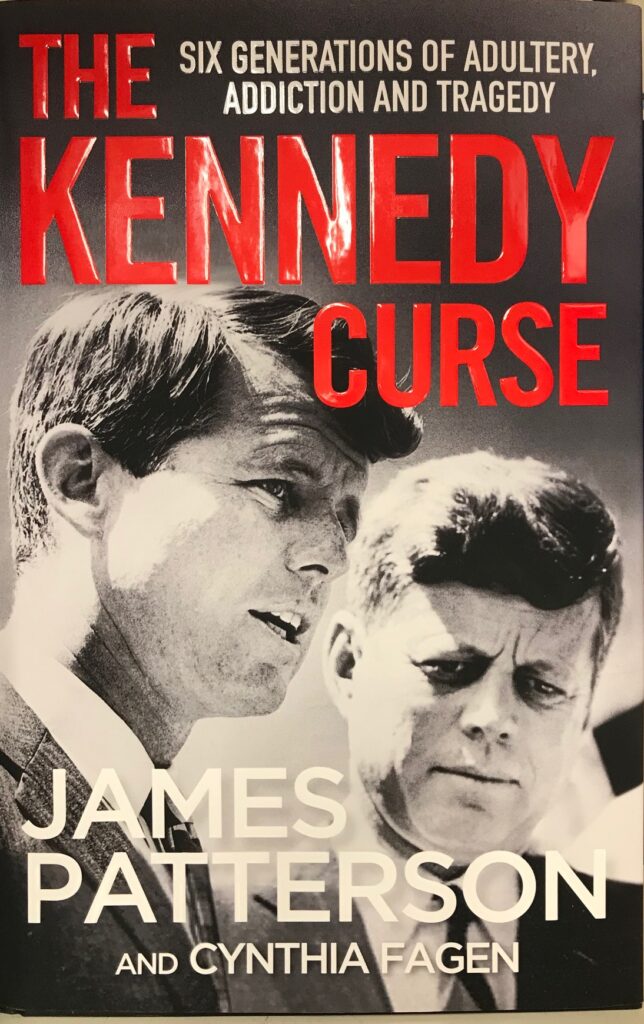
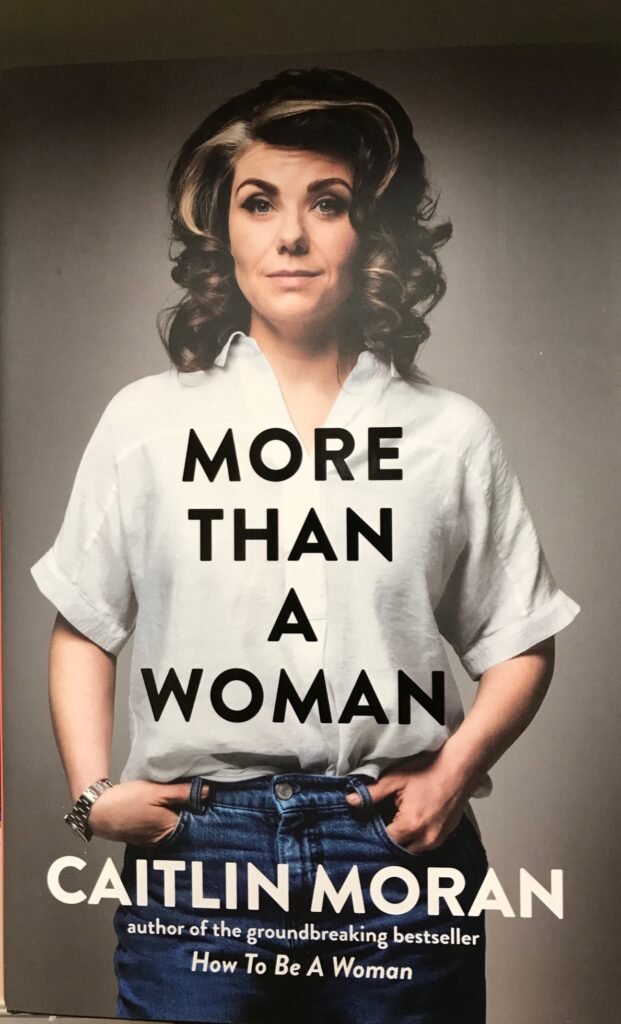
London’s Southbank Centre In Crisis September 13th 2020
The one thing everyone agrees is that the Southbank Centre is in deep trouble. In May, the institution made an unusually public plea for government help. Management predicted the best-case scenario was ending the financial year with a £5 million loss, having exhausted all reserves, used the £4 million received from the furlough scheme and having gobbled up the remainder of its Arts Council grant. All the while, with the exception of the Hayward Gallery, the 21-acre site on London’s Thameside, incorporating both the Royal Festival Hall and the Queen Elizabeth Hall, remains closed.
It was pitiful news, but there was worse to come. With no concerts, performances, talks or readings, drastic staff cuts are in the offing. Approximately 391 of the 577 employees face redundancy, with additional savings to be had from losing those working on a fixed-term or freelance basis. All of which has precipitated the greatest crisis for the centre since it opened its doors in 1951, a symbol of hope and post-war optimism.
While the government lockdown, and what CEO Elaine Bedell calls in an interview an ensuing ‘catastrophic loss of income’, is the cause of the institution’s immediate woes, the roots of the mess date from before the Covid-19 pandemic. Classed as a performing-arts outfit, the Southbank is funded via the Arts Council, not central government grants (unlike, for example, Tate). This means that the annual £18 million-plus grant the centre receives — the second-highest amount after the Royal Opera House — can only be spent on programming, and not on maintaining the sprawling concrete maze of concert halls, galleries, plazas and pathways.
Successive administrators have never hidden their disdain for the brutalist architecture, forever proposing apparently more ‘public-friendly’ master plans to soften the design. In 2013 the latest of these was unveiled, a £111 million make-over that would include a huge glass ‘floating pavilion’ — which, judging by preliminary sketches, had all the elegance of a Westfield shopping centre — plonked on top of the existing buildings.
Management resisted attempts to list the buildings, which prompted Tess Pinto of the Twentieth Century Society to lament: ‘As one of the nation’s great modern buildings, it fully deserves a level of protection. It’s a huge shame that the body responsible for the building does not recognise that.’ The underside of the complex was not immune to vandalism either, with plans to redevelop the undercroft — historically used by skateboarders — into retail outlets, matching a 90-metre river-facing strip of commercial space rightly described by the Guardian at the time as ‘strap-on cash cows’. The glass pavilion never happened, and a campaign led by skaters successfully saved their play space too. Instead, management looked to existing shop fronts to fund a thankfully more sensitive £35 million refurbishment.
Even spending that more modest amount has exposed the centre to possible insolvency. The future income from the restaurants and shops was promised as security against a £7 million loan from Lloyds. At the same time, while the extension of the Royal Festival Hall was financed through a London Development Agency grant, management used the new building as an asset against which it could access another bank loan, this time for £15.1 million from Allied Irish. Since March the organisation has been left scrambling to meet the repayments.
The annual cost of running the site, even without programming, comes in at £11 million and the Arts Council grant amounts to only 37 per cent of the institution’s income. As such, commercial income is essential. Yet Bedell told me that a ‘larger proportion’ of the centre’s tenants are refusing or unable to pay their rent. For months, the shutters remained down at the likes of Yo! Sushi, Wahaca, Wagamama, Giraffe, Strada and others. Bedell refused to name names and said she was ‘sympathetic’ to their situation. I am not. The fact that one of Britain’s premier arts institutions finds itself unable to operate, having to sack staff and potentially fall into the hands of the banks at least in part because a series of restaurant chains (most owned by investment funds) aren’t coughing up what they owe is scandalous.
All of which might be forgivable if the programme was up to scratch. In reality there is the sneaking suspicion that, given how much rides on getting people eating and shopping, the artistic offerings are commissioned with a don’t-frighten-the-horses ethos. That will only accelerate given the current financial situation. ‘Entrepreneurial’ is how Bedell describes it. She tells me that she hopes the open-air exhibition, Everyday Heroes, which celebrates key workers, will get people (and their money) back to the site. ‘We are working with the restaurants to do everything we can to restimulate business by staging an external exhibition.’ The aim, she says, is ‘an interesting cultural experience while also driving footfall to those commercial sites’.
Certainly family-friendly and mass appeal have been the order of the day at the Hayward. In 2006, Ralph Rugoff, an avuncular American art critic, was appointed curator at the gallery. An early exhibition made up of ‘large-scale installations’ by Antony Gormley set the pattern. Psycho Buildings was applauded for bringing some excitement. The sculptor Do-Ho Suh produced a vast installation imagining his childhood home in South Korea crashing into the apartment block he first occupied when he moved to the US; Austrian art collective Gelitin installed a boating lake on the gallery roof. Yet this photo-call-friendly fare became a curatorial leitmotif. Of the major shows over the past decade, more than a third have included ‘immersive installations’ or works seeking ‘audience participation’. The recent Bridget Riley retrospective was one of only three painting exhibitions staged in ten years.
The musical offering from the centre is no more inspiring. The London Philharmonic Orchestra and the Philharmonia Orchestra are autonomous organisations, but have gradually become more conservative over the years. There was a time when the Queen Elizabeth Hall was the place to see contemporary avant-garde music, but that, too, has seen much of its audience defect to Cafe Oto in east London.
Overseeing much of this was Jude Kelly, artistic director until she left in 2018. Awarded a CBE in 2015 and lavished with praise from outside the organisation, within it she was a divisive force. One former staff member, who worked at the Southbank between 2004 and 2007, recalls that prior to her arrival front-of-house personnel were dedicated to a particular venue. ‘The chances were that the person you bought your concert ticket from would have been a conservatoire student, who might be able to answer your queries on the performance, or the staff member behind the desk at the Hayward would have an interest in art.’ A decision was made that all staff should rotate the vast site, losing that discipline-specific knowledge. After Kelly left, no direct replacement was sought, but Madani Younis became ‘creative director’, only to quit less than a year into the job. Since last year, no one person has taken the artistic lead. Management now says that when the centre does reopen, only 10 per cent of the programme will be directly curated, the rest being pushed out to external promoters.
Yet the Southbank Centre has always provided more than just ticketed events. The spacious Queen Elizabeth Hall foyer offers a public square for people to meet, whether for romantic assignations or to study. The centre’s original egalitarian design provides ample space to congregate. That was why the 2015 proposals to redevelop the undercroft prompted outrage even from those who had never ridden a skateboard in their lives.
Slightly less noisy was another successful campaign in support of the National Poetry Library. One of the centre’s less well-known offerings (it doesn’t lend itself to sexy marketing campaigns), it nonetheless boasts the world’s biggest collection of modern poetry. For 70 years it has been a valuable free resource, but last year the Southbank announced that anyone wishing to borrow books would have to pay. Poet Arji Manuelpillai organised a protest. ‘It’s the centrepiece of the London poetry scene. I started going when I was 16, I used to look randomly, and was blown away that I could read all this stuff for free,’ he recalls.
That threat was seen off but it may prove to be a Pyrrhic victory as now, according to the staff pressure group SOS Southbank, 70 per cent of the library’s staff are to be made redundant. It is a decision that Manuelpillai predicts will have a devastating impact. ‘All these introverted poets come alive in that place. There’s old people, young people. But without the staff to offer help footfall will go down and they’ll justify closing it down the line.’
There are those who would like to see the whole place privatised, with assets such as the Poetry Library thrown to the wolves of market forces; but conservative management, government cuts and the byzantine intricacies of arts funding have ensured that the organisation is already beholden to stifling commercial interests.Written byOliver Basciano
Why We No Longer Need Superhero When We Have Feminism September 12th 2020
Subversive comic book adaptation The Boys truly reveals the ugliness of our obsession with men in capes. So where can the genre go from here, writes Cameron Laux. A
As you watch the new series of Amazon’s darkly comic superhero drama The Boys, you are compelled to reflect on what it means to be a hero and what, if any, meaning it has these days. In The Boys, which is adapted from the mid-2000s comic book series of the same name, the ‘supes’ (heroes with superpowers, all twisted derivatives of classic figures like Superman, Wonder Woman, and Batman, but by other names), far from being shining examples of nobility and courage, are mainly power-drunk self-regarding sociopaths. The ‘boys’ of the title are a gang of weakly human vigilantes who skulk around in the shadows trying to assassinate them.
Ultimately, the show asks: what do you do when confronted with people who, for pretty good reasons (money, power, both mostly ill-gotten or accidents of fate) have god complexes? This is a topical question in our current moment of the super-rich and populist leaders, but maybe it has always been high on the human agenda. King Lear complained that we are like flies to the gods. Possibly we have always been flies to someone or other powerful. And what a morbid fascination we bugs have with the beings who squash us.
A story as old as time
No matter where you look geographically, or when you look historically, it seems that people have always been obsessed with heroes and gods. Choose any ancient body of folklore – Beowulf, the Mahabharata, the story of Gilgamesh, the legends of the Monkey King, the Icelandic sagas, the Greek epics, the Bible, Shintoism – and you find intrepid heroes struggling with the aid of, or despite, gods. The hero is often on a quest to accomplish something everyone knows to be humanly impossible, and when he shocks everyone by succeeding, he is rewarded with great wealth, status, maybe even a measure of divinity himself.
In recent years these pipe dreams of personal liberation and power have spread like a contagion through the global cultural imagination
If you want a scholarly dissection of our hero obsession, you need only pick up some classics of cultural anthropology. Chief among them is Joseph Campbell’s famous The Hero with a Thousand Faces (1949). It argues that the hero myths of many cultures have a common structure: the hero leaves his everyday world to pursue an adventure that involves stages of conflict and transformation, rites of passage, at the end of which he is forever changed and perhaps somehow transcendent. This doctrine of voyage, struggle, and transformation may seem very familiar: in our age it has become a sort of textbook for script writers everywhere.
George Lucas acknowledged the influence of Campbell on the creation of his (I would say) laughably simplistic Star Wars plots, driven by pantomime good and evil, which centred on an innocent farm boy being sucked into far-flung galactic adventures in the course of which he realised he had god-like powers and was destined to save the universe. In recent years these pipe dreams of personal liberation and power have spread like a contagion through the global cultural imagination. Right now, almost anything involving fantasy elements, no matter what the medium (comics, novels, children’s books, film, TV, the vast spectrum of tie-in merchandise), involves a protagonist battling against adversity to realise their hidden powers, the full expression of their magnificent selves. And fantasy can lay claim to being the dominant genre of our age.

My Uncle Charlie died with the London Irish Rifles, my father was wounded at Dunkirk and my Uncle Arthur, invalided out of the army during World War Two, going on to be an air raid warden during the London Blitz, was festooned with white feathers by women who thought he should be risking his life on the front line.
My mother’s fiancee was shot down and killed while with the RAF. When working class soldiers came home from both wars, they struggled to find homes and jobs. They are always the scapegoats and cannon fodder for the ruling elite and comfortable mass media.
R.J Cook
September 12th 2020


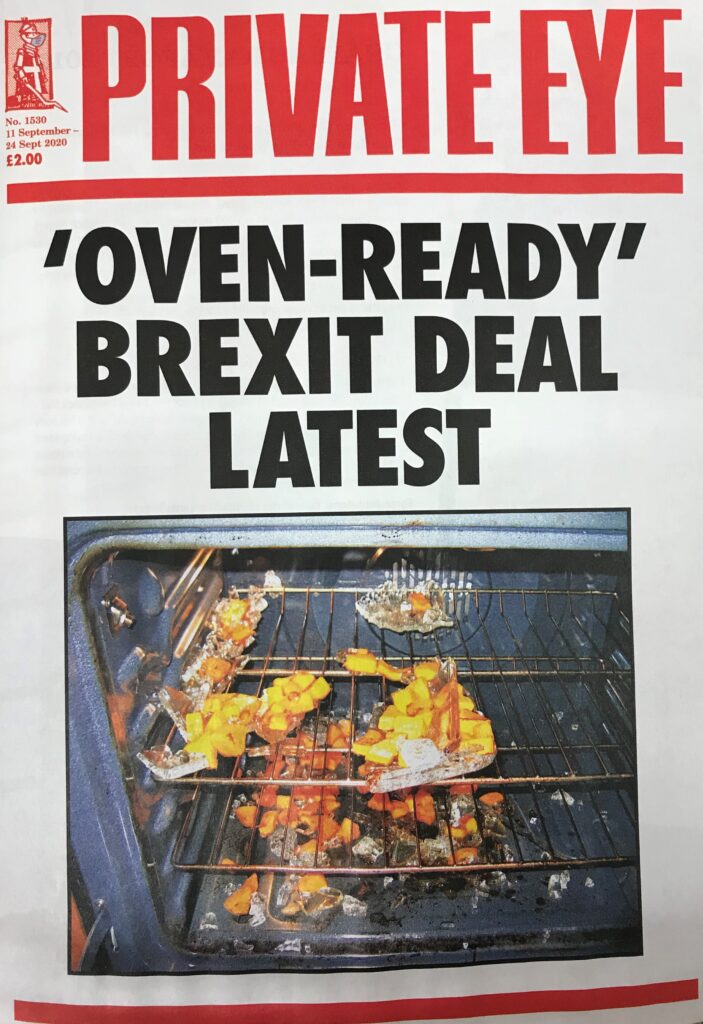
Break from the norm: Derry Girl’s Leah missed out on Normal People role
No hard feelings as actress admits being a fan Posted September 6th 2020
Leah O’Rourke as Jenny Joyce in Derry Girls

John Toner
September 06 2020 07:40 AM
Derry Girls star Leah O’Rourke has revealed she was in the running for the role of Marianne in global smash-hit drama Normal People.
Leah, best known for playing Jenny in Derry Girls, says she’s a huge fan of the show despite missing out on the lead female role to British actress Daisy Edgar-Jones.
The actress, who is now also working in a Fermanagh school part-time, told Sunday Life: “I absolutely loved the show, the casting was brilliant, my whole family watched it including me and my boyfriend, I thought it was a just a really fantastic show.
“It’s one of those shows that at the end of each episode you need to watch the next one, there’s very few shows like that for me.
“Normally I can watch the next episode another night but you literally ended up glued to it for hours just wanting to know what happens.
“The couple are so captivating you just wanted to know how things worked out for them.
A scene from Normal People
“I do think it took them a while to find the lead girl so I think a lot of actors will have auditioned for it as well as me, possibly the other Derry Girls might have done too.
“It was a good experience, it was a really short scene which wasn’t very detailed at all, again it was a bit like auditioning for Derry Girls in that you don’t really know how successful something is going to be when you’re at that stage.
“It was just one of many self-tapes that I was making so I never really thought about it again after I sent it off and then I watched the series and all the hype had taken off and people were blown away. I was like, ‘Oh my God, I auditioned for that!'”
Leah O’Rourke who plays Jenny Joyce in Derry Girls
Newry native Leah, who is best known for her portrayal of prim and proper prefect Jenny Joyce in Lisa McGee’s hugely successful Derry Girls, has recently taken a part-time job at a Fermanagh primary school after moving to the county with her boyfriend at the start of lockdown.
The 31-year-old confessed to loving life in the country and picking up character inspiration for season three of Derry Girls from some of her new students.
She added: “I had been a classroom assistant since 2016 and had been working at Lagan College in Belfast for the past year or so and was living there but my boyfriend is from Fermanagh and whenever lockdown started I moved down to be with him.
“Things in Fermanagh worked out really well and I said if I could get a job in a school I’d stay, so I applied to a school and luckily I got the job.
“I only do three hours a day because I still have to keep lots of free time if my agent sends me any scripts to learn or auditions and so on so it’s nice that it keeps me ticking over that way.
“I like to keep busy, I don’t like to be sitting waiting on the phone to ring.
“My mum and dad have always been really hard-working and I’ve always grown up having a job on the side as well as my acting. I love working with children and it just seemed like the right avenue for me.”
Leah is settling into Fermanagh well, admitting the “very peaceful” existence is a big change from living in London, where she was previously based.
“The people are really friendly here and take time to stop and chat to you whereas in London it was so fast-paced nobody had time for that but Fermanagh people are lovely, it’s a very chilled, laid-back sort of vibe down here,” she added.
“I love working in the school, the day goes in so quick.
“It’s very rewarding and also it has helped me with my part in Derry Girls, with the character, because I’m seeing schoolchildren every day and I’m immersed in that world every day.
“So it’s given me some ideas for Jenny seeing people who get on a similar way to her in the classroom, it’s pretty handy.
“The kids are lovely, it’s such a lovely school it really is, I’m there to support one student and that student is like a comedian, they make me laugh every day.
“I’m only in three hours in the morning so the day goes in very quick, all the staff have been lovely too.”
Sunday Life

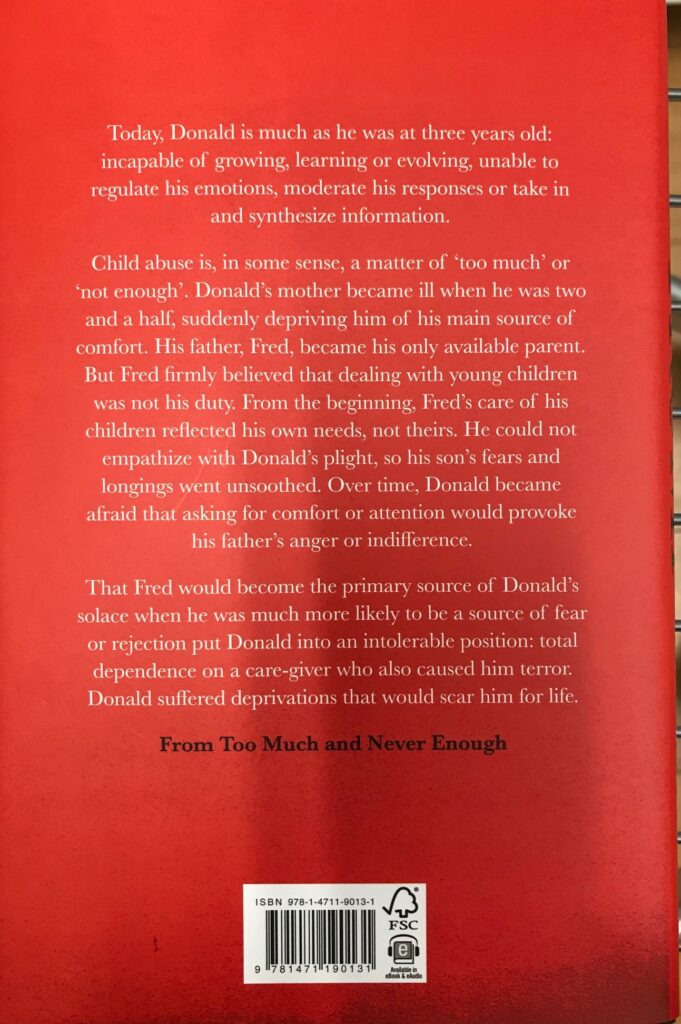
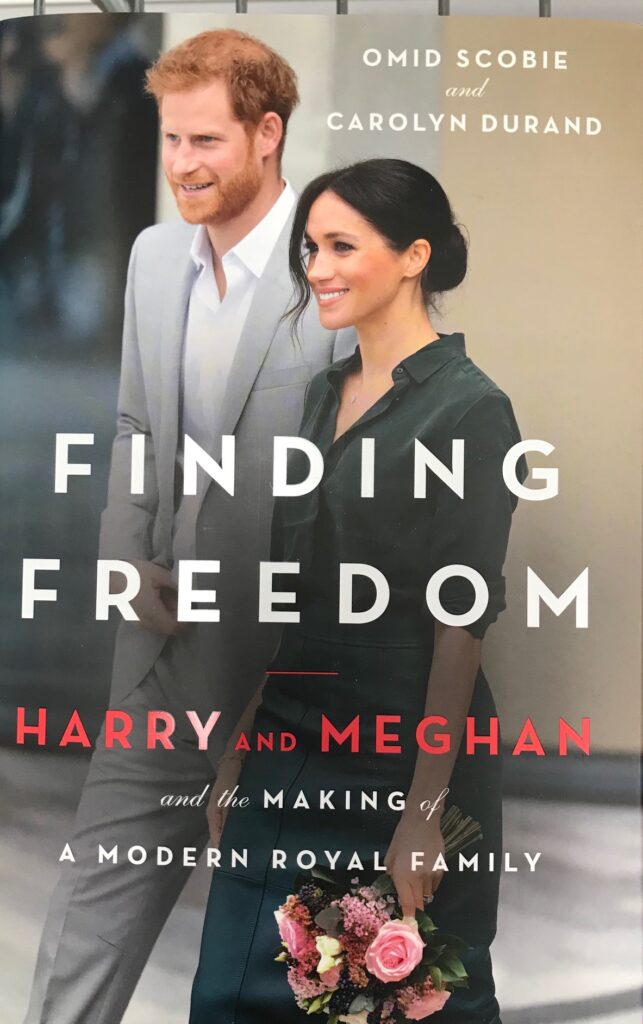

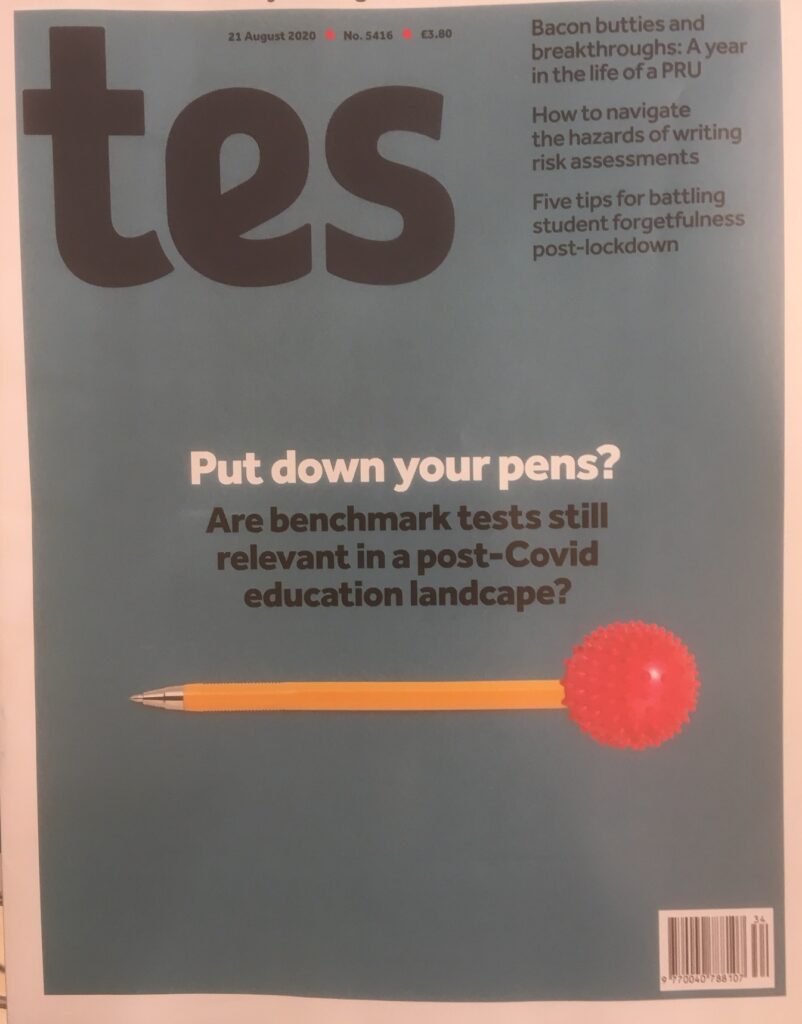

Men going their own way: the rise of a toxic male separatist movement September 2nd 2020
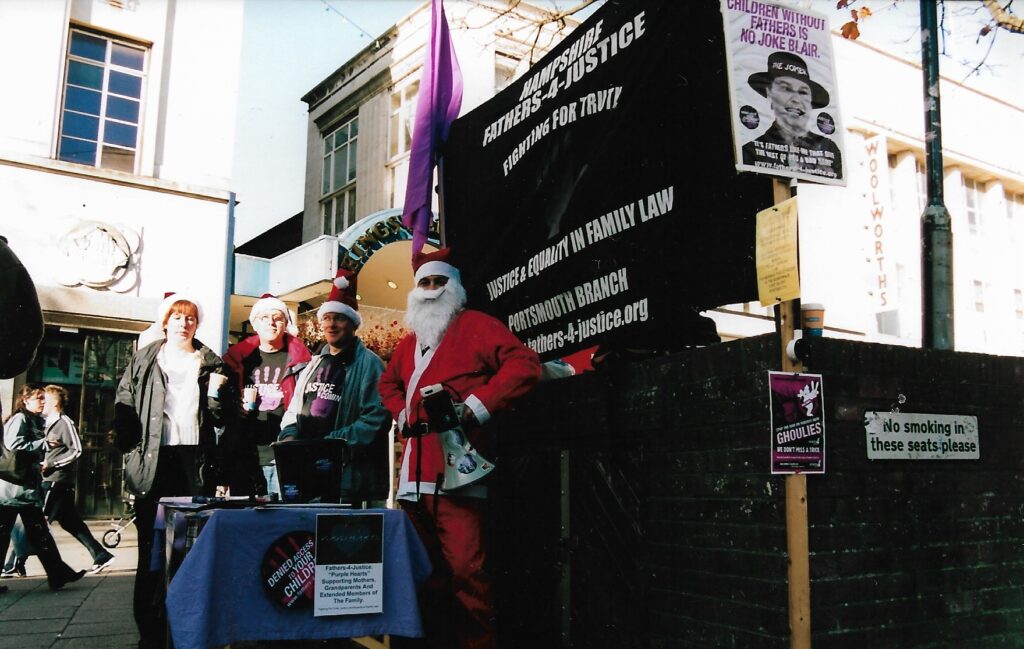
The article aggrandises all women as stoic talented , deprecating men as lying deluded bigoted women haters – with no recourse to evidence.
The lie that women never lie, merely endure a life of exploitation, sexpoloitation and oppression is the undercurrent of this piece. Feminism is on a par with Islam, it is an ism attracting weak minded blobs and extremists as their basis of identity and purpose.
These harridans hate transsexuals for a number of reasons, includng the threat that many of them display old style glamour and a submissive attitude to old fashioned ;
‘real men’ ( the ones sacrificed in all the rich elite’s wars ) as opposed to non threatening ‘manginas’ and are deserting their roles as scapegoat for women who need excuses for not being the amazing successes mummy and daddy said they should be.
Add to that the Trans Exclusionary Reactioonary Feminists ( Terfs ) and you have the wonderful exposition of feminists obsession with their necessary their peculiar obsession with rape. They argue that men endure the stress, humiliation and abuse that comes from changing sex, just to get into ladies rest rooms, toilets etc to commit rape and sexual assault.
By that argument, lesbians, especially butch ones, should carry I.D and be excluded too, because under modern law one doesn’t need a penis to commit rape anymore. It is an interesting world, where one posh American women recently shot her husband dead, using the excuse he looked at her in a ‘funny way’. Feminists will never let go the lie that women never lie about about rape and domestic violence.
I have two sons and find these people terrifyingly dangerous, self centred, self righteous, self aggrandising and incapable of loving anyone but themselves. Many of them are not fit to be mothers – hence the sate of modern youth and rampant mental illness.
These ghastly feminists pour ship loads of poisonous hate on men, decrying every man who raises an argument against them as hate criminals and abusers. our political system , and that of the U.S, has been exposed for the hypocritical failure and chaos that it is due to relentless feminisation and so called positive discrimination.
Roberta Jane Cook
Image Appledene Photographics/RJC
The men of the MGTOW movement aim to live their lives with no female contact. The idea began on the fringes of the internet – so how has it made it all the way to the White House?

‘Red-pilled’ men believe the world is stacked against them, Illustration: Gym Class/The Guardian
‘There has been an awakening … changing the world … one man at a time.” These are the dramatic words that appear when you visit mgtow.com. In a video that looks a lot like an action-movie trailer, the words are soon followed by five more that appear to smash through the screen, smouldering fiery red: “Men … going … their … own way.”
If you stumbled across this website and had never heard of “men going their own way” (MGTOW) before, you would probably assume this was a tiny, extreme movement. But you would be only half right.
The views of MGTOW are indeed unorthodox, even within the sprawling web of groups, lifestyles and cults known as the “manosphere”, where women-haters mobilise against a supposed gynocratic conspiracy. While incels plot violent revenge on women, and pickup artists (PUAs) deploy predatory tactics to “game” women into having sex with them, the men of the MGTOW attempt to eschew relationships with women altogether. They are, literally, going their own way. Far, far away from any women. At all.
Although some MGTOW maintain platonic relationships with women and others have one-night stands or visit sex workers, many prefer to abstain from sex, a process referred to as “going monk”. This is too much for some members of the wider manosphere. The blogger Matt Forney, notorious for posts such as “Why fat girls don’t deserve to be loved” and “The necessity of domestic violence”, wrote that “men going their own way is no way for men to go” and mocked MGTOW as “a cult for lonely virgins”.
But this isn’t an obscure internet cul-de-sac; mgtow.com alone has almost 33,000 members. Its forums (“for men only”) contain conversations on more than 50,000 topics, with more than 790,000 replies, which range from advice on divorcing as cheaply as possible to lurid stories about women who have found particularly inventive ways to murder their husbands. The site also lists 25 video channels; between them, these have more than 730,000 followers, and their videos have been viewed a total of 130m times.
Over on YouTube, one of the best-known MGTOW vloggers, who goes by the name of Sandman, has racked up more 90m views for videos with titles ranging from “Smart men don’t get married” to “Criticise her and she will destroy your career”.
The MGTOW philosophy is elaborately laid out on the mgtow.com website, which summarises it as “a statement of self-ownership, where the modern man preserves and protects his own sovereignty above all else”. Drawing on snippets of quotes and newspaper clippings, the site claims that MGTOW dates back to great men, including Schopenhauer, Beethoven, Galileo and “even Jesus Christ”.
Women are essentially portrayed as parasites riding on the coattails of men, who have, throughout history, been responsible for “far greater miracles of science, discovery and human endeavour”. By shaking women off, it is explained, men will be free to pursue ever higher achievements.
MGTOW (pronounced “mig-tau” by adherents) are unlikely to meet in person, instead sharing their techniques, successes and failures online. Throughout the manosphere, it is common to see members expressing paranoia about “normies” who could be out to expose them, often leading to forum users accusing each other of being moles or spies. Nowhere is this fear more prevalent than among MGTOW, with any suggestion of meeting in real life usually receiving a swift and scornful rebuttal.
Once you have “taken the red pill” (ie, opened your eyes to the “reality” that, as a man, the whole world is stacked against you) there are four mainlevels of MGTOW, according to many websites. Level one involves rejecting long-term relationships, while level two extends this to short-term relationships. Level three requires economic disengagement (reducing taxation as far as possible, in order to avoid paying towards the support of other groups, from “elite alphas” to “single mothers”). As one MGTOW manifesto puts it, as well as fighting to “instil masculinity in men”, MGTOW must “work toward limited government”.
Level four is described as “social rejection”. “The MGTOW drops out of society altogether,” says the MGTOW blogger the Observer Watches. “For all intents and purposes, he does not exist. A urbanite might keep to his own apartment, while someone further out may simply head into the wilderness and go off-grid.”
Those who achieve this ultimate isolation are known as “ghosts” and treated as legends within the community. But most MGTOW seem happy hovering somewhere around level two. Discussions tend to centre on classic manosphere complaints such as the evils of women and misandry (hatred of men). Most of all, they focus on the dangers of interacting with women.
“There is a lot of risk,” David Sherratt, an 18-year-old Cardiff University student and then dedicated member of the MGTOW community, noted in 2015. “We do not know how many false accusations there are. They could be the majority or they could be the minority.” The implication was that there are so many women ready to lie about rape that any contact with them is simply too dangerous to risk. In reality, a man in the UK is 230 times more likely to be raped himself than falsely accused of rape.
In this, MGTOW resemble men’s rights activists (MRAs) more than incels or PUAs. Both groups believe that women pose an immediate threat to all men. MRAs believe that women are so unfaithful and untruthful that they often force men to raise other men’s children, thus financially “cuckolding” them. MGTOW believe that women are extremely likely to make false accusations of sexual or domestic violence, in order to damage men socially, steal their money or even have them jailed.
Sherratt also went on to cite a list of concerns that would resonate particularly closely with MRAs, including: “Men are supposed to pay for dates and bow down to women … anything less than worship is hate” and: “When it comes to marriage, the system is so stacked against men, it does not make sense.” MGTOW and MRAs alike see divorce as deeply one-sided, allowing women to rob innocent men of money, property and, in some cases, children.
Unable to stop thinking about Sherratt, I tracked him down to ask about his experience of becoming involved in the community. Now 22, Sherratt is an engineering apprentice and says he has left MGTOW and other manosphere groups behind. At first, he says, they were “legitimately fun … I had lots of friends, which was new to me, lots of fans and positive reinforcement. As we started to grow and build, it honestly felt like we were eventually going to start making some positive change. It wasn’t just a community, but a new, growing movement that I got into ‘before it was cool’, so, in a way, I felt like I was part of something progressive.”
Sherratt could not, however, claim to be a pioneer. It is generally accepted within the MGTOW community that the movement was started in the mid-00s by two men going by the pseudonyms Solaris (an Australian) and Ragnar (a Scandinavian, who describes himself as “an old guy” and a former pilot), both of whom had been previously active in what they described as the “online men’s movement”. “A sense of alienation is where this whole thing starts,” Solaris claimed in a 2012 YouTube interview. “You realise, simply because you’re a man, that you are considered a legitimate target for being the butt of jokes or being considered a class enemy.”
As with many areas of the manosphere, it is difficult to know where most users of MGTOW forums and communities are based, though the majority communicate in English, and comments and user names suggest that the US, Canada and the UK are common locations. An mgtow.com post entitled Hello From the UK draws enthusiastic replies from “fellow Brits”, who claim to be writing from areas including the Midlands, Sussex and Salford. They revel in their shared ideology as much as their shared location, heartily agreeing with the participant’s opening salvo: “Fucking women, they are all snakes with tits.”
There is also a website called British MGTOW, which rails against what it describes as the “Nazi-like behaviour” of the British state in silencing and censoring non-PC views, claiming: “The UK is sick and it needs healing. The laws are in desperate need of a revamp but all I see around me are docile willing men led to the slaughter.”
It is, one imagines, very difficult for a man to release himself completely from the toxic impact of women while entangled within a community feverishly obsessed with, well, women. This was apparent even to the teenage Sherratt, who says: “I understood the scepticism of marriage and stuff, but, for men who were talking about trying to live lives that didn’t centre around women, they were talking about them an awful lot.” When he tried to voice his disagreements with various elements of MGTOW ideology, he was accused of being “mind-controlled by a girl”. Soon afterwards, he left the community, having met a girl who (rather unsurprisingly) shared his criticisms. “So I guess the joke’s on them,” he muses.
It is easy to write off MGTOW as a weird group of goofy celibates. Yet it has, in some ways, quietly penetrated mainstream culture more successfully than any other segment of the manosphere.
In the immediate wake of the #MeToo movement, which saw millions of women worldwide standing up to sexual harassment and assault by sharing their own stories, there was a swift and severe backlash. Critics claimed that the movement was a pitchfork mob: a “witch-hunt” designed to topple men from their jobs and lives, without so much as an attempt at due process. Some commentators settled for hounding women who had dared to share their stories, or denigrating the movement as a whole. But gradually another response emerged, borrowing its ideology directly from MGTOW: avoiding women at all costs.
It started with rumours: women reporting that men in their offices had suddenly started declining meetings with them or were insisting on leaving the door open. A human resources consultant reported executives telling her that they would no longer get into an elevator alone with a woman. Suddenly, it began to snowball – story after story of men abruptly cancelling business lunches or avoiding women they had previously mentored.
In the same way that the MGTOW movement turns the structural oppression of women on its head, claiming men are the true victims of gender bias, this spate of mainstream examples sought to cast men as the real victims of the #MeToo movement. Men, it argued, had little choice but to protect themselves from the all-powerful cabal of rampaging, vindictive women making false accusations. Even if the solution was as extreme as total isolation.
An orthopaedic surgeon in Chicago told the New York Times that he had ceased ever to be alone with female colleagues, saying: ‘I’m very cautious about it because my livelihood is on the line … If someone in your hospital says you had inappropriate contact with this woman, you get suspended for an investigation, and your life is over. Does that ever leave you?” His apparent implication that such accusations are simply random, based on no wrongdoing whatsoever, went unchallenged in the piece.
The woman-shunning has even penetrated as far as the White House, where the vice-president, Mike Pence, spawned what is now known as the Pence Rule after he remarked that he would never eat a meal alone with a woman who is not his wife.
Reporting on such an idea might have once been seen as inflammatory or biased, requiring careful and robust presentation of opposing arguments. But, as soon as it was attached to Pence, it became respectable fodder for widespread coverage. “THINK,” tweeted Sebastian Gorka, a former deputy assistant to Donald Trump. “If Weinstein had obeyed @VP Pence’s rules for meeting with the opposite sex, none of those poor women would ever have been abused.” Of course, if Weinstein hadn’t been an abusive predator, the same outcome could have been achieved, too. Just a thought.
Before long, a book had been published to spread the word. As the Amazon listing for The Pence Principle, by Randall Bentwick, puts it: “Every man in America could stand to learn a lesson or two from our vice-president. Be smart … Defend yourself, your career, your family and your life from the false accusations of women today and into the future.”
This did not go unnoticed by the MGTOW, whose celebrations were evident in gloating Reddit threads (“Why feminists fear the Mike Pence Rule”) and YouTube videos (“We invented the Pence Rule”). Nor does it remain a niche idea: a 2019 study found that 27% of American men now avoid one-on-one meetings with female colleagues. So the ideas we might think of as the shadowy, ridiculous concerns of the extreme internet fringes are actually being waved under our very noses from the White House front lawn.
This is an edited extract from Men Who Hate Women by Laura Bates, published by Simon & Schuster on 3 September. To order for £14.78 (RRP £16.99) go to guardianbookshop.com. P&P charges may apply.
Why Pink Floyd’s Nick Mason Finally Went Solo at 75
Revisiting his former band’s early years with Saucerful of Secrets, the drummer is on the first bus tour of his entire career, flying commercial and loving every minute of it. August 31st 2020
- Andy Greene

Pink Floyd’s Nick Mason opens up about his decision to launch a new solo project devoted to Pink Floyd’s early work. Photo by Christaan Felber for Rolling Stone.
It’s April 2019, and the former drummer of Pink Floyd is sitting in the catering area backstage at the Beacon Theatre eating from a tiny bowl of pea soup about three hours before his new band, Nick Mason’s Saucerful of Secrets, make their New York debut. The last time the 75-year-old played a venue in the city anywhere near this small, it was 1972 and Pink Floyd were road-testing songs from their in-progress LP Dark Side of the Moon. That was just before his life became a blur of private airplanes, sold-out football stadiums and Machiavellian power struggles so intense that the group disbanded 25 years ago with a reunion remaining little more than an impossible dream.
The void they left has been filled with massively successful solo tours by Roger Waters and David Gilmour along with countless tribute acts. But for years Mason felt there was no room for him on that circuit even though he’s one of Pink Floyd’s three living members and the only one that lasted through every single incarnation of the band. “I didn’t think I could do it,” he says. “ I just thought, ‘Do I really want to go out there and get involved with punching it out with Roger, David, the Australian Pink Floyd Show and all the rest of it?’”
And so for the past 25 years he didn’t do much. And with the money from Pink Floyd pouring in from all directions, he didn’t really need to. “I was home a lot, really,” he says. “I got my helicopter license and did a lot of motor racing because I missed the playing and I missed the adrenaline of it. I also worked on the [Pink Floyd] re-releases and compilations because I tended to be the one prepared to go and talk about them on radio or whatever.”
He also guested on a handful of shows on Roger Waters’ 2006 Dark Side of the Moon tour and played with Gilmour on the 2014 Pink Floyd instrumental album The Endless River, which was designed as their final statement and wasn’t supported with any live activity. “After the big [Division Bell] tour in 1994, David really had had enough of doing big tours,” says Mason. ”I can see why, but I didn’t entirely agree with that. But then it was slightly different for David because he carried most of it on his shoulders. It’s also really hard work and he had young kids and a family at home.”
Any sort of Mason solo tour seemed extremely unlikely until he was approached a little more than a year ago by former Blockheads guitarist Lee Harris and the bassist Guy Pratt, who replaced Roger Waters in Pink Floyd back in 1987 and has been one of David Gilmour’s main collaborators ever since. They had the wonderfully simple idea of forming a new band devoted exclusively to the surreal, psychedelic music Pink Floyd created before they broke through to the mainstream with Dark Side of the Moon. “I don’t mean to sound rude,” says Harris. “But Nick was a lot more experimental as a drummer before David Gilmour truly learned to play guitar and he was left to basically just keep rhythm while [Gilmour] was playing those amazing solos. I wanted to go back to that early stuff.”
Mason was cautiously optimistic about the idea, especially after they recruited keyboardist Dom Beken, best known for his work in the Nineties electronic group the Orb, and Spandau Ballet guitarist-songwriter Gary Kemp. The five men came from wildly different backgrounds, but they’d all spent their careers standing in the shadows of bandleaders with significantly more name recognition and natural charisma. Kemp may have the sole writing credit on Spandau Ballet’s era-defining classic “True” and nearly all their other songs, but it was lead singer Tony Hadley that made the women scream the loudest in the Eighties. Lee Harris spent years trying to fill the enormous gap that British pub-rock icon Ian Dury left in the Blockheads when he died in 2000, and only true Pink Floyd fanatics know that Guy Pratt even exists despite his many years re-creating Roger Waters’ bass and vocal parts with the group and at Gilmour solo shows.
But when they all came together at a rehearsal space in London to try and resurrect the career of one of rock’s most overshadowed figures, they discovered an immediate musical chemistry. “Given my lack of affection for very hard work, I think if it had been anything other than just sifting straight into place, it would have been difficult,” Mason says. “The interesting thing was that it all sort of began to sound good straight away. That was mainly, I think, driven by their enthusiasm.”
Very quietly, the group booked a test show at Dingwalls in London, a tiny club that seats just about 500 people at its absolute capacity. “It was rammed,” says Kemp. “I’m used to playing to 70 percent women when I play with Spandau. This was like 90 percent men. They were noisy and raucous. We began the show with ‘Interstellar Overdrive,’ which breaks down right in the middle and has a kind of freeform, atonal section. How many bands are doing that? Especially guys that are 75 years old and he hasn’t toured for 25 years? We lay our cards out right at the beginning, what kind of night we’re going to have.”
For Mason — who hadn’t played anywhere that small in about 50 years — the night was a revelation. “I felt 25 again,” he says. “I could finally see the other musicians and we all made eye contact. I could see the back of the auditorium and everyone listening. Big stadiums are an extraordinary thing to do and it gives you the opportunity to do all the pyrotechnics and all the rest of it, but it’s not as engaging as an audience that you can see.”
Saucerful of Secrets booked a tour of Europe in September 2018 and in March they headed to North America for a six-week tour that took them to theaters all over the continent. It’s the first time that Mason has ever travelled on a tour bus, and he didn’t even get his own since the whole band shared one. “Normally [on Pink Floyd tours] there was a charter jet and a limo and all the rest of it,” he says. “I have to say that I don’t miss any of that. Unfortunately, I slipped on the washroom floor on the first day of traveling and hit my shoulder. But it’s gotten better and I’m having fun. I mean, I have sat in the bus thinking, you know what else I could be doing at the moment? And it always comes back to this is where I’d like to be now.”
Vocal duties in Nick Mason’s Saucerful of Secrets are shared between Guy Pratt and Gary Kemp, but nobody stands in the center of the stage. “We wanted to put the focus back onto Nick,” says Kemp. “There’s nobody standing in front of him. It’s really the sense that it’s his legacy we’re all here to honor. He could never have been substituted in Floyd with any other drummer. He had such a style of his own and I think he needs his own applause and he’s finally getting it.”
And despite some concerns that audiences in America would be baffled by a show that featured almost no famous songs ever heard on classic-rock radio, they’ve received a rapturous reception everywhere they’ve gone. At the Beacon Theatre, there wasn’t even a single request for a hit song. “Frankly,” says Mason, “if you want to hear ‘Money’ and ‘Comfortably Numb,’ you’re better off with Roger, David and the Australian Pink Floyd Show.”
What you can’t get seeing any of those other acts are Saucerful of Secrets set highlights like the hard-rock aggression of “The Nile Song,” a long jam on the trippy “Atom Heart Mother” and the surreal journey of “Set the Controls of the Heart of the Sun.” During the latter song at the Beacon Theatre, a figure in black walked on from the side of the stage to tackle lead vocals. Once the crowd realized it was Roger Waters — playing with Mason for the first time since 2013 — they went completely insane. “We’re very, very close and old friends,” Waters told the stunned audience. “Loving the show, by the way, Nick. My considered opinion is that you sounded a lot better than we did back in the day.”
Future plans for the group are unclear, but Mason is already talking about bringing the show all over the world and possibly making a live album. Nobody is happier about all this than the drummer’s wife, Nettie, who has had a long career as an actress in England. She ducks in to say hello shortly before the show at the Beacon begins. “I’m thrilled he’s finally done this,” she says. “Should I tell you why? For the first time he’s a celebrity in his own right.”
For Mason, that is a very strange thought. “I originally thought when we put this together that we were just a band,” he says. “What I now realize is much more that I end up — I don’t mean carrying it, because it’s not that at all — but there is a sort of importance to my position in it that I hadn’t quite expected.”
At the Beacon Theatre after party, as Waters huddles in a corner for a long chat with Bruce Willis, Mason greets a steady stream of well-wishers like former Pink Floyd touring keyboardist Jon Carin and their former concert promoter Michael Cohl. His button-down white shirt is still dripping with sweat from the show and he’s beaming with joy. ”I thought Roger was joking when he asked if he could play a song with us,” he says. “I feel elated right now, but that’s generally how I feel after most of the shows. What’s not to like about this?”
London Swings Swings August 29th 2020

London is the hippest, richest, most culturally diverse city in the world. Yet this new cool is only the latest manifestation of an innate
swagger that belongs to London and London alone. In this archive piece from 2014, GQ editor Dylan Jones looks back at the first time it began to swing…
The road was empty, stretching out before him like the future. There was no speed limit, so he got the E-Type up to 120mph, eating up the road in front of him. All he could hear was the car, and all he could see was the tarmac. The M1 was empty, and there was nothing else on the road.
Nothing except the policeman on the motorbike, that is, who was waving him down. David Bailey was stopped all the time because he was young; in those days young people didn’t have cars, especially not E-Type Jags or convertible Rolls-Royces.
It was 1965, just a year before Swinging London was officially born, and Vogue had asked him to photograph Sophia Loren for the Peter Ustinov film Lady L, and so he was driving all the way up to Scarborough, where they were filming.
The policeman said someone had phoned through about the young photographer because he had been doing more than 100mph, even though there was no speed limit on the M1.
“Whose car is it?” he asked.
“Mine,” said the photographer.
“Unlikely. Where are you going?” he asked.
“Scarborough,” said the photographer.
“At 3am?”
“Yes.”
“OK, why are you going to Scarborough?”
“To photograph Sophia Loren.”
“All right, sunshine, what’s your name?”
“David Bailey.”
“Of course it is, and I’m Napoleon bleeding Bonaparte. Now get out of the car, and show me your driving licence.”
And so he got out of his car, showed him his licence and the policeman said, “Oh, bloody hell, you’re telling the truth; you really are David Bailey. My wife’s a big fan of yours! Will you say hello to Sophia Loren for me and please drive a bit slower…”
The world felt like a very different place to the one Bailey had known ten years earlier.
He was 27, and, like the rest of London, he had it all before him.
April 2016 marks the 50th anniversary of Swinging London. April 1966 is when Time magazine officially anointed London as “The Swinging City”, turning it at once into a Mecca for American tourists as well as an international symbol of cultural upheaval.
From 15 April 1966, seemingly overnight, London suddenly became the coolest city in the world. Of course, for the magical 500, those denizens of the Ad-Lib nightclub who had been making London swing for the past four or five years, Swinging London was almost becoming a cliché. Yet this was the month when its image as a cultural capital was rubber-stamped for the eyes of the world to see.
The cover of this issue of Time didn’t just focus on the individuals who were making London swing – didn’t just alight on the Beatles, the newly minted prime minister, Harold Wilson (on the first of the month the Labour Party had won the general election with a majority of 96 seats), trendy photographer David Bailey (who, as usual, had taken the cover shot of that month’s British Vogue) or zeitgeisty fashion designer Mary Quant. Instead it celebrated a place, a mood, a feeling, a geopolitical and social revolution.
The 15 April issue of Time featured a cartoon on its cover – drawn by a Punch illustrator – a collage incorporating traditional London symbols such as Big Ben, a red double-decker Routemaster bus, a Union Jack and the Houses of Parliament. Yet it also included the new symbols of meritocratic London: the Beatles in a pink Rolls-Royce, the Ad-Lib discothèque, the Who, the Rolling Stones, some Kings Road miniskirted “dolly birds”, an E-Type Jaguar and a caricature of the prime minister, smoking his habitual pipe (even though anyone in the know knew that he smoked decidedly non-egalitarian cigars in private).
“In this century, every decade has had its city,” ran the editorial inside. “The fin de siècle belonged to the dreamlike round of Vienna, capital of the inbred Habsburgs and the waltz. In the changing Twenties, Paris provided a moveable feast for Hemingway, Picasso, Fitzgerald and Joyce, while in the chaos after the Great Crash, Berlin briefly erupted with the savage iconoclasm of Brecht and the Bauhaus. During the shell-shocked Forties, thrusting New York led the way, and in the uneasy Fifties, it was the easy Rome of la dolce vita. Today it is London, a city steeped in tradition, seized by change, liberated by affluence, graved by daffodils and anemones, so green with parks and squares that, as the saying goes, you can walk across it on grass.”
Looking back now, it almost seems as though everything happened at once. In a decade dominated by youth, London had burst into bloom. It was swinging, and it was the scene. The Union Jack suddenly became as ubiquitous as the black cab or the red Routemaster, and all became icons of the city. Carnaby Street’s turnover was more than £5 million in 1966 alone. Quite simply, London was where it was at. Fuelled by growing prosperity, social mobility, post-war optimism and wave after wave of youthful enterprise, the city captured the imagination of the world’s media. Here was the centre of the sexual revolution – the pill had been introduced in 1961 – the musical revolution, the sartorial revolution. London was a veritable cauldron of benign revolt.
Carnaby Street wouldn’t be pedestrianised until 1973 (to cope with the human traffic resulting from pieces like the one in Time), and was still being besieged by retailers trying to exploit the area’s success. Tommy Roberts opened Kleptomania in Kingly Street, just behind Carnaby Street, in the summer of 1966, and it quickly became one of the “in” places. It was curatorial in essence and, as well as clothes, Roberts filled the shop with Edwardian wind-up gramophones, sepia-toned erotica, opium pipes, a coffee table made out of an elephant’s foot – “weird bits of junk”, according to Roberts.
© Getty / Michael Putland,Michael Putland

Kleptomania was where the Who came in before their tour of Australia, leaving with four matching pith helmets, where Terence Stamp and Julie Christie would come on the weekends when they weren’t filming Far From The Madding Crowd.
“It was a higgledy-piggledy mess, but we found that people wanted to buy these things,” said Roberts, “especially since the area was opening up studios for the advertising business. For £30, a tipsy ad man could wobble away on an original penny-farthing after a Soho lunch.”
The store soon started investigating the possibility of manufacturing own-brand clothes, yet the East End tailors Roberts approached initially baulked at his sketches of silver satin bell-bottoms and trumpet-sleeved shirts. “I got round the problem by claiming I was from the costume department of the Bertram Mills Circus,” he said.
So influential was Kleptomania that it became a tourist destination, especially for international celebrities: Liberace, Tony Curtis, Brigitte Bardot and Sophia Loren all turned up to pay homage to Roberts’ eclectic boutique.
In the space of a few months the skies over London had become kaleidoscopic, full of multicoloured swirls and curls, and curlicues of every shape and size. It was as though colour had replaced coin as a symbol of wealth and success, as though pigment were the cure for all known evils. There appeared to be no affliction not tempered by the application of some glitter mascara, or the donning of some extravagant garb. Colour became almost confrontational. In a few years this would result in clothes – and hair – being used as ways to let your “freak flag” show when you were squatting outside the American embassy or throwing rocks at police vans. But for now this sartorial exuberance was just a way to semaphore your determination to be one of the beautiful people. Newly emancipated girls in gingham minidresses with white organdie collars, cutaway shoulders and short white Courrèges boots read Nova magazine on the bus. Floppy-haired boys wore blazers and rode bikes.
It wasn’t just the West End that was experiencing a demographic shift, though, as other pockets of the city were changing too. In 1964, the British sociologist Ruth Glass used the term
“gentrification” to describe the way in which Islington was being colonised by the middle classes, or at least those from the middle class who considered themselves early adopters. The topography of Swinging London was becoming slightly more complicated.
The Time cover was published the same month Michelangelo Antonioni started shooting Blow-Up in London, with the first day’s filming taking place near a chain of soot-stained railway arches in Queenstown Road in Battersea. An enigmatic attempt to capture the zeitgeist, the film was as beguiling as it was beautiful – a lot like Swinging London itself. This was the month when London learned to fall in love with its future, when it appeared to embrace all that was to come before it.
As spring turned into summer it seemed as though everyone wanted to be in London. Many in the film world were already there: Michael Caine, Tony Hancock, Peter Cook and Dudley Moore were filming The Wrong Box at Shepperton Studios; François Truffaut was on location shooting Fahrenheit 451 with Julie Christie and Oskar Werner; and even the veteran filmmaker Charlie Chaplin was making what would turn out to be his last film, A Countess From Hong Kong, at Pinewood.
Perhaps the biggest news was the fact that Stanley Kubrick had taken over four enormous sound stages at Elstree for his latest extravaganza, 2001: A Space Odyssey. There was so much press attention that one paper had even reported that he had asked Lloyds of London to insure the movie against “the discovery of extra-terrestrial beings prior to its 1968 opening”.
The same week, Mary Quant published her autobiography, Quant By Quant, achieving instant deification in the press when it was serialised in the Sunday Mirror. Here was yet another home-grown star to be fêted, applauded and celebrated. Patriotism was running high, as the country appeared determined to amplify the enormous groundswell of young talent it was producing.
Like the decade in which it flourished, London had a personality at the time that was vibrant, brash, moody, young and transient. London was the city of affluence, adolescence, attitude and Alfie. As a laboratory and showcase for the emerging youth-oriented scene, London became the favoured habitat of a generation of pop-culture prime movers.

A sensibility started to knit itself together. Patrick Macnee and Diana Rigg were already starring as John Steed and Emma Peel in the TV series The Avengers, pop art had begun to directly influence interior design, graphic illustrators and art directors, and drugs were more readily available than they’d ever been.
A new London was mushrooming into life. Winston Churchill was dead, abortion was about to be made legal, and happiness seemed exponential. Britain was experiencing almost full employment, and so it never occurred to anyone that there might not be a job waiting for them when they left school or their red-brick university. And the job you wanted was probably in London. It was all about the city. Turn around, you saw an actress. Look across the road, you saw a potential model spill out of a taxi. Over there, by the Chelsea Potter, wasn’t he a writer? And wasn’t he standing next to the guy who managed that group? Or was it the other guy, the gay one who was trying to organise a be-in at the Roundhouse?
Everywhere you looked you saw an aspiring this, a potential that. And they were all dressed up to the nines. Every window had a Union Jack decal, every poster was emblazoned with a yellow flower or a caricature of a Regency dandy, only this time wearing -coral-coloured loon pants and a paisley cravat. If you walked along the Kings Road, as part of the Saturday afternoon procession, you would be -assaulted by a barrage of noise escaping from every shop doorway: “The Sun Ain’t Gonna Shine Anymore” by the Walker Brothers, “Paint It Black” by the Rolling Stones and “Paperback Writer” by the Beatles. You might hear the odd bootleg, too, smuggled over from New York or Los Angeles. There were huge music scenes on both coasts, yet bands had to be accepted- in London before they could properly get -traction at home.
This would be the year in which Harold Wilson’s freshly elected government would sanction the BBC’s decision to launch an all-day pop radio station coincidentally at precisely the same time that their pirate rivals – such as Radio Caroline – were being hounded out of existence by new legislation. This was also the year in which Bill Cotton, then the assistant head of light entertainment at BBC One, decided the channel needed a British version of The Tonight Show, which was hosted by Johnny Carson on the American network NBC. Cotton’s big idea was to poach the Radio Caroline DJ Simon Dee. (Dee’s first show would air one year later, on Tuesday 4 April 1967, and would feature Lance Percival, Cat Stevens, the Jimi Hendrix Experience and Kiki Dee.)
A year earlier, Diana Vreeland, the editor of American Vogue, had said, “London is the most swinging city in the world,” putting into words what a lot of people on both sides of the Atlantic had been thinking for a while. “The caste system, in short, is breaking down at both ends,” ran an editorial in the Daily Telegraph. “The working class are busting out of the lower depths and invading fields where they can make more money and the upper class is breaking down walls to get into the lower levels where they can have more fun.”
Burt Bacharach and Hal David had got there first, too. In the autumn of 1965 they’d recorded their love letter to the city, the decidedly jaunty “London Life”, sung by the TV presenter Anita Harris, and containing the immortal line, “While Paris sleeps, London just keeps right on swinging.”
The social composition of Swinging London was very particular, with a giddy mix of the most bizarre people. After dark, what makes cities exciting is the way they polarise. Low and high life are accentuated and scrambled as larger limos drive down shadier streets to heaving nightclubs in empty neighbourhoods full of poor people pretending to be rich and rich people pretending to be poor. And in the Sixties, this started in London.
“It’s often explained as a result of the post-World War II kids all coming of age at just the right time,” said Paul McCartney, the ultimate Sixties London immigrant. “And, as well, we all ended up in the same city. We’d come down from Liverpool – various people had come over from America to London: the global village was just beginning and opening its doors. We went to the same parties, same galleries. It was a scene… The swinging London scene.”
There were more divergencies than commonalities among the thousands of people who converged on London in the mid-Sixties, yet collectively, together, they were responsible for one of the most creative periods of post-war Britain, a cultural groundswell that would be destined to repeat itself mid-decade, every decade, for the next 50 years. The first iteration was Swinging London, followed by punk in the Seventies, the new romantics of the Eighties, and Britpop in the Nineties.
London was the city of the decade.
“There seemed to be no one standing outside the bubble,” said the satirist and co-founder of Private Eye, Christopher Booker. Yet Swinging London was very much a bubble, and while it was the harbinger of change and the catalyst for so much that came in its wake, in reality it was a citadel. While it’s easy to assume that London in the mid-Sixties has been documented exhaustively, what we think happened is very different from what actually happened. When we think of 1966 we tend to think of brightly coloured young things -nonchalantly making their way down Carnaby Street, kicking their Cuban heels along to the Kinks’ “Dedicated Follower Of Fashion”; but London in 1966 contained other worlds, too, not least the gargantuan island of the East End.
In the early Sixties, the East End was as different from the West End as England was from France. Although there was a slow migration of talent from east to west – David Bailey, Terence Stamp, Terence Donovan et al – in those early days rarely the twain would meet. If you were from the East End, you were more likely to visit Kent than Oxford Street.
“Back then the East End all looked the same, right from Bow and East Ham through to Hackney and Dagenham and Barking and beyond, just rows and rows of little 1880 houses,” said Bailey. “People were so poor you’d see market stalls covered in second-hand false teeth. It was quiet there, too, and cars were still something of a novelty, even in the early Sixties: as kids we’d follow George the milkman as his horse plodded along the road.”
The only people with cars that Bailey knew were the gangs, such as the Krays, and they all had pre-war cars, like old V8 Fords. Too often, the area felt like one big ghost town, deserted in the evening, empty on Sundays.
“If you came from the East End and you wanted out, there were only three things you could become – a boxer, a car thief or maybe a musician,” said Bailey. “But just because you’re born in a stable doesn’t mean you have to grow up to be a horse. I didn’t. Back then the East End was a bit like Cuba, because you could only get out if you boxed, stole or sang. By the time I was conscripted into the army I’d been a carpet salesman at Wickham’s Store in the East End, a shoe salesman, a window dresser, and a time-and-motion man at Poliakoff’s, the tailoring firm my father worked for. I also did a stint as a bad-debt collector, for Mickey Fox, who’d been a well-known boxing referee. Mickey was an incredibly tough man, and I was his sidekick. He used to put milk bottles on top of the doors so you’d find out if the guy who owed money had been back or not. And if they were smashed he knew to hang around. He’d also write signs outside, such as DS for ‘Don’t Serve’, while there were all these symbols that he used to scratch on the wall that meant things like ‘Tough guy, be careful of the husband!’ to warn you not to go round on a Saturday morning because you were likely to get a right-hander.”

If life in the East End was tough, life “Up West” was completely alien.
“When I first went to work at Vogue in 1960 they used to pat me on the head and say, ‘Oh, doesn’t he speak cute,’” said Bailey. “I thought to myself, I’ll show you how cute I am, dear. And I did. Within nine months the managing director was asking me if I’d mind moving my Rolls-Royce so he could get his Humber out – and the Rolls was two-tone blue and grey! I think it was my cockiness that the Establishment didn’t like. It was all very well employing someone from the ‘other’ classes, but why couldn’t he be more grateful? I wasn’t in the least bit grateful. Why should I have been grateful?”
The early Sixties were full of people like Bailey, people from East London, South London and the “wrong” parts of West London who were infiltrating parts of the city that had previously been out of bounds. People who were not only moving in worlds their parents would never have dared to enter, but also inventing new ways to make a living, creating a lifestyle industry that had never been seen before. London’s seemingly unwitting metamorphosis from a gloomy, grimy post-war capital into a bright, shining epicentre of style was due largely to two factors: youth and money.
The Fifties baby boom meant the urban population was the youngest it had been since Roman times, with 40 per cent of the population under 25 by the mid-Sixties. The abolition of national service for men in 1960 allowed young people to have more freedom and fewer responsibilities than any generation before them.

The real stars of Swinging London all spoke with glottal stops. Like the photographer Terry O’Neill and the actor Michael Caine. O’Neill first met Caine in 1963, and during the next 30 years would photograph him more than 30 times, -cataloguing the myriad personalities of a Very British Institution. “Over the years I’ve shot him so often that it became something of a holy grail for me to photograph him without his glasses,” said O’Neill. “A lot of critics think that Michael’s power lies in his specs, but they couldn’t be further from the truth. With Michael, it was always his eyes that gave him his power, always his eyes that made people notice him. I think he’s often thought acting was a strange profession, but he’s displayed a lot more dignity than most.”
O’Neill became one of Caine’s greatest friends, and it was the actor who made the photographer a star – though not a lot of people know that. When O’Neill first went to the US in 1966, to photograph Hugh Hefner at the Playboy mansion in Chicago, the live-in bunnies thought he was nothing but the living embodiment of Caine’s blue-collar rogue. It was the voice that did it, a voice that the girls would knock on his door at night just to hear, then giggle and run away. This was the influence that Caine had, that David Bailey had, that every Cockney made good had, and it did more for social mobility than anything before or since.
“When it happened, being from the other side of the tracks was suddenly the thing to be,” said O’Neill. “And we made the most of it. Me, Michael [Caine], [David] Bailey, Doug [Hayward, the tailor], we all used to go to the Ad-Lib, and there’d be the Beatles, the Stones, Jean Shrimpton, Twiggy. You’d be sitting there in rows, talking about jobs we’d have to do when we reached 20 or 30” – and this is a mantra repeated by many working-class Londoners who had their first flush in the Sixties – “because none of us thought it was going to last. We made the most of it because we all thought it was going to disappear. That’s the principal reason we partied so hard, because we assumed that this was all a dream, and that we’d suddenly wake up and be back at the labour exchange, wondering what had happened. But the weird thing was, we never woke up. Something happened every day. You’d wake up one day and Mary Quant had invented the miniskirt, or Antonioni was filming Blow-Up. It’s hard now to explain just how exciting it was, but nobody was famous then. We were all in it together.”
Caine soon became famous though, playing against type, as an upper-class officer in Zulu. The rest is Sixties folklore: Alfie, The Ipcress File, The Italian Job and onwards, until by the end of the Sixties he was probably the most iconic film star in the country.
“We were all really living that life. It was so much fun to be there – even if you were uneducated you could get a job carrying cameras for David Bailey,” said Caine. “There was this sense of possibility, we were opting out of the class system. What we decided was f*** it, we’re going our own way and if you want to come with us, leave your baggage of class, colour and religion at the door. Join us if you are talented!
“At the beginning of the Sixties I never knew anyone famous; by the end of it everyone I knew was famous, and I hadn’t met any new people.”
Many years later, in a West End nightclub, I remember sidling up to my friend Robin (a keen chronicler of Swinging London), putting my arm around him and saying, almost shouting above the disco din, “You know what? These are the good old days!”
Caine knew it, too. Back in 1966, he knew that sometimes you know exactly what moments are going to last. In fact he’d known it for some time: “From the very start of the Sixties I could see myself at 75 on television telling people about that time. It was the time of my time. I will never have so much fun again, ever.”
For many, sex was on the agenda like never before, especially if you were in the image business. Opportunity was the prime catalyst – opportunity and proximity. Men and women were mixing like never before, in social circumstances that hadn’t existed 12 months previously. If you wanted it, sex was everywhere.
“It was like a tap had been turned on,” said one photographer. “Girls were walking around with inquisitive looks on their faces, almost daring you to approach them. There was just so much sex… If you were cheeky, or at least if you were prepared to ask, you had a great time. All my friends from the East End couldn’t believe all the pussy I was getting. They thought I dressed like a poof, but they started to see why when they saw how much I was getting. Nobody was exclusive in those days, no man anyway, and not many women. This was the Sixties, and girls had just discovered that they liked having sex and men weren’t about to complain. So there were always lots of other girls around. It never entered my mind not to be unfaithful, because that’s just how life was.”
The Sixties was a bellwether time of sex and affluence and youth and all the Alfies. For many it seemed like unavoidable and long-overdue justice, when a generation of working-class Londoners suddenly realised that all those people for whom they had respect not only didn’t respect them, but didn’t respect themselves. Overnight the great struggle was over, and in the space of about six months in 1963 there appeared to be enough for everybody who really wanted it. Caine wanted it more than most, and once he’d tasted the sweetness of success, vowed never to stop eating. For all the ambition, the creative quest and the inability to willingly give up the fame, the real thing that kept Caine going was the fear. The fear that one day the work would stop, the papers would stop calling and he’d be back, moving fish at Billingsgate market. Rather than any kind of obsessive need for applause, this was simply an ambition honed by poverty.
Caine’s indelible image, that sardonic, hooded-eyed, cool Sixties persona, can be summed up by the scene in The Ipcress File when, amid the telltale amateur-professional- copper pans, hanging onions and coffee grinder, his Harry Palmer breaks two eggs into a bowl at once, while informing the female guest he is about to seduce, “I… am going to cook you… the best meal… you’ve ever eaten.”
The writer of The Ipcress File, Len Deighton, says that Caine was so well cast that when he came to write the subsequent novels, it was always the actor he saw in his head. Originally Christopher Plummer had been signed up for the role, but he left to do The Sound Of Music, just as Caine’s flatmate at the time, Terence Stamp, was hired to play the lead in Alfie but then turned it down. It is impossible to imagine anyone else in the role, impossible to imagine any other actor displaying such a subtle disdain for the Establishment.
Caine has always been very particular, very considered. When he first got famous – well, when he first got money (£4,000 for Zulu) – it wasn’t clothes that he thought about so much as hygiene. He bought soaps and shampoos, masses of sheets and pillowcases, and loads of shirts and socks. Even toothpaste. He also started getting everything dry-cleaned, simply because he could afford to. “I’d wear something once and then, bang, it was in the laundry. None of this making something last till the next day.”
Who knew how long this whole thing was going to last?
“Swinging London was an absolute microcosm,” said Terence Conran. “Back then, it was just a few shops and clubs to latch on to, and a lot of those famous people didn’t make ends meet. Mary Quant and her husband, who were good friends of mine, couldn’t get through the door of their flat for the writs piled up.”
© Rex / Stefano Archetti,Stefano Archetti/REX

Ray Davies will probably never again have the definitive cultural authority he had between 1964 and 1971, when his band the Kinks produced more than 20 of the greatest singles ever released. These were picture-perfect musical postcards that summed up working and lower-middle-class life in post-war Britain, songs such as “Dead End Street”, “Tired Of Waiting For You”, “Sunny Afternoon”, “Dedicated Follower Of Fashion”, “All Day And All Of The Night” and “Lola”, the “Angels” of its day.
Concentrating on tragicomic observation, Davies’ songs revolved around predominantly male lower-middle-class aspirations, expressing his ambivalence towards wealth, fame and class, and examining the strange mixture of predetermination and hazard to which human relationships are subject. The ordinary and the obvious were spelled out in his lyrics, but, contrastingly, never in a manner that was either. For years he has written about what Saul Bellow calls the melancholy of affluence, and suggested that “Modern Life Is Rubbish” when Damon Albarn was still in the playground trying to affect a cockney accent.
Davies also, lest we forget, absent-mindedly invented the heavy-metal guitar riff when the Kinks recorded “You Really Got Me” in 1964. When he heard one sniffy record company executive comparing the guitar sound to a barking dog, he replied, “Yes, but what a dog, and what a bark!” As if this wasn’t enough, he wrote what is widely considered to be the best British single ever, 1967’s “Waterloo Sunset”, a deathlessly beautiful record that single-handedly made existentialism a viable subject for pop music. Like Paul McCartney and “Yesterday”, Davies woke up singing it, albeit in a swing arrangement à la Frank Sinatra and Nelson Riddle. “I wanted to write a song about a Liverpool sunset because of the death of Merseybeat and all that. Then I thought, ‘I’m a Londoner, why all the tributes to Liverpool?’ There’s no memory of that song that isn’t a pleasure.”
We, like the man himself, can never escape his music. The Sixties hits are forever on the radio, his name checked in every interview by every aspiring Britpop arriviste (stand up Kaiser Chiefs, stand up Arctic Monkeys), and “Waterloo Sunset” regularly tops lists of all-time favourite pop songs. Just a few seasons ago, Burberry’s creative director, Christopher Bailey, sent his models down the catwalk to the strains of Davies’ demo version of his classic “I Go To Sleep”, and “Living On A Thin Line” featured heavily in the Sopranos. When Sky Sports ran a compilation of video clips to mark the passing of George Best, it was accompanied by one of the Kinks’ most poignant singles, “Days”.
You can’t escape Davies’ voice either, and his trademark North London whine, with its nasal, secondary-modern lilt, has been copied by everyone from Albarn to, bizarrely, Liam Gallagher. A recent model was Pete Doherty, whose vocal style seems to get closer to Davies’ the older he gets. It’s also difficult to imagine many Libertines and Babyshambles songs without first acknowledging Davies in his pomp. Even Doherty’s description of his green and unpleasant Albion sounds like it came from Davies’ pen: “Gin in teacups and leaves on the lawn, violence in bus stops and the pale thin girl with eyes forlorn.”
Davies once listened to a radio documentary about the Kinks and he came across, so he said, as a semi-neurotic, psychotic person. “If that’s the way people want to remember me, so be it,” he said. “I had my moments, but I don’t see it that way.
“I’m a grumpy suburbanite, and I think I’ve always been a grumpy old man. A lot of my early songs were written for an older generation, because I wrote those when I was 20, 21, 22. But a lot of people who know me really well say I’m very juvenile! I think one of the great characteristics about London is its grumpiness; rising above adversity, everything’s such a terrible struggle but we get there. It’s part of our siege mentality, bulldog spirit. We came from the gutter, and became enveloped in what became known as Swinging London. And I’m not sure we knew what hit us.”
Like the Beatles, the Rolling Stones, the Animals, the Who and the Yardbirds, the Kinks had one-time art students among their members, and it was the tradition of bohemian classlessness that helped break class barriers, especially in London. Their growing interest in pop art and contemporary design fed into their preoccupation with the music world, too, as did their confrontational -attitude towards fashion.
Predating the pop video by at least 15 years, John Barry’s work is forever associated with the glamour and transcendence of international travel, which, in the early Sixties, was still something of a novelty. Listen to “You Only Live Twice” or “Thunderball” and if you don’t simply think “Robbie Williams” or “that song that Tom Jones wishes he didn’t have to sing any more”, your head will be filled with perfectly calibrated split screen montages of drip-dry blondes, exploding sports cars and deftly delivered put-downs. In the Savile Row dreamworld of Swinging London, Barry didn’t worry about dressing to the left or the right; he dressed on both sides. He was a bachelor king; his swordsmanship was -legendary. He shared a flat in Knightsbridge with Michael Caine and Terence Stamp, and there was a procession of eager young fillies regularly traipsing up the stairs. “Barry was a big ladies’ man,” said Caine, famously. When Barry married the actress Jane Birkin in 1965, Newsweek reported that he “drove off in his E-Type Jag with his E-Type wife”.
Barry liked to tell an anecdote about a meal he had with “Mike” Caine, Jean Shrimpton and Terence Stamp that culminate in the unexpected appearance of the Bond film producer Harry Saltzman, whom Barry had never much cared for. Saltzman didn’t much care for Barry either, and had stated publicly how much he loathed Barry’s theme for Goldfinger, a song that subsequently became a gigantic hit in more than 30 countries. At that lunch, to make amends, Stamp stood up and, in front of the whole restaurant, called Saltzman, then one of the most powerful men in Hollywood, and I quote, “a c***”.
The partying never got in the way of the work, and vice versa. Back in the Sixties Barry would get up at 8am and work until 1pm, walk to the Kings Road, have a long lunch, maybe a siesta, and then get back in front of the piano before the round of evening parties started. He was quick then, too. He wrote “Born Free” in 12 minutes and the theme to Midnight Cowboy in 20. Sometimes it took a little longer: in Caine’s biography the actor recalls being kept awake till dawn one night by Barry putting the finishing touches to “Goldfinger”.

David Bailey likes to paint Mick Jagger, another stalwart of Swinging London, as someone who initially needed Bailey as a cultural and societal tour guide.
“Until the Sixties, the class structure in Britain was almost like the caste system in India,” he said, “and if things had gone on as they were I would have ended up as an untouchable. But the Sixties broke all that down, at least for a few of us. Suddenly London was like a completely different place, a place people like me had never seen before.
“Swinging London just sort of happened by accident, as everything appeared to in those days. Everything was sheer coincidence. It’s almost existential that all the people I knew at the time became famous overnight. There was Jean and Chrissie Shrimpton, Mick Jagger, Michael Caine, Terence Stamp, Terence Donovan – suddenly all the people I knew were in the same position I was, which was on the verge of being successful. So in some respects being at the centre of so-called ‘Swinging London’ was no different than being around before it. Britain was still living in the Fifties. It was the Fifties. Things only started to change in about 1962. Before 1962 you didn’t go out and buy six pairs of jeans; you saved up for one pair and then wore them forever, because you couldn’t afford to buy a second pair. But there wasn’t a sense of desperation, and London wasn’t full of people who were jealous of each other.”
For Bailey, the world started and ended at Tottenham Court Road, as west of that was “all posh”, while east was “home”. London was like a switch, and you were either on the light side or the dark side (literally: the West End was far more illuminated), crossing over the narrow divide in trolleybuses. Many people in the east still lived in the Nissen huts, so-called after Major Peter Norman Nissen, who designed them as makeshift houses for families left homeless by wartime bombing. Bomb craters were everywhere, as were unexploded bombs. The scars of the Blitz were everywhere.
The bomb craters were a cruel reminder of just how much London had been bludgeoned by the Luftwaffe, a seemingly permanent testimonial that was contextualised a little more on 30 July 1966, when England beat West Germany 4-2 at Wembley Stadium to win the World Cup. Just hours after England captain Bobby Moore led his team up to the Royal Box to receive the Jules Rimet trophy, the West End was transformed into one enormous street party. Some people said it was another VE night, though – as the Observer sports writer Hugh McIlvanney said – considering the number of Germans in town, this wasn’t perhaps the most tactful analogy. As Harold Wilson paid a visit to the Royal Garden Hotel, where the English team were unwinding, hundreds of people danced a conga around Charing Cross Station, while nearby, in Trafalgar Square, there was the ritual of leaping into the fountains. Bobby Moore, Bobby Charlton and Geoff Hurst were bathed in champagne, the revellers in the West End were bathed in water courtesy of the London County Council, and the nation was bathed in post-war euphoria.
Similarly, if you think of the way in which London was portrayed on screen during the Sixties you might think of A Hard Day’s Night, Alfie or Blow-Up, about a photographer played by David Hemmings but based on a composite of Terence Donovan and David Bailey, who believes he may have witnessed a murder and unwittingly taken photographs of the killing. But for every iconic view of London, there is a flipside, for every Absolute Beginners there is an Optimists Of Nine Elms, for every Ealing comedy there is The London Nobody Knows.
“It was a bloodless revolution, but in reality the whole thing was something of a myth,” said Bailey, on the Sixties reboot. “You have to be careful not to write your own fiction, because a lot of what people say and write about the Sixties is simply not true. There were only about 500 of us, but then there are only ever 500 people at any one time doing something interesting. How many Picassos are there? How many Bob Dylans? It was fine for 500 of us, the lucky ones. [But] apart from a few pockets of affluence and new money, London was not much different from what it had been at the end of the war. Everything was grey, dirty, cheap, miserable. Especially anywhere east of Tottenham Court Road. London was also something like a different planet, because up in Liverpool or Manchester or Newcastle there was nothing happening at all. Nothing. I don’t know if it was great for miners in Yorkshire, or machinists in the Rhondda Valley. For a lot of us in London it was like the rest of the country simply didn’t exist. We weren’t bothered by it at all.”
© Rex / David Magnus,David Magnus/REX

“The ‘Swinging Sixties’ did not swing in Lambeth,” wrote John Major ruefully in his memoirs, and there were many who agreed with him. One of the tartest descriptions of Swinging London was provided by a reader’s letter that Time published two weeks after its “Swinging City” piece: “Thousands of young people with the same haircut, the same facial expressions, rush out every Saturday to buy what everyone else is wearing so they can look different.” Two months after the Time article, the cover of Queen magazine featured a pun that would later be used by the artist Richard Hamilton as the title of one of his images of the Rolling Stones: “Swingeing London”. Inside the issue, the article summed up the increasingly cynical feeling: “London? No, not more about London!”
The waspish journalist Nik Cohn was one of the pre-eminent chroniclers of Swinging London, and one of its harshest critics. “Swinging London was tiny – 500 people and three nightclubs,” he said. The day Time published its issue, he had a ploughman’s lunch and a pint in an Irish pub in Shepherd’s Bush. According to Cohn, it was a “khazi”, which was why he liked it: stale bread, sweaty cheese, sour beer. It was the other side of London, the London not populated by the fabulous 500. He once got into an argument with a regular who owned a hideous white mongrel and who worshipped Bobby Moore. When Cohn -suggested that Pelé was perhaps a better footballer, the man gave his dog a sly nudge with his boot and “the mutt upped and pissed down my trouser leg”.
Cohn first heard about the Time issue from a mod acquaintance called Colin whom he had befriended for the purposes of his work. Colin was a purist mod from the Goldhawk Road who dealt speed to pay for his clothes habit (he bought a new tailor-made suit every week, and would change his shirt sometimes three times a day). Colin hated the way in which mod culture had been commercialised and, in his view, civilisation had peaked in 1964, just before the media had started to report the mod-rocker battles. And in Colin’s eyes, the Time story was Swinging London’s death knell. “This is the end, the f***ing end,” he said.
Cohn agreed with him, and said that not only did London not “swing”, it hardly oscillated. Cohn had arrived from Newcastle in 1963, aged 17, and was determined to make a name for himself. With the arrogance of youth he set upon the city with a vengeance, forging a career for himself as a journalist “in the know”, even though he’d only been in town for five minutes.
“My timing was perfect,” he said. “Nineteen-sixty-three was the year the Beatles released
‘She Loves You’; suddenly, the mood was vivid with new possibilities. The post-war austerity was finally over. Even more important, national service had been lifted. Upstarts like myself, with bad posture and worse attitudes, no longer stood to be shipped to Cyprus or Malaya and hammered into shape. For the first time since the Twenties, the young were in charge of their own fates.”
Almost immediately, though, Cohn started making his name by disparaging the dizzying velocity of the time, while the Time story convinced him that “this dog had had its day”.
Cohn’s point was that London was exciting primarily because it was exclusive in pockets, and that those in the know started getting irritated as the scene began being mediated. As the 500 stretched to 1,000, and then 5,000, the originators, the flag-wavers, those who had first crossed from east to west, well, they suddenly felt superfluous. Perhaps not the ones who had become rich and famous, but if you were one of the magic 500 for whom fame had not rung, you felt rather left behind.
Those on the outside felt aggrieved, too. “Looking back, one can see Swinging London as a mass delusion, a world of endlessly self-aggrandising mythologies,” said the writer Jonathan Green, who, while a master chronicler of the Sixties, was never one of the gilded 500. “If there was novelty, it was not in the much-acclaimed but barely supportable ‘classlessness’, but in the creation of a massively successful media myth, a mix of pop sociology and the propagandist’s chestnut: the big lie. Such mythologising was just about bearable within its own world, but elsewhere it jarred. Lauded as the grammar-school-educated new broom who would sweep away the fuddy-duddyness of traditional conservatism, Edward Heath was at one point asked in apparent -seriousness whether he realised he was the first Tory leader to boast that badge of -modernity: wall-to-wall carpeting.”
At the centre of it all, though, this hastily assembled modernity was intoxicating.
“We started mixing with a lot of the upper classes, who I actually quite liked,” said Bailey. “It was the middle classes I found odd, because they put on such funny voices. I thought the upper classes talked like us in a way, just normal. I just got on with it. For a while, cockney accents became not only acceptable but desirable.”
One so-called member of the upper class who embraced all things east as much as some of the chosen 500 were embracing all things west was Nicky Haslam. He was also rather taken with Bailey.
“David seemed to be in constant motion,” he said. “He travelled light; a satchel and a scooter and, as soon as he could afford it, a camera, were all he needed to start him on his starry ascent. I had somehow managed to cadge the cash out of my father to buy that ultimate accessory for my mod transformation, a Vespa GS, and together we would zoom up there, igniting in me a passion for the area and its people. He was so utterly different from any of my Etonian friends. The enchanting thing about my friendship with David was that we instantly accepted each other’s vastly different backgrounds.”

For many, London at this point was like one long party that no one thought would ever end, especially those who had been recently emancipated. In some respects it was inevitable that something like this should have happened after the war; it was like Michael Caine said in [Bailey’s Book] Goodbye Baby & Amen: “To me it was unavoidable justice. It had to happen. It was all a question of the human spirit: you can keep it subdued for 1,960 years and -suddenly there comes a time when you can’t keep it subdued for another New Year’s Eve.”
There was a sense of entitlement.
And everyone met everyone else in the space of five minutes – every member of the gilded 500 was the best of friends in no time, braided together, seemingly forever. Bailey met Mick Jagger because of Chrissie, Jean met Terence Stamp through Bailey, and Bailey met Caine through Stamp. But there was little competition between them because they were really just starting out. When Jagger was studying at the London School of Economics he needed to find a way to help pay his way, but he didn’t become a cleaner as people often say he did. The story is that Jean’s sister Chrissie put an ad in the Evening News, and that Mick replied and became her maid. But how on earth was Chrissie Shrimpton going to get the money for a cleaner?! She actually met Jagger on Eel Pie Island, when the Stones were playing there one night. She told Bailey they were going to be huge. “Mick’s great,” she said. “He’s going to be bigger than the Beatles!” And Bailey said, “There’s no way that long-haired, scruffy git’s going to be more successful than the Beatles!” He said he was winding her up. Jagger quickly fell in love with her, and so they all started to hang out together. At the time Jagger always wore stripy T-shirts and tight-fitting suits, and boots from Anello & Davide, the dance shoemaker in London. This was where the Beatles started going later.
Jagger and Bailey became friends, and they even lived together for a while, although Bailey thought that he was somehow lacking in Jagger’s eyes, as he wasn’t a musician. In a way Bailey became his link to another world. When Mick and Keith’s Hampstead flat was broken into, they both went to live in the Hilton, but then Keith moved out to St John’s Wood, and Jagger stayed with Bailey. If it hadn’t been for Bailey, Jagger would probably have been homeless.
Jagger was extremely middle class, and he was unsophisticated without having the street smarts – a grammar-school boy who didn’t really know his way around. “Shortly after we met, Mick asked me to take him to a ‘posh’ restaurant,” said Bailey. “I think he liked my lifestyle. He’d never really been anywhere that wasn’t a coffee bar or a club. Anyway, I decided to take him to a place called Casserole in the Kings Road. This was the only other place that was as cool as the Ad-Lib, and was run by a gay New Zealand guy who we called Casserarsehole. I, being working-class, noticed bad manners more than most people. I remember he paid, which was unusual because back then Mick never paid for anything. I told him to leave a tip and he said, ‘Leave a tip? What the f*** for?’ I told him it was customary to leave a ten-shilling note, one of those old brown banknotes. He put the note on the plate, but as we were putting our coats on I noticed he put it back in his pocket.
“Mick was already in the Stones, though no one really knew who they were. I always liked the Stones more than the Beatles, because the Beatles were a bit naff, a boy band from the north. The Stones were cool. I thought the Beatles were very manufactured when they started out, and they only got interesting around Sergeant Pepper. The Stones were always laughing at themselves, always charming and funny, whereas the Beatles were very controlling and protective of their image. Paul was always so earnest, and John was always quite rude. I liked John because he was so rude; he had very definite opinions and certainly knew where he was going.
“The Stones have had a much longer career than anyone expected. They’re like blues artists. Just before he died, Joe Strummer told me he was worried that he was too old to be doing what he was doing. I told him it was a racial thing, and that if he had been black and 90 years old then nobody would care. Which is what the Stones have done. They can carry on until they die.”
Like everyone from his generation, like Mick Jagger, Keith Richards was formed by the war, even if they didn’t know it at the time.
“Even though my memory of the war is pretty much nonexistent, as I was only 18 months old, I still had a sense of sirens and collective fear,” said Richards. “But as you’re growing up in the Fifties, you’re thinking this has got to change, it’s too tight, the atmosphere, it’s too restricted. The others running the joint want us to go back to the Thirties and we can’t. Things had changed. And I guess as I was reaching the age of 15, 16, you’ve got the energy and you’re bursting to escape. Plus, I fell in love with blues music, and that was where you found roots and a form of expression we didn’t have in England. But as I was growing up, my mother was listening to a lot of Billie Holiday and Ella Fitzgerald… You hear things on the BBC, and then you start to bump into other guys who are into it, too; you realise it isn’t just you sitting in a council flat. There are other guys out there listening to music, and somebody’s got a new record from America and you’re immediately at their house. You bring a bottle of beer – that was your entrance fee – and you sit around and listen to records, which is nuts but it’s beautiful. It was very innocent.”
Swinging London soon became a theme park, though, a way of selling the Union Jack as a pop-art symbol. Soon there were clubs such as the Bag O’ Nails and the Scotch Of St James, though the only club with authenticity was the Ad-Lib in Leicester Place (on the top floor of No7), the tiny cut-through between Leicester Square and Lisle Street, right above the Prince Charles Theatre. This was where everyone went, the only place they’d play proper imported blues and soul.
The club had a tiny lift, which made it difficult for people to just blunder in from the street. As soon as you walked out into the top floor you were greeted with your own reflection, as there were mirrors everywhere. The owners knew that their new clientele liked nothing better than looking at themselves. Drinks were served in incredibly small glasses, 25 shillings for the first and ten after that. Steak and chips cost £1. John Lennon was the first Beatle to brave the club, and seven weeks later it was the coolest place in London. In January 1965 Ringo Starr -proposed to his girlfriend, Maureen, in the bar. Michael Caine said it was the only place he ever saw all four Beatles and all five Rolling Stones dancing together.
So important was the Ad-Lib that this is the place where the illustrator Guy Peellaert decided to centre his own vision of Swinging London, in his enormously influential book Rock Dreams, published in 1972. In a series of 125 striking tableaux, Peellaert displayed an amazing gift for re-creating the likenesses of his heroes in a pop-art style, while putting them in situations either echoing their mythical status or playing on their most famous lyrics. He painted everyone from Frank Sinatra and the Beatles to Elvis and David Bowie, although he reserved his keenest interpretation for the Rolling Stones. He drew them re-creating the food fight at the launch of their Beggars Banquet album; he portrayed them in SS uniforms surrounded by prepubescent girls (an image that was as shocking then as it is today); and he squeezed them into the Ad-Lib, holding court in front of Beatle Paul, Saint Marianne, the Who’s Keith Moon et al.
“I actually first went there with Jean and Terry Stamp at the very end of 1963, the week it opened,” said Bailey. “It was a real place in the sky, a Soho penthouse converted into a discothèque with loud music, mirrored walls, and huge floor-to-ceiling windows looking down on London – you could see right across Soho, Mayfair and Piccadilly. The DJ wore a tuxedo, and the dancefloor was the size of a cocktail napkin. They served drinks like you got on an aeroplane – in little bottles with mixers on the side. They had a black chef called Teddy – which was very exotic at the time – and people used to take their food out on to the balcony and smoke joints. There was even a doorman to park your car for you, which was unheard of for a place like that. There were photographers, singers, young actors and actresses, artists, models – everyone who was anyone.”
The Ad-Lib was also where the Beatles went when they first, unwittingly, took LSD. “John and George had been spiked,” said Paul McCartney. “They had a dentist friend and he spiked them one evening. I think he wanted naughty sex games, because they had all their wives there, and he said, ‘Does anyone fancy a little bit…’ and they said, ‘You f*** off, mate! But we’ll have a coffee…’ They went to a club after the coffee, because they didn’t really know what would happen to them. And they got to the Ad-Lib and it appeared to be on fire, and they decided they’d get away from that, and they drove back at about 20mph, hugging the kerb, apparently, out to Esher, where they ended up at George’s house, and these huge big friendly trees were waving at them… It was a kind of mixed experience.”
Nietzsche once said that in reality, hope is the worst of all evils because it prolongs the torment of man. This is something anyone who ever queued to get into the Ad-Lib knew too well, that the velvet rope could descend at any moment as those on the periphery of the fêted 500. In the years that followed, nightclub culture became incredibly competitive in London, and the attitudes of the doormen changed to reflect their new-found status – one idiosyncratic transvestite who looked as though he had been imagined by Walt Disney on acid used to hold a mirror up to unsuccessful punters and say, without even a soupçon of irony, “Seriously, would you let you in?” – yet entry to the Ad-Lib was based on status and status alone. It didn’t matter what you looked like, it mattered who you were, and in this respect it was no different from all the gentlemen’s clubs of St James’s.
Twiggy (“The face of ‘66,” according to the then-mighty Daily Express) and her boyfriend-come-manager Justin de Villeneuve were regulars, too, although like many young models, she shouldn’t have been there at all.
“Twiggy was a Saturday girl at a hair salon in Queensgate in London when I first met her in 1965,” said de Villeneuve (born Nigel Davies, in Edmonton, north London). “My brother was a hairdresser there and he told me about a girl working with him who had a great look and wanted to be a model. I was a Jack the lad and knew lots of people in London, so he asked me if I would meet her and introduce her to the right people. She was my girlfriend from the beginning, which was a little bit naughty because she was 15 and I was 25. I only became Twigs’ manager because her father insisted I look after her career. He also insisted we form a company – the directors were Twigs’ mum and dad, her brother and me.
“When Twiggy first started as a model I called her Princess – I even had composite cards made with ‘Princess’ on them. It was my brother who called her Twigs and Twiggy first. Then one day I dropped her off at a studio to be photographed by Barry Lategan, and as I was leaving to say goodbye, Barry said, ‘What did you just call her?’ I told him, ‘Twigs, but her name is Princess.’ He said her name should be Twiggy, so we kept it and that’s how she took off.”
Just about the only person from that time who admits they didn’t enjoy the Ad-Lib is Jean Shrimpton, who, by her own account, having been dragged there by Bailey, who she was then dating, used to sit in the corner and do her knitting. She felt stupid on the dancefloor, and hated all the noise. “The disco was a subtle form of torture,” she said. Marianne Faithfull found the place a bit of a chore, too, not least because she was hit on all the time. She used to sit and gaze out of the huge window that looked out over the rooftops, talking to no one.
For everyone else, it was bacchanalia.
“I came out of the Ad-Lib one night and got into my convertible Rolls-Royce,” said Bailey. “There were only two made. Elizabeth Taylor had one and I had the other. I had spent all day photographing Jean with a python around her neck. The snake [had] needed to be back at London Zoo by 5pm because that’s when it closed, so I had to keep it until the zoo opened again in the morning. I had no idea what I was going to do with it until then. After the shoot we took it in a weightlifter’s grip and put it in the boot of the car. That night I went to the Ad-Lib, and had come out about midnight a little bit worse for wear. I was driving quite erratically and was stopped on Tottenham Court Road by a policeman. He asked me whose car it was, what the registration was – I didn’t know – and then asked what was in the boot. Which is when I remembered the snake. And so I told him.
“‘A snake? What do you mean a snake? Are you having me on?’
“‘No, it’s a snake.’
“And so he opens the boot, opens the grip, and out curls this 12-foot python, frightening the living daylights out of him.
“‘You’re telling the truth!’ he squealed. ‘Are you in show business?’
“‘Sort of,’ I said.
“‘Well, drive more carefully then.’
“And with that I drove off…”
Pop Star Sarah Harding Has Breast Cancer August 25th 2020
Girls Aloud singer Sarah Harding has been diagnosed with breast cancer, which she says has spread to other parts of her body.
Writing on Twitter, the 38-year-old told fans she was diagnosed with the disease earlier this year.
Harding explained she then received the “devastating news” this month that the cancer had spread.
“I’m currently undergoing weekly chemotherapy sessions and I am fighting as hard as I possibly can,” she said.
The singer, who was born in Ascot in Berkshire, also shared a photo of herself in hospital.
She thanked NHS staff, her family and friends for support, adding that she was “trying to keep positive”.
Harding said she had decided to go public with her diagnosis after being seen in hospital last week.
Her Girls Aloud bandmate Cheryl responded to the news by posting a broken heart emoji on Twitter.
Nadine Coyle commented on Harding’s Instagram: “I love you! You have always been able to achieve miracles when needed! I am here for all the way & always will be!”
Sarah Harding’s statement in full
Hi everyone,
I hope you are all keeping safe and well during these uncertain times. I’ve not posted on here for so long, thank you to everyone who has reached out to check in on me, it really does mean a lot.
I feel now is the right time to share what’s been going on.
There’s no easy way to say this and actually it doesn’t even feel real writing this, but here goes. Earlier this year I was diagnosed with breast cancer and a couple of weeks ago I received the devastating news that the cancer has advanced to other parts of my body.
I’m currently undergoing weekly chemotherapy sessions and I am fighting as hard as I possibly can.
I understand this might be shocking to read on social media and that really isn’t my intention.
But last week it was mentioned online that I had been seen in hospital, so I feel now is the time to let people know what’s going on and this is the best way I can think of to do so.
My amazing mum, family and close friends are helping me through this, and I want to say a thank you to the wonderful NHS doctors and nurses who have been and continue to be heroes.
I am doing my very best to keep positive and will keep you updated here with how I’m getting on.
In the meantime I hope you’ll all understand and respect my request for privacy during this difficult time. Sending you all so much love….xx
Harding shot to fame in 2002 as a contestant on Popstars: The Rivals – an ITV talent show which aimed to find both a new girl band and boy band.
She made it to the final and was voted into the group which became Girls Aloud, alongside Nicola Roberts, Nadine Coyle, Kimberley Walsh and Cheryl Tweedy.
The group went on to have several UK hits, including Sound of the Underground, The Promise, Love Machine, Jump and Call The Shots.
Girls Aloud reunited in 2012 after a short hiatus, to release and tour a greatest hits album. They announced their split in 2013.
Harding has since taken on several acting roles, including appearances in Run for Your Wife, and St. Trinian’s 2: The Legend of Fritton’s Gold.
She appeared on the Channel 4 reality show The Jump in 2016, but was forced to pull out after suffering a knee injury.
Girls Aloud singer Sarah Harding has been diagnosed with breast cancer, which she says has spread to other parts of her body.
Writing on Twitter, the 38-year-old told fans she was diagnosed with the disease earlier this year.
Harding explained she then received the “devastating news” this month that the cancer had spread.
“I’m currently undergoing weekly chemotherapy sessions and I am fighting as hard as I possibly can,” she said.
The singer, who was born in Ascot in Berkshire, also shared a photo of herself in hospital.
She thanked NHS staff, her family and friends for support, adding that she was “trying to keep positive”.
Harding said she had decided to go public with her diagnosis after being seen in hospital last week.
Her Girls Aloud bandmate Cheryl responded to the news by posting a broken heart emoji on Twitter.
Nadine Coyle commented on Harding’s Instagram: “I love you! You have always been able to achieve miracles when needed! I am here for all the way & always will be!”
Sarah Harding’s statement in full
Hi everyone,
I hope you are all keeping safe and well during these uncertain times. I’ve not posted on here for so long, thank you to everyone who has reached out to check in on me, it really does mean a lot.
I feel now is the right time to share what’s been going on.
There’s no easy way to say this and actually it doesn’t even feel real writing this, but here goes. Earlier this year I was diagnosed with breast cancer and a couple of weeks ago I received the devastating news that the cancer has advanced to other parts of my body.
I’m currently undergoing weekly chemotherapy sessions and I am fighting as hard as I possibly can.
I understand this might be shocking to read on social media and that really isn’t my intention.
But last week it was mentioned online that I had been seen in hospital, so I feel now is the time to let people know what’s going on and this is the best way I can think of to do so.
My amazing mum, family and close friends are helping me through this, and I want to say a thank you to the wonderful NHS doctors and nurses who have been and continue to be heroes.
I am doing my very best to keep positive and will keep you updated here with how I’m getting on.
In the meantime I hope you’ll all understand and respect my request for privacy during this difficult time. Sending you all so much love….xx
Harding shot to fame in 2002 as a contestant on Popstars: The Rivals – an ITV talent show which aimed to find both a new girl band and boy band.
She made it to the final and was voted into the group which became Girls Aloud, alongside Nicola Roberts, Nadine Coyle, Kimberley Walsh and Cheryl Tweedy.
The group went on to have several UK hits, including Sound of the Underground, The Promise, Love Machine, Jump and Call The Shots.
Girls Aloud reunited in 2012 after a short hiatus, to release and tour a greatest hits album. They announced their split in 2013.
Harding has since taken on several acting roles, including appearances in Run for Your Wife, and St. Trinian’s 2: The Legend of Fritton’s Gold.
She appeared on the Channel 4 reality show The Jump in 2016, but was forced to pull out after suffering a knee injury.
In 2017, she won Celebrity Big Brother.
Comment Cancer is a terrible word, a frightening diagnosis. My father wasted away to a bag of bones, as a patient on terminal Ward 10X, Tindal, Aylesbury. One early October Saturday in 1962, he died. He had been on the ward for 9 months. Nearly every week I heard a patient’s death rattle from behind the screens.
My father was 41 when it was his turn. I was 11 years old. My father had been sick for two years, we had no money. I lay on the grass outside the French windows of the prefab ward extension, sobbing as my father departed life in terrible pain. The end of his hopes for me and him together, father and son – with a shed full of tools and benches. Such is life for the poor in this fake land of Hope and Glory.
In our long months of travel to visit dad, bus conductors let us travel free from Winlsow to Aylesbury, they never seemed to see us poor wretches in second hand clothes travelling to and fro 7 days a week to visit dying dad – privileged whites that we were.
Cancer treatment has moved on, not just the treatment. Studies have shown that most cancers can be linked to lifestyle. location, gender and age. In this particular case of breast cancer, there is a causal issue that feminists and the politically correct world of modern medicine and vested interests do not want to talk about.
I was a very nerdy shy teenager. My sister was the clever one, with the sex life distracting her from studies. I used to buy ‘The Times’ every day, at half price and reading it on the bus on my way to sixth form college. The paper had a science page. One day there was an article on the causes of breast cancer, which is very rare in males.
Studies had focused on primitive fishing communities where nursing women used to mend the nets and other support activities. Because most people are right handed, the women used to feed babies from their right hand side breasts. It was noted that these women were prone to cancer in their left breasts. So a tentative conclusion was derived that breast feeding is the most effective means to avoid breast cancer.
This research was supported by further evidence that spinsters and other childless women were prone to breast cancer. But in a world of female career priorities, new age prudery, female empowerment and urgency, even when women have babies they must avoid the trouble and indignity of breast feeding . Robert Cook

Follow the Author

Sex Matters: How Modern Feminism Lost Touch with Science, Love, and Common Sense Hardcover – June 26, 2018
by Mona Charen (Author) 4.3 out of 5 stars 66 ratings
- Kindle
$9.78 Read with Our Free App - Audiobook
$0.00 Free with your Audible trial - Hardcover
$12.62 17 Used from $6.74 20 New from $12.62
Great on Kindle Great Experience. Great Value. Enjoy a great reading experience when you buy the Kindle edition of this book. Learn more about Great on Kindle, available in select categories. View Kindle Edition
Customers who viewed this item also viewed
- Ship of Fools: How a Selfish Ruling Class Is Bringing America to the… Tucker Carlson 4.8 out of 5 stars 3,476 Hardcover120 offers from $4.94
- The Hundred-Year Marathon: China’s Secret Strategy to Replace… Michael Pillsbury 4.7 out of 5 stars 868 Paperback42 offers from $12.74
- Men Explain Things to Me Re
Books Advanced Search New Releases Best Sellers & More Children’s Books Textbooks Textbook Rentals Best Books of the Month Share Buy new: $11.16 List Price: $28.00 Save: $16.84 (60%) + No Import Fees Deposit & $11.48 Shipping to United Kingdom Details Arrives: Friday, Sep 11 In Stock.
As an alternative, the Kindle eBook is available now and can be read on any device with the free Kindle app. Want to listen? Try Audible. Qty:Qty:1 Add to Cart Buy Now Secure transaction Ships from and sold by Amazon.com. Add gift options
Deliver to United Kingdom Buy used: $9.70
Other Sellers on Amazon
Add to Cart $15.38
& FREE Shipping on eligible orders. Details Sold by: Gordion Group LLC Have one to sell? Sell on Amazon

Listen


See all 2 images
Follow the Author

Unfreedom of the Press Hardcover – May 21, 2019
by Mark R. Levin (Author) 4.9 out of 5 stars 6,491 ratings
- Kindle
$12.99 Read with Our Free App - Audiobook
$0.00 Free with your Audible trial - Hardcover
$11.16 150 Used from $1.42 40 New from $6.76 - Paperback
$13.69 10 Used from $11.62 22 New from $11.45
Customers who viewed this item also viewed
Page 1 of 11 Page 1 of 11 This shopping feature will continue to load items when the Enter key is pressed. In order to navigate out of this carousel please use your heading shortcut key to navigate to the next or previous heading. Back
- Live Free Or Die: America (and the World) on the Brink Sean Hannity 4.9 out of 5 stars 2,070 #1 Best Seller in Political Conservatism… Hardcover$18.00
- Ship of Fools: How a Selfish Ruling Class Is Bringing America to the… Tucker Carlson 4.8 out of 5 stars 3,478 Hardcover122 offers from $4.94
- Rediscovering Americanism: And the Tyranny of Progressivism Mark R. Levin 4.8 out of 5 stars 1,714 Paperback35 offers from $9.14
- Witch Hunt: The Story of the Greatest Mass Delusion in American Political… Gregg Jarrett 4.8 out of 5 stars 1,373 Hardcover$14.99
- Exonerated: The Failed Takedown of President Donald Trump by the… Dan Bongino 4.8 out of 5 stars 1,194 Hardcover$18.29
- becca Solnit 4.4 out of 5 stars 753 Paperback$6.39
- Diversity Delusion Heather Mac Donald 4.6 out of 5 stars 497 Paperback$12.19
- The Anti-Mary Exposed: Rescuing the Culture from Toxic Femininity Carrie Gress PhD 4.7 out of 5 stars 224 Hardcover$16.99
August 22nd 2020




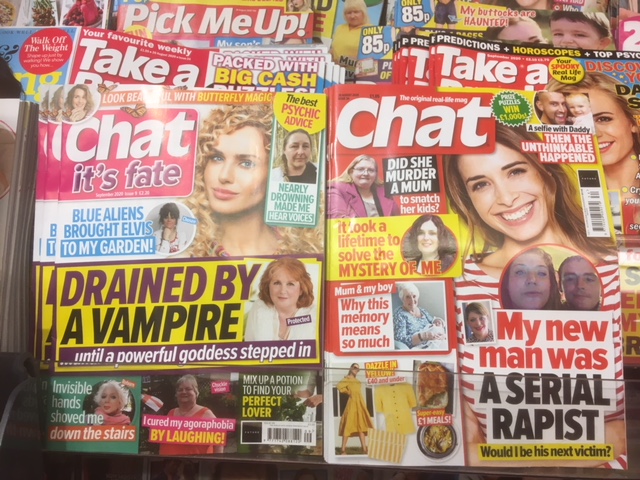
Nick Cave: ‘cancel culture is bad religion run amuck’ August 21st 2020
Australian musician criticises people’s refusal to engage with ‘difficult ideas’
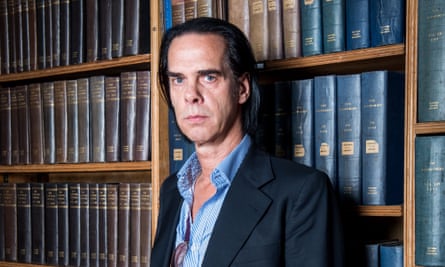
Nick Cave: ‘A force that finds its meaning in the cancellation of these difficult ideas hampers the creative spirit of a society and strikes at the complex and diverse nature of its culture.’ Photograph: The Oxford Union/ShutterstockLanre Bakare Arts and culture correspondent@lanre_bakareWed 12 Aug 2020 19.11 BST
First published on Wed 12 Aug 2020 18.18 BST
Political correctness has an “asphyxiating effect on the creative soul of a society”, according to Nick Cave, who has criticised “cancel culture” in his latest newsletter where he calls it “bad religion run amuck”.
In his latest Red Hand Files newsletter, the Australian musician was asked what he thinks of cancel culture. In response he decried people’s refusal to engage with “difficult ideas” and claimed that moving toward a more equal society could mean essential values were forfeited.
“Political correctness has grown to become the unhappiest religion in the world,” he wrote. “Its once honourable attempt to reimagine our society in a more equitable way now embodies all the worst aspects that religion has to offer (and none of the beauty) – moral certainty and self-righteousness shorn even of the capacity for redemption.”Idiot Prayer: Nick Cave Alone at Alexandra Palace review – utterly magneticRead more
He added that cancel culture’s refusal to engage with uncomfortable ideas had an asphyxiating effect on the creative soul of a society, and that creativity could knock at foundational beliefs and in doing so generate fresh ways of seeing the world.
“This is both the function and glory of art and ideas,” he said. “A force that finds its meaning in the cancellation of these difficult ideas hampers the creative spirit of a society and strikes at the complex and diverse nature of its culture.”
The musician, who recently staged a live concert at Alexandra Palace, which was described as “the most elaborately creative response yet to the constrictions of the lockdown,” ended with a rhetorical question. “We are a culture in transition,” he wrote. “And it may be that we are heading toward a more equal society – I don’t know – but what essential values will we forfeit in the process?”
Cave has regularly discussed contemporary talking points in his newsletter, which he started in September 2018, such as why he and his band the Bad Seeds decided to play in Israel and not back the Boycott, Divestments and Sanctions movement.
He has also responded to more personal topics, such as his experiences with grief after the death of his 15-year-old son, Arthur, in 2015, and answered more abstract queries, such as “what is shyness?”.
Recently he wrote a follow-up letter addressed to fans imploring them to stop sending emails to the Italian piano manufacturers Fazioli after he said he had played one of their pianos in the Alexandra Palace gig, writing an embellished, gonzo account of his manager trying to acquire one for him.
Cave had previously said that “the new moral zealotry that is descending upon our culture could actually be a good thing,” after a fan asked him in 2019 about the reckoning that was reverberating through the music world after #MeToo.
“Contemporary rock music no longer seems to have the fortitude to contend with these enemies of the imagination, these enemies of art – and in this present form perhaps rock music isn’t worth saving,” he wrote. “The permafrost of puritanism could be the antidote for the weariness and nostalgia that grips it.”Sign up for the Sleeve Notes email: music news, bold reviews and unexpected extrasRead more
In July, several well-known authors and public intellectuals signed an open letter that was published in Harper’s magazine saying the spread of censoriousness is leading to an intolerance of opposing views and a vogue for public shaming and ostracism.
JK Rowling, Salman Rushdie and Margaret Atwood were among the signatories who acknowledged that “powerful protests for racial and social justice are leading to overdue demands for police reform, along with wider calls for greater equality and inclusion across our society”. The letter went on to criticise what it called “a new set of moral attitudes and political commitments that tend to weaken our norms of open debate and toleration of differences in favor of ideological conformity”.

No wonder Africa is a basket case with Euro leaders like the U.K – Mali is now facing a coup because black leaders, ( lots of British placemen like Mugabbee,) learned from Britain and France, the art of corruption, oppressing the masses ( hence mass migration, which pleases white liberals and offers the mainly white British rich cheap labour ) and encouraging religious divisison – makes it easy to steal the natural resources.
Talking loving sad crap about slavery, atoning for white masses sins, is a smokescreen for the elite who are still slavers, but not colour biased because they never were, hence the miseries of England’s Industrial Revolution and white men enslaved to fight for the Empire. never trust the BBC on this or anything else..
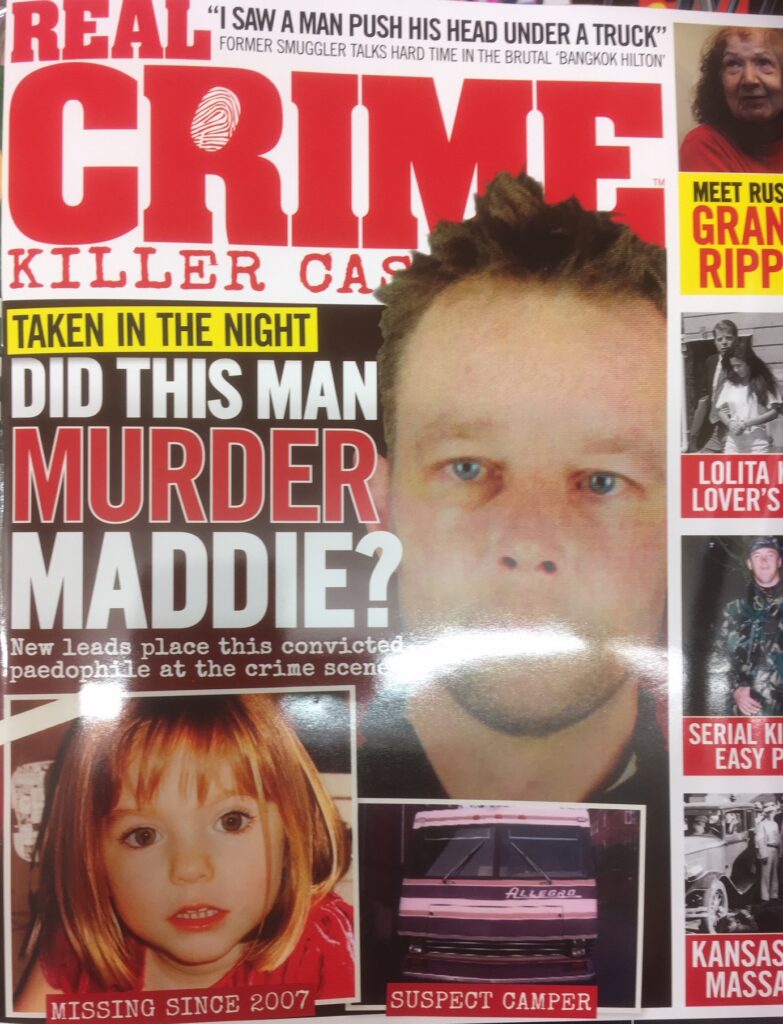
But Scotland Yard moved in to exonerate the parents, because they know best and must guard the intrests of the upper Middle Class doctor parents.
Obviously working class parents would have faced jail for child neglect at least and the other children taken into care. Meanwhile any random paedophile will do if they can fit ‘him’ up for Maddie’s death, evidence or not. Millions of pounds have flooded in to the find Maddie’s killer campaign which has gone on for years..

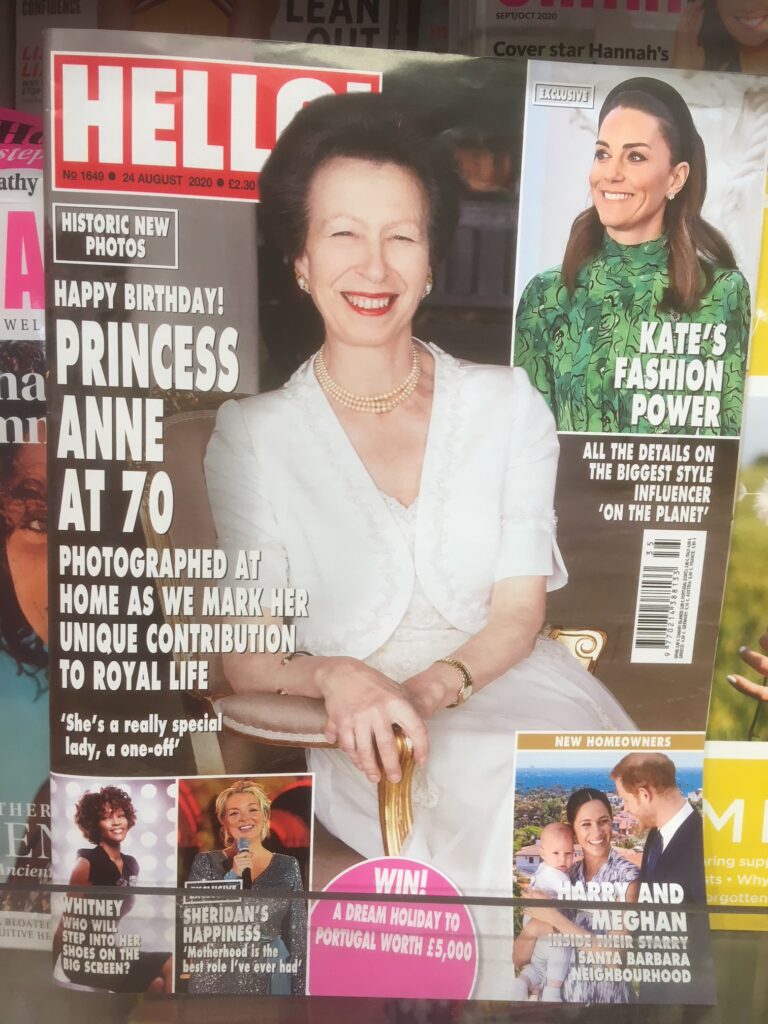
Meghan Markle makes first appearance since royal biography released
The Duchess of Sussex was the final speaker for The 19th* Represents summit
August 18, 2020 – 21:44 BST Jenni McKnight
The Duchess of Sussex turned interviewer when she appeared at The 19th* Represents virtual summit on Friday. Meghan got to ask the questions as she interviewed the website’s co-founder and CEO Emily Ramshaw about creating a transformative newsroom centred on gender equity.
When discussing with Emily the importance of a “women-focused news organisation”, Meghan opened up about her own experience of hitting the headlines.
WATCH: Meghan Markle opens up about her experience with the media
“I think what’s so fascinating, at least from my standpoint and my personal experience the last couple of years, is the headline alone, the clickbait alone makes an imprint,” the Duchess said in the pre-recorded interview.
“That is part of how we view the world and we interact with other people – there’s so much toxicity out there. In what is being referred to, my husband and I talk about it often, that economy for attention. That is what is monetizable right now when you’re looking at the digital space and media.”

Meghan Markle interviewed the website’s co-founder and CEO Emily Ramshaw
Meghan added: “You’re just trying to grab someone’s attention so you’re going for something salacious versus something truthful. So I think once we can get back to a place where people are just telling the truth in their reporting, and telling it through a compassionate and empathetic lens, it’s going to help bind people as a community.”
Emily was previously editor-in-chief of The Texas Tribune, an award-winning nonpartisan digital news start-up, and serves on the board of the Pulitzer Prize. She co-founded The 19th with her Texas Tribune colleague, Amanda Zamora, in January 2020. Emily also studied at Northwestern University – the same college as Meghan.

Meghan Markle appeared on The 19th* Represents virtual summit
The Duchess spoke to Glamour last week ahead of the interview, saying: “The 19th*’s commitment to reporting and storytelling that lifts up those who are too often underrepresented in the media has never been more important.
“I’m looking forward to asking the co-founder what it means to build a media outlet with gender equity, diversity, and community at its core.”
Meghan was among the high-profile guests to take part in The 19th* Represents’ five-day summit. It also included appearances from Hillary Clinton, former secretary of state and 2016 Democratic presidential nominee, and Melinda Gates, co-chair of the Bill & Melinda Gates Foundation and founder of Pivotal Ventures.

Meghan Markle spoke of her own experience with the media
MORE: 15 secrets we’ve learnt from Prince Harry and Meghan Markle’s royal biography
It marked the Duchess’ first appearance since the release of royal biography Finding Freedom earlier this week. The book, written by royal journalists Omid Scobie and Carolyn Durand, charts details about Prince Harry and Meghan’s relationship, from their first date in 2016 up to the couple stepping back from royal life in March 2020.
A spokesperson for the Sussexes also confirmed that the Duke and Duchess had moved into their first family home with baby Archie in Santa Barbara in July, adding: “They have settled into the quiet privacy of their community since their arrival and hope that this will be respected for their neighbours, as well as for them as a family.”
One Cock Up The Brits Struggle With August 16th 2020
Britain’s privileged white males struggle with impotence. Every night on TV, viagra is advertised. The adverts portray a frustrated female looking agonised while her man studies his lap top.
Britain was in the vanguard of women’s lib. Men are ridiculed and blamed in a society of feminist elitist orchestrated political correctness. The laws controlling sexual behaviour are a minefield for men. Women’s ex and violnece allegations in marriage are always believed. She caan even change her mind during sex and if the man does not stop, then he is a rapist. She can even change her mind the next day. She can come back years later, evidence is not needed.

The British Government has announced its plan to have more men prosecuted for rape. Starmer ‘The Harmer’ was head of the CPS that hid or witheld evidence to have innocent men convicted.
Labour’s Starmer is a big influence on British politics, with the Tories clearly lacking an identity, and Boris Johnson very weak.
Thus it is not surprising that many young white men growing up in one parent homes are queuing up for sex change. Some are still pre teen school pupils.
Not surprisingly many men are attracted to transsexuals, like the one pictured below because they are old fashioned feminine. They are seen by many extreme feminists like the Trans Exclusionary Feminists, as a threat to the aggressive harridan’s who have done so much to destroy the social fabric with all their hatred, daddy issues and power mania.

This is a remarkable behavioural contrast to the men who can’t get it up without viagra. It is an enigma, men who become transsexual can rape, but ‘normal men’ need viagra ! Add to that how many men want to get it up the likes of Roberta and it is amazing what sex has come to, thanks to my generation of libertarians.
Image Appledene Photographics/RJC


Image Appledene Photographics/RJC

The British Royal Family is basically as German as Kraftwerk. August 16th re2020
Britain’s Channel 5 aired some rather nauseating programmes intended to polish the tarnished image of Britain’s Royalty.
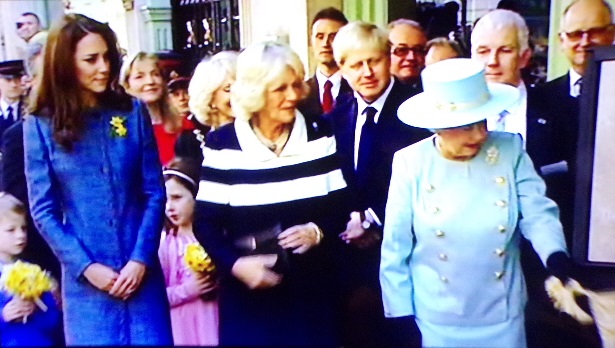
The British Royal Family is basically as German as Kraftwerk.
The story stems right back to 1714. This was the year that Britain’s Queen Anne died, after a literally painful reign during which she was crippled by gout and suffered 17 or 18 failed pregnancies. Historians quibble on the exact number, but the upshot is the last Stuart monarch – described by one onlooker as “gross and corpulent” from illness and inactivity – did not have an easy time of it, and died without an heir.
This was an era of intense religious tensions. Anne’s Catholic father, James II, had been kicked off the throne by the “Glorious Revolution”, which saw the Protestant hero William of Orange and his wife, Anne’s sister Mary, installed in his place. Anne had inherited the crown after William died in 1702, and her own death in 1714 meant a new Protestant monarch was required. That meant ignoring the dozens of Catholic contenders with much stronger claims to the throne and plucking the nearest viable Protestant instead: a man called George Ludwig, who was every bit as German as he sounds. George said he would be pleased to take the job and would not learn English. His heart never left Hanover, where his body was returned for burial.
Europe’s aristocracy have inbred for centuries. King Harold went t school with William the Conqueror. European history is brutal and few understand or bother with it. That is why Royalty lingers on in Britain. Kaiser Wilhelm II’s Germany lost World War One. His cousin Tsar Nicholas of Russia was deposed and executed by the revolutionaries in 1917, along with the Russian Royal family.
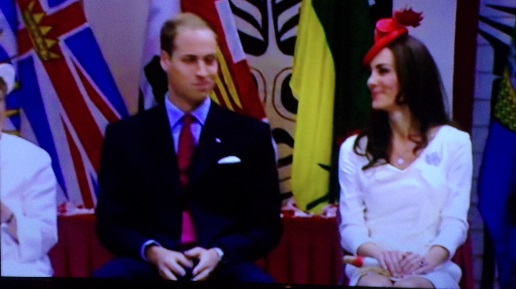
Britain’s aristocracy survived because they are cut off by the English Channel, have years of secret police expertise and the most obsequious people in Europe. They are small minded, easily led, badly educated to keep their place. Bread and circuses works for the Br5itish masses. Posh people on TV and in the press back up the work of toadying British teachers.
So we come to last week’s documentaries about Princess Diana the martyr and mother, and sweet Princess Kate and Prince William. Little attention was paid to big bulky Prince ‘Randy’ Andy. Royal image makers had been keen to integrate mixed race moaning Meghan as the back princess. It appears that Meghan wasn’t happy with second place.
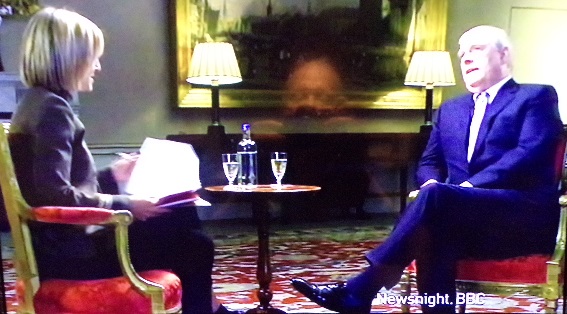
Going back to Andy, sexual licentiousness isn’t new to these sort of people. George 1st famously said that he would reject no woman so long as she was fat with big breasts. King Edward V11’s wife, was said to have had 200 lovers. Princess Diana famously had men smuggled into her palace in the boots of cars. There is more,
The documentary was shooting the line that William and Kate are an ordinary couple. These people who make TV are posh, they are not ordinary. It is all about keeping the masses at bay. We get told how wonderful multi culture is while they live in their safe ostentatious luxurious world. They are the very essence of the fake British Democracy which is shouting louder now than ever before in my long 70 years of life. Robert Cook


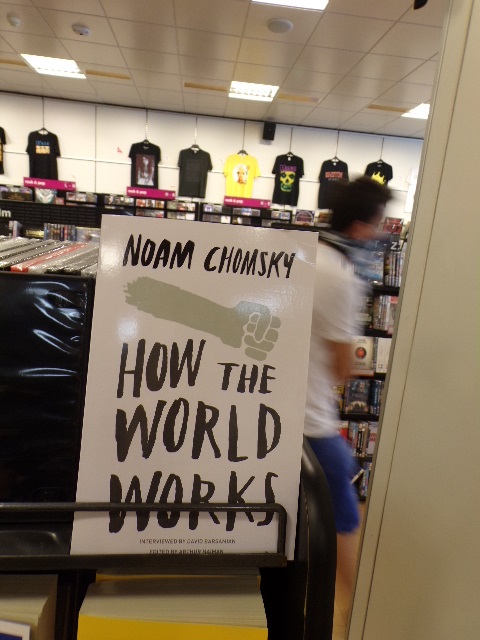
Britain’s Sex Problems and other curiosities. August 10TH 2020
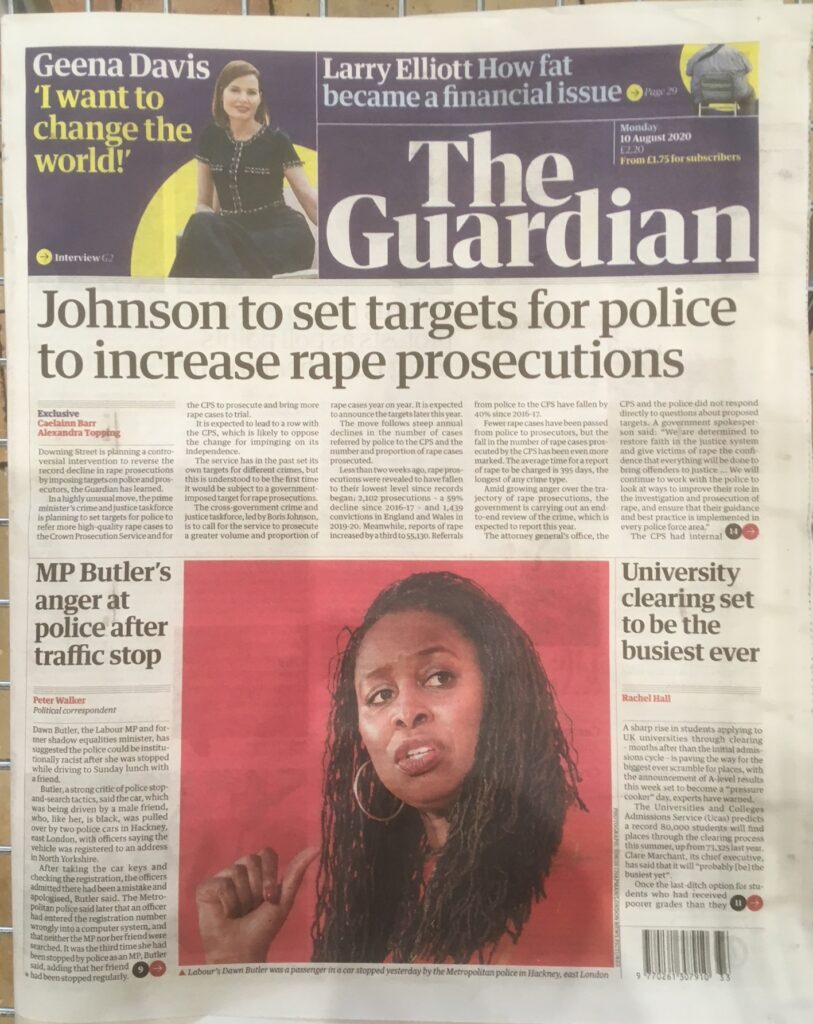
Labour’s new leader Sir Kier ‘Harmer’ Starmer headed the corrupt Crown Prosecution Service which hid or destroyed evidence to get more men convicted for rape.
When women are proven liars, women’s groups are outraged because women are perfect, only sullied and led astray by nasty violent men.That’s why they went mad when alleged abuser Caroline Flack hung herself rather than face court.
Well I think there should be targets for violent abusive females because the numbers are way higher, and studies show that females initiate most domestic arguments and are more likely to cheat on partners. They marry for status and money and expect and more from sex.
So we have the curious situation where we must believe the country is full of rapists, but men have to take viagra poppers or cocaine at an ever younger age. Then there are the record numbers of gays and male to felmale transexuals, who the feminists hate so much, their army has a special division to fight them – the Trans exclusionists.
These deranged fanatics have a lot of interesting reasons for fearing and hating trans women. The funniest thing is they think trans people have gender reassignment, losing genitals to get into female only spaces like public toilets so they can rape them





So You Think You Know the Banjo? Posted August 9th 2020
If you’ve ever considered banjo music to be an American creation, you don’t know the banjo. In fact, if you think of the banjo as an inherently Southern instrument, you don’t know the banjo. If you think that the banjo can teach us nothing about American history, Southern culture and modern race relations, then you certainly don’t know the banjo.
And you’ve probably never heard the Carolina Chocolate Drops.
Words & Audio by Jenna Strucko | Photos by Whitney Neal

For those of you like me who are not formally trained musicologists, here’s a super-quick summation of the first 400 years of banjo history:
1) The handmade gourd instruments that would become the modern banjo originated in West Africa. 2) Enslaved Africans carried the “banjar” and its music to North America by way of the Caribbean. 3) Traditional string music (and the banjo itself) was appropriated from slave culture and was spread into the greater American popular culture through minstrel shows and blackface performances. And 4) the banjo was popularized throughout the United States and Europe by white performers, with various regional playing styles emerging and evolving simultaneously – from the rhythmic role the banjo played in traditional New Orleans jazz to the fingerpicking sound of bluegrass that bloomed in the Appalachian mountains, among many others.
In short, we owe the banjo’s modern presence in America to Africans who were brought here against their will. Thus has the banjo become like okra, an undeserved gift to all parts of Southern culture, but one that came only from the people our ancestors enslaved.
If any of this is news to you, welcome to the club.

“The Old Plantation” is an anonymous folk painting from the 1700s depicting slaves dancing to banjo music.

In the last five years, pop music has become a proverbial breeding ground for a not-quite-folk “revival” of sorts, with traditional string instruments being wielded in a way that is — intentionally or not — devoid of much historical context. Bands like Mumford & Sons have reintroduced and redefined the banjo to a new generation of listeners, but without drawing clear lines to deeper musical traditions.
Meanwhile, the once-country star Taylor Swift — the same one who passionately strummed her banjo onstage at the Grammy Awards just three years ago — has unapologetically traded in her five-string for an electronic beat machine on her latest album, “1989.” The fact that this drastic interchange was so easily achieved and widely unquestioned points toward the expendability of the banjo in pop music today.
We’re seeing more banjos than we have in years, but the instrument seems more of a novel accessory than a necessity to many artists.
With its mixed bag of presentations in today’s popular music, it’s easy to see how the banjo is suffering from an incredibly vast identity crisis. In this era of “fauxlk” music, [quite literally “faux-folk” music], the true origins of the banjo get lost in the broad sweep of popular culture.
But if we wind back the clock and parse out the pieces of the banjo’s history that have been widely forgotten, the result is a fascinating picture of America (and, specifically, of the South) that can teach us incredible things about ourselves and provide a stepping stone to a greater understanding of one another.
Thankfully, the Carolina Chocolate Drops are here to help us out.

The Carolina Chocolate Drops: Malcolm Person, Rhiannon Giddens, Hubby Jenkins and Rowan Corbett.

Experiencing a performance by the Carolina Chocolate Drops is like taking a crash course in the parts of American history you had no idea you’d missed. As one of the few all-black traditional string bands performing today, the group has become a champion for the history of old-time string music, which they make clear by weaving historical and contextual information into their live performances.
The Drops’ 2010 album, “Genuine Negro Jig,” won the then-trio of Rhiannon Giddens, Dom Flemons and Justin Robinson a Grammy for best traditional folk album and sparked a wider conversation about the rich lineage of string music in the Southern black community. The press release that accompanied the album called it “the sound of history revealing itself,” and the revelations continue despite changes in the group’s lineup. Rhiannon Giddens is the only member of that Grammy-winning trio still in the band today, but the spirit from which the Carolina Chocolate Drops were born — one of passion, talent and heritage – remains unchanged.
The Drops today are a quartet of multi-instrumentalists, each of whom arrived at old-time string music from a different place: Rhiannon Giddens through contra dances and playing with legendary fiddler Joe Thompson, Hubby Jenkins through playing country blues music, Rowan Corbett from a love of Irish music, and Malcolm Parson through old-time jazz and the cello. Despite their differing backgrounds, they’re all united by their passion for traditional string music and an educational mission that aims to bring the true origins of their own musical tradition to light.


Rowan Corbett

Rhiannon Giddens

Malcolm Parson

Hubby Jenkins

This past October, I had the chance to sit down with the Carolina Chocolate Drops on the stage before the second show of a two-night stand at the Clifton Center in Louisville, Ky. With their instruments surrounding us but not too close at hand, we talked at length about the stories and historical tidbits that normally fill the time between songs in their live performances. I wanted to learn about the banjo itself — not just its history, but its cultural and racial significance.
The Drops were happy to oblige, and their words still resonate in my head and heart months later.
In all honesty, this project may have affected me more deeply than any other I’ve had the chance to work on. The quartet’s insights into the greater narrative of the banjo and what it means for all of us demonstrated real wisdom, punctuated with intentionality and passion. The Drops synthesized vast information about the banjo’s lineage into a comprehensible body of knowledge, and then conveyed it to me with tact, emotion, poise and honesty. I actually left that stage with a new outlook on the world and my place in it. I felt more aware and challenged than ever, but also exhilarated and inspired. My hope is now to “get to the roots of things,” as Hubby put it — to seek a similar level honesty and truth in all that I do.
And I have the Drops to thank for that.
In that spirit, it felt most apt to share with you the thoughts and ideas the Drops so graciously shared with me in the most direct way possible. To read their words is one thing. To hear Rhiannon, Hubby, Malcolm and Rowan speak them is quite another. I hope they will be as meaningful to you as they were to me.
So now, let me tell you this story in an unconventional way — with a few of our own words in front of your eyes, while the Drops speak to you directly. Grab your headphones and listen — with an open mind and heart — as we set the record straight about the banjo.

In its first 400 (or so) years, the banjo has spanned continents, crafted musical genres and crossed borders of many varieties. Without missing a beat, Rhiannon Giddens sums up the “bullet points” of banjo history and playing styles.

Jenna Strucko interviews the Drops on stage at the Clifton Center in Louisville.

Why does the banjo have so many origin stories? Some consider the banjo a Scots-Irish instrument, some think it hails from the hollers and front porches of the Appalachian Mountains, and some have only ever heard it as a passing addition to a Top 40 song. But the African roots of the banjo have not been entirely forgotten.


In spite of the American tendency to appropriate cultures without attribution or apology, our melting pot at large often produces incredible synergies, and the modern banjo is no exception. This is why the banjo’s evolution through a “clash of cultures” is a beautiful thing.


We already know the banjo has the power to define the South. Look at “Hee Haw,” “The Beverly Hillbillies” and “Deliverance.” But what would happen if that narrative were more well-rounded? Beyond those TV reruns, the banjo tells tales of finding hope and connection in the most unlikely of places. Here’s to taking back the narrative and setting the story straight.


These days, the need is greater than ever for genuine conversation about the intangible parts of our culture that are difficult to discuss — race relations, privilege, fear and many more. And while the voices are louder and more numerous than ever, entry points into genuine conversation are harder to come by. Thankfully, music can offer an avenue to begin productive discussions, but only if we listen.


I’ve heard it said that most people can transform vast amounts of information into knowledge quite easily, but gaining true wisdom about a subject often comes only after someone provides context and connections to help us synthesize our solitary pillars of knowledge. In no small way, the Carolina Chocolate Drops stand in the gap between knowledge and wisdom, providing the context we all need to better understand our shared musical history and better relate to one another.


As this exploration draws to a close, I find myself reflecting most on Rowan Corbett’s simple but potent questions: What other stuff have I been missing? What other things have I only scratched the surface of?
Exploring the history of the banjo has shifted my perspective on the way that I want to move through the world. I used to think I knew the banjo; now I know differently. I will no longer accept anything at face value, but I will choose to dig deeper, to find the roots and truths of things, and peel back the layers until the inevitable wisdom reveals itself.
And like the Carolina Chocolate Drops, I choose to see the beauty and hope in the banjo’s history, as well as its potential to bring people together.
Besides, just like Hubby Jenkins told us, the banjo is the friendliest of all instruments.

Email *
BBC Drops First Trailer for Steve McQueen’s ‘Mangrove,’ Part of ‘Small Axe’ Anthology

Naman RamachandranVariety7 August 2020
U.K. broadcaster BBC One has released a punchy trailer for “Mangrove,” one of five films from the “Small Axe” anthology by Oscar and BAFTA winner Steve McQueen (“12 Years a Slave”).
Aug. 9 marks the 50th anniversary of the day in 1970 when 150 protesters of West Indian, African and South Asian heritage in Notting Hill, West London, marched to local police stations in protest of police harassment in their communities, including the Mangrove restaurant. Nine protest leaders were arrested and charged with incitement to riot: Frank Crichlow, Darcus Howe, Altheia Jones-LeCointe, Barbara Beese, Rupert Boyce, Rhodan Gordon, Anthony Innis, Rothwell Kentish and Godfrey Millett. The group later became known as the ‘Mangrove 9.’
More from Variety
- Steve McQueen’s ‘Lovers Rock’ to Open New York Film Festival
- Diego Luna on ‘Pan y Circo,’ His New Dinner-Discussion Series with Amazon Prime Video
- Amazon Earnings Smash Forecasts in ‘Highly Unusual Quarter’ Amid Pandemic
“It was a march necessitated by relentless police brutality in Notting Hill,” said McQueen. “To commemorate the bravery of these community activists and the nine who went on to be acquitted of incitement to riot with the judge citing ‘evidence of racial hatred,’ I am sharing the trailer of ‘Mangrove,’ one of five films to be released under the banner ‘Small Axe.’”
“Mangrove” tells the true story of the Mangrove 9, and their highly publicised trial that followed. The trial was the first judicial acknowledgment of behavior motivated by racial hatred within the Metropolitan Police.
The cast includes Letitia Wright (“Black Panther”), Shaun Parkes (“Lost in Space”), Malachi Kirby (“Curfew”), Rochenda Sandall (“Line of Duty”), Jack Lowden (“The Long Song”), Sam Spruell (“Snow White and the Huntsmen”), Gershwyn Eustache Jnr (“The Gentlemen”), Nathaniel Martello-White (“Collateral”), Richie Campbell (“Liar”), Jumayn Hunter (“Les Misérables”), and Gary Beadle (“Summer of Rockets”).
“Mangrove” was co-written by Alastair Siddons and McQueen. “Mangrove” alongside “Lovers Rock” are part of the Cannes 2020 Official Selection.
Other films in the “Small Axe” anthology are “Education,” “Alex Wheatle” and “Red, White and Blue.” Set from the late 1960s to the mid-1980s, the films each tell a different story involving London’s West Indian community.
The anthology is executive produced by Tracey Scoffield and David Tanner for Turbine Studios and Steve McQueen for Lammas Park. Mike Elliot is producing for EMU Films with Turbine and Anita Overland. Executive producers for the BBC are Lucy Richer, senior commissioning editor for drama, and Rose Garnett, director of BBC Films. Amazon Studios is co-producing within the U.S. while BBC Studios are handling global television sales.
U.K. broadcaster BBC One has released a punchy trailer for “Mangrove,” one of five films from the “Small Axe” anthology by Oscar and BAFTA winner Steve McQueen (“12 Years a Slave”).
Aug. 9 marks the 50th anniversary of the day in 1970 when 150 protesters of West Indian, African and South Asian heritage in Notting Hill, West London, marched to local police stations in protest of police harassment in their communities, including the Mangrove restaurant. Nine protest leaders were arrested and charged with incitement to riot: Frank Crichlow, Darcus Howe, Altheia Jones-LeCointe, Barbara Beese, Rupert Boyce, Rhodan Gordon, Anthony Innis, Rothwell Kentish and Godfrey Millett. The group later became known as the ‘Mangrove 9.’
More from Variety
- Steve McQueen’s ‘Lovers Rock’ to Open New York Film Festival
- Diego Luna on ‘Pan y Circo,’ His New Dinner-Discussion Series with Amazon Prime Video
- Amazon Earnings Smash Forecasts in ‘Highly Unusual Quarter’ Amid Pandemic
“It was a march necessitated by relentless police brutality in Notting Hill,” said McQueen. “To commemorate the bravery of these community activists and the nine who went on to be acquitted of incitement to riot with the judge citing ‘evidence of racial hatred,’ I am sharing the trailer of ‘Mangrove,’ one of five films to be released under the banner ‘Small Axe.’”
“Mangrove” tells the true story of the Mangrove 9, and their highly publicised trial that followed. The trial was the first judicial acknowledgment of behavior motivated by racial hatred within the Metropolitan Police.
The cast includes Letitia Wright (“Black Panther”), Shaun Parkes (“Lost in Space”), Malachi Kirby (“Curfew”), Rochenda Sandall (“Line of Duty”), Jack Lowden (“The Long Song”), Sam Spruell (“Snow White and the Huntsmen”), Gershwyn Eustache Jnr (“The Gentlemen”), Nathaniel Martello-White (“Collateral”), Richie Campbell (“Liar”), Jumayn Hunter (“Les Misérables”), and Gary Beadle (“Summer of Rockets”).
“Mangrove” was co-written by Alastair Siddons and McQueen. “Mangrove” alongside “Lovers Rock” are part of the Cannes 2020 Official Selection.
Other films in the “Small Axe” anthology are “Education,” “Alex Wheatle” and “Red, White and Blue.” Set from the late 1960s to the mid-1980s, the films each tell a different story involving London’s West Indian community.
The anthology is executive produced by Tracey Scoffield and David Tanner for Turbine Studios and Steve McQueen for Lammas Park. Mike Elliot is producing for EMU Films with Turbine and Anita Overland. Executive producers for the BBC are Lucy Richer, senior commissioning editor for drama, and Rose Garnett, director of BBC Films. Amazon Studios is co-producing within the U.S. while BBC Studios are handling global television sales.
The films will debut on BBC One and Amazon Prime Video this fall.
David Schwimmer Provides An Update On The Friends Reunion Special
David Schwimmer has provided an update for Friends fans on if and when the delayed reunion special will take place.By Josh Coulson Jul 22, 2020
David Schwimmer has confirmed that the Friends reunion special is still happening, and taping might start as soon as next month.
Nostalgia has very much been the order of the day when it comes to most forms of entertainment for the past few years. Old films are getting long-awaited sequels, and video games from the late 90s and early 00s are getting remastered. Plus, the pandemic has brought actors from some of our favorite TV shows back together for one-off Zoom calls, a sentence that wouldn’t have made any sense if written and read this time last year.
Parks & Recreation and Community are just a couple of examples of shows whose casts have reunited for one-off specials over the past few months. However, before anyone had even heard of COVID-19, at least on a global scale, there was talk of a Friends reunion. Not just talk, but the special was confirmed to be taking place exclusively on HBO Max and would include all six of the original cast members.
Warning from our fashion editor Ms R Jane Cook August 7th 2020

Hope our police state cop readers like this picture.
Don’t mess up your helmets or truncheons boys. See you soon. Tasers give amazing orgasms I am told !.
Image Appledene Photographics/RJC
Before you read the following, please note this site’s opinion that the reason the fashion gurus say the ‘skinny jean is dead’ is because the country is full of fat women who are home alone comfort eating and drinking, hiding from the dreaded ubiquitous killer Covid19.
As far as I am concerned, with my wonderful figure, I will still be wearing my skinny jeans. Of course feminists hate skinny jeans, mustn’t show off if you have a good figure. Wear baggyy pants and hope your lover has enough viagra to avoid your prolapse of the vaginal canal or get a good rampant rabbit. I could say worse things that have just occured to me.
R Jane Cook
The Skinny Jean Is Dead: The 5 Denim Styles You Need Now
Shopping for jeans just got a lot easier. That unforgiving, leg-hugging style has made way for a looser look
By Bibby Sowray and Updated by Natasha Bird 28/07/2020
I have vivid memories of my mum wearing classic Levi’s jeans (501s, specifically) – stonewashed, high-waisted with a button-fly and loose tapered legs in signature thick denim – throughout my childhood to do the gardening or take the dog on a muddy walk. These were the ‘mom jeans’ before mom jeans became a thing.
As I hit adolescence, when replicating Kate Moss and Sienna Miller in their super-skinny Sass & Bide ‘Misfits’ (remember those?) became my ultimate goal, I would tease her about how ‘dated’ her pale Levi’s jeans were. ‘They’ll come back around one day,’ she’d say, like all mums do.
She was right: they did. Now her single pair of life-worn Levi’s make me look like the dated one. I own 24 pairs of jeans – and every single one of them is skinny.

Christian VierigGetty Images
After years of riding high, this style is now the bedridden former rock star of denim, clinging on for dear life as it watches its younger, peppier counterparts steal the limelight. Sure, Kate Moss is still wearing them occasionally, but she’s Kate Moss and I, sadly, am not.
What used to be my fail-safe outfit, the staple that formed the basis of every single look I wore, now makes me feel lumpy and overexposed. No matter what I pair them with, the proportions somehow feel all wrong.
Jean Styles That Aren’t Skinny
Best Everyday Flared Jeans Topshop – £29.99
Topshop’s ‘editor’ style is now so ubiquitous, that you’ll want to migrate to something fresh, to stand out for the crowd. And if you’re looking for an everyday style, that pairs as easily with a crisp white shirt as it does with a slouchy tee, then these simple flares are a good shout. All Rounder Straight Leg Loewe – £450
A statement (because when is something Loewe ever not a statement) but easy to wear with just about anything, from flip flops at a beach café, right through to boots and a cashmere sweater, to formal things up a bit. Straight leg jeans are the best jeans for swapping out your skinnies. New Trend Patchwork Jeans Acne Studios – £350
Patchwork denim is the latest in a long line of 70s styles to make it back into popular culture. If you’re not quite ready to take on wide-legged floor sweepers made of clashing patches, then you might consider Acne Studios’ more summery, subtle approach to patchwork denim. Big Statement Mega Wide Leg Khaite – £370
If you really want your jeans to do the talking, then consider investing in some mega-wide legged jeans. However, copious denim touching the ground during one of Britain’s infamous spring showers is not ideal – you’ll bring half the rainwater home with you – so a cropped style is ideal. These are also deceptively flattering. Tough Girl Tapered Jeans Re/Done – £245
Want to wear those combat boots you’ve seen everywhere? Or the Prada trainers with the tractor tread? You’ll need a suitably tough-looking jeans style to pair them with. And these perfectly fit the bill. They’re high rise enough to be flattering, but the tapered shape gives them a military flavour, perfect for stomping around in with chunky soled shoes.
I’m not the only one who feels this way, either. ‘As I get older, it’s not about showing off skinny legs, or figure-hugging clothing – feeling comfortable in my clothes and in myself is more important,’ says fashion editor and The Frugality blogger Alexandra Stedman. ‘Plus, the denim styles at the moment are moving away from slick silhouettes to more relaxed and voluminous – and I love that.’

.Getty Images
Parisian writer and creative consultant Camille Charrière, agrees. ‘It was very hard to get out of skinnies, especially being French, but now I find it hard to get back into them. I think it comes with being a certain age – you look more rock’n’roll in skinny jeans, but more elegant in boyfriend jeans,’ she says, adding that she finds the best jeans courtesy of Levi’s, Monki and H&M.
But where did it all go wrong for skinny jeans? ‘Jeggings ruined them,’ says Donna Wallace, ELLE’s former Accessories Editor, who favours a pair of Lee straight-leg men’s jeans that she’s cut off at the hems. ‘As soon as they started bastardising the denim and putting in too much stretch, it became trashy.’
Not to mention, that the elastane you find in your typical pair of skinny jeans or jeggings is unrecyclable and deeply bad for the planet.
Our perception of what looks cool has shifted, and though I’m a little miffed to realise that the skinny jean isn’t, as I had previously thought, my denim life partner, it’s a sign of a greater shift in fashion, and that is always exciting.

Brands such as Vêtements, the Parisian underground collective turned game-changing fashion powerhouse, and London-based Marques’Almeida, have heralded the return of true denim. They’ve reminded us of a pre-skinny golden age when it was thick, stretch-free and more of a statement than just an off-duty staple. Think Farrah Fawcett on that skateboard, Thelma and Louise mid-road trip, Jane Birkin in her spliced and re-stitched flares.
The way we shop has changed, too. ‘It used to be that a customer might find one style or fit they preferred and stick to that,’ says Topshop Buying Director Emma Fox, ‘but now they are building up their jeans wardrobe with different shapes, cuts, washes and finishes according to what they want to wear that day.’

Getty Images
Proof? From high street to high end, we’re buying more jeans than ever before, with price points across the board. Net-a-Porter had been reporting a 25% increase in denim sales year-on-year, and for a while couldn’t keep Vêtements‘ now-iconic style in stock, despite its eye-watering £790 price tag. Meanwhile, ASOS saw sales up 47% in the course of three months a few years ago, when the skinny jean began its demise and has sold an incredible 12,000 pairs of its washed blue ‘Farleigh’ Mom jean, priced at just £35.
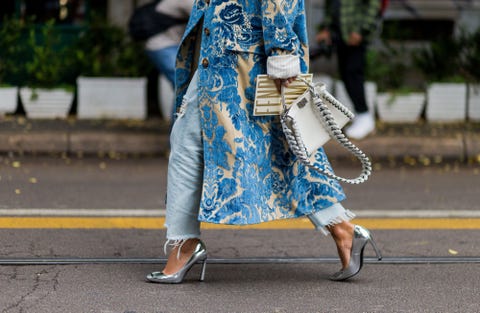
‘The influence of street style on this is undeniable and the result is that we are seeing trends emerging upwards from the street to influence designers, rather than the other way around,’ says Lisa Aiken, Net-a-Porter’s Fashion Director.
The street-style phenomenon, made possible by the growth of digital and social media over the past decade, means that we now have endless inspiration at our fingertips. We can see how real people make clothes and how trends work for them in real life, rather than solely through the creative filter of a major fashion house. This has undeniably made us more adventurous, more confident and far more attuned to our own personal style. In turn, we’re now more diverse in our denim choices, and far less likely to head sheep-like into a mass trend.
And while voluminous styles have reigned supreme for a few years, their latest incarnations for this season (and next) are more deconstructed. From sweeping selvedge denim styles in indigos and rich blues, we’ve now seen the emergence of paler styles and the best jeans for the coming months? If you’re prone to trusting Dior (and aren’t we all) then the Dior Cruise 2021 show heralded a 70s-inspired nostalgia for patchwork denim.
Are you ready for the patchwork denim return?

Dior Cruise 2021 Stephane Cardinale – CorbisGetty Images
THE JEAN TRENDS TO BUY NOW
1. Split Hem Flares

Edward BerthelotGetty Images
In recent years, we’ve seen popular jeans styles typified by a true straight leg, loose fit and often turn-ups – boyfriend jeans being the easy departure from the skinny jean. But slimmer styles are creeping back at a snail’s pace, though not quite with the elastane-infused, ankle hugging guise that they used to have. Maintaining our re-awakened love for true denim, split hem flares are the jeans style that allows for a modicum of body con, without creating carrots out of your legs with elasticated fabrics and allowing for a rock-and-roll boot.
Thanks in part to Victoria Beckham, who championed the split-hemmed trew in her SS19 show, the open bottom style has been growing in popularity ever since, with a number of big name denim brands taking it on as signature. M.i.h. for example, have an excellent high rise kick-flare with a front split and Nasty Gal do an excellent split hem in a boyfriend cut for slouchier days.
How to style them? Part of the split-hem’s virtue is that it’s a new concept, and doesn’t sequester itself away in either the ‘smart’ or ‘casual’ categories. Pair it with a roll neck or slouchy tee for grungier moments, or with a blazer and heeled shoe for an evening event.
2. Re-constructed denim

The new wave of denim has seen something quite remarkable – the creation of a ‘cult’ jean that doesn’t involve the production of any new denim at all. Otherwise known as ‘second life denim,’ brands are trading on our partiality for custom styles and two-tone designs, to create covetable jeans styles from salvaged denim. If Kendall Jenner can sport a look that sees two jeans styles spliced together, then so can the rest of us, right?
And plenty of brands are hopping on the bandwagon. Environmentally conscious brand E.L.V. Denim makes jeans from old or discarded denim and can even produce ‘made to measure’ styles, to ensure they hold a true staple position in your wardrobe. They make a pair of straight leg ‘contrast’ jeans in two-tone fabric that are set to be the next ‘it’ style.
They’re not the only ones at it though. Spanish brand Desigual recently partnered with Ecoalf, to produce styles made entirely out of recycled denim. LA-based Re/Done has for a long time had a similar approach, taking vintage Levi’s apart at the seams and repurposing the fabric to create one-of-a-kind jeans that are made all the better by the worn denim.
How to style them? The jeans make the statement, so don’t over-think the rest of your look. Keep the top half of your outfit fairly relaxed. A tee or hoodie works.
3. Green Denim

Christian VierigGetty Images
Nope, not emerald hued jeans. We’re talking planet-friendly denim. Of course, for the true eco-enthusiasts, creating any new fabric from scratch is a nefarious practise, but as the fashion industry still churns on at pace, brands adopting more sustainable manufacturing processes are being heralded as part of the solution.
A whole slew of denim brands have begun pledging to lead the charge for denim innovation. J Brand, for example, committed to becoming one of the only 100% sustainable denim brand before the end of this year. They claim to use 99% less water, plus they recycle hardware and offcuts, as well as laser distressing instead of stone washing their denim.
Los Angeles and London based FRAME similarly have included more sustainably focussed jeans styles.
4. Wide Leg Selvedge

Christian VierigGetty Images
High waisted jeans are everywhere and have been for a long time. This new denim style, however, is essentially the antithesis to the skinny, taking the snug fit out of your jeans and replacing it with an extremely loose fit, in non-stretch denim. Usually cropped to an ankle hovering length, the high-rise wide-leg jean is a nod to the Seventies, but requires no platform boot to make it wearable. The crop lets you show off your – currently on trend- Western-style cuban heel.
This year’s update to a style that has been around a couple of seasons, is the wider leg in a selvedge denim. Selvedge denim is formed using an old-fashioned weaving technique – one performed on a loom, but the practise has been modernised, this was the way denim was created before we bought into the type of machinery that allowed for mass production.
A nod to ‘slow fashion‘, the wider leg jean in a selvedge style is a middle finger to disposable buying habits. The tougher grain means it’s a hardy style to invest in and stands to exist in your arsenal for longer.
How to style them? The emphasis here is on the ankle, so style this jean with a high-heeled patent boot or a trophy shoe. Keep it neat up top with a short jacket.
5. Patchwork Jeans

Christian VierigGetty Images
Thanks to Dior’s 2021 Cruise show, we saw the resurgence of patchwork denim, in slouchy styles with plenty of fabric. For those that remember patchwork denim in their first incarnations, it will be difficult to banish thoughts of tassels, suede, triangle tops and bandanas, but rest assured there are plenty of ways to incorporate patchwork denim into a fashion-forward outfit, without going head first into peace and love hippy-dom.
How to style them? A naturally casual jean style, these are best suited to plain white tees and relaxed footwear like boots and trainers. The Denim Revolution – Jeans You Need To Invest In Boyfriend style high rise jean with wide leg E.L.V. Denim – £315SHOP NOW High-rise wide-leg jeans Reformation – £165.00SHOP NOW Grace frayed high-rise wide-leg jeans SLVRLAKE – £325.00SHOP NOW Basic cotton slouchy jeans Pull & Bear £25.99 SHOP NOW Tube cropped low-rise straight-leg jeans Balenciaga – £425.00SHOP NOW Mozik colour block jeans Monki – £40 SHOP NOW Split-hem jeans Topshop – £40SHOP NOW The Scrapper frayed mid-rise straight-leg jeans Mother – £295.00SHOP NOW Topshop oversize balloon hem jeans Topshop – £49SHOP NOW Oriana high-rise straight-leg stretch-denim jeans L’Agence £265.00 SHOP NOW Workmans paneled cotton-canvas straight-leg pants Re/Done – £335.00SHOP NOW Le Pixie cropped high-rise flared jeans FRAME – £235.00SHOP NOW Topshop blue mid ‘mom’ jeans Topshop – £40SHOP NOW Aries ‘Carpenter’ high rise wide leg jeans Aries – £275SHOP NOW
Related Story The Denim Trends That Defined Every Decade Related Story Where The ELLE Fashion Team Buy Their Denim
Caroline Flack inquest: ‘No doubt’ presenter intended to take own life Posted August 6th 2020

Facing trial accused of assaulting her boyfriend, a coroner has ruled.
The ex-Love Island and X Factor host was found dead at her home in Stoke Newington, London, in February.
An inquest at Poplar Coroner’s Court heard Ms Flack’s mental health had deteriorated following her arrest and she had been “hounded” by the media.
Coroner Mary Hassell ruled her death was suicide.
Ms Hassell said Ms Flack had killed herself after an “exacerbation and fluctuation” of ill health and distress.
Ms Flack was found dead at her home while she was facing trial accused of assaulting Mr Burton – a charge she denied.
The inquest heard the Crown Prosecution Service (CPS) had initially pursued a caution against Ms Flack, but withdrew it after the Metropolitan Police said it believed it was in the public interest to bring an assault charge.
The presenter’s mother Chris told the court she thought her daughter had been “seriously let down by the authorities and in particular the CPS for pursuing the case”.
Ms Hassell said she was “satisfied [Ms Flack] wanted to cause her own death” and “there’s no doubt in my mind at all”.
“For some, it seems she had a charmed life – but the more famous she got the more mentally distressed she became,” she said.
“Her trauma was played out in the national press and that was incredibly distressing for her.”
The inquest heard how sections of the media had been “hounding” Ms Flack after she was charged with assault.
Recording a suicide verdict, Ms Hassell said: “I find the reason for her taking her life was she now knew she was being prosecuted for certainty, and she knew she would face the media, press, publicity – it would all come down upon her.
“To me, that’s it in essence.”
Mrs Flack wept as she told the coroner over video link: “I think you got it spot on.
“We know you are not allowed to say certain things and it’s up to us if we want to take it any further, and we don’t.”
She previously told the inquest that if Ms Flack had been a “normal person”, the police and CPS wouldn’t have “been bothered” to charge her.
Addressing Det Insp Lauren Bateman, Mrs Flack said: “No real evidence was put forward. If it was an ordinary person, you wouldn’t have been bothered.
“You should be disgusted with yourself. That girl killed herself because you put an appeal through.”
Det Insp Bateman said: “I was not biased and I treat everyone the same.”


As for paedophilia, there is plenty of evidence that women do that as well , but as with women’s domsetic violence, there are always mental health or abuse excuses for the bad things they do. Thus it no surprise that men have the worst reputation and are more likely to be reported and prosecuted than women.
This is what Ms Flack expected to happen, and woulld have been ssurprised to face court. The reality is that women have inflicted very nasty injuries on their male parners and are more likely to use weapons. They have also kille -,even committing the assualt of cutting off a man’s penis while he slept -using the usual abuse excuse, and getting away with it. Robert Cook.

Why does feminism still make people angry? Posted August 6th 2020

Getty Images
From suffragettes to the politics of #MeToo, Anna-Marie Crowhurst celebrates 21st century activism reclaimed by a new generation, but asks: why are some people still so upset about equality for women?
When people ask you what you do for a living, does your answer make people angry? Recently I discovered that what I do does. Now being a writer – the question people ask next. ‘What are you writing?’ My new book, Badly Behaved Women, is a cultural history of modern feminism. Yet I discovered invoking that word, ‘feminism’ makes some people angry. Why? Why does feminism still make people angry?
Celebrating the women’s movement, my book encompasses groovy feminist artists and fearless filmmakers; period pride and pay gap protests; #MeToo and #BlackGirlMagic, Riot Grrrl and Beyoncé. I loved writing it – researching the strides feminists made towards equality – and their powerful expressions of dissent.
It’s inspirational and life-affirming to hear what amazing women have to say about feminism today – from Emeli Sandé and Helen Pankhurst to Juno Dawson and Diana Evans. And it’s been a privilege to learn the stories of important feminists from the past. 
Anna-Marie Crowhurst (Photo Credit: Patricia Board)
The angry people
On a working holiday recently, a woman asked what I was writing. ‘A book about feminism’ instantly affected her. She bristled as if I’d said something distasteful. Feminism.
‘Oh,’ the woman replied. She then hunched up her shoulders. Her eyes narrowed. And then: ‘It’s gone too far, hasn’t it? Why don’t women want to be feminine? In my day, you enjoyed compliments from men. Now no one can say anything!‘
Sigh. I tried to explain. ‘Actually, my book’s a history of everything feminists have achieved!’ Before realising I was wasting. My. Time.
‘I just don’t understand why women want to be better than men,’ said a visibly agitated male relative. ‘People should be equal – but the thing with feminism – what is it about putting men down?‘
Answer: Again, not what feminism or the book is about. URRRGH.
We all know ‘angry feminist’ is used to denigrate. Black feminists particularly are critiqued and stereotyped as ‘angry’. It’s also the first thing trolls turn to when criticising on social media.
The first feminists
The first feminists – the suffragists – got called angry, too. Especially when their ‘Deeds Not Words’ campaign saw some of them smashing shop windows and setting fire to pillar boxes. This was desperation, really, because at that point, no one was listening.
When the suffragists began campaigning they provoked great anger. Why? Because women were only seen as wives and mothers, it was men who went to work and held political power. Anger towards the suffragists translated into violence, prison sentences, force feeding and public shaming. 
Badly Behaved Women (£20) by Anna-Marie Crowhurst is published on 6 August 2020 by Welbeck
Since then almost everything feminists have done has made some people angry. The women’s liberation movement was an enormous cultural revolution inciting widespread social change. It was 1968 and women were starting to break out of their unfulfilling pointy-bra-ed lives as housewives.
Fear of change
The second wave feminists wanted equal pay, workplace equality, free contraception, legal abortion and free childcare. The dream was equality. But the reality was people angry at women stepping out of line. Newspaper headlines made them sound crazed, violent, outrageous and reported bra burnings that never happened.
Anger towards feminism isn’t just about fear of change. I know misunderstandings about feminism are at the heart of these personal experiences. Probably because feminism is such a broad church, while some of the more extreme aspects of feminism are the ones reported and sensationalised. Misandry and feminism get confused. Ideas about navigating male-female relationships get muddled.
I’m proud to call myself a feminist, documenting over 120 years of feminist achievement. Writing about the suffragists, the Greenham Common campers, the ‘wolf pack’ protestors, and the Women’s March-ers makes me realise dissent is essential for change. To create change big things have to happen. And that might make some people angry. Tough.
Badly Behaved Women: The Story of Modern Feminism by Anna-Marie Crowhurst is published by Welbeck (£20, hardback format) on August 6th
Why do men need viagra ? August 5th 2020

Britain’s Sex Problem August 4th 2020

Abuse they say is a male thing. Well no wonder young men, like the old, can’t get it up. Sex is too political and too dangerous. Female physical and verbal abuse of men is not taken seriously. Their fantasy world comes first, often to the cost of children assuming they deign to have any..
Women get bored with the boring men they create, and then cheat, always blaming the man. So the man with his ‘floppy’ must ‘Do Something’ so commands the Nu Man poster, on TV every night after the kiddies have gone to bed..

I had a violent verbally abusive lying wife who abused a son and admitted hitting me on four occasions she could remember. She became a turn off, a person I learned to avoid , but one can never escape a violent woman, and the system never believes you if you are a man.
Feminists Nazis have caused this problem, along with all the career mania which has been exposed as emphemeral by the lockdown with lots of men losing their desire along with jobs and self respect, by order of the elite.


These psychos want power and men must submit to them. Modern young women are being conditioned into a world where their desired dominance creates transsexuals, manginas, homosexuals and suicides. Covid backed Mass unemployment is taking away the careers that have made women so repellent.
Loneliness is a big issue. White women don’t want babises, the Third World will supply them, along with a resurgence of backward looking tyrannical Islam and Caholicism. As I write, a massive bomb has gone off in Islamic Lebanon. To most people in the U.K it will mean nothing. Serious dissidents and critics like myself will not last much longer.
I am already under police watch. I fear very much for my son, otherwise I would just like to be gone from this world, no memorial, no service with a God I have learned – assuming it exists, which I doubt- to be cold and indifferent, treating me and my son just like more lab rats. That is what we are. So I have no care for seually frustrated women and no time for viagra. For me no mourners, I have no friends other than my son and one dying of cancer up in Ormskirk. I have had enough of this dreadful world run by vile greedy pleasure bent power mad hypocrits, so just cremation and just hopefully ashes scattered on my field. Robert Cook
The Pain Goes On August 3rd 2020
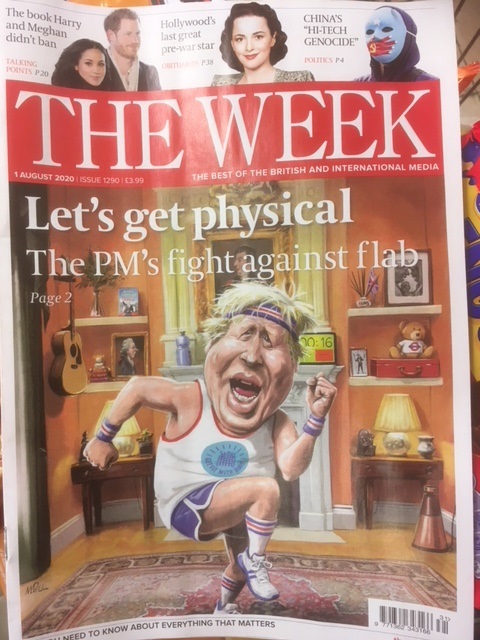

Matt Hancock says new 90-minute coronavirus tests can be used in schools

The Health Secretary said the new tests were a ‘big step forward’ as No10 insisted full reopening of schools would go ahead in September – despite fears of a second wave.
New 90-minute coronavirus tests could be used in schools as No10 confirmed pupils will return in September – despite fears of a second wave.
Two new “on the spot” tests that can detect coronavirus and flu will be rolled out in hospital, care homes and laboratories, with hopes the technology will help the NHS cope in the winter months.
Matt Hancock hailed the development as a “big step forward” and suggested the tests could be used in schools to prevent outbreaks.
And No10 said Boris Johnson had made an “absolute commitment” to getting schools to reopen full time in September after months away from the classroom for many pupils.
But the reopening of schools comes amid fears of a second wave of the virus, with England’s Chief Medical Officer Professor Chris Whitty warning on Friday that the country has “probably reached near the limit or the limits” of what can safely be reopened.
Comment Matt Hancock should drop the Man from his name, maybe replacing it with Small. As for ‘ex spurts’ like Whitty, does he wonder who pays his six figure salary. Is he and his lofty crowd with all their ‘probably’ science going to donate to the rapidly rising unemployed and help out at soup kitchens ? Whitty is witless, like the Government who are cowards and easily led and terrified of Starmer ‘The Harmer.’ Charles Close
Patience Is a Dirty Word
“We do not want our freedom gradually,” John Lewis said, “but we want to be free now!”
July 23, 2020
Director of the Boston University Center for Antiracist Research
On August 27, 1963, John Lewis returned to his room at the Hilton on 16th and K Streets in downtown Washington, D.C. Just 23 years old, but already a veteran activist, Lewis was poised to speak at the March on Washington the next day, as the chair of the irrepressible young revolutionaries of the civil-rights movement, the Student Nonviolent Coordinating Committee.
Someone delivered an advance copy of Lewis’s speech to Patrick O’Boyle, the archbishop of Washington, who was giving the march’s opening invocation. O’Boyle was horrified to see that Lewis intended to call patience a “dirty and nasty word.” O’Boyle called the White House. He called the march organizer Bayard Rustin. O’Boyle threatened to pull out, Rustin told Lewis, because he found the line offensive to the Catholic Church—Catholics believed in the word patience.
Lewis agreed to remove the “patience” line, at Rustin’s urging. But demands for changes kept coming from the white and Black scions of gradual racial change, including U.S. Attorney General Robert Kennedy and NAACP Executive Secretary Roy Wilkins. Lewis agreed to more line edits. But he kept the message.
“To those who have said, ‘Be patient and wait,’ we have long said that we cannot be patient,” Lewis said that day. “We do not want our freedom gradually, but we want to be free now!”
Lewis then exhumed the American Revolution. “I appeal to all of you to get into this great revolution that is sweeping this nation,” he said. “Get in and stay in the streets of every city, every village and hamlet of this nation until true freedom comes, until the revolution of 1776 is complete.”
Lewis did not live to see the revolution of 1776 completed. He died at the age of 80 on Friday. But he did live to see people get into and stay in the streets in nearly every city, every village, every hamlet of this nation this spring and summer. He did live to see perhaps the largest anti-racist mobilization in American history. Lewis did live to see 76 percent of respondents in a Monmouth University poll from June call racial and ethnic discrimination a big problem, up 25 percent from 2015.
Sometimes the most brilliant speeches enter the world when many people are not ready to hear them. On August 28, 1963, many Americans were not ready to hear John Lewis speak about completing the revolution of 1776. Are Americans ready for the message the 23-year-old Lewis offered now?
It is one thing to recognize racism. It is yet another thing to be anti-racist. Are Americans recognizing the colossus and fixing to run away from it out of fear of getting into trouble? Or are Americans readying, like Lewis, to get into trouble, “good trouble”?
Read: The world John Lewis helped create
Will Americans support anti-racist policy solutions that match the scale of the problem? Will Americans get big, think big, act big?
Big like reparations. Big like basic incomes. Big like defunding the police. Big like Medicare for All. Big like automatic voter registration and online voting. Big like need-based school funding. Big like canceling all student debt. Big like the Green New Deal. Big like racial inequity becoming the marker of racist policy.
Or are Americans thinking smaller about this big problem? Are they scared of the upcoming election? Are they more worried about conservative backlash than the everyday lashes of racist policy disproportionately infecting and killing Black and brown people? Are they more fearful of radical social change than the radical changes befalling families when Immigration and Customs Enforcement agents kick down their door?
Will anti-racists again be told to be patient and wait? Because there is always something else to wait for: Wait until after Donald Trump is defeated in November. Wait until Democrats win the Senate in 2022. Wait until Joe Biden’s second term. Wait until her presidency. Wait. Be patient. Change takes time. Change is gradual.
John Lewis planned to open his March on Washington speech declaring SNCC’s opposition to President John F. Kennedy’s civil-rights bill, which was weak on police brutality. He ended up declaring SNCC’s tepid support. And his call for a “serious revolution” was changed to a call for a “social revolution.”
Lewis called for immediate equality, challenging both the calls for gradual equality and the resurgent calls for permanent inequality in 1963. In January, eight months before the March on Washington, Alabama Governor George Wallace had declared, during his inaugural address: “Segregation today, segregation tomorrow, segregation forever.”
Permanent inequality, gradual equality, and immediate equality: This triangle of racial thought formed during slavery. Back then, there were three main policy positions on slavery: permanent enslavement, gradual emancipation, and immediate emancipation. By the 1820s, antislavery Americans were typically advocating for gradual emancipation (and for colonizing emancipated Black people out of the United States). At the American Colonization Society’s Fourth of July gathering in Boston in 1829, William Lloyd Garrison called on all residents of the free states “to demand a gradual abolition of slavery.”
Ten days later, Garrison, a young white newspaper editor, sat in a Black Baptist church and witnessed a celebration of the anniversary of England’s abolition of the slave trade. When a white clergyman preached about abolition being neither wise nor safe without a long period qualifying Black people for freedom, “a very audible murmur ran round the house,” Garrison remembered.
Boston’s Black abolitionists at the time, such as Maria Stewart, were calling for nothing less than freedom, or immediate emancipation. They knew from experience how gradual-emancipation policies prolonged slavery, effectively prolonging the status quo.
After the American Revolution, most northern states passed gradual-emancipation laws that left some Black people enslaved for decades. For example, hundreds of Black Americans were still enslaved in Pennsylvania in 1850, 70 years after the state passed its Act for the Gradual Abolition of Slavery.
While the success of gradualism in reducing injustice often attracts people, the failure of gradualism to eliminate injustice often alienates people. Many white abolitionists, such as Garrison, traveled through the way station of gradual emancipation, which in pro-slavery early America seemed revolutionary.
But Garrison did not stay in the way station for long. He came across the widely circulated pamphlet of the English Quaker Elizabeth Heyrick. “Gradual abolition has been … the very master-piece of Satanic policy,” she wrote in 1824. Garrison also came across the Presbyterian minister George Bourne’s 1816 pamphlet that argued, “Moderation against sin is an absurdity.”
But nothing quickened Garrison’s alienation from gradualism like the murmur of the Black congregants. The murmur rang in his ears as he walked home from the Black church that night in 1829. In his Fourth of July address 10 days earlier, he had termed it a “wild vision” to believe that enslaved Africans could immediately be freed. His mind churned like his feet. Was revolution really wild? Or was it wilder to stand on some middle ground between sinful slavery and righteous freedom?
“I saw there was nothing to stand upon,” Garrison later said. Slavery was a sin. As a sin, it needed to end immediately. “No valid excuse can be given for the continuance of the evil a single hour,” Garrison would write before 1829 ended.
But Americans were not ready for a young Garrison, like Americans were not ready for a young Lewis in 1963, like Americans may not be ready for immediate equality today. Fear restrains some Americans from supporting the transference of police funding to education, public health, affordable housing, and anti-poverty programs. Donald Trump keeps fearmongering about waves of “violent crime in our cities” because “the police are afraid to do anything.” Fear is both the producer and protector of police violence—fear of unpoliced Black people.
John Lewis: Michael Brown, Eric Garner, and the ‘Other America’
In 1861, the editor of the Chicago Times argued that abolishing slavery would send 2 or 3 million “semi-savages” to northern states to become “a pestilence more destructive than ever yet walked the earth.” Even the antislavery editor of the Chicago Tribune admitted that year that “the greatest ally of slaveholders in this country is the apprehension in the Northern mind that if the slaves were liberated, they would become roaming, vicious vagabonds; that they would overrun the North.”
The same racist fears manifested during the defense of Jim Crow. Lawyers argued the Brown v. Board of Education case for a second time on December 8, 1953. At a White House dinner around that time, President Dwight Eisenhower reportedly told Chief Justice Earl Warren that he could understand why white southerners wanted to make sure “their sweet little girls are not required to sit in school alongside some big black buck.”
In the racist imagination, the police officer today serves as the segregationist and slaveholder of yesterday. The fear of immediate change today is the fear of immediate change yesterday.
But the gradualists of today admonish the gradualism of yesterday, condemning all those who opposed immediate emancipation, all those who told Lewis to tone down his speech in 1963. Reformists don’t age as well as revolutionaries. How could anyone say in 1829 that slavery should live another hour? How could anyone not have demanded a “scorched-earth policy” that burned “Jim Crow to the ground—nonviolently,” as Lewis was prevented from saying at the March on Washington?
A century from now, when almost all of us are dead, if we don’t act with urgency and boldness, I can only imagine what our descendants will be saying about us. How could we allow the evil of racial inequity to live another hour? How could we not support a scorched-earth policy to eliminate racial injustice? The revolutionaries of today will age well, as those revolutionaries of yesterday aged well.
Read: How Martin Luther King Jr. recruited John Lewis
To be anti-racist is to believe in the word now. Patience is a dirty word to those incarcerated by inequity. Patience is a nasty word to those with injustice kneeing down on their neck.
“We are tired,” Lewis bellowed at the March on Washington. “We are tired of being beaten by policemen. We are tired of seeing our people locked up in jail over and over again. And then you holler, ‘Be patient.’ How long can we be patient? We want our freedom and we want it now.”
Ibram X. Kendi is a contributing writer at The Atlantic and the Andrew W. Mellon Professor in the Humanities and the director of the Boston University Center for Antiracist Research. He is the author of several books, including the National Book Award–winning Stamped from the Beginning: The Definitive History of Racist Ideas in America and How to Be an Antiracist.
Britain’s Vile Self Interested Elite. August 1st 2020
I try to read at least one book a week. I had good English teachers, with prototype feminist Mrs Horner having some silly idea that I was very intelligent, thus sure to benefit from serious reading.
Well ‘was’ is probably the operative word, so most of what I think and write maybe crap – my state imposed psychiatrist thinks so, which is why he went along with police to label me as having abnormal psychology, so be warned and look out for symptoms. Britain is an island nation , so doesn’t like its boats rocked.
Today I finished Damien Lewis’s ‘SAS Italian Job.’ Among other tasks, it took me all week, read only while in the bath. Oh dear, psycho psychiatrist Ramsay, ‘Do you think I spend too long in the bath, or do I read too fast, like you think I speak too fast – I reference the cretin ( I am being polite here ) Dr Ramsay of the Oxford Mental Health Whiteleaf Centre.
For those familiar with Dickens’ David Copperfield. This is not a matter of ‘King Charles’s Head cropping up in everything his secondary character was writing. Ramsay is my metaphor for the petty useless British bureaucracy. I say useless, but its use is really serious. It is about control. The elite had its objectives during World War Two. It has them now.
Without digressing into the peculiar, alarming and insidious issue of Covid 19 lockdown, let’s go back to Lewis and the SAS. In a nutshell, Major Roy Faran disobeys orders, parachuting into German held territory in Northern Italy.
The mission, toward the close of war in early 1945, is to destroy the ‘Gothic Line’s’ H.Q to make it easier for the Allies to push north into Europe, thus really saving lives, not like this lockdown crap. Captain Lees is the official mission commander. His malaria, from earlier missions, has made life difficult.
Faran lies that he fell from the plane -even though he had full kit and parachute. He makes the decision to ignore a message to abort the mission, Behind the scenes, the nasty elite fear his motley ranks of partisans will be part of a communists takeover after the war. The amazingly heroic mission succeeds, but Lees is shot five times, but makes it back through a complex rescue mission.
To cut a long story short, the British command and control fat cat elite punish Lees for ignoring orders, drag up adverse comments from a list of petty overlings who never likes his ‘get on with the job’ attitude, delay his medical treatment leaving him crippled and in agony for life. They also deny he was ever promised promotion to major and a Military Cross, ignoring Faran’s glowing testimony on both counts. That is Britain, the ruling elite don’t change.
As I discovered, also learning from screepy Simon Chesterman, you don’t get on on in this country by being good at the job. He is the man who ended up writing his underlings reports, making sure only idiots rose up. It is all about crawling, sucking up, saying the right things , bullshit and finding a mentor. Unfortunately, that does not work in a crisis, which is why this government are so craven and useless from a lower order persepctive.




People like me do not like her because she is a privilged whingeing opportunist who was weclomed into the establishment to stir up race and gender war, thus diverting attention from real and horrible everyday issues facing the lower order British masses- poverty, mass unaffordable immigration, squalor, high taxes, crime and so much more,. ‘Bread and Circuses.’ Robert Cook
Mary Trump on her Uncle Donald: ‘I used to feel compassion for him. That became impossible’ July 30th 2020
David Smith in Washington
She is a psychologist who used to deny being related to Donald – now she has written an explosive bestseller about him. She discusses his racism, incompetence, cruelty and why he never laughs
Dinner in the Trump household was a hierarchical affair. Fred Trump, the patriarch, sat at the head of the table, with son Donald on his right and daughter Maryanne on his left. Other family members took their places in descending order of assigned importance.
But one Thanksgiving, the eldest son, Fred Jr, found himself relegated to the junior end of the table with his daughter Mary. “During the course of the meal, my grandmother choked,” Mary Trump recalls. “My dad had been a volunteer ambulance driver in the late 60s and early 70s so he knew the Heimlich manoeuvre and he very gently manoeuvred her into the kitchen and gave her the Heimlich, and that basically saved her from choking.
“Nobody else moved; everybody kept eating. It was a sort of awkward, embarrassing thing that Gam [her nickname] choked. When they came back in, it was literally like my dad had just taken out the garbage: ‘Oh, yeah. Good job, Freddy.’ He couldn’t do anything at that point to garner any respect or get credit for anything, even if it was saving their mother.”
There is no understanding Donald Trump without understanding his “malignantly dysfunctional family”, according to Mary, the first member of the clan to publish a Trump biography and question his fitness for office. Too Much and Never Enough: How My Family Created the World’s Most Dangerous Man sold nearly a million copies on its first day of publication last week, after a failed attempt by the US president’s younger brother Robert to block it in court.
He learned that being humiliated was the worst thing that could happen to a person and he would do everything in his power to avoid that feeling
The book is a portrait of something rotten at the heart of a white suburban family’s rapacious pursuit of the American dream. When I speak to Mary, 55, over the phone from Cape Cod, Massachusetts, she describes how her “sociopath” grandfather made Trump the man he is today, reflects on the burden of carrying the Trump name and warns against the prospect of the president’s children running for political office.
Fred Trump is the villain of the piece. This ruthless New York workaholic slept about four hours a night and was driven by money. Mary writes that he showed little interest in his five children other than grooming an heir for his property business. Spurning his eldest son, Freddy, he settled on Donald, deciding that his second son’s “arrogance and bullying”, and willingness to lie and cheat, were just what the office needed.
“If you met him,” says Mary of her grandfather, “you would think he was cheerful and positive, but also intimidating and not a warm person. But deep down I have no problem describing him as a sociopath. He had no real human feeling and he treated his children variously with contempt.
“Certainly, in the case of my dad, who was the oldest son, heir apparent and namesake, there was harsh discipline and humiliation which Donald, seven and a half years younger, was able to witness and learn very specific lessons from: don’t be like Freddy, don’t be kind, don’t be generous, don’t have ‘frivolous’ interests. The other lesson he learned was that being humiliated was the worst thing that could happen to a person and he would do everything in his power to avoid the feeling of humiliation.”
It does not take much imagination to picture torturous family dinners with giant clashing egos. Racist and antisemitic language was common, Mary has said during media interviews to promote the book, noting the Trumps lived in what was then an all-white suburb in Queens, New York. Can she remember a specific example of Trump using the N-word?
“Honestly, no, because it was just this thing that happened. If my dad had said it outside of the house when we were with him that would have stood out, but he never did. In my grandparents’ house, it was just commonplace and there was nothing, unfortunately, remarkable about it.”
Mary is convinced that her uncle is racist. Would she also use terms such as fascist and white supremacist? “I don’t think he has any political ideology. For him, this is just expedient. I would say he behaves like a white supremacist, certainly. He’s acting on his own racism. He’s doing racist things that are endangering people of colour in this country. That’s much more important, so whether he would describe himself as a white supremacist or not, he’s certainly acting like one.”
In 2016, the Nation magazine ran an article headlined: “Have You Ever Seen Donald Trump Laugh?” It pointed out that almost no one has. What about Mary, a licensed psychologist? “No, and my grandfather didn’t laugh either. When you are able to laugh you’re also letting your guard down and that was frowned upon. My dad had a great sense of humour; he was a very funny guy and did know how to laugh. I think with my grandfather it was also because he was not a fully human being.”
Her book alleges that Trump paid someone to take a university entrance exam on his behalf; the White House has denied this. Freddy briefly went into the family business but loathed it, quitting to become an airline pilot. He died alone in hospital at 42 after a struggle with alcoholism, which runs deep in the family.
Mary holds her grandfather responsible. “The worst thing my grandfather did, starting from very early on, was just not accept my father for who he is. As soon as he realised that my dad wasn’t the ‘right kind of person’ – he wasn’t ‘a killer’, he wasn’t ‘tough’ – he dismissed him out of hand and quickly found a replacement in Donald.”

Donald Trump with his father Fred in Brooklyn, 1975. Photograph: Donald Trump/Facebook
Trump now finds himself in the role of patriarch. He, too, was a distant father who did not, for example, involve himself in changing nappies but encouraged his children to join the family property empire. His sons, Don Jr and Eric, have become two of his most aggressive campaign surrogates, while his elder daughter, Ivanka, is a senior adviser at the White House.
Mary, who is more than a decade older than her cousins and does not know them, says: “It seems pretty clear to me they believe the way to get their father’s attention is through cruelty and subservience, and it’s a quite awful thing to see.”
Both Don Jr and Ivanka have been, half-jokingly, half-deadly seriously, touted as potential future candidates for president. If a shudder can be felt down a phone line, it comes now. “If that were allowed, that would be wrong,” Mary says. “They’re unqualified. Ivanka is the only one technically in the government and she’s unqualified to be an aide, let alone run for political office.
“None of them has ever done anything on their own. They’ve worked in their dad’s business and, from what I can tell, they really haven’t done anything else except continue to take advantage of family money. So I think that would speak to an enduring bankruptcy in the Republican party if that were to come to pass.”
Indeed, perhaps a more interesting question than Trump’s narcissism is what his ascent says about the US. He has shone a harsh light on the nation’s divisions, inequalities, insecurities, negative partisanship, neuroses and prejudices – and how far some are willing to go for a taste of power.
“That is the one thing I didn’t anticipate,” Mary goes on. “One of the reasons I was so devastated by what happened in November 2016 was because, while I knew that he was categorically unfit and incompetent and cruel, I never foresaw that 100% of Republicans in office would just enable him to the extent they have.
“It’s been horrifying because, in that sense, he’s not the problem. If he were being held to the same standards other people in his position have been held to, if they had cared about the transgressions he’s made, the lines he’s crossed, then he would have been neutralised, at least reined in. But they’ve given him permission to keep going and doubling down.”

The Trump siblings (from left): Robert, Elizabeth, Fred Jr, Donald and Maryanne. Photograph: Donald Trump Campaign
She has also witnessed Trump’s lies, exaggerations and salesmanship up close. When she first met his wife, Melania, Trump said to his niece: “You dropped out of college, right?” He then commented: “It was really bad for a while – and then she started doing drugs.”
Mary says she has never taken drugs in her life, but Trump relishes a good comeback story. “It’s just a power play. He knew he was lying. He knew I knew he was lying. But he enjoys that kind of thing.” It is a telling anecdote about Trump’s “don’t let the facts get in the way of a good story” attitude that seeks to make his audience, and the media, complicit.
Mary and her brother engaged in a protracted legal fight over Fred’s estate after his death in 1999 but she otherwise maintained a low profile, despite sharing her last name with a man who spent decades as a star of New York tabloids, reality TV and now the Washington swamp.
“I have always flown under the radar up until recently; I guess that’s not the case any more,” she muses. “When I was really young, it wasn’t an issue because nobody knew who my grandfather was outside of New York.
“It became more of a complicating factor when I was in college and I learned very early on that if somebody asked me – which happened 100% of the time when I paid with a cheque or used a credit card – if I was related, I just said no because it was so much easier. So even people I became friends with didn’t know for a long time. It’s been a burden simply knowing that it’s been my uncle who is doing these awful things but, for me personally, not really.”
Mary voted for Hillary Clinton in the 2016 election and senator Elizabeth Warren in the 2020 Democratic primary but is fully behind presumptive nominee Joe Biden for November. “I will do whatever I can do to help him get elected.” Asked if she would accept an invitation to speak at next month’s Democratic national convention, she says simply: “That would be an honour.”
Biden currently has a significant lead in opinion polls but what if, despite everything, Trump wins re-election? “I have a very difficult time thinking about that but I think the simplest and most clear way to put it is that it would be, in my view, the end of the American experiment. The fact that people were willing to do it four years ago was devastating; that anybody would think that it’s a good idea to continue along the lines we’re going now is unthinkable.”
Mary last spoke to the president at her aunt’s birthday party at the White House in April 2017 and has no interest in doing so again. In 2018, she secretly helped New York Times reporters on an investigation that outlined how Trump and his siblings avoided millions of dollars in taxes.
Does she love her uncle? “No, I don’t,” she says without hesitation. “I used to feel compassion for him. I really did. But then that became impossible when I started learning about things that he had done and seeing what he’s been doing since January 20, 2017.”
Mary’s guidebook to the Trump psychological labyrinth is an argument for the notion that the child is father of the man. If we are all products of our circumstances, does Trump deserve some pity? She is adamant again. “No, he does not. I completely understand having sympathy and empathy for the child who did suffer mightily but it’s no excuse for his behaviour.
“He’s an adult human being who knows the difference between right and wrong, even though he doesn’t think the rules apply to him. He knows what he’s doing and one of the reasons we’re in this position is because he’s never been held accountable for anything. So his transgressions become more egregious over time and he needs to be held to account.”
• Too Much and Never Enough: How My Family Created the World’s Most Dangerous Man by Mary Trump is £17.40 (RRP £20) at guardianbookshop.
How Do Women Become White Supremacists? July 28th 2020

It can never be argued that women just do what comes naturally to them. The dogma is that women are the ultimate expression and embodiement of goodness, innocence, beauthy and honesty.
Psychologists know that female voices command attention better than male ones – hence they are the norm with Sat Nav. The issue of far right women is therefore quite serious. Women are supposed to adhere to the elite approved/enhanced feminist and PC group.
Feminist icon Hilary Clinton described women who did not support her presidential candidacy as ‘The Deplorables’, the reality that most men are poodles to women, and that women know what they are doing, is anathema to the ruling elite and their whores in the world of State pyschiatry and psychology. Their base line is, lose control of the women and you lose control of the men. Hence mainstream articles like this one.
Robert Cook
“People see them as nice white ladies, and they’ve weaponized that,” says Seyward Darby, the author of the upcoming ‘Sisters in Hate’
E.J Dickson
The Ku Klux Klan protests on July 8, 2017 in Charlottesville, Virginia. The KKK is protesting the planned removal of a statue of General Robert E. Lee, and calling for the protection of Southern Confederate monuments.
In the years following Trump’s election, the deadly Charlottesville rally, and shooting massacres such as the those in Christchurch, New Zealand, El Paso, Texas, and Poway, California, many people have tried to address a virtually unanswerable question: What is the process by which a relatively mild-mannered, disaffected young white man becomes a violent white supremacist?
While various factors have been postulated — a racist, patriarchal culture, combined with permissive attitudes toward toxic masculinity and radicalizing platforms like 4chan (and later 8kun) certainly all play a role — the question becomes even more complicated when you talk about white women (more than half of whom famously voted for Trump in November 2016). After all, one of the primary tenets of white nationalism is the biological inferiority of women. Why would a woman embrace such a worldview, let alone one that waxes nostalgic for the days when women were little more than well-coiffed breeding machines?
Writer Seyward Darby doesn’t have a definitive answer to this question, but as she points out, white women have long served as figureheads for far-right movements, from Phyllis Schlafly to National Socialist Women’s League leader Getrud Scholz-Klink. “If you think of it as women negotiating power and seeking power wherever they can find it and harness it and augment it, anti-feminism offers some women that,” Darby says. “Whether you’re talking about leading a movement or having a platform or simply being part of the conversation, I think anti-feminism can feel empowering to some women.”
How Social Distancing Could Lead to a Spike in White Nationalism
Military Rules Cadets’ Hand Gestures Were a Game, Not White-Power Signs
Darby is the author of Sisters in Hate, a fascinating yet highly disturbing deep dive into the toxic world of female white supremacists. Based on her 2017 piece for Harper’s, the book not only tracks the history of women in the far-right, but also follows three women who were or are currently key players in the white-nationalist movement: Corinna Olsen, a bodybuilder and former amateur porn star who became a skinhead and, later, disavowed the movement and converted to Islam; Ayla Stewart, a former vegan feminist who started a tradwife blog and became best known for her “white baby challenge” that urged white women to have as many children as possible; and Lana Lokteff, a racist Holocaust denier who hosts the alt-right channel Red Ice, which was banned from YouTube in 2019.
In the context of this cultural moment — which is calling for the uplifting of marginalized voices and the smashing of white patriarchal values — the idea of a book that profiles three neo-Nazis seems something of an ill-conceived project. But Sisters in Hate doesn’t attempt to humanize these women or grant them any reprieve; it’s an unflinching and often stomach-turning look at their radicalization, as well as the gradual process by which their horrific views became part of the mainstream.
“While at no point I felt like it was important to humanize these people,” Darby tells Rolling Stone, “I did want to see them as multidimensional to understand how they became what they became and the forces they allowed to push them in that direction — and the ways in which that’s not that dissimilar to the mainstream.”
Rolling Stone: What got you interested in writing about female white supremacists in the first place?
Seyward Darby: The origin of it all was really Trump’s election and the immediate aftermath, even before, to a certain extent, the so-called alt-right, the new name for white nationalism, was in the news. People were talking about it and were sort of bewildered by it. And I was struck by how when it was described, it was almost exclusively talked about in terms of the angry white men involved. And that’s all true. It is a bastion of toxic masculinity, and white nationalism always has been, but it struck me as probably inaccurate that women wouldn’t be a part of it. It was just a simple question of, where are the women? On top of that, the exit polls for the election showed that a lot of white women had voted for Trump, and people seemed very upset and surprised by that. I wasn’t under the illusion that every woman who voted for Trump was a white nationalist, but it seemed there was something going on with white women and white femininity that we needed to interrogate.
How did you convince your subjects to talk to you? I understood why Corinna would talk, because she was long out of the movement, but how did you convince Lana and Ayla?
I decided to approach this really forthrightly. I was very honest in my initial emails to them about who I was and what I believed — for instance, that I was not going to be convinced of their worldview. But I also tried to be frank about the fact that I genuinely wanted to understand what got them to that point. I also benefited from the fact that I started this research a month after the election, when a lot of white nationalists were buoyed by Trump taking office. Lana, for instance, told me she thought the alt-right was going to become a political party, and people were moving to D.C. People were approaching the moment in an almost celebratory way. That probably helped somewhat, because they felt they had something to be proud of. As soon as my article came out in Harper’s in 2017, right before Charlottesville, after that, Lana always continued to answer questions if I sent them, sometimes cryptically, but didn’t want to engage in any more conversation. And she criticized the piece in YouTube videos, and Ayla criticized it on her personal site. I think they, for whatever reason, thought the article would be sympathetic to them, and as soon as they realized it wasn’t, they used it as an opportunity to drag it.
How did it affect your reporting for this book that two of your main subjects backed out?
I wouldn’t say they backed out exactly. They participated in the Harper’s piece, and then with the book, when I pitched it, I was pretty clear about the fact that I wasn’t sure if certain people would talk to me again or for the first time. In some ways, as a journalist, I felt I’m not getting everything I could possibly get out of this and it was sort of demoralizing to hear, “Nope, I don’t want to talk to you.” But at the same time, to me it was such a part of the story because white nationalists have always been so much about controlling their own message, controlling their own image. This was a perfect example of that, of not being interested in a narrative they couldn’t control.
On top of that, there’s been a debate in the media over how to cover this space. A lot of people think, “Don’t write about it, don’t give it oxygen, don’t give these people a platform.” I think that really misunderstands what the far right considers a platform. They have so many platforms and so many ways of reaching people on the internet, through various social networks. To not acknowledge that and not acknowledge the many ways they engage in stagecraft and propaganda is to really misunderstand how the movement functions. The other thing I will say is I got very good at digging through internet archives. Both had been digital citizens for a long time — Ayla had many blogs, Lana had various websites. I spent a lot of time combing through the internet, looking for pieces of their past lives, and I was able to speak to people who knew them in the past before they were radicalized. I felt like I was taking a lesson from historians, who dig through letters and archives to gather stories about people who are deceased. It was a similar issue of, how do I fill in the gaps?
You’re a white woman who grew up in the South. How did that play into how you approached reporting this out?
I mentioned it in my initial email to a number of these women, explaining I consider myself liberal, I consider myself a feminist, but also saying I want to understand your worldview and I feel personally connected in some ways to this because of where I come from. My family has been in the South for a long time, I have ancestors who fought for the Confederacy and owned slaves. I wanted to understand the present moment in the context of the past and vice versa. I do remember Lana saying something along the lines of, “You approached me in a different way than most people do, and also you’re from the South.” She was very quick to say “it’s not because you were a woman.”
A lot of the book focuses on the misogyny of the movement and why women would join it and operate against their own interests in doing so. What’s the answer to your question, according to your reporting?
It’s such a complicated subject. I’m still wrapping my mind around the fact that any woman would want to engage in anti-feminism, which is ingrained in white nationalism. That said, over time anti-feminism has often had female figureheads. Phyllis Schlafly most famously, but other people over time. I think if you think of it as women negotiating power and seeking power wherever they can find it and harness it and augment it, anti-feminism offers some women that. Whether you’re talking about leading a movement or having a platform or simply being part of the conversation, I think anti-feminism can feel empowering to some women, even though we know anti-feminism is not beneficial to women.
The other thing to think about is the ways in which anti-feminism has always been tied up with race in this country. If you look at the opposition to the ERA, a lot of white-supremacist groups were aligned with more conservative groups and religious-homemaker groups. When you think of power in the U.S., we don’t think enough in an intersectional way, but some white women saw themselves as in a hierarchy as closer to white men than anybody else. So if you think about it as negotiating power, they wanted to maintain that status, which involved almost a clarion call to white men to say, “We’re not trying to supplant you, we’re trying to keep gender relations as they are,” and that allows them to stay where they are in the power hierarchy. White nationalism as a movement, a big theme, and propaganda is about women’s intrinsic value as wives and mothers. So for women who might be seeking a sense of meaning or a degree of power they don’t have, this is a movement that says we value you in terms of how you look and who you are and what your body enables you to do, at least on its face. It’s a pro-natalist movement that encourages women to have as many babies as possible, and that can be alluring to some people.
What was the most shocking thing you witnessed in your reporting?
That is such a difficult question. Something that keeps coming up, and something that other people in reading it have remarked on, is the fact that immediately after Charlottesville and Heather Heyer’s killing, the far right started to spin conspiracy theories about her death. Some were along the lines of “James Fields is a plant planted by our enemies,” but the more horrifying one to me had to do with the idea that she had actually died because she was overweight and had a heart attack. They somehow managed to graft the conspiracy-theorizing that defines this movement with the anti-feminism, body shaming, eugenicist thread of things that runs through this movement. … To go beyond saying “the person who did this wasn’t one of our guys,” to saying “this is somehow her fault. If she were a healthier woman, or a better white woman, this wouldn’t happen to her,” I found that so deeply upsetting.
Were you able to identify any humanity in your subjects or humanize them in any way given their horrific beliefs?
A key goal of this project for me was to address the fact that when we talk about the hate movement, we’re very quick to “other” it and put this label of extremism on it, that it’s an outlier, almost. But the ideology had so clearly bled into the political conversation of 2016, and I was interested in finding points of familiarity, ways in which people who are in this movement are actually not so different than people in the mainstream, in terms of what they believe and the people they are in the world. There are lots of assumptions about people in this movement: that they’re all uneducated, or from the South, or really religious. There are so many ways we try to put them neatly in a box and push it to the side. So, while at no point I felt like it was important to humanize these people, I did want to see them as multidimensional to understand how they became what they became and the forces they allowed to push them in that direction, and the ways in which that’s not that dissimilar to the mainstream.
What was so disturbing to me is how you describe Ayla’s trajectory. She was a vegan and a feminist who gradually drifted into white nationalism. It reminded me of the phenomenon of cult-hopping, where some people jump from cult to cult. How common is that in white nationalism? How many of these women start out as seekers?
Anyone who joins the hate movement is a seeker to some degree, and maybe there are circumstances that make them particularly primed to be recruited. They’re seeking something in that moment — maybe it’s power, maybe it’s meaning, maybe it’s money because they see a potential profit in running a subscription-based platform. That seems like a common thread among people. What they’re seeking can be really different. Corinna was seeking a sense of belonging. Ayla was seeking a creed. She had cycled through so many different religious and political beliefs, and considered herself a feminist and was a big supporter of Dennis Kucinich and was anti-death penalty and pro-immigration. Lana was primarily interested in seeking power and influence. I think she’s a person who likes the spotlight and likes attention. So that notion of seeking is common … and I think that it’s important to recognize the familiar place from which they might start, because that’s where you also start thinking about how to combat this. If you start thinking about how to prosecute someone for a hate crime or how to shut down a bigoted platform or how to pull someone out of the movement, that’s a treatment for the problem, as opposed to preventing it. If you recognize where people are coming from and the ways in which that might be familiar to the mainstream, you can start thinking about mainstream.
We’re in a cultural moment where there’s a needed emphasis on elevating the voices of BIPOC. What is the argument, then, for writing a book focusing on three female white supremacists?
That’s certainly something I have grappled with, and a common criticism is, “Why are you writing this book at all?” I feel like as a country, we’ve had so much difficulty reckoning with the history of racism, and part of doing that is elevating the voices that have been forgotten or censored or subdued over time, but I think reckoning with racism means fully understanding the dimension it has taken in this country, and the people who have shaped that. If you think about the future only from the present — if you say, “From here on out, we’re gonna do better with X” — you’re not dealing with everything that’s come before, and the ways the past shapes the present. With the hate movement, especially in the post-9/11 era, people have been very wary to address it, to think of it as a national security threat, as something we really need to be dealing with. On top of that, women have been really written out of the history of hate … and they’ve really served as bridges to the mainstream because people see them as nice white ladies, and they’ve weaponized that. For me, this all comes back to the many ways in which the reckoning happens, and I’m so thrilled to see that happening now, but I also think we’re doing a disservice if we don’t look at the ugly side of things and try to understand what it is, as opposed to making assumptions about it that don’t go very far.
We have an election coming up. Do you have any insight in how this will play out in light of the reporting you’ve done?
I wish I had a crystal ball, but unfortunately I’m not that witchy. I think that, as opposed to trying to look at polls or guessing how swing states will go or how white women will vote this time, I’m not one of those people who spend their lives studying it. I think two things: Heading into it, we shouldn’t underestimate the ways white supremacists, nativists, and xenophobic voices can shift the ground pretty quickly. We’re in an unprecedented moment in terms of the pandemic and how badly it’s been handled by federal and state governments. We’ll see what that means going into the election, but in 2016 we saw Clinton leading up until she wasn’t, and we shouldn’t assume the negative forces in the country couldn’t find a way to assert themselves.
There’s also the notion of backlash. The 2008 election is a good model. We had our first ever black president and the streets just erupted with joy. And in the first year Obama was in office, there was a huge uptick online of white-supremacist propaganda and recruitment. I think in some ways, the moments where there are a lot of people who take hope in the future and how far they’ve come, there will always be backlash of some kinds. Backlash feeds on things like elections. … Let’s say Trump loses. We should be thrilled about that, but we shouldn’t assume there won’t be some kind of backlash in terms of some upswell of support for hate. That could still be coming. I’m definitely not fun at dinner parties, because I’m always the pessimist in the room.
That was sort of my takeaway: My husband watches a lot of MSNBC, and there’s a very victory-lap feel to the coverage. But the book makes clear that so many of these ideas have become so mainstream that it would be foolish to discount the role these women may play in keeping Trump in power.
We have these very basic assumptions about white supremacists: You use a certain type of language or believe a certain type of thing. That’s true to a point, but over time they’re canny. When they talk about how their heritage is being destroyed by tearing down Confederate statues, or any number of things that we’re seeing go mainstream in the Republican Party, they all have common roots. On the one hand, no, not everyone who is a white supremacist is necessarily using slurs, because they recognize the power they gain in seeming “normal,” and they benefit from that.
This interview has been condensed and edited.
In This Article: extremism, nazis, sisters in hate, White Supremacist, white supremacy
Want more Rolling Stone? Sign up for our newsletter.
Same old Story, a preface to the following article July 27th 2020
Womens Liberation

In women we have utter animal perfection fighting bravely to annihilate ( hate ) vile white men – black men are their freinds because they are victims of white men too.
This is the same old story about how all women struggle with male abuse. Obviously Ellie Goulding has to get back inside the feminist sheep pen, just as blacks must be part of the BLM. This is an elite orchestrated movement to isolate working class white men, particularly those under 50, with minds messed up by a politically correct education system and female led broken homes.
I have no sense of awe regarding Goulding’s achievements. If you can play one instrument, then you can play them all if you want to. As I have taught all of my music students, there are only 12 notes, just as there are only 26 letters of the alphabet. How you put them together is the main thing. You can be original, get ignored, or turn out the same old garabage with the same old style of lyrics, as we have in Gouldings latest epic.
Goulding is just reverting to type, pretending to be a working class female victim. In fact she has a history of dating posh successful boys, while moralising about the under dogs. Her father was a successful undertaker obsessed with murder, well you have to be a bit ghoulish to be an undertaker.
It is, however a very lucrative business. Her once young Mummy hung out with a rock group, and worked for record companies. So it must have been so hard for pretty little blonde Ellie to get into the business.
Then there were all of those horrible men taking advantage. Ellie wasn’t taking advantage, she was like a true warrior risking her modesty for the benefit of the sisterhood and to keep nasty men where they belong – in one sort of jail or another, unless they are posh and wealthy like her Jasper.
So with a new album coming out, this heroine of the modern feminist stage feels she must be a born again member of the ‘Me Too’ movement. Robert Cook
Ellie Goulding: ‘I feel really stupid for saying I wasn’t affected by the MeToo movement’ July 27th 2020
As she releases her fourth album, Brightest Blue, the singer songwriter talks to Helen Brown about false stories in the press, being ‘taken advantage of’ in her twenties, and how she struggles to tolerate injustices
Ellie Goulding, who has returned with her fourth album, ‘Brightest Blue’ ( Polydor )
Ellie Goulding has eye rolling down to a fine art. So when I ask about the tabloid headlines that have preceded the release of her acclaimed fourth album – Brightest Blue – her pupils loop the loop like they’re on rails.
“I hoped they’d be bored by listing my ex boyfriends by now,” she sighs. “But no. The lists get rehashed. And they said I was ‘making scathing comments’ about them, right?”
Yes, I nod back at her Zoom link. That was the Mirror. The Sun had her “taking aim”. The Daily Mail said she was “taking swipes” and the Daily Star quoted her “cutting digs”. All rehashed the list of celebrities with whom her name has been linked: Ed Sheeran, Niall Horan, Radio 1 DJ Greg James, actor Jeremy Irvine, McFly bassist Dougie Poynter, American music producer Skrillex and – it’s rumoured – even Prince Harry.
I’m uncomfortably aware of the part of me that’s still hungry for the inside track on all those relationships. But I’m equally conscious that Goulding has just made the most accomplished album of her 10-year career: an album that takes a deep dive into intimate electronic soul before surfacing with a series of sparkling pop bangers that express her flirtier “alter ego” as a chart conquering “superwoman”. She reminds me that she’s a “writer first”, and “played almost every instrument on this record”. She has every right “not to be defined by the successful men with whom I’ve been associated and recognised as a successful person in my own right”.
But Goulding is a generous interviewee and, almost as soon as she’s done with the eye rolling, she relents, shrugs and forgives the journalists who continue to “save those awkward questions about my exes for the end of interviews”. Because, she concedes, she also has her nosy side.
“When I discovered Joni Mitchell, Stevie Nicks and Bjork, I have to admit it: I googled who they had dated. I loved them so passionately that I wanted to know everything about them, especially their romantic histories. I wanted to know who they’d written songs about. So I get the impulse. It’s a way of relating, connecting.”
She’s less forgiving of the way she’s been described as slating her exes. “I’m in such a good place now,” she says, “that far from attacking exes, I’m constantly offering the other side of the story, offering resolution. It’s hard to be rational in a pop song and I could spend a lifetime mining the chaotic emotions of my twenties in the studio. But I’m saying: ‘I f***ed up a bit as well.’ I’m saying: ‘It wasn’t just him, it was me too.’ I’m putting myself in a vulnerable place.”
The vulnerability in Goulding’s voice has always been her USP. Both sweet and salty, her distinctive vibrato saw her attract attention from the moment she first began performing at open mic nights in London as a teenager and signed to Polydor records aged just 22. “Although,” she tells me, “after I’d become famous — and particularly after I sang at the Royal Wedding in 2011 – lots of people who knew me at school told the press that there was ‘nothing special’ about me when I was growing up.”
Born in 1986, Goulding is one of four siblings raised in a council house in the small Herefordshire village of Lyonshall. Her childhood was difficult. She doesn’t know why her father, Arthur, a funeral director, left the family when she was five years old. Contact quickly dwindled. In early interviews she described his “obsession with murder”. He once gave her a file of gory murder details he had collected, complete with graphic images. Young Goulding became obsessed with it, delving into a dark side which she says permeates many of her songs. You can hear it snaking through songs like her 2015 hit “Love Me like You Do”, from the soundtrack to Fifty Shades of Grey.
Goulding kept the murder file until her mother found it and burnt it in the back garden. Today Goulding tells me that her relationship with her mother Tracey – an artist and music fan who used to hang out with punk group Siouxsie and the Banshees, and who worked for various record companies as well as in a supermarket – was also troubled. And it still is, although she doesn’t want to go into detail at the moment.
“It’s frustrating,” she says, “because I really want to talk to you about it. I haven’t seen my mother since my wedding [to art dealer Caspar Jopling] last year. I’ve done a lot of therapy about it. I think a lot of women have difficult relationships with their mothers and we find it hard to talk openly about that. I hope one day I’ll be able to get this off my chest. But for now I know it comes bubbling through my subconscious, through my music.”
Although Goulding made her 2010 breakthrough with a gentle folktronica sound, her early musical passion was for rock and grunge. She tells me she was “quite late to the sleeping-with-boys party” and spent “most of my teenage evenings in my bedroom, transforming myself from a crap guitarist to a f***ing maestro in four years. I practised meticulously: Pearl Jam songs, Nirvana songs. I was so curious about men. I fantasised about them, wrote stories about them instead of experiencing anything first-hand.”
After acing her A-levels, Goulding became the first person in her family to attend university (studying drama at Canterbury). But she struggled financially. “My friends all got money from their parents but I had to work – retail and a theatre job. I also needed the money to get to London for open mic nights.”
She knows she “left it too long to speak out about my #MeToo moments. I feel really stupid for saying I wasn’t affected by the #MeToo movement. Those university years were when those problems started for me. I struggled to make the money for trains and that’s when producers started to take advantage, asking me to stay over. A part of me knew it was wrong. But a part of me accepted it. I thought: ‘OK, this is what happens, they help you make a great song and you owe them something’.”
Goulding looks straight at her computer camera as she’s clear in stating: “I normalised too much and I am sad about that. Later, I ended up being too reliant on blokes. I would love to talk to more female musicians about this. I don’t have a good connection with that many female artists and I wish I did. I want to ask: what did I – what do I – have to do to prove myself as a musician?”
You can hear Goulding taking aim at the patriarchy on new songs “Woman” and “Power”. Throughout her career, she tells me, “people have told me my records are a ‘guilty pleasure’. Why? I don’t think I make cheesy or embarrassing music. Is it my soft voice? Can you not admit to liking a feminine voice?” She says has also “often been dismissed as ‘just a blonde’”, even though, like Dolly Parton, she isn’t. “I occasionally think if I returned to my natural dark brown I might be taken more seriously. Then I think: why should I change? I like the blonde. It feels like part of my identity.”
Peroxide and Pantene ads aside, she hasn’t always enjoyed “all the make-up and the costumes”. She felt she was being turned into a “pop robot” while making and touring her last album, Delirium, which she thinks was a great pop album, just not one that was true to who she really is.
Goulding’s identity crisis was compounded by false stories circulating in the press. “There were two situations in which I felt I was made out to be the bad person and that was absolutely not the case,” she tells me. “But I’m convinced that if I spoke out against people who were very much in the spotlight then I would have been the one in trouble. I hate that I had to stay quiet and couldn’t stand up for myself. I hate the fact that it was out of my control. But I was petrified of putting a job I’d tried so hard to get in jeopardy. I was doing well in America. I was scared of being ‘cancelled’ as the kids say these days. I felt really angry about how easily I could have been removed from the culture because my value was deemed to be less than that of the men involved. I’ve written an essay about it, that’s how much it pissed me off. The truth is really important to me. My friends know I struggle to tolerate even the tiniest injustices, let alone the f***ing big ones. I can’t settle until they’re solved. On the other hand, I don’t have any desire to put anyone down or bring issues back up.”
I wonder if she is talking about the rumour that she cheated on Ed Sheeran with Niall Horan, a story many believe is told in the lyrics of Sheeran’s hit “Don’t”. But Goulding waves this off with a brisk, “No! I’m not referring to that. That was crazy. If people even knew what that whole story really was… well! I’m friends with Ed, I’m friends with his wife. We love to talk about music.”
Today, she enjoys talking about the influences on Brightest Blue. “I was listening to a lot of Kanye West, Frank Ocean, The Weeknd, Drake.” You can hear them all swirling through the first half of the record, like spirits swilling at the bottom of a cut-glass tumbler. They’re mixed with her “melancholy” classical influences: “I’ve really missed live classical music in lockdown,” she tells me. “There’s nothing like the feeling you get when you’re in a room with a whole orchestra. Instead, I’ve been listening to recordings by Einaudi, Max Richter, Jean-Michel Blais and the Norwegian composer Ola Gjeilo, who performed while I walked down the aisle at my wedding.”
Goulding says she doesn’t want to write much about her husband yet. It all feels too precious. And perhaps a little too steady and “rational” to transform into pop material. But you can hear him in Brightest Blue’s title track. “It’s looking so much brighter now,” sings Goulding. “I was lost and now I’m found.” The lovely thing about this is, it’s not just Joplin who found her. She’s found herself. As our Zoom ends, I look at the record art and notice it’s the first sleeve on which Goulding’s eyes are open. Looking straight ahead. Beyond rolling.
Black Women, Grillz, and the Reclamation of Power
The mouthpiece is more than just an accessory.

By Tanisha C. Ford Jun 15, 2020
Singers from Beyoncé to Lizzo have mastered it—the “mean mug.” You bring the edges of your top and bottom teeth together and lift your lips away from your gums. You must fully commit to the pose (bonus points for a mean squint). It’s the only way to show off a bejeweled mouthpiece: “grillz,” “mouth bling,” “golds,” “fronts,” “bouche bijoux.” Whatever you call them, they’re symbols of bold, unapologetic style, not to mention boss stature. Black women in music, since the blues age of Koko Taylor, have been wearing gold teeth to flaunt their wealth and chart their ascendance to the pinnacle of fame, earning queen—or even king—status. And now, in the age of social media, grillz are both a reclamation of power and a fashion statement.
In the pre-Instagram era, male rappers like Slick Rick, Big Daddy Kane, Pimp C, and Lil Wayne helped mythologize grillz as the accessory of choice for stylish drug kingpins and ladies’ men. In this narrative, women were simply the sexy consorts of the men with money. But grillz represented something different for black women. Growing up in Mount Vernon, New York, in the early ’80s, stylist Misa Hylton remembers the Fly Girls, who accessorized their Lee and Jordache jeans with Pumas and Adidas—and lots of gold: grillz, nameplate necklaces and pinkie rings, bamboo earrings, Nefertiti medallions, and wrists full of bangles. The jewelry “made us feel like queens and goddesses,” Hylton recalls. Today Beyoncé and her generation of women artists are blending the boss narrative—once only the province of men—with the carefree “around the way girl” energy Hylton remembers from her youth.
Beyoncé chose to partner with French grillz designer-to-the-stars Dolly Cohen—who has made pieces for Balmain, Balenciaga, Givenchy, and Hood By Air—to create a gold grill for her 2020 Ivy Park x Adidas campaign. An image of Bey mugging in her Ivy Park gem, posted to her Instagram account in late 2019, went viral. The flashy mouthpiece roots Beyoncé in Houston’s black culture while also representing the power moves she’s made since establishing her Parkwood Entertainment company a decade ago, announcing herself as a mogul and global tastemaker. Rihanna’s AK-47 grill and her BDSM-inspired lip ring grill—both designed by Cohen—showed that grillz can be sexy, too. British singer Jorja Smith wore a dainty open-face piece on the cover of ELLE UK. Nicki Minaj, Remy Ma, Cardi B, Megan Thee Stallion, Young M.A, and Rico Nasty have all flexed on social media in bedazzled grillz. And perhaps no one is better at stretching the imaginative possibilities of the style than R&B legend Erykah Badu. The singer, who got her first grill in 1999, frequently collaborates with jewelry designer Lillian Shalom to create whimsical pieces, including a tribute to Egyptian goddess Ma’at and a full set of open-face grillz made from raw Australian opals.

Jazzelle Zanaughtti David Livingston
Hylton isn’t at all surprised to see grillz go high fashion. “You usually see street style and things that come from African American culture and hip-hop culture translate into mainstream fashion,” she says. The hood fashionistas of her day didn’t see their looks in popular fashion magazines, but “the streets were a runway,” she says. When Hylton became one of the first hip-hop stylists in the mid-’90s, she brought her dripped-in-gold Fly Girl vibe to an industry that understood very little about black fashion culture. Hylton, who was dating rapper and mogul Sean “Diddy” Combs at the time, dressed his Bad Boy artists—from Biggie to Faith Evans. She interpreted the culture of the streets as a luxe lifestyle that made music-video viewers want to cop the CD—and the clothes. A jersey was no longer just a jersey, a grill no longer just a grill. It was iconography that gave texture to what was becoming known as “streetwear” or “gangsta wear.”

A custom grill design by Pinstripe. Courtesy of Pinstripe
Now Hylton looks back with pride at the style she helped create in the ’90s and the ways it’s being remixed today by women asserting their power and prowess. “Grillz are here to stay,” she says. And not because they’ve made it to the runways, but because of the people who keep the spirit of hip-hop culture alive. “I still go to the hood to get mine,” Hylton says, referring to the grillz she sports on Instagram. “I love what Dolly [Cohen] does as well. I think she’s amazing.” But Hylton prefers going to her beloved spot on Harlem’s 125th Street to “keep that authenticity,” she says. “There’s nothing like getting them done in the hood.”
This article originally appeared in the Summer 2020 issue of ELLE.
GET THE LATEST ISSUE OF ELLE Tanisha C. Ford Tanisha C. This content is created and maintained by a third party, and imported onto this page to help users provide their email addresses. You may be able to find more information about this and similar content at piano.io
Watch Next
Lady Gaga’s Dating HistoryCurrent Time 0:04/Duration 2:11
Mick Fleetwood: ‘Losing Peter Green Is Monumental’
“I thank you for asking me to be your drummer all those years ago,” Fleetwood Mac co-founder says. “We did good, and trailblazed one hell of a musical road for so many to enjoy”
By Jason Newman

Fleetwood Mac co-founder Mick Fleetwood lamented the death of his former bandmate Peter Green, who died Saturday at the age of 73.
“For me, and every past and present member of Fleetwood Mac, losing Peter Green is monumental!” Fleetwood wrote in a statement to Rolling Stone. “Peter was the man who started the band Fleetwood Mac along with myself, John McVie, and Jeremy Spencer. No one has ever stepped into the ranks of Fleetwood Mac without a reverence for Peter Green and his talent, and to the fact that music should shine bright and always be delivered with uncompromising passion!!!”
Green was one of eight Fleetwood Mac members inducted into the Rock and Roll Hall of Fame in 1998; the blues guitarist also placed number 58 on Rolling Stone’s 100 Greatest Guitarists list. In 1967, two years after replacing Eric Clapton in John Mayall’s Bluesbreakers, Green and fellow Bluesbreaker Fleetwood formed their own band, later to be known simply as Fleetwood Mac; the pair would later recruit another veteran of the Bluesbreakers, bassist John McVie alongside guitarist Spencer. With Green at the helm, this early blues rock incarnation of Fleetwood Mac released three albums, beginning with their 1968 self-titled debut.
How Western Civilization Could Collapse
Some possible precipitating factors are already in place. How the West reacts to them will determine the world’s future, says Rachel Nuwer.

- Rachel Nuwer
A severe drought in Syria left many people – especially young men – unemployed, discontent and desperate, which may have been a factor that led to civil war. Credit: Getty Images.
The political economist Benjamin Friedman once compared modern Western society to a stable bicycle whose wheels are kept spinning by economic growth. Should that forward-propelling motion slow or cease, the pillars that define our society – democracy, individual liberties, social tolerance and more – would begin to teeter. Our world would become an increasingly ugly place, one defined by a scramble over limited resources and a rejection of anyone outside of our immediate group. Should we find no way to get the wheels back in motion, we’d eventually face total societal collapse.

Such collapses have occurred many times in human history, and no civilisation, no matter how seemingly great, is immune to the vulnerabilities that may lead a society to its end. Regardless of how well things are going in the present moment, the situation can always change. Putting aside species-ending events like an asteroid strike, nuclear winter or deadly pandemic, history tells us that it’s usually a plethora of factors that contribute to collapse. What are they, and which, if any, have already begun to surface? It should come as no surprise that humanity is currently on an unsustainable and uncertain path – but just how close are we to reaching the point of no return?
A South African police van is set on fire following protests about inequality in 2016. Credit: Getty Images.
While it’s impossible to predict the future with certainty, mathematics, science and history can provide hints about the prospects of Western societies for long-term continuation.
Safa Motesharrei, a systems scientist at the University of Maryland, uses computer models to gain a deeper understanding of the mechanisms that can lead to local or global sustainability or collapse. According to findings that Motesharrei and his colleagues published in 2014, there are two factors that matter: ecological strain and economic stratification. The ecological category is the more widely understood and recognised path to potential doom, especially in terms of depletion of natural resources such as groundwater, soil, fisheries and forests – all of which could be worsened by climate change.
Disaster comes when elites push society toward instability and eventual collapse by hoarding huge quantities of wealth and resources.
That economic stratification may lead to collapse on its own, on the other hand, came as more of a surprise to Motesharrei and his colleagues. Under this scenario, elites push society toward instability and eventual collapse by hoarding huge quantities of wealth and resources, and leaving little or none for commoners who vastly outnumber them yet support them with labour. Eventually, the working population crashes because the portion of wealth allocated to them is not enough, followed by collapse of the elites due to the absence of labour. The inequalities we see today both within and between countries already point to such disparities. For example, the top 10% of global income earners are responsible for almost as much total greenhouse gas emissions as the bottom 90% combined. Similarly, about half the world’s population lives on less than $3 per day.
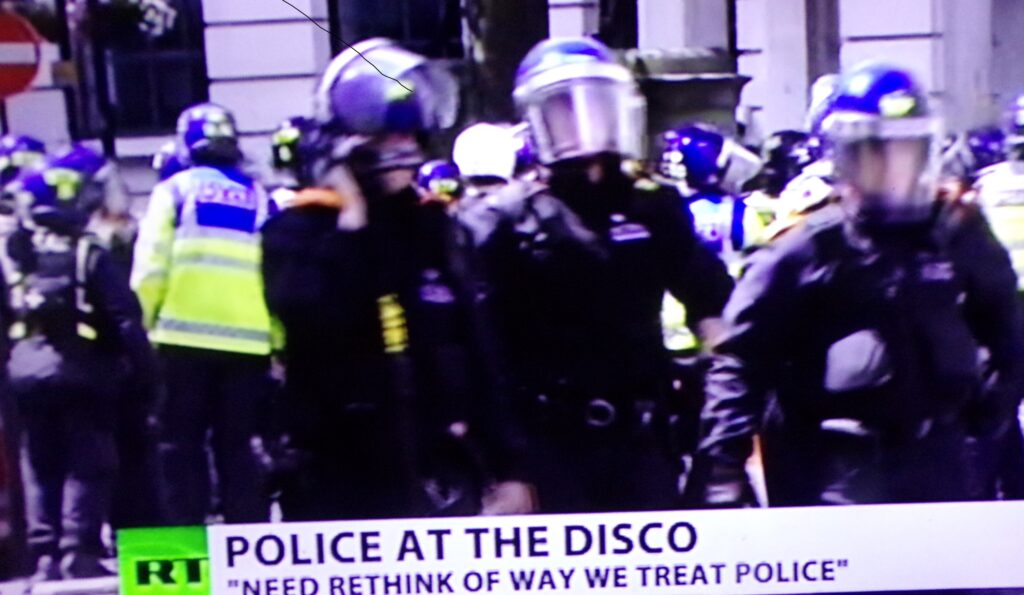
For both scenarios, the models define a carrying capacity – a total population level that a given environment’s resources can sustain over the long term. If the carrying capacity is overshot by too much, collapse becomes inevitable. That fate is avoidable, however. “If we make rational choices to reduce factors such as inequality, explosive population growth, the rate at which we deplete natural resources and the rate of pollution – all perfectly doable things – then we can avoid collapse and stabilise onto a sustainable trajectory,” Motesharrei said. “But we cannot wait forever to make those decisions.”
One of the most important lessons from Rome’s fall is that complexity has a cost. Credit: Getty Images.
Unfortunately, some experts believe such tough decisions exceed our political and psychological capabilities. “The world will not rise to the occasion of solving the climate problem during this century, simply because it is more expensive in the short term to solve the problem than it is to just keep acting as usual,” says Jorgen Randers, a professor emeritus of climate strategy at the BI Norwegian Business School, and author of 2052: A Global Forecast for the Next Forty Years. “The climate problem will get worse and worse and worse because we won’t be able to live up to what we’ve promised to do in the Paris Agreement and elsewhere.”
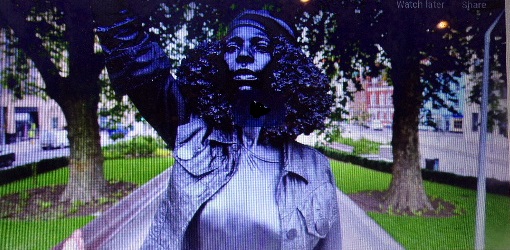
While we are all in this together, the world’s poorest will feel the effects of collapse first. Indeed, some nations are already serving as canaries in the coal mine for the issues that may eventually pull apart more affluent ones. Syria, for example, enjoyed exceptionally high fertility rates for a time, which fueled rapid population growth. A severe drought in the late 2000s, likely made worse by human-induced climate change, combined with groundwater shortages to cripple agricultural production. That crisis left large numbers of people – especially young men – unemployed, discontent and desperate. Many flooded into urban centres, overwhelming limited resources and services there. Pre-existing ethnic tensions increased, creating fertile grounds for violence and conflict. On top of that, poor governance – including neoliberal policies that eliminated water subsidies in the middle of the drought – tipped the country into civil war in 2011 and sent it careening toward collapse.

Another sign that we’re entering into a danger zone is the increasing occurrence of ‘nonlinearities’, or sudden, unexpected changes in the world’s order.
In Syria’s case – as with so many other societal collapses throughout history – it was not one but a plethora of factors that contributed, says Thomas Homer-Dixon, chair of global systems at the Balsillie School of International Affairs in Waterloo, Canada, and author of The Upside of Down. Homer-Dixon calls these combined forces tectonic stresses for the way in which they quietly build up and then abruptly erupt, overloading any stabilising mechanisms that otherwise keep a society in check.
The Syrian case aside, another sign that we’re entering into a danger zone, Homer-Dixon says, is the increasing occurrence of what experts call nonlinearities, or sudden, unexpected changes in the world’s order, such as the 2008 economic crisis, the rise of ISIS, Brexit, or Donald Trump’s election.
Some civilisations simply fade out of existence – becoming the stuff of history not with a bang but a whimper. Credit: iStock.
The past can also provide hints for how the future might play out. Take, for example, the rise and fall of the Roman Empire. By the end of the 100BC the Romans had spread across the Mediterranean, to the places most easily accessed by sea. They should have stopped there, but things were going well and they felt empowered to expand to new frontiers by land. While transportation by sea was economical, however, transportation across land was slow and expensive. All the while, they were overextending themselves and running up costs. The Empire managed to remain stable in the ensuing centuries, but repercussions for spreading themselves too thin caught up with them in the 3rd Century, which was plagued by civil war and invasions. The Empire tried to maintain its core lands, even as the army ate up its budget and inflation climbed ever higher as the government debased its silver currency to try to cover its mounting expenses. While some scholars cite the beginning of collapse as the year 410, when the invading Visigoths sacked the capital, that dramatic event was made possible by a downward spiral spanning more than a century.
Eventually, Rome could no longer afford to prop up its heightened complexities.
According to Joseph Tainter, a professor of environment and society at Utah State University and author of The Collapse of Complex Societies, one of the most important lessons from Rome’s fall is that complexity has a cost. As stated in the laws of thermodynamics, it takes energy to maintain any system in a complex, ordered state – and human society is no exception. By the 3rd Century, Rome was increasingly adding new things – an army double the size, a cavalry, subdivided provinces that each needed their own bureaucracies, courts and defences – just to maintain its status quo and keep from sliding backwards. Eventually, it could no longer afford to prop up those heightened complexities. It was fiscal weakness, not war, that did the Empire in.
So far, modern Western societies have largely been able to postpone similar precipitators of collapse through fossil fuels and industrial technologies – think hydraulic fracturing coming along in 2008, just in time to offset soaring oil prices. Tainter suspects this will not always be the case, however. “Imagine the costs if we have to build a seawall around Manhattan, just to protect against storms and rising tides,” he says. Eventually, investment in complexity as a problem-solving strategy reaches a point of diminishing returns, leading to fiscal weakness and vulnerability to collapse. That is, he says “unless we find a way to pay for the complexity, as our ancestors did when they increasingly ran societies on fossil fuels.”
A protest group in Argentina demonstrates against United States interference in the crises in Syria and Venezuela. Credit: Getty Images.
Also paralleling Rome, Homer-Dixon predicts that Western societies’ collapse will be preceded by a retraction of people and resources back to their core homelands. As poorer nations continue to disintegrate amid conflicts and natural disasters, enormous waves of migrants will stream out of failing regions, seeking refuge in more stable states. Western societies will respond with restrictions and even bans on immigration; multi-billion dollar walls and border-patrolling drones and troops; heightened security on who and what gets in; and more authoritarian, populist styles of governing. “It’s almost an immunological attempt by countries to sustain a periphery and push pressure back,” Homer-Dixon says.
Meanwhile, a widening gap between rich and poor within those already vulnerable Western nations will push society toward further instability from the inside. “By 2050, the US and UK will have evolved into two-class societies where a small elite lives a good life and there is declining well-being for the majority,” Randers says. “What will collapse is equity.”

Image Appldene Photographics/RJC
Whether in the US, UK or elsewhere, the more dissatisfied and afraid people become, Homer-Dixon says, the more of a tendency they have to cling to their in-group identity – whether religious, racial or national. Denial, including of the emerging prospect of societal collapse itself, will be widespread, as will rejection of evidence-based fact. If people admit that problems exist at all, they will assign blame for those problems to everyone outside of their in-group, building up resentment. “You’re setting up the psychological and social prerequisites for mass violence,” Homer-Dixon says. When localised violence finally does break out, or another country or group decides to invade, collapse will be difficult to avoid.
Europe, with its close proximity to Africa, its land bridge to the Middle East and its neighbourly status with more politically volatile nations to the East, will feel these pressures first. The US will likely hold out longer, surrounded as it is by ocean buffers.
As time passes, some empires simply become increasingly inconsequential.
On the other hand, Western societies may not meet with a violent, dramatic end. In some cases, civilisations simply fade out of existence – becoming the stuff of history not with a bang but a whimper. The British Empire has been on this path since 1918, Randers says, and other Western nations might go this route as well. As time passes, they will become increasingly inconsequential and, in response to the problems driving their slow fade-out, will also starkly depart from the values they hold dear today. “Western nations are not going to collapse, but the smooth operation and friendly nature of Western society will disappear, because inequity is going to explode,” Randers argues. “Democratic, liberal society will fail, while stronger governments like China will be the winners.”
Some of these forecasts and early warning signs should sound familiar, precisely because they are already underway. While Homer-Dixon is not surprised at the world’s recent turn of events – he predicted some of them in his 2006 book – he didn’t expect these developments to occur before the mid-2020s.
Western civilisation is not a lost cause, however. Using reason and science to guide decisions, paired with extraordinary leadership and exceptional goodwill, human society can progress to higher and higher levels of well-being and development, Homer-Dixon says. Even as we weather the coming stresses of climate change, population growth and dropping energy returns, we can maintain our societies and better them. But that requires resisting the very natural urge, when confronted with such overwhelming pressures, to become less cooperative, less generous and less open to reason. “The question is, how can we manage to preserve some kind of humane world as we make our way through these changes?” Homer-Dixon says.

Social tensions have never been higher Standards for the Wetsern masses are downward as society collpases – while elites get richer, hands on the controls, handing out justice ( sic) especially police and media.
White right wing protesters are scapegoats as conflict is managed by a heavy handed and concentrated monitoring of this group by police and MI5, with particular attention to its leaders, like Tommy Robinson…
I’m a 26 year-old guy who’s taken Viagra on dates – here’s why”
It’s not just for older men…
By Tom Hill

Women have lapped up the changes, rejecting stereotypical images that used to trigger male fantasies and desire. Now women are angry. Feminists are, like the U.S.A, in ongoing war. Enough will never be enough.
One is not supposed to connect record numbers of young boys lining up for sex change. facing feminist fscist fury as they mature because the female fantasy likes to think they are so desireable that all men want to invade their ‘safe spaces’ ( another equality joke ) and rape them, even if they have no penis or testicles.
Men wil always want women, if for nothing more than a replacement for ‘mummy’. Women are programmed to look for ‘good sex’. We are living in a connundrum that favours women, who undoubtedy lie about sex assaults to feed their egos and for revenge.
They lie for women, they leave men for better options, so the pathetic little fellows rush off for viagra. It is going to be a very sad future of the human race, an animal life form so vain that it beleives God made it in the God’s image.
I have broken up with three more women since my divorce – my choice – and prefer a gin and tonic to what these modern day ‘never satisfied nagging self righteous’harrIdans have to offer. Robert Cook
Dec 12, 2017
Getting ready for a night out with my friends, I couldn’t help but feel nervous. I’d just got a message from Amy, a primary school teacher I’d fancied for years. She was a friend of a friend and I felt there was chemistry between us. The weekend before we’d bumped into each other at a club and – feeling confident after a few scotch and sodas – I finally kissed her. Now a week had passed and Amy had just texted “You out tonight? Maybe you can carry me home this time… x”
Part of me was excited – I’d been fantasising about sleeping with her for years. But I was also hit by a huge pang of anxiety. Amy and I had lots of mutual friends, mostly girls, and on many occasions I’d heard them gossiping about one night stands or their boyfriends’ bedroom technique. While women think men discuss their sex lives, the truth is many of us don’t, at least not in any intimate level of detail. I’d built up having sex with Amy to such a degree that the fear of being a disappointment to her swamped me.
That’s when I thought about taking Viagra for the first time. My friend James had bought a supply off the internet to use with a girl he’d been pursuing for months. Some of you reading this might be shocked to learn that men – and yes, I’m talking young guys – do this (and admit it to their mates). But sometimes, the pressure of being a proficient lover with stamina, technique and the ability to not fall asleep until we’ve made you orgasm at least twice can affect our, ahem, ability to stand to attention.
So, that night I asked James if I could ‘borrow’ a pack for later that evening. “Well that’s one way to liven up the night,” he joked as he gave me a handful.
Later on I met Amy and, after a lot of kissing, it was obvious things were going to progress to the next level. So I went to the toilet and took a pill. I was nervous about what to expect – I didn’t want to leave it too late in case it didn’t work in time but would I get an erection that I couldn’t control while out in public? The answer is yes, but with some handy boxer-short waistband tricks developed as a teenager, no one noticed.
I lasted much longer than normal because it felt harder to come
Back at mine things progressed quickly, and Amy and I were soon having sex. It felt amazing and I lasted much longer than normal because it felt harder to come. When I did, I still had an erection, which didn’t go down, even after my third orgasm. Part of me felt like a stud but it was also frustrating that I couldn’t just relax. Amy seemed shocked that I could last so long, but the next day she texted saying how great it was and asked when we’d next see each other.
Despite it being chemically assisted, Viagra gave me an ego boost, and after that I didn’t feel the same kind of pressure to take another pill with her. Sadly we didn’t have much in common as people and, after a few weeks, our relationship fizzled out.
Then a month later I met Rachel. She was beautiful, funny and sexy. And the best thing was that, despite clearly being out of my league, she seemed to like me too.
Throughout the next week our texts got steamier and we organised a date. I was desperate to impress, so I bought a new shirt and booked a table at a great restaurant. But with all the build-up, I started to feel nervous about the possibility of sex again. I didn’t want to disappoint Rachel. So before I left the house, I slipped a pill into my pocket, just in case. Naturally I used it and, once again, the sex lasted all night. It felt great to be able to pleasure her so much.
It made my heart race and I felt a little dizzy
Now I had a new problem. I really, really liked Rachel and worried she’d be expecting this sort of performance every time. I didn’t want to go from Mr Amazing to Mr Limp. So for the next six weeks, whenever we headed home together, I’d knock back my little blue friend. It made my heart race and I felt a little dizzy but I pushed the thoughts of any side effects to the back of my mind and ordered another packet over the Internet. I was really careful to hide them from Rachel, keeping them in a zipped section of my wallet and stuffed in my sock drawer back home. It wasn’t just the embarrassment factor but I was worried she’d think I didn’t find her attractive.
The pressure of having to sneak a pill every time we wanted sex was stressful. I talked to James about my predicament. “Don’t worry mate, you’re keeping her happy so just keep taking them,” he suggested. Helpful.
Within a few weeks I was more comfortable with Rachel and decided to go cold turkey from Viagra. The first time was so stressful – would she notice? Would I be able to keep my manhood in ‘peak’ performance? I didn’t say anything but that first night I wasn’t constantly erect. Luckily, I think Rachel just put it down to me not being so fired up now we’d been together a while. The relief was amazing and I was so relaxed afterwards that, for me, the sex somehow felt more meaningful.
Thankfully, three years on we’re still happily together, but I’d hate her to find out what I’d done. I hope she’d understand but I know that it would dent her confidence, even if she didn’t admit it.
Men taking Viagra to boost their performance is more common than many women think, especially at the start of a relationship. But if you catch a guy doing it, take it as a compliment. In a strange way it just shows that he cares what you think.
BBC Debunks Conspiracy Theories. If you believe this icon of the British Imperialist Establishment on this one, you will believe anything. George Orwell worked for them, inspiring his book ‘1984’. The BBC were and still are ‘The Ministry of Information.’ Robert Cook July 19th 2020.
BBC anti conspiracy theory Posted July 19th 2020

Image Appledene Photographics
This website is produced by BBC Global News, a commercial company owned by the BBC (and just the BBC). No money from the licence fee was used to create this website. The money we make from it is re-invested to help fund the BBC’s international journalism.
Best of BBC Future | Anthropology
The accidental invention of the Illuminati conspiracy
Share using EmailShare on TwitterShare on FacebookShare on Linkedin
By Sophia Smith Galer 11th July 2020
The story of how the myth exploded reveals how fake stories spread today and the secrets behind the psychology of their fiercest proponents.
BBC Future has brought you in-depth and rigorous stories to help you navigate the current pandemic, but we know that’s not all you want to read. So now we’re dedicating a series to help you escape. We’ll be revisiting our most popular features from the last three years in our Lockdown Longreads.
You’ll find everything from the story about the world’s greatest space mission to the truth about whether our cats really love us, the epic hunt to bring illegal fishermen to justice and the small team which brings long-buried World War Two tanks back to life. What you won’t find is any reference to, well, you-know-what. Enjoy.
It’s the conspiracy theory to dwarf all conspiracy theories. A smorgasbord of every other intrigue under the sun, the Illuminati are the supposed overlords controlling the world’s affairs, operating secretly as they seek to establish a New World Order.
But this far-fetched paranoia all started with a playful work of fiction in the 1960s. What does this tell us about our readiness to believe what we read and hear – and what can the Illuminati myth reveal about the fake news and stories we continue to be influenced by today?
If you like this story, you might also like:
- The strange photographs used to ‘prove’ conspiracy theories
- How to avoid falling for lies and fake news
- Why are people so incredibly gullible?
When most people try to look into the secret society’s history, they find themselves in Germany with the Enlightenment-era Order of the Illuminati. It was a Bavarian secret society, founded in 1776, for intellectuals to privately group together and oppose the religious and elitist influence over daily life. It included several well-known progressives at the time but, along with the Freemasons, they found themselves gradually outlawed by conservative and Christian critics and the group faded out of existence.
Films like Angels and Demons have brought the concept of the Illuminati into popular consciousness (Credit: Alamy)
That is, until the 1960s. The Illuminati that we’ve come to hear about today is hardly influenced by the Bavarians at all, as I learned from author and broadcaster David Bramwell, a man who has dedicated himself to documenting the origins of the myth. Instead, an era of counter-culture mania, LSD and interest in Eastern philosophy is largely responsible for the group’s (totally unsubstantiated) modern incarnation. It all began somewhere amid the Summer of Love and the hippie phenomenon, when a small, printed text emerged: Principia Discordia.
The book was, in a nutshell, a parody text for a parody faith – Discordianism – conjured up by enthusiastic anarchists and thinkers to bid its readers to worship Eris, goddess of chaos. The Discordian movement was ultimately a collective that wished to cause civil disobedience, practical jokes and hoaxes.
The text itself never amounted to anything more than a counter-culture curiosity, but one of the tenets of the faith – that such miscreant activities could bring about social change and force individuals to question the parameters of reality – was immortalised by one writer, Robert Anton Wilson.
It’s an idealistic means of getting people to wake up to the suggested realities that they inhabit – David Bramwell, author
According to Bramwell, Wilson and one of the authors of the Principia Discordia, Kerry Thornley, “decided that the world was becoming too authoritarian, too tight, too closed, too controlled”. They wanted to bring chaos back into society to shake things up, and “the way to do that was to spread disinformation. To disseminate misinformation through all portals – through counter culture, through the mainstream media, through whatever means. And they decided they would do that initially by telling stories about the Illuminati.”
At the time, Wilson worked for the men’s magazine Playboy. He and Thornley started sending in fake letters from readers talking about this secret, elite organisation called the Illuminati. Then they would send in more letters – to contradict the letters they had just written.
Jay Z is one famous hip hop star to raise their hands into the alleged Illuminati triangle symbol at concerts (Credit: Alamy)
“So, the concept behind this was that if you give enough contrary points of view on a story, in theory – idealistically – the population at large start looking at these things and think, ‘hang on a minute’,” says Bramwell. “They ask themselves, ‘Can I trust how the information is presented to me?’ It’s an idealistic means of getting people to wake up to the suggested realities that they inhabit – which of course didn’t happen quite in the way they were hoping.”
The chaos of the Illuminati myth did indeed travel far and wide – Wilson and another Playboy writer wrote The Illuminatus! Trilogy which attributed the ‘cover-ups’ of our times – such as who shot John F Kennedy – to the Illuminati. The books became such a surprise cult success that they were made into a stage play in Liverpool, launching the careers of British actors Bill Nighy and Jim Broadbent.
Today, it’s one of the world’s most widely punted conspiracy theories
British electronic band The KLF also called themselves The Justified Ancients of Mu Mu, named after the band of Discordians that infiltrate the Illuminati in Wilson’s trilogy as they were inspired by the religion’s anarchic ideology. Then, an Illuminati role-playing card game appeared in 1975 which imprinted its mystical world of secret societies onto a whole generation.
Today, it’s one of the world’s most widely punted conspiracy theories; even celebrities like Jay-Z and Beyoncé have taken on the symbolism of the group themselves, raising their hands into the Illuminati triangle at concerts. It’s hardly instigated the mind-blowing epiphany – the realisation that it’s all fake – which the proponents of Discordianism had originally intended.
The 60s culture of mini-publishers and zines seems terrifically distant now from today’s globalised, hyper-connected internet, and it has undeniably been the internet’s propensity to share and propagate Illuminati rumours on websites like 4chan and Reddit that has brought the idea the fame it has today.
But we live in a world that is full of conspiracy theories and, more importantly, conspiracy theory believers; in 2015, political scientists discovered that about half of the general public in the USA endorse at least one conspiracy theory. These include anything from the Illuminati to the Obama ‘birther’ conspiracy, or the widely held belief that 9/11 was an inside job carried out by US intelligence services.
Conspiracy theorists believe signs on the US dollar bill point to Illuminati influence (Credit: Alamy)
“There’s no one profile of a conspiracy theorist,” says Viren Swami, professor of social psychology at Anglia Ruskin University. “There are different perspectives of why people believe in these theories, and they’re not necessarily mutually exclusive – so the simplest form of explanation is that people who believe in conspiracy theories are suffering from some sort of psychopathology.”
Another conclusion researchers have drawn to is that these theories could provide rational ways of understanding events that are confusing or threatening to self esteem. “They give you a very simple explanation,” adds Swami, who published research in 2016 that found believers in conspiracy theories are more likely to be suffering from stressful experiences than non-believers. Other psychologists also discovered last year that people with higher levels of education are less likely to believe in conspiracy theories.
The big change now is that politicians, particularly Donald Trump, are starting to use conspiracies to mobilise support – Viren Swami, Anglia Ruskin University
The picture that this paints of modern America is a dark one, especially for Swami who has seen a change in who normally promotes conspiracy material. “Particularly in South Asia, conspiracy theories have been a mechanism for the government to control the people. In the West, it’s typically been the opposite; they’ve been the subject of people who lack agency, who lack power, and it’s their lacking of power that gives rise to conspiracy theories to challenge the government. Like with 9/11. If people lack power, conspiracy theories can sow the seeds of social protest and allow people to ask questions.
“The big change now is that politicians, particularly Donald Trump, are starting to use conspiracies to mobilise support.”
The 45th President of the United States was a notorious “birther”, regularly speaking to the media about how President Obama wasn’t really born in Hawaii. He also accused various US states of voter fraud after the 2016 election and his campaign team were responsible for propagating now debunked fabricated stories such as Pizzagate and the Bowling Green Massacre.
I asked Swami if he thought that this shift in conspiracy theory usage could affect politics long term. “People could become disengaged with mainstream politics if they believe in conspiracy theories,” said Swami. “They’re much more likely to engage with fringe politics. They’re also much more likely to engage with racist, xenophobic and extremist views.”
US President Donald Trump has brought conspiracy theories into the political mainstream (Credit: Alamy)
The idea of an untouchable, secretive elite must resonate with people that feel left behind and powerless; Trump said he wanted to represent these people, especially the once-powerful industrial landscape of America’s Rust Belt. Yet instead of feeling better represented in the halls of power by a non-politician like themselves – and theoretically being less likely to feel powerless and vulnerable to conspiracies – it seems like some in America are more likely to believe in stories like the Illuminati more than ever before.
“If Wilson was alive today, he’d be part delighted, part shocked”, says David Bramwell. “As far as they thought in the 60s, culture was a little too tight. At present, it feels like things are loose. They’re unravelling.
“Perhaps more stability will come as people fight against ‘fake news’ and propaganda. We’re starting to understand how social media is feeding us ideas we want to believe. Echo chambers.”
Between internet forums, nods in popular culture and humankind’s generally uninhibited capacity for imagination, today’s truth-finders and fact checkers might debunk the Illuminati myth for good.
—
‘One Dimensional Man’ Herbert Marcuse Posted July 18th 2020
One-Dimensional Man – Wikipediaen.wikipedia.org › wiki › One-Dimensional_Man

One–Dimensional Man: Studies in the Ideology of Advanced Industrial Society is a 1964 book by the philosopher Herbert Marcuse, in which the author offers a wide-ranging critique of both contemporary capitalism and the Communist society of the Soviet Union, documenting the parallel rise of new forms of social repression …Pages: 257Publisher: Beacon PressPublication date: 1964Subjects: Capitalism, democracySummary · Reception
One-Dimensional Man: Studies in the Ideology of Advanced …www.amazon.co.uk › One-Dimensional-Man-Ideology-Industrial-Rou…

One of the most important texts of modern times, Herbert Marcuse’s analysis and image of a one–dimensional man in a one–dimensional society has shaped many young radicals’ way of seeing and experiencing life. Published in 1964, it fast became an ideological bible for the emergent New Left.
Herbert Marcuse (Stanford Encyclopedia of Philosophy)plato.stanford.edu › entries › marcuse

by A Farr – 2013 – Cited by 23 – Related articles18 Dec 2013 – Herbert Marcuse (1898–1979) was one of the most prominent … In One–Dimensional Man and in Eros and Civilization, Marcuse makes a …
Videos
59:11Herbert Marcuse
Interview about One
Dimensional Man
(1964)Biophily2YouTube – 2 Oct 2016Preview45:23Rick Roderick on
Marcuse – One-
Dimensional Man
[full length]The Partially Examined LifeYouTube – 26 Jan 201251:08Herbert Marcuse’s
“One-Dimensional
Man” (First Half)

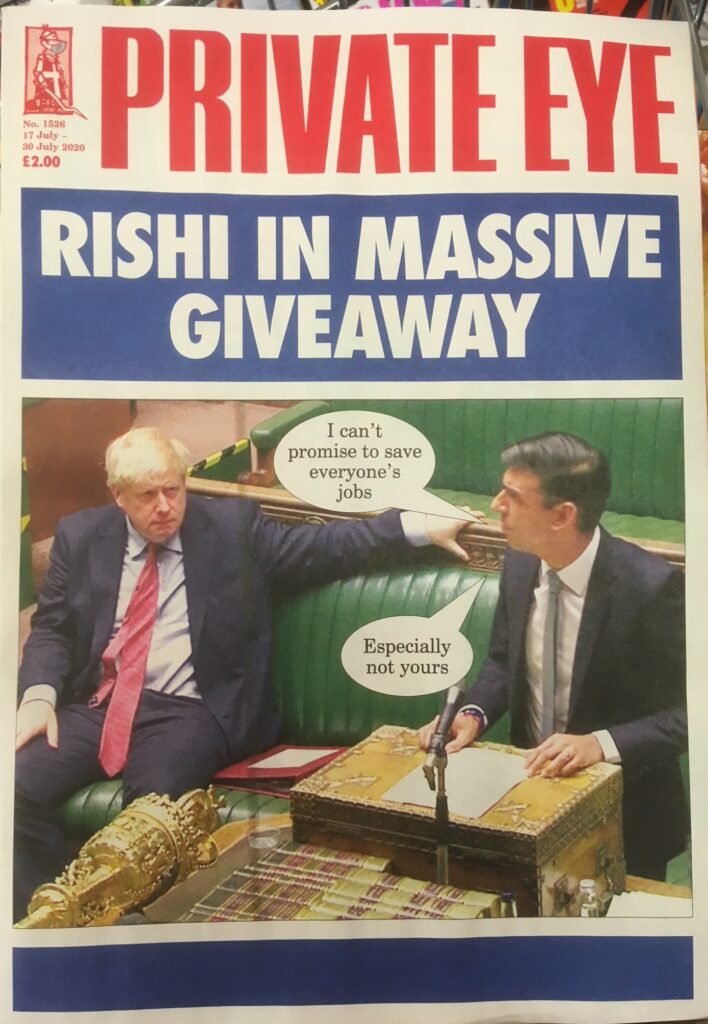
All in the good cause of saving old people from our disgusting hospitals and money grabbing care home, along with a refusal to face up to the reason why our ever expanding ethnic communities are prone to disease – and the fact that people actually have to die..
Leon and the wrong view of young women. It is easier being a man, according to media authorities. July 18th 2020
Female Stereotype

This year marks the 25th anniversary of Luc Besson’s controversial thriller Léon: The Professional – and a special director’s cut has been released to mark the event. In 1995, the film caused a stir on its release over its portrayal of the relationship between the two main characters, the loner hitman Léon and his girl apprentice Mathilda.
The representation of Mathilda as a sexually precocious pre-teen was shocking to both viewers and critics, but the film made stars of both actors, Natalie Portman and Jean Reno, and catapulted Besson into mainstream Hollywood.
Adolescent girls’ stories have long been presented in terms of their sexual precociousness. Yet the history of youth can offer insights into girls’ culture that provides an alternative view to the more common perspective of the male gaze.
In film theory, the male gaze provides a view of the world through the eyes of straight men, since they tend to dominate positions within the film and TV industry. But looking at the nature of girls’ culture, which involves adapting adult conventions to suit their needs, can provide a radical rereading of girlhood.
Looking at Léon
Though Besson’s film was critically acclaimed and in many ways has stood the test of time, its representation of girlhood has long been seen as problematic – and still jars.
Léon presents the story of Mathilda (played by a 12-year-old Portman in her debut role), who is orphaned when her family is murdered and seeks refuge with her neighbour Léon. Mathilda tells Léon that she is 18, though she is clearly prepubescent. Due to her traumatic formative experiences, she believes that she has “finished growing up” and “just getting older”. Over time the two become close as Mathilda becomes Léon’s protégé. Eventually, Mathilda tells Léon that she loves him, and and that she wants to “have it” with him.
In a scene that reinforces her precociousness, Mathilda dresses up as a series of celebrities, impersonating Madonna, Marilyn Monroe and Charlie Chaplin for Léon. The scene wasn’t rehearsed, so that Reno’s response would be one of genuine surprise when Portman croons Like a Virgin and Happy Birthday (Mr President) while clad in make-up and costumes.
Girls’ cultural history
Although the scene invites controversy and is uncomfortable to watch, what it actually demonstrates is undeniably girls’ play, showing typical girlhood amusements: dressing-up and impersonation.
My research into the history of children’s cultures demonstrates that girls have long experimented with appropriation and imitation. Before mimicking celebrities from film and popular music, 19th-century girls would imitate the magazines they read, and write homages to, or critiques of, notable authors. They drew on the media they were immersed in at the time, much like Mathilda. Her impression of Marilyn Monroe is part of her cultural arsenal, despite never having seen Monroe’s films.
An example of 19th-century girls’ appropriating culture can be seen in the youthful writings of Eglantyne Jebb (1876–1928), who went on to co-found the Save the Children Trust and define the rights of the child. Her home-made magazines are held in the Women’s Library at the London School of Economics. One shows that young Eglantyne copied the The Pickwick Club fictional magazine from Louisa May Alcott’s Little Women (1868), which was in turn inspired by Charles Dickens’ first novel The Pickwick Papers (1836–7).
Experts in sociology and education have also observed children’s tendency to appropriate. The sociologist William Corsaro calls this interpretive reproduction, which captures the balance of imitation and agency in girls’ play. Yet this phenomenon is just one aspect of children’s rich cultural lives.
Improving how girls are seen
It is undeniable that latent sexual potential has defined girlhood for many writers and creators, whether they have realised it or not. The depiction of overtly sexualised girlhood is tiresome at best, and dangerous at worst. Natalie Portman has spoken out about the “sexual terrorism” she experienced as a result of appearing in Léon, leading her to say in 2019 that “no one would make Léon today”.
Yet many film-goers informed by #MeToo and intersectional views – which consider the overlapping of social categories such as race, gender and class – expect more. It was only a few months ago that convicted child rapist Roman Polanski won the César award for best director, sparking protests in France and condemnation from actresses including Adèle Haenel, star of the recent French hit Portrait of a Lady on Fire.
In recent years, even before the #MeToo movement, female writers and directors have been emerging to take the subject of girlhood into their own hands, which has resulted in more authentic representations of girls’ experiences. Some, including French director Céline Sciamma are trailblazers in their depiction of female adolescence, eager to redress the balance.
Her films such as Water Lilies (2007), Tomboy (2011), Girlhood (2015) and this year’s Portrait of a Lady on Fire, all place girl characters at the heart of the story. Sciamma’s example shows that stories of girlhood relationships, pastimes and creativity all make for dynamic cinema. They also sensitively deal with questions of adolescent sexuality.
Whether we consider a film made 25 years ago – or a novel written 125 years ago – we see that girlhood is often framed by the wilful misunderstanding of young women’s experiences. The films of Sciamma and her contemporaries indicate that a sea-change is possible. Writers and directors can and must do justice to their girl subjects. They need to look to the real experiences, interests and creative lives of young women, instead of pandering to tropes of sexual precociousness favoured by the male gaze for far too long.
Oxford and its researchers have been quoted in hundreds of articles and broadcasts since early January; this represents just a selection of that coverage.
If you are a member of the University you can sign up to the Daily News Alert to get regular news updates.
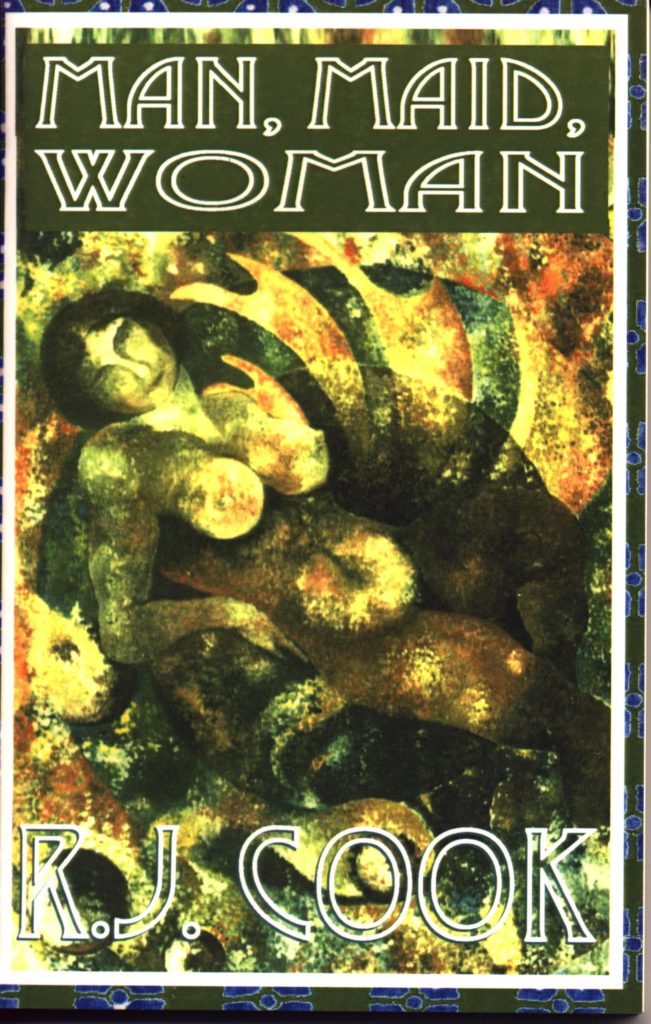
In my view, feminism is a dangerous pernicious creepy style of fascism, embedded in our school and ‘Uni’ system, doing incredible harm to society, children in particular, which is why so many little boys from one parent families are rushing to London;s Tavistock sex change clinic. Robert Cook
Image is cover from the novel ‘Man,Maid,Woman’ by R.J Cook
Oxford University Sidelined Over Covid Conclusions and Research. Media Bias. July 17th 2020
The race to find a vaccine
The Guardian; 27/03/2020
A Guardian long-reads piece on vaccine research for COVID-19 includes an interview with Professor Sarah Gilbert from the Jenner Institute.
Coronavirus vaccine: when will it be ready?
The Guardian; 27/03/2020
Article on the global search for a coronavirus vaccine mentions the University of Oxford vectored vaccine project.
Is coronavirus a terrifying killer or a manageable risk? We still don’t know
Daily Telegraph; 27/03/2020
Article on the uncertainties of coronavirus modelling, including mention of a University of Oxford study by Professor Sunetra Gupta.
BMA discourages medical students from unpaid roles
The Times; 27/03/2020
Article on medical students who are assisting with the COVID-19 efforts in the NHS includes comment from Martin McNally of Oxford University Hospitals NHS Trust.
Scientists work flat out to design and build ventilators in fight against coronavirus
Evening Standard; 26/03/2020
Article on Ox Vent, a “flatpack” ventilator designed by scientists from Oxford University and King’s College London, including a video shot with the researchers.
Scientists and industry are dashing to make more ventilators
The Economist; 26/03/2020
Article on ventilator production includes mention of Ox Vent, which would cost less than £1,000 ($1,177) each and should be approved and working in trials at hospitals in London and Oxford in about two weeks.
[Coverage elsewhere]
Test to show immunity to coronavirus is due ‘within two weeks’
The Times; 27/03/2020
The government has ordered 3.5 million tests to reveal who is immune to coronavirus. The tests are currently being trialled and validated for effectiveness at a lab at Oxford University.
[Coverage elsewhere]
Oxford hotel houses NHS staff during coronavirus pandemic
Oxford Mail; 25/03/2020
The 87-bed Linton Lodge Hotel is staying open for NHS personnel working at Oxford University Hospitals and has been occupied by non-surgical and administrative healthcare workers who want to minimise the risk of spreading the infection and self-isolate from their families. The rooms have not been given out for free, but general manager Keith Walford promised he had worked out a deal with the hospitals.
Global virtual ‘study-a-thon’ bringing together Covid-19 researchers
Oxford Mail; 25/03/2020
More than 290 people from 29 different countries have registered for a four-day online event, which starts February 26, to work on the coronavirus pandemic. Researchers from the Nuffield Department of Orthopaedics, Rheumatology and Musculoskeletal Sciences, Oxford University are to lead the collaboration aiming to inform healthcare decision-making in response to the current global pandemic.
Doctor kicked out by landlord because of coronavirus fears
Oxford Mail; 25/03/2020
A surgeon working between the Nuffield Orthopaedic Centre and the John Radcliffe has been evicted from his rented accommodation in Oxford because of fears he would spread coronavirus. Joseph Alsousou had been lodging at a house in Headington on weekdays since August but was told to leave by his landlady, who said she was anxious he might bring Covid-19 into the home.
Lockdowns are the best hope to slow the spread of coronavirus, suggests new Chinese study
Mail Online UK; 25/03/2020
Lockdowns and travel restrictions are the best methods to slow the spread of coronavirus, a new study of China suggests.
Researchers from the University of Oxford in the UK and Northeastern University in Boston, Massachusetts, found that in Wuhan – the epicenter of the outbreak – restriction on travels came too late.
Dr Moritz Kraemer, a research fellow at the University of Oxford, said: ‘Our findings show that early in the coronavirus outbreak travel restrictions were effective in preventing the import of infections from a known source.
‘However, once COVID-19 cases begin spreading locally the contribution of new importations was much smaller.
As world shuts itself in, value of teleconferencing app zooms
Hindustan Times online; 25/03/2020
Sally Maitlis, a professor of organisational behaviour at Oxford University’s Said Business School, comments on how being forced to work remotely due to the coronavirus outbreak has changed may workplaces.
Half of population may be infected, says Oxford study
Financial Times; 25/03/2020
Report of modelling of the outbreak by Oxford’s Evolutionary Ecology of Infectious Disease. Sunetra Gupta, professor of theoretical epidemiology, who led the study, said: “We need immediately to begin large-scale serological surveys — antibody testing — to assess what stage of the epidemic we are in now.”
[Coverage elsewhere]
Could coronavirus crisis be over by EASTER? Advisor ”confident” NHS can remain within capacity
Mail Online UK; 25/03/2020
Report on yesterday’s Commons science and technology committee hearing mentions that Andrew Pollard, professor of paediatric infection and immunity at the University of Oxford, who was also called before the committee, said a vaccine could potentially be available within six months.
Vaccine teams need cash injection
The Times; 25/03/2020
Article on funding for coronavirus vaccine research includes comment from Professor Sarah Gilbert from the Jenner Institute at Oxford University.
What Is The Coronavirus ”Antibody Test” And How Will It Work?
Huffington Post UK (Blog); 25/03/2020
Professor Trudie Lang, director of the Global Health Network, University of Oxford, comments on antibody tests to see who has been infected with coronavirus.
Coronavirus in Italy takes its toll on organized crime
Fox News online; 25/03/2020
The coronavirus outbreak in Italy is having a knock-on impact on organised crime. Professor Federico Varese, of Oxford University says that organised crime will continue to suffer as Italy’s economy contracts. “I don’t think they have all that much cash lying around. The longer it lasts, the harder it becomes for them to operate,” he said.
Struggling to focus at home? You’re not alone
Times Higher Education Supplement online; 25/03/2020
Alice Kelly, of the Ruthermere Institute, Oxford University, offers advice on how to be productive at home, and references the successful online Academic Writing Group that she set up at the University of Oxford in 2015 to make early career academics feel less isolated and more accountable, through group motivation and peer support.
Coronavirus acts of kindness: from Jack Ma and Chelsea soccer club to local Facebook groups, how it’s not all doom and gloom
South China Morning Post online; 25/03/2020
An article about how people are finding ways to be kind to each other during the coronavirus pandemic references an Oxford University study from 2016 that found being kind to others causes a small but significant improvement in subjective well-being. In other words, when we are kind to others, we feel better about ourselves.
Pharmacies told they can SPLIT larger packs of paracetamol and sell smaller strips to the public as supermarkets and chemists run out during coronavirus crisis
Mail Online UK; 24/03/2020
An article about how the coronavirus pandemic has caused a paracetamol shortage, includes a pull-out box of the history of the outbreak so far, with comments made by Dr Peter Horby, professor of emerging infectious diseases and global health at Oxford University
Coronavirus: Families should start planning for how virus affects most vulnerable, warns top medic
The Independent online; 24/03/2020
New research from Oxford University has cautioned that people concerned about becoming seriously ill due to the coronavirus should begin planning for how the disease might affect them. Professor Dominic Wilkinson, a consultant neonatologist and Oxford University ethics professor, said that it was “crucial” families had an open and honest conversation about how the outbreak could impact those most at risk. He also stressed the importance of planning for those who are middle-aged and otherwise healthy so they could manage their expectations around healthcare provision from an NHS already working “above its normal capacity”.
Europe eyes potentially intrusive smartphone location data to stem virus spread
Japan Times; 24/03/2020
News that countries around the world are considering using intrusive smartphone location data to control the spread of coronavirus includes comment from Michael Parker, an ethicist at Oxford University, who said people are more likely to comply with this form of monitoring if they are no coerced into using it. The greater the participation the better the odds of identifying ‘hot spots’ and containing the virus.
What you need to know about masks and protecting yourself against COVID-19
CBC online; 24/03/2020
Advice on how to protect yourself from coronavirus using a mask references recent research led by Elaine Shuo Feng, a postdoctoral researcher with the University of Oxford Vaccine Group, which suggested it would be “rational” to recommend wearing face masks in public to protect: healthy people in quarantine (or self-isolation) if they need to leave home for any reason, and vulnerable people, such as older adults, and those with underlying medical conditions.
Can I walk my dog? The Government’s coronavirus advice, explained
The Daily Telegraph Online; 24/03/2020, p.1
A review of the government guidance given around the lockdown on social activities during the coronavirus outbreak, including leaving your house for just one hour of exercise per day, references comments made by Professor Sir Muir Gray, an expert in healthy ageing at Oxford University. He said: “Being active can have a significant impact on preventing dementia and frailty.”
COVID-19: For Moscow’s quarantined, 100,000 cameras are watching
Channel NewsAsia online; 24/03/2020
Extensive surveillance technology rolled out on the streets of Moscow before the coronavirus epidemic, is now helping to control the spread of COVID-19 in the city. 10,000 facial recognition cameras were installed on the streets of the city before the outbreak. The article refers to research conducted by Valentin Weber, a researcher in cybersecurity at Oxford University, who found that Russia alongside China lead the field globally with the most sophisticated facial recognition technology, which they export to some 100 countries.
Coronavirus latest news: Wuhan plans to end lockdown in April
New Scientist online; 24/03/2020
Residents of Wuhan in Hubei province will be allowed to leave the city from 8 April if they are given the all-clear from a health app issued by Chinese authorities. The city has been under complete lockdown since 23 January. People in other areas of Hubei will be able to travel from tomorrow.
Coronavirus may have infected half of UK population – Oxford study
Financial Times online; 24/03/2020, Clive Cookson
Report of modelling of the outbreak by Oxford’s Evolutionary Ecology of Infectious Disease. Sunetra Gupta, professor of theoretical epidemiology, who led the study, said: “We need immediately to begin large-scale serological surveys — antibody testing — to assess what stage of the epidemic we are in now.”
[Coverage elsewhere]
Coronavirus: Dyson develops ventilators for NHS
BBC online; 24/03/2020
News that Dyson has announced it will develop new type of ventilator for the NHS, references Oxford University and King’s College London’s work on on another new type of ventilator. It is less advanced than existing commercial models, but benefits from being relatively quick to construct.
[Coverage elsewhere]
Dutch firm creates new coronavirus test that gives results in just 15 minutes
Mail Online UK; 24/03/2020
An article about international work to create a coronavirus test that gives rapid results, includes new research from Oxford University who may have created a test which analyses viral RNA to detect COVID-19 in just 30 minutes.
[Coverage elsewhere]
Early-life adversity linked to long-term effect on memory
Mail Online UK; 24/03/2020
Early-life adversity is linked to long-term effects on memory and thinking in later life, according to new Oxford University research. Ruby Tsang of the Department of Psychiatry at Oxford University, found that family financial hardship in early life and poorer childhood health predicts greater memory and thinking decline. She presented the research at the Alzheimer’s Research UK Virtual Conference in Wales.
[Coverage elsewhere]
HIV drug to be trialled on coronavirus patients to see if it can fight Covid-19
The Daily Telegraph Online; 24/03/2020, p.1
Scientists at Oxford University have started a clinical trial to investigate the effects of an HIV medicine and a steroid drug in UK patients admitted to hospital with COVID-19 caused by the new coronavirus.
The researchers, led by Peter Horby, a professor of emerging infectious diseases at Oxford, said that since the safety and side effects of both drugs are already known, the trial would focus on their potential against COVID-19 infection.
How to self-isolate: the dos and don’ts of staying at home during the coronavirus outbreak
The Daily Telegraph Online; 24/03/2020, p.1
An article outlining advice for how to successfully self-isolate during the coronavirus outbreak includes comments from Professor Christl Donnelly, professor of applied statistics at Oxford University and professor of statistical epidemiology at Imperial College London. “You want to avoid opportunities for transmission, so you can talk to people on the phone and you can talk to people at a distance but you want to minimise the chances they will come into contact with you directly,” says Professor Donnelly. Adding that if you’re in a house where someone is self-isolating, you’ll need to monitor your behaviour patterns closely: “Try to limit the possibility they will touch things that you’ve been touching.
UK scientists handed £20m for the battle against virus
Daily Mail (Scotland); 24/03/2020
The University of Oxford is to receive more than £4 million from the government to fund three coronavirus research projects. Business Secretary Alok Sharma announced on Monday that six research projects across the UK will benefit overall from a share of £20 million in government funding.
The three projects which will benefit at the University of Oxford include a team developing a new vaccine against COVID-19, a clinical trial which is testing if existing or new drugs can help patients hospitalised with the virus and another which is developing manufacturing processes so a vaccine could be made available to high-risk groups as quickly as possible.
[Coverage elsewhere]
Give China credit where it is due, or miss helpful insights
South China Morning Post, 24/03/2020
An article written by Bryan YS Wong, a Rhodes scholar and MPhil Political Theory student studying at Wolfson College, about how unhelpful attacks on the Chinese government’s handling of the coronavirus pandemic are preventing us from learning vital lessons from it.
University of Oxford to receive £4m to fund three coronavirus research projects
ITV.com; 23/03/2020
The University of Oxford is to receive more than £4 million from the government to fund three coronavirus research projects. Business Secretary Alok Sharma announced on Monday that six research projects across the UK will benefit overall from a share of £20 million in government funding.
The three projects which will benefit at the University of Oxford include a team developing a new vaccine against COVID-19, a clinical trial which is testing if existing or new drugs can help patients hospitalised with the virus and another which is developing manufacturing processes so a vaccine could be made available to high-risk groups as quickly as possible
[Coverage elsewhere]
Coronavirus: How does the UK compare with other European countries?
Mail Online UK; 23/03/2020
Professor Duncan Young of Oxford’s Nuffield Department of Clinical Neurosciences comments on comparative COVID-19 mortality rates between countries.
UK begins trial of HIV medicine, steroid as possible COVID-19 treatments
Reuters online; 23/03/2020
Scientists at Oxford University have started a clinical trial to investigate the effects of an HIV medicine and a steroid drug in UK patients admitted to hospital with COVID-19 caused by the new coronavirus.
The researchers, led by Peter Horby, a professor of emerging infectious diseases at Oxford, said that since the safety and side effects of both drugs are already known, the trial would focus on their potential against COVID-19 infection.
[Coverage elsewhere]
Letter: Sunak’s response
The Times; 23/03/2020
An open letter from Oxford University economists to the UK government has challenged their economic response to the COVID-19 crisis. The letter has a total of 80 signatories including Jo Michell Associate professor in economics, UWE Bristol Rob Calvert Jump Research fellow in political economy, Greenwich University Diane Elson Emeritus professor, University of Essex Simon Wren-Lewis, Professor of Economic Policy, University of Oxford.
It reads…“Sir, As economists, academics and directors of research organisations, we are writing to insist that the government goes significantly further in its economic response to the Covid-19 crisis…”
Death rate ‘likely to be less than 1%’
The Times; 23/03/2020
Scientists at Oxford University say the COVID-19 death rate could be much less than first reported. The team looked at the dramatic variation in death rates in known cases around the world and found that less than 0.2% of patients who catch coronavirus will die worldwide. The article includes comments from Carl Heneghan, Professor of Evidence-Based-Medicine at Oxford University.
‘Remind yourself that this will pass’
The Guardian; 23/03/20
Article recommending that people take a long view of the current crisis for their mental health and wellbeing. Oxford professor of clinical psychology, Daniel Freeman, is quoted, saying ‘we have to come to terms with uncertainty…we have to accept that no action is 100% risk-free…in the end it is best to concentrate on what is meaningful in our lives.’
Decide now whether you want to be resuscitated, elderly told
The Sunday Times; 22/03/2020
Doctors are being urged to ensure elderly and nursing home patients have a ‘do not resuscitate’ order in place to help ease the burden on the NHS in the wake of the coronavirus outbreak, according to Trisha Greenhalgh, Professor of Primary Care at Oxford University. She had been contacted by a respiratory physician who wanted the message to be circulated to GPs.
She wrote on Twitter yesterday: “From a hospital respiratory physician. Please ask GPs to ensure that all nursing home patients have an advance directive in place where appropriate.”
Lockdown
The Sunday Times; 22/03/2020
An overview of the battle to stop the spread of COVID-19 includes comments from Professor Trudie Lang, a global health specialist at the Nuffield Department.
TV: The Listening Post
Al Jazeera International; 22/03/2020, 14:38
Jan-Emmanuel de Neve, director of the Wellbeing Research Centre at Oxford University, comments on coping with social isolation during the coronavirus outbreak.
Radio: The Cultural Frontline
BBC World Service; 22/03/2020, 12:08
Sarah Gilbert, professor of vaccinology at the University of Oxford, comments on the development of vaccines for disease outbreaks.
Medical students take their finals online as colleges bid to overhaul exam systems
The Observer; 22/03/20
Medical students at Imperial College have taken online unsupervised exams, putting pressure on other universities, including Oxford and Cambridge, to follow suit. But the article says not all students are convinced. An open letter from students to Prof Martin Williams, Oxford’s pro-V-C for education, is quoted: ‘Some students may not have a quiet environment in their homes to take a timed online exam and would prefer take home exams. Yet others may need to take care of their ailing family members and have to delay their exams entirely.’
Vaccine centre plan delayed
Sunday Telegraph; 22/03/20
Article claiming that wrangling has held up the creation of a vaccine because plans to create a plant at the Oxford Science Park for manufacturing vaccines were delayed by Whitehall. Prof Sir John Bell is quoted saying that it took ‘forever to decide’ whether to back the plans and ‘if you don’t have the capacity, you’ll be last in the queue’. A spokesman for the centre said plans are in place for accelerating the development of the facility.
UK ‘severely lacking’ in facilities to mass-produce a vaccine
Sunday Telegraph; 22/03/20
Article maintaining that the UK does not have the manufacturing capability to produce a vaccine, although Oxford researchers are already testing on animals: ‘Experts have warned that while the UK is a leader in vaccine science, it is severely lacking in manufacturing facilities to mass-produce the vaccines.’
Tests begin on ventilators designed for rapid production
i (The paper for today); 21/03/2020
The University of Oxford and King’s College London are pioneering machines that could be built in small-scale workshops with pre-existing “off-the-shelf” components, with manufacturers already on a wartime footing to meet the shortage caused by Covid-19. The Oxford and King’s researchers hope a prototype can be developed within weeks that will satisfy the demands of medical and healthcare product regulators, with the machines reaching hospitals within two to three months.
Professor Andrew Farmery, from Oxford’s Nuffield Department of Clinical Neurosciences, said: “Ordinarily, to develop a medical device such as this would be a huge task, and would take years. We have designed a simple and robust ventilator which will serve the specific task of managing the very
Professor Mark Thompson, Oxford’s Department of Engineering Science, said: ‘This extraordinary situation demands an extraordinary response and we are pulling all the talents together in an exceptional team combining decades of experience translating research into the clinic, brilliant innovators, and highly skilled technicians.” sickest patients.”
[Coverage elsewhere]
Analysis
The Times; 21/03/2020
New Oxford University research has shed light on how the COVID-19 outbreak spread spiralled so rapidly in Italy. In a study published in the journal Demographic Science, the researchers note how Italian children often mingle with their grandparents and suggest that this helped the virus rip through their society. High levels of commuting in the northern regions were also cited as a potential factor.
When things fall apart
Financial Times; 21/03/2020
An article about the principles of the new book ‘The Precipice’, written by the Oxford University philosopher Toby Ord, which discusses the fragility of modern society in the context of the COVID-19 outbreak.
The lockdown and the long haul
The Economist; 21/03/2020
It’s reported that, ‘the first genome sequence for sars-cov-2 was published on January 10th. The next morning Sarah Gilbert, a virologist at Oxford University, headed straight for her laboratory to see what she could do to turn that sequence into a vaccine—as did hundreds of others at dozens of institutions and companies. Adrian Hill, a professor at Oxford, says that in general terms “six months from sequence to vaccination is very doable if the right vaccine technology is used”.’
European firms change business models to aid response to pandemic
The Guardian; 21/03/2020
The British Honey Company, which makes honey, gin, rum and other spirits at its Cotswolds base, said it would use spare capacity at its Worminghall distillery to produce hand sanitiser. Its chief executive, Michael Williams, said: “An alcohol-based sanitiser is vodka or gin at 70% ABV made from denatured alcohol… Our expert distillery team have been working alongside our in-house microbiologist and an Oxford University chemist to develop and manufacture this new product.”
Fears social distancing could last up to a year
Daily Express; 21/03/2020
Professor Trudie Lang, of the Global Health Network at the University of Oxford, said that the latest test for COVID-19 works by detecting the vital antibodies which “will demonstrate if your immune system has cleared the infection…It’s very unlikely you can get the virus again.”
Frontier theatre
The Economist; 21/03/2020
Christopher Dye of Oxford University comments on border controls to manage the spread of coronavirus: “From an epidemiological point of view border controls are a distraction, and potentially a damaging one.”
Briton in trial to find a cure
The Times; 20/03/2020
Researchers at Oxford University hope to conduct animal tests next week and human safety trials as early as next month.
[Coverage elsewhere]
Coronavirus: the week explained
The Guardian; 20/03/2020
Prof Deirdre Hollingsworth, at Oxford University, joined The Guardian’s Science Weekly podcast to explain how social distancing works.
Coronavirus good news! UK starting vaccine next month and virus-zapping robots are ready
Mirror.co.uk; 20/03/2020
Trials of a coronavirus vaccine could begin within the next month, the Government’s health agency has said, as it prepares to start evaluating a drug developed by Oxford University.
[Extensive coverage elsewhere]
Asia deploys innovative, if invasive, tech to curb virus
Mail Online UK; 20/03/2020
On Wednesday a team of experts at the University of Oxford announced they were working with several European governments to explore an app for instant contact tracing that could be deployed with “appropriate ethical considerations”.
“Current strategies are not working fast enough to intercept transmission of coronavirus,” said Professor Christophe Fraser from the university’s Big Data Institute. “To effectively tackle this pandemic we need to harness 21st century technology.”
[Coverage elsewhere]
England’s muddled coronavirus testing is leaving key workers scared and alone
Wired.co.uk; 20/03/2020
Liz Tunbridge and five colleagues at a University of Oxford psychiatry lab have already volunteered their services to help process samples of coronavirus. She says that the team is well-versed in processing biological samples, albeit in a non-clinical context, and could assist. “We have the skills needed, we just need to be given access to the samples,” she explains. If their offer of help is accepted, she expects that the team will be asked to work in a local health authority lab where patient samples are being tested. Since tweeting about the initiative, Tunbridge has been approached by many others in a similar position. “I have been contacted by academics from all over the place who are willing to help – it’s incredibly gratifying to see, people just really want to help,” she says.
What Is The Coronavirus ”Antibody Test” – And How Will It Work?
Huffington Post UK; 20/03/2020
Prof. Trudie Lang from Oxford University comments on a new test for coronavirus that can test if an individual has developed antibodies to the virus. She says it will be “completely transformational” in fighting Covid-19 around the world. “We can make sure we’ve got doctors or nurses who can work safely in hospitals,” she says. “People won’t have to isolate unnecessarily at home for 14 days, because you’ll be able to tell very quickly if people have cleared it or not.”
What should UK students do during the coronavirus outbreak?
The Guardian; 20/03/2020
According to Prof Carl Heneghan, the director of the Centre for Evidence-Based Medicine at the University of Oxford’s Nuffield Department of Primary Care Health Sciences, most young people do not have to worry about their own health. “Their role is to understand their job in slowing the spread of the disease and how it will impact older people. It’s about not overwhelming services,” he says. His advice is to avoid physical contact as much as possible. “Minimise your social contact for the next few weeks,” he says.
Trials to begin on Covid-19 vaccine in UK next month
The Guardian; 20/03/2020
Researchers at Oxford University hope to conduct animal tests next week and safety trials as early as next month. Adrian Hill and Miles Carroll interviewed.
How does a car company make a ventilator?
Wired; 20/03/2020
Article on car companies switching to manufacturing ventilators, with comment from Matthias Holweg, professor of operations management at the University of Oxford’s Saïd Business School.
Radio: Today Programme
BBC Radio 4; 19/03/2020, 06:51 (50:50 on the clock)
Professor Zhanfeng Cui from the Department of Engineering Science, discusses a new rapid testing technique for coronavirus developed by himself and a team of scientists in Oxford and China.
[Widespread coverage elsewhere]
TV: Channel 4 News
Channel 4; 19/03/2020, 19:38
Professor Ian Goldin, Professor of Globalisation and Development at Oxford University, comments on whether the coronavirus pandemic was an inevitable consequence of modern globalisation.
Students Against Coronavirus group to help isolated in Oxford
Oxford Mail; 18/3/2020
Oxford University students facing the coronavirus lockdown are co-ordinating efforts to help people isolated by the spread of the virus. Students Against Corona is a campaign set up less than 24 hours ago by students at Oxford University who want to help deliver food parcels, carry out errands, or be available to speak to anyone feeling lonely.
Also:
Coronavirus: Oxford University students set up help group
BBC News online; 18/03/2020
Quick coronavirus testing being developed in Oxford
Oxford Mail; 18/3/2020
Scientists in Oxford say they have developed ‘rapid testing technology’ for Covid-19. The test is capable of giving results in just half an hour, which is three times faster than the current testing method, which takes at least one and a half hours. It has been created by experts from Oxford University’s engineering science department, and the Oxford Suzhou Centre for Advanced Research in China.
[Widespread coverage elsewhere]
Radio: Healthcheck
BBC World Service; 18/03/2020, 20:37
Deirdre Hollingsworth, an infectious disease epidemiologist at the Oxford Big Data Institute, comments on her research into the spread of the current coronavirus outbreak.
Students Against Coronavirus group to help isolated in Oxford
Oxford Mail; 18/3/2020
Oxford University students facing the coronavirus lockdown are co-ordinating efforts to help people isolated by the spread of the virus. Students Against Corona is a campaign set up less than 24 hours ago by students at Oxford University who want to help deliver food parcels, carry out errands, or be available to speak to anyone feeling lonely.
Quick coronavirus testing being developed in Oxford
Oxford Mail; 18/3/2020
Scientists in Oxford say they have developed ‘rapid testing technology’ for Covid-19. The test is capable of giving results in just half an hour, which is three times faster than the current testing method, which takes at least one and a half hours. It has been created by experts from Oxford University’s engineering science department, and the Oxford Suzhou Centre for Advanced Research in China.
Radio: BBC World Service, Healthcheck
18/03/2020; 20:37:58
Deirdre Hollingsworth, an infectious disease epidemiologist at the Oxford Big Data Institute, comments on her research into the spread of the current coronavirus outbreak.
Students Against Coronavirus group to help isolated in Oxford
Oxford Mail; 18/3/2020
Oxford University students facing the coronavirus lockdown are co-ordinating efforts to help people isolated by the spread of the virus. Students Against Corona is a campaign set up less than 24 hours ago by students at Oxford University who want to help deliver food parcels, carry out errands, or be available to speak to anyone feeling lonely.=
Quick coronavirus testing being developed in Oxford
Oxford Mail; 18/3/2020
Scientists in Oxford say they have developed ‘rapid testing technology’ for Covid-19. The test is capable of giving results in just half an hour, which is three times faster than the current testing method, which takes at least one and a half hours. It has been created by experts from Oxford University’s engineering science department, and the Oxford Suzhou Centre for Advanced Research in China.
Radio: BBC World Service, Healthcheck
18/03/2020; 20:37:58
Deirdre Hollingsworth, an infectious disease epidemiologist at the Oxford Big Data Institute, comments on her research into the spread of the current coronavirus outbreak.
Letter: Captains of industry, step up in times of need
Financial Times online; 18/03/2020
Professor Chris Rowley, visiting Fellow at Kellogg College, writes in response to news that the government wants companies to ramp up production of respirators.
Coronavirus symptoms day-by-day: Worst-affected will be struggling to breathe within five days and need a ventilator by day eight – but most people who contract the virus will recover fully within a week
Mail Online; 18/03/2020
An article about the progression of coronavirus symptoms includes a pull-out box of the history of the outbreak so far, including comments made by Dr Peter Horby, professor of emerging infectious diseases and global health at Oxford University
Why the Coronavirus Hit Italy So Hard
Wired; 17/03/2020
University of Oxford researchers have published a new paper in the journal Demographic Science, on the demographic reasons Italy has been hit particularly hard.
TV: Could an app stop the spread of coronavirus?
Channel 4 News; 17/03/2020
A news segment about Oxford University researchers collaborating with the government to create a mobile app which would instantly trace contacts of those who have been diagnosed with coronavirus. The segment includes interviews with some of the team involved, including Professor Christophe Fraser of Oxford’s Big Data. He said: “If this mobile app is developed and deployed rapidly, and enough people opt-in to use such an approach we can slow the spread of coronavirus.”
[Coverage elsewhere]
Coronavirus crisis: Unearthed photographs show how world dealt with pandemics
Daily Express; 17/03/2020
An article about the history of human response to pandemics includes the Spanish Flu, and references an educational resource on the University of Oxford website about World War 1, which reported that as many as one in every 18 people were killed by the virus.
What the Government’s new coronavirus advice means for how we live now
The Daily Telegraph online; 17/03/2020
Professor Sir Muir Gray, an expert in healthy ageing at Oxford University, comments on the impact that the government’s new coronavirus advice means for how we live now. He said: “Being active can have a significant impact on preventing dementia and frailty.”
Would you let one person die to save four? Five ways coronavirus will test our ethics
ABC Online Australia online; 17/03/2020
An article written by Julian Savulescu, Uehiro chair in practical ethics at University of Oxford, and visiting professorial fellow, Murdoch Children’s Research Institute and Melbourne Law School. Professor Dominic Wilkinson is a consultant neonatologist at John Radcliffe Hospital in Oxford and Professor of Medical Ethics at University of Oxford, about the various that the coronavirus outbreak will test medical ethics.
With estimated #477 per injection, there are potentially billions to be made from a coronavirus jab
Mail Online; 17/03/2020
An article about coronavirus vaccine research includes an Oxford University project sponsored by Cepi. It will cost at least £1.6 billion to develop a vaccine over the next 12 to 18 months.
[Coverage elsewhere]
I’m a researcher who’s helped change how we tackle pandemics like coronavirus forever – this is what we’ve learned
The Independent; 17/03/2020
Dr Moritz Kraemer, a senior research fellow on the Oxford Martin Programme on Pandemic Genomics, writes that for the first time, we have a world-leading consortium to respond to similar threats.
The coronavirus myths that went viral
Mail Online UK; 17/03/2020
Professor Trudie Lang, director of the Global Health Network at the University of Oxford, comments on common misconceptions around coronavirus.
The ins and outs of self-isolation
The Guardian; 17/03/2020
Professor Carl Heneghan, director of the Centre for Evidence-Based Medicine at the University of Oxford’s Nuffield Department of Primary Care Health Sciences, comments on preventing the spread of coronavirus.
TV: Live With Lucy Hockings
BBC World News; 16/03/2020, 12:23
Dr Peter Drobac, global health expert, interviewed about exponential rise in cases and how that’s fueling restrictions being imposed around the world. Also, which measures are most effective, and his opinion that UK measures are unorthodox and a gamble.
TV: Victoria Derbyshire
16/03/2020, 10:09
Epidemiologist Katrina Lythgoe and Dr Peter Drobac, a global health physician from the Said Business School, discuss the context of the pandemic, daily TV briefings, science, strategy, communications and transparency, and how we can make decisions in our lives to minimise loss of life. Also, whether health workers are properly equipped.
The race to make a coronavirus vaccine
The Observer, 15/03/2020
Article referencing Cepi’s original portfolio of four funded Covid-19 vaccine projects including an announcement of a $4.4m (£3.4m) of partnership funding with Novavax and with a University of Oxford vectored vaccine project.
Vaccine hunters: meet the scientists racing to find a cure
The Sunday Telegraph, 15/03/2020
At Oxford University’s Jenner Institute, researchers are producing a vaccine “seed stock”, 1,000 doses of which will be manufactured in Italy for use in clinical trials. At present around 35 pharmaceutical companies are similarly working to develop a vaccine.
Almost 20 million people in Britain could be infected by summer
Mail Online UK; 14/03/2020
Robin Thompson, a mathematical epidemiology specialist at Britain’s Oxford University who has published predictions about this outbreak and is actively working on updating them, added: ‘In a situation like this where there are so many unknowns, it’s fair to say it’s impossible to predict with any kind of precision at all when the peak is going to happen.’
Schools: four weeks of closures could cost billions
The Guardian; 14/03/2020
Simon Wren-Lewis, an emeritus professor of economics at Oxford who co-authored a study of past influenza pandemics, has estimated direct losses caused by the illness to be 1% to 2% of output, measured by GDP – which would multiply if schools were closed for extended periods. He says: “School closures can amplify the reduction in labour supply if some workers are forced to take time off to look after children…But even with all schools closed for three months and many people avoiding work when they were not sick, the largest impact we got for GDP loss over a year was less than 5% … but there is no reason why the economy cannot bounce back to full strength once the pandemic is over.”
California’s governor says incomplete coronavirus test kits are like having a printer with no ink
CBS News; 13/03/2020
As of March 10, according to data from the University of Oxford’s ‘Our World in Data’, South Korea had tested 210,144 people. In Italy, 60,761 people had been tested. In the United Kingdom, 21,261 people had been tested. In the United States, however, only 8,554 tests had been administered, despite a much larger population — leaving the potential for people who do not know they are positive to continue spreading the virus to others.
“Super-spreaders”: COVID-19 myth or reality?
Channel NewsAsia; 14/03/2020
Cristl Donnelly, professor of Applied Statistics at the University of Oxford, said all disease transmission was by nature “highly variable”. “But we are not all the same, we vary in our immune systems, in our behaviour, and in where we happen to be,” she said. “All of these things can affect how many people we would transmit to.”
Coronavirus: What is herd immunity? And how will it help prevent spread of COVID-19?`
SKY News; 14/03/2020
Coverage of an explanation of herd immunity from the Vaccine Knowledge Project at Oxford University, which describes it as when it’s difficult for infectious diseases to spread because a high percentage of the population is vaccinated.
Coronavirus: UK could see ‘up to 500k deaths’ says expert
Daily Express; 13/03/2020
Peter Drobac from the Saïd Business School shares his views that even in the ‘better case scenario’ the UK could see 300-500,000 deaths from coronavirus and questions why attempts to limit the spread are not more aggressive to buy more time for vaccine development and other measures.
No kissing, but singles are out looking for love
The Sunday Times; 15/03/2020
An article about the impact of coronavirus on relationships includes comment from David Coleman, emeritus professor of demography at Oxford University, who suggests that increased cosiness at home might lead to an uptick in the birth rate in nine months.
China to benefit if British start-up finds a vaccine
The Sunday Times; 15/03/2020
Sir John Bell, the Regius professor of medicine at Oxford University, comments on the coronavirus outbreak and the search for a vaccine.
”Herd immunity”: Why Britain is actually letting the coronavirus spread
Sydney Morning Herald; 15/03/2020
Article asking why Britain is out on its own, allowing the virus to spread, while other countries have closed schools and taken more drastic action. It suggests that the government is trying to build up herd immunity to combat the infection. Oxford and LSE are said to agree with the British approach.
When will a coronavirus vaccine be ready?
The Guardian; 15/03/20
Exploration of the ‘race’ to create a vaccine, with a Boston-based company ready to start human trials next month and research concentrating on newer types of vaccine. Mention of funding being given to Oxford’s ‘vectored vaccine project’
Xinhua Headlines: Work resumption in China raises hope for virus-hit European economies
News.cn; 15/03/2020
China is going back to work. Fu Xiaolan, founding director of the Technology and Management Center for Development at Oxford University says this is a good sign for economic stability in Europe and the world.
Radio: Digital Planet
BBC World Service; 16/03/2020, 01:34
Deirdre Hollingsworth, an infectious disease epidemiologist at the Oxford Big Data Institute, comments on her research into the spread of the current coronavirus outbreak.
Radio: The Newsroom
BBC World Service; 16/03/2020, 02:27
Economists at Oxford University have found an increase in online searches associated with coronavirus and economic recession as well as an increase in misinformation about the current outbreak online.
Radio: CrowdScience
BBC World Service; 16/03/2020, 05:32
Episode of CrowdScience recorded at Oxford’s Nuffield Department of Medicine, where Oxford researchers answer listeners’ questions about their research into COVID-19.
Radio: Today
BBC Radio 4; 13/03/2020, 07:09
Peter Drobac of Oxford’s Saïd Business School comments on the UK’s approach to tackling the spread of coronavirus.
Radio: The World at One
BBC Radio 4; 13/03/2020, 13:17
Andrew Pollard, professor of paediatric infection and immunity at Oxford University, explains herd immunity.
Radio: Newshour
BBC World Service; 13/03/2020, 21:34
Peter Horby, professor of emerging infectious diseases and global health at Oxford University, explains his research team’s work in studying the outbreak of COVID-19 since the beginning of the year.
Just How Bad Could a Coronavirus Recession Get?
New York Times; 12/03/2020
Professor Ian Goldin from the Oxford Martin School pens an opinion piece on the ways to avert a major global economic meltdown caused by coronavirus.
Radio: Science in Action
BBC World Service Radio; 13/03/2020, 05:34
Deirdre Hollingsworth, an infectious disease epidemiologist, discusses her study comparing effectiveness of different country’s responses to coronavirus and what is making control so difficult.
Has the Government got its coronavirus strategy right?
Daily Telegraph; 13/03/2020
Article on the evidence contradicting the UK government’s approach to coronavirus includes mention of the paper published in The Lancet last week by Deirdre Hollingsworth, which documented the need for the government to decide the main aim of its mitigation strategies.
TV: Beyond 100 Days
BBC News 24; 12/03/2020, 19:50
Behavioural scientist Kate Orkin interviewed on people wanting to mitigate the risk of catching coronavirus and changing social norms and behaviour. Also managing messaging and language about doing the right thing in society.
Radio: The World Tonight
BBC Radio 4; 12/03/2020, 22:10
Dr Peter Drobac, infectious disease specialist, comments on whether the government’s strategy over coronavirus is a sensible one and shares his surprise about the new measures as part of the delay phase stating they are less aggressive than he would have expected.
What is herd immunity and is it possible for the UK?
The Independent, 13/03/2020
Article on coronavirus herd immunity includes substantial explanations from the Vaccine Knowledge Project at Oxford University.
How to avoid panicking with coronavirus outbreak
ABC News, 12/03/2020
Article on how to avoid panic around coronavirus includes coverage of a study from Oxford University published in the journal Nature Neuroscience that helps explain what panic does to the human brain.
Flattening the curve: Charts reveal how restricting people’s movements can stop the coronavirus pandemic from overwhelming the NHS
Mail Online, 12/03/2020
Article on coronavirus includes comment from Dr Peter Horby and data from the Oxford Vaccine Group.
Why COVID-19 “death rates” are not what they seem
Mail Online and Reuters; 12/03/2020
Article on coronavirus death rates includes comment from Christl Donnelly, a disease specialist at Oxford University.
University to cancel events after virus
Oxford Mail; 12/3/2020
Oxford University has said some upcoming events will be cancelled following a second student testing positive for coronavirus. In a statement yesterday morning, however, the University said Public Health England had completed its assessment of the student and advised it did not need ‘to take any additional public health actions.’ In light of the two cases, it added: ‘Regular University and college activity can continue as normal.’
Coronavirus UK: 295,000 sign petition urging Boris to CLOSE schools amid outbreak
Daily Express; 11/03/2020
A review of the latest developments with the coronavirus outbreak notes that there are two confirmed cases at Oxford University.
Coronavirus treatment could be rolled out in MONTHS ? but vaccine will take a year
Daily Express (online); 10/03/2020
Report on funding for COVID-19 vaccine development mentions the work being done at Oxford University.
Scientists create a safe virus in hunt for effective vaccine
The Times; 10/03/2020
Coverage of current work at Oxford’s Jenner Institute to develop a vaccine to protect against the current coronavirus outbreak.
Radio: Broadcasting House
Radio 4; 8/03/2020
Prof Peter Horby, Executive Director of the ISARIC, speaking on Broadcasting House about efforts to tackle the coronavirus outbreak. (17.09)
The experts who have guided the British public through coronavirus outbreak
The Observer; 8/03/2020
Trudie Lang, professor of global health research at Oxford University, has been named at one of the top five experts guiding Britain through the coronavirus crisis.
A Global Outbreak is Fueling the Backlash to Globalization
International New York Times; 5/03/2020
Women’s Hour: Talking to children about coronavirus
BBC Radio 4, 10:22; 4/03/2020
Professor Trudie Lang, Director of the Global Health Network at the University of Oxford, advises on reassuring children about coronavirus to prevent anxiety.
Coronavirus shows how globalisation spreads contagion of all kinds
Financial Times; 3/03/2020
Ian Goldin, Professor of Globalisation, pens an article on the impacts of globalisation on disease.
The World This Weekend
BBC Radio 4, 15.50 on the clock; 1/01/2020
Sarah Gilbert, Professor of Vaccinology, and Tao Dong, Professor of Immunology, are interviewed about their work on a coronavirus vaccine
Coronavirus pandemic threatens to knock $1 trillion off global economy
New Scientist; 8/02/2020
The hunt for a coronavirus cure is showing how science can change for the better
The Conversation; 24/022020
Coronavirus vaccine could be available ‘within months’, claims Oxford University scientist whose team is ‘rapidly’ working out how to stop the disease
Daily Mail; 19/02/2020
Coronavirus explained
CNN; 18/02/2020
WHO drawing research roadmap to combat coronavirus, newly named COVID-19
BioWorld; 18/02/2020
Coronavirus: the huge unknowns
The Guardian; 16/02/2020
Will the covid-19 coronavirus outbreak die out in the summer’s heat?
New Scientist; 12/02/2020
China trials anti-HIV drug on coronavirus patients
The Guardian; 7/02/2020
British labs go head to head for coronavirus cure
The Times; 6/02/2020
The race to produce a vaccine for the latest coronavirus
The Economist; 6/02/2020
Pocket-sized DNA kits from Oxford could help track the coronavirus
The Telegraph; 31/01/2020
How prepared is Europe for an outbreak of the novel coronavirus?
Al Jazeera; 28/01/2020
World financial markets rocked by China coronavirus
The Guardian; 23/01/2020
The refusal to contemplate the scaling back of the American empire shuts down an urgent foreign policy debate before it has even begun.
- Jackson Lears
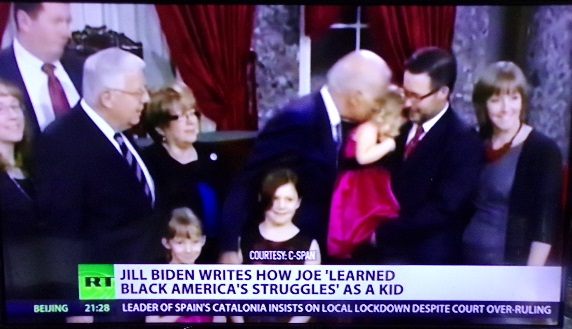
It is hard to give up something you claim you never had. That is the difficulty Americans face with respect to their country’s empire. Since the era of Theodore Roosevelt, politicians, journalists, and even some historians have deployed euphemisms—“expansionism,” “the large policy,” “internationalism,” “global leadership”—to disguise America’s imperial ambitions. According to the exceptionalist creed embraced by both political parties and most of the press, imperialism was a European venture that involved seizing territories, extracting their resources, and dominating their (invariably dark-skinned) populations.
Americans, we have been told, do things differently: they bestow self-determination on backward peoples who yearn for it. The refusal to acknowledge that Americans have pursued their own version of empire—with the same self-deceiving hubris as Europeans—makes it hard to see that the US empire might (like the others) have a limited lifespan. All empires eventually end, but maybe an exceptional force for global good could last forever—or so its champions seem to believe.
The refusal to contemplate the scaling back of empire shuts down what ought to be our most urgent foreign policy debate before it has even begun. That is why these two new books are so necessary, and so welcome: they are the most serious efforts since Chalmers Johnson’s Blowback series (2004–2010) to reopen the question of American empire by taking for granted that it exists. Victor Bulmer-Thomas’s Empire in Retreat maintains that America has harbored imperial ambitions since its founding, and argues that its focus shifted in the twentieth century, from acquiring territory to penetrating foreign countries and influencing their governments to support US strategic and economic interests. David Hendrickson’s Republic in Peril sees that shift as the result of a decisive embrace of interventionism, aimed at extending US power throughout the world.
Both authors think withdrawal from overextended military commitments could strengthen America. Bulmer-Thomas, a British diplomat and scholar, recommends it as a pragmatic adjustment to shrinking support for US empire at home and abroad. Hendrickson, a political scientist at Colorado College, provides a theoretical rationale for it, exploring the possibility of what he calls a new internationalism, based on respect for the sovereignty of other nations. Yet even as they catalog the many signs of imperial decline (economic, political, cultural), neither is sanguine that American policymakers can manage a graceful retreat.
Bulmer-Thomas begins by recounting the rise of the US territorial empire. He shows that America’s relationship with the land it acquired during westward expansion resembled the relationship between European countries and their colonies abroad. The United States, like European colonial powers, subjugated (and nearly exterminated) aboriginal populations; used military occupation as a buffer between white settlers and rebellious natives; and established only limited representative governments in their occupied territories. One resident of America’s territories complained that they were treated like “mere colonies, occupying much the same relation to the General Government as the colonies did to the British government prior to the Revolution.”
Most textbooks date the beginning of America’s overseas expansion to 1898, when it acquired sovereignty over Cuba, Guam, Puerto Rico, and the Philippines after the conclusion of its war with Spain. Yet as Bulmer-Thomas shows, the US empire went offshore much earlier. During the 1810s and 1820s, Americans carved out the state of Liberia in West Africa, allegedly as a refuge for free American blacks; the country in fact functioned as an American colony and later as a protectorate of the Firestone Rubber Company. The US established an imperial presence in East Asia as early as 1844, when the Treaty of Wanghia gave it the same privileged access to Chinese ports as the British Empire, and went on to acquire dozens of “guano islands” in the Pacific, where abundant bird droppings provided a rich source of fertilizer.
During the 1890s, the American zeal for distant acquisitions slipped into high gear, as politicians realized they were arriving late to the imperial game. Led by Theodore Roosevelt and other advocates of expansion, they sought land through annexation and collaboration with American business interests (Hawaii) as well as through war with Spain. These acquisitions began as additions to the territorial empire but gradually acquired a more ambiguous character. They came to form the foundation of what Bulmer-Thomas calls America’s “semi-global empire,” built not on territorial acquisition but on the maintenance of client states and various other forms of international interference, including military bases that supported occasional armed interventions in local conflicts and multinational corporations run mostly by Americans.
The Philippines offers a case in point of America’s nonterritorial form of empire. The US declared war on Spain in 1898 with the avowed intention of ending Spanish rule in Cuba, but even before the declaration President William McKinley had dispatched the US Asiatic Squadron under Commodore George Dewey to Hong Kong in preparation for an assault on the Spanish fleet in Manila Bay. As soon as war was declared, Dewey moved quickly and crushed the Spanish forces. Their surrender emboldened the Filipino rebels, who erroneously assumed that the US had arrived to liberate them from their Spanish oppressors. The US military quickly disabused them of that delusion by embarking on a ferocious counterinsurgency campaign, which lasted for years and included the systematic torture and slaughter of Filipinos. As many as 250,000 died, but the US imperialists never doubted the sanctity of their cause. “Nothing can be more preposterous than the proposition that these men were entitled to receive from us sovereignty over the entire country which we were invading,” Secretary of War Elihu Root said in 1900 about the Filipino rebels. “As well the friendly Indians, who have helped us in our Indian wars, might have claimed the sovereignty of the West.”
Statehood was never considered during the debate over the Philippines: the only question was whether to establish a naval base at Manila and give the islands back to the Spanish or to annex the entire archipelago. The imperialists won the argument, and after the insurgents were finally suppressed the Philippines became a colony, from which investors in sugar, hemp, tobacco, and coconut oil could gain privileged access to US markets and Filipinos could emigrate to America in search of jobs. By the 1930s, congressional opposition to cheap exports as well as to cheap (and nonwhite) labor created support for Philippine independence, which was finally achieved in 1946. But it came with so many restrictions on trade and so much preferential treatment for American investors—not to mention continued maintenance of US military bases—that “it would be more accurate to describe the Philippines as becoming a US protectorate,” Bulmer-Thomas writes. “Thus, the end of colonialism in the Philippines did not mean the end of US imperial control.”
A similar pattern of indirect imperial control also applied to Central America and the Caribbean. The US dominated that region during the twentieth century through colonies (Puerto Rico, the Virgin Islands, the Panama Canal Zone), but more broadly by using its economic influence to interfere in domestic politics and maintain governments that would faithfully serve American interests (as was the case in Cuba until 1959), or by establishing asymmetrical bilateral treaties and customs receiverships—the collection of customs duties by US officials, who then used the money to pay off the debt service owed on American loans. This arrangement survived in the Dominican Republic until 1942 and in Haiti until 1947.
Military interventions underwrote economic domination. Sometimes this involved sending in the US Marines and leaving them in place for decades, as in Haiti from 1915 to 1934. Sometimes it required using military force to crush a rebellion and arranging for the emergence of a cooperative dictator, such as Rafael Trujillo in the Dominican Republic, whose brutalities the Americans tolerated as long as he respected US strategic interests in the region. This he did for thirty years, until his attempt in 1960 to overthrow the Venezuelan government cost him US support. Sensing an opportunity, his opponents assassinated him. But the US was still committed to maintaining the imperial relationship, and President Lyndon Johnson sent in the Marines in 1965 to prevent the left-of-center president Juan Bosch (who had been ousted by a military coup) from returning to power.
Johnson’s intervention recalled the conflicts of the early twentieth century, but during World War II and the cold war, US imperial strategies had begun to shift. As the USSR consolidated its power, the US scaled back its pursuit of territory abroad. Instead, it extended its imperial reach through the development of international institutions that would serve its interests but could not also be used against it. At Bretton Woods in 1944, the US initiated the creation of the IMF and the World Bank. Both institutions are headquartered in Washington, and the president of the World Bank has always been an American, by custom if not fiat.
The Point Four Program, drawn from Harry Truman’s inaugural address in 1949, linked the World Bank to the struggle with the Soviet Union for influence in the developing world, where the bank would make loans, with many political conditions attached, to governments and state-owned enterprises (later privately owned ones as well). The requirement that Congress approve these loans ensured that they would reflect what the US government considered its national interest. The United Nations, too, began as an American-dominated institution, though as its membership grew it became progressively harder for the US to control. The North Atlantic Treaty Organization, Southeast Asia Treaty Organization, and bilateral treaties worldwide also served American policy under the guise of “collective security” against the Soviet threat.
All these arrangements were fortified by the principle articulated in the Truman Doctrine of 1947—that aggression must be stopped everywhere. Such a commitment “assumes that foreign conflicts feature evil aggressors and innocent victims,” as Hendrickson writes. This unexamined assumption was endorsed and promoted by leaders from both political parties, who helped sustain an atmosphere of perpetual moral crisis during the cold war. The US, working through the CIA, helped to overthrow elected left-leaning governments in Iran, Guatemala, Congo, Brazil, and Chile. Interventions anywhere could always be rationalized as counterinterventions against the allegedly omnipresent Soviet threat.
When the cold war ended, the US’s geopolitical rationale for military interventionism—the need to contain communism—swiftly disappeared, as the country found itself in the heady position of being the world’s sole superpower. This was what is now viewed, with some nostalgia, as the unipolar moment. And yet even in the absence of its longtime ideological rival, the United States continued to conduct foreign policy with the same moral fervor that had informed its actions in the cold war, and with the same confidence that it was a force for global good.
Under the presidency of Bill Clinton, much of official Washington began to believe “that US empire would best be served by the promotion of democracy abroad—or at least an American version of democracy—on the grounds that US security, free market economies and democracies are mutually reenforcing,” as Bulmer-Thomas writes. The rationale for democracy promotion, in the words of Clinton’s first National Security Strategy, was that “democratic states are less likely to threaten our interests and more likely to cooperate with the US to meet security threats and promote sustainable development.” This formulation could work in some circumstances, but not all. Other nations could have good reasons to see democracy promotion as a form of aggression, as Russia did when Clinton sought to expand NATO eastward despite the promises made by his predecessors in the first Bush administration and the warnings of many seasoned diplomats, led by George Kennan.
Establishing “US hegemony across the globe,” in Bulmer-Thomas’s words, was not only about promoting democracy abroad but also about maintaining military supremacy everywhere. In 2000, despite cuts in personnel and the closure of many US bases, the Defense Department committed itself to the pursuit of “full spectrum dominance.” This goal, outlined in Joint Vision 2020, the Department of Defense’s blueprint for the future, meant the worldwide control of land, sea, air, and space, including cyberspace.
The triumphalist mood following the end of the cold war also emboldened neoconservative ideologues. Two of them, William Kristol and Robert Kagan, founded the Project for the New American Century in 1997. Its “Statement of Principles” pledged to “rally support for American global leadership” through “a Reaganite policy of military strength and moral clarity.” This was nothing if not an exceptionalist, even unilateralist creed, based on faith in the uniqueness of America’s position as a global leader. It evoked Secretary of State Madeleine Albright’s claim that the US was “the indispensable nation.”
The neoconservatives found their president in George W. Bush. Even before the terrorist attacks of September 11, 2001, Bush began to implement neoconservative policies, withdrawing from international organizations and agreements—including (in June 2002) the Anti-Ballistic Missile Treaty with Russia. This decision, according to Ivo Daalder of the Brookings Institution and other critics at the time, signaled a swerve in US nuclear strategy from deterrence to “war-fighting.”
The terrorist attacks on the World Trade Center and Pentagon provided a new enemy, international terrorism, that was even more shadowy and elusive than international communism had been. Widespread panic among Americans and their allies was taken (especially in the US) to justify a permanent state of emergency, with damaging consequences for civil liberties and public debate at home, as well as for the many thousands of civilians who would become “collateral damage” in Iraq and Afghanistan.
After September 11, new rationales for military intervention abroad emerged—not only preventative war against terror (the false justification for invading Iraq) but also R2P (the Responsibility to Protect). As Hendrickson shows, R2P originated in the recommendation of a Canadian government commission and received a modified but contested acceptance by the UN in 2005. R2P provides a virtually blank check for using force on humanitarian grounds—an idea that has little support from non-Western nations. In practice it vitiates a central assumption of international law—that each state has the right to defend itself. In his second inaugural address, Bush spelled out the vision of universal empire behind R2P: “The best hope for peace in our world is the expansion of freedom in all the world.” This was the Truman Doctrine on steroids.
Hendrickson thinks American disregard for international law helps explain the incoherence of contemporary strategic thought. According to exceptionalist ideology, the US is the primary guardian of international law, on which global stability depends. Yet Hendrickson (like Bulmer-Thomas) makes clear that more often than not, the putative rule-maker has in fact broken rules and acted in ways that it would not tolerate from any other nation.
The American exceptionalist double standard is especially apparent in its current military operations overseas. Consider the battle-ready presence of the US Navy in the South China Sea. Imagine a rival power behaving as aggressively in the Caribbean, lecturing us on our misdeeds (as we have lectured the Chinese) and appointing itself a neutral umpire for the region. A retired Chinese admiral, quoted by Hendrickson, puts the matter succinctly: the US Navy in East Asia is like “a man with a criminal record ‘wandering just outside the gates of a family home.’”
Or take the confrontation emerging on the western border of Russia. The missile defense system installed by NATO on Russia’s doorstep, combined with NATO troops conducting military exercises, could not be more provocative. No great power, least of all the United States, would allow deployments so close to its borders without protest and (probably) retaliation.
While Bulmer-Thomas treats imperial expansion as a continuous feature of American history that has run afoul of historical circumstance, Hendrickson reconstructs an anti-imperial tradition in Anglophone thought, which he calls “liberal pluralism” and recommends reviving in view of our crumbling American empire. In his view, liberal pluralism was embodied in the system of European nation-states (the “Westphalian system”) that emerged from the Thirty Years’ War. It was also the worldview of America’s founders, uniting Washington, Jefferson, Hamilton, and Madison in their suspicion of military adventures abroad. From the liberal pluralist perspective, war is the summum malum of international affairs; respect for the sovereignty of other nations is the best way to avoid it. Sovereignty is the core of international law: every state has the right to defend itself from external attack; none has the right to interfere in the internal affairs of another.
The fact that liberal pluralism discourages interference does not, however, imply that it encourages nations to be passive bystanders in the face of immoral foreign policies, as contemporary political theorists who favor an interventionist approach like to claim. Liberal pluralism “does not,” Hendrickson insists, “dictate indifference to human rights”; it allows states to shelter dissidents and welcome refugees from oppression. “What it does not allow is coercive intervention in a foreign country to secure those rights.”
Hendrickson concentrates his criticisms on the reckless use of military force in foreign lands; he does not dismiss economic sanctions as an alternative. Nor does he rule out interference in extreme situations, such as the threat of genocide. But he insists that such interventions be—as far as possible—multilateral, peaceful, and respectful of international law. He proposes maintaining NATO, but with our nuclear guarantees to its members on a strictly “no-first-use” basis; preserving friendships with allies but also working out “rules of the road with putative adversaries.” He argues that fighting terrorism requires effective policing at home and the support of functioning governments abroad, not their overthrow. The liberal pluralist tradition, in his view, provides intellectual resources for reducing international tension and redirecting national wealth toward urgently necessary aims—rebuilding infrastructure, reviving the welfare state, and addressing the menace of climate change and oceanic catastrophe.
In recent years, popular support for imperial adventures has waned. Large majorities have opposed sending US troops to Libya, Syria, and Ukraine. The percentage of Americans who think it is “very important” that the US should “maintain superior military power worldwide” dropped from 68 percent in 2002 to 52 percent in 2014. And poll respondents ranked military supremacy sixth out of ten among foreign policy aims. The top-ranked goal was “protecting the jobs of American workers.”
The shift in public opinion is a response to a series of failed interventions: efforts at regime change in Iraq, Libya, and Syria have left behind chaos, failed states, terrorist recruits, and endless war. But whatever disagreements they may have had over policy details, all three presidents since September 11 have shared a commitment to US global military supremacy. No major policymaker wants to admit publicly what many suspect privately: that America’s imperial reach has begun to exceed its grasp. Barring a dramatic shift in public discourse, the American empire will not go gentle into that good night; more likely it will, as Dylan Thomas counseled the old, “burn and rave at close of day.”
No one burns and raves more flagrantly than Donald Trump. The failure of blank-check interventions fed the discontent he exploited in the 2016 campaign. Yet his chauvinist posturing has turned out to be little more than a belligerent, unhinged version of the militarized globalism he claimed to displace. So Trump lurches from one outrageous provocation to another while most of his critics repeat the stale formulas of global leadership. Neither side seems to notice that the rest of the world does not want to be led (though some countries may still want their security to be guaranteed by US power). More and more foreign countries are trying to go about their business on their own, even in areas once assumed to be vital to the US national interest—Latin America, the Middle East, the South China Sea, even the Korean peninsula, where the South Koreans have done what American leaders were unable or unwilling to do: initiate diplomacy with North Korea.
Other pillars of American power are also crumbling, as Bulmer-Thomas demonstrates in detail. Multinational corporations are no longer as dependent on American policies abroad for access to foreign markets; General Motors, for example, now sells more cars in China than anywhere else on earth, without benefit of a US presence there. Recent years have seen a steady fall in the US net investment ratio (gross investment less the consumption of fixed capital), both private and public. The consequence has been a decline in infrastructure (including public education), as well as a slowing of innovation and productivity. At the same time, neoliberal politicians in both parties, committed to cutting back the “entitlements” provided by the welfare state and privatizing the public sector, have underwritten the rise of inequality and social immobility. The effect has been to undermine the broad prosperity that was the domestic basis of the semi-global empire.
International institutions, rather than reinforcing American hegemony, challenge it. The UN, the IMF, and the World Bank have all proven unreliable in promoting US interests. At the UN, the US is more isolated than ever on the Security Council, as the dramatic increase in American vetoes shows. Various countries have learned to avoid borrowing from the IMF, with the onerous conditions it imposes, by building up their foreign exchange reserves and paying off existing debts. The World Bank now has two significant rivals, the Asian Infrastructure Investment Bank and the New Development Bank (which represents the BRICS countries: Brazil, Russia, India, China, and South Africa). The Organization of American States has been superseded, since 2011, by the Community of Latin American and Caribbean States, which insisted on the inclusion of Cuba despite US opposition. China is creating its own version of the Trans-Pacific Partnership without US participation, as well as expanding into sub-Saharan Africa and cutting a deal with Nicaragua for another isthmian canal.
Yet Trump and his opponents in the Washington consensus still envision a unipolar world, where the United States can ignore the legitimate claims of rival nations and do pretty much whatever it wants, whether because of its sheer greatness (Trump) or its exceptional goodness (Clinton et al.). Obama was cautious about intervening in Syria and eager to negotiate with Iran, but his administration maintained or intensified commitments to global military supremacy, blanket surveillance, targeted drone assassinations, and modernization of nuclear weapons, as well as engagement in the Middle East and East Asia. Fundamental policies persisted despite Obama’s misgivings.
Neither Bulmer-Thomas nor Hendrickson believes these policies can continue without catastrophe. And it might, in any case, not be in the US’s interests for them to continue. As Bulmer-Thomas reminds us, “Imperial retreat is not the same as national decline, as many other countries can attest. Indeed, imperial retreat can strengthen the nation-state just as imperial expansion can weaken it.” Yet as Hendrickson concludes, “It is crystal clear that the empire is fully determined to stick around,” despite our desperate need to dismantle it. The drift of global events may eventually require the United States to acknowledge the reality of a multipolar world, but we cannot assume that the process will be peaceful. Still, Hendrickson has performed an urgently necessary service in reconstructing the liberal pluralist tradition. He reminds us that there is a humane alternative to contemporary orthodoxy, if we can only recognize it.
Jackson Lears is Board of Governors Distinguished Professor of History at Rutgers, Editor in Chief of Raritan, and the author of “Rebirth of a Nation: The Making of Modern America, 1877–1920,” among other books.
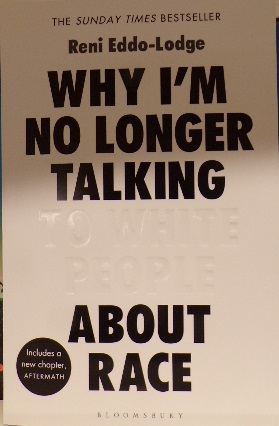
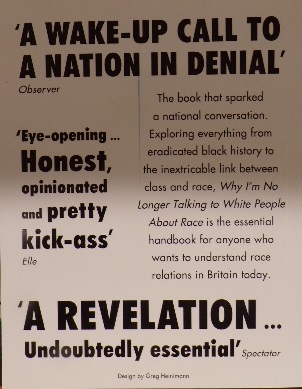
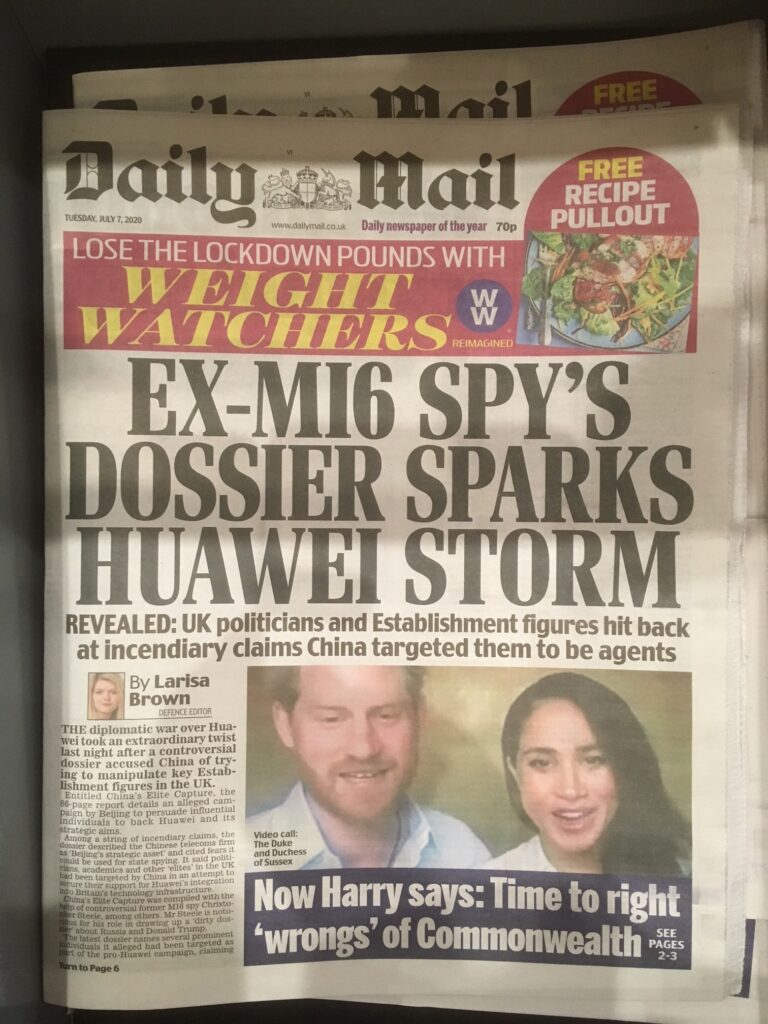

Look at all that sexy shop window art to excite bedroom passion, maybe get you in the mood to make another street cred Prince like little Archie..
Image Appldene Photographics/RJC
So Hard Being A Posh Woman
July 11th 2020
Bridget Jones’s creator Helen Fielding is now shocked by the sexism her character faced, the writer has revealed. Looking back 25 years, Fielding said she would not be able to write the story now. Watching the hit film of her first book recently with her children, she was “staggered”.
“The level of sexism that Bridget was dealing with, the hand on the bum in so many of the scenes,” made it “quite shocking for me to see how things have changed since then”, Fielding told Desert Island Discs’ host, Lauren Laverne, Fielding added that she was particularly struck by a scene in which Bridget’s fictional boss demands “a shot of the boobs”.
Seeing old attitudes that were “just part and parcel of her life” depicted on screen again was alarming, she said, although her heroine, played by Renee Zellweger on screen, is not a passive victim. “In the end she turned around and stuck it to them.”
Fielding, who co-wrote the screenplay for the film with the director Richard Curtis and writer Andrew Davies, said she remains grateful to Bridget Jones and is happy that young girls still enjoy the book, which was based on the popular comic newspaper columns Fielding wrote in the 1990s.
The writer also revealed that many of her past boyfriends and associates believe themselves to be the inspiration for rival male characters in the book, played on screen by Hugh Grant and Colin Firth.
“It is amazing the number of people that lay claim to being Daniel or Mark, including Keir Starmer,” said Fielding, who studied English at Oxford and grew up in West Yorkshire, the daughter of a mill manager. Starmer has recently said he knows nothing of the rumour that he was a prototype for Firth’s principled character, Mark Darcy.
Comment Only 5- 5.5 % of the working population have jobs in the creative industry, media etc. Most of these, like Helen Fielding are from the upper middle classes – many Oxbridge educated like her. The industry is owned and controlled by big money or the State – i.e BBC and Channel 4. The agenda is very antit white working class male, and obsessed with feminism and anti racism – e,g BLM.
Programming and print media represents this bias. Hence the intense media manipulation of the PC agenda in this era of feminism, ‘Me Too’ , women never lie, all whites ( working class ) are racists, women who don’t openly scream against racism are ‘Karens’. There is no effort to depict the agonies, conflicts, miseries and unpalatable manifestations of the underclass that I grew up in.
Acceptable writers are ‘nice’ people with the right vews. Their purpose is not to enlighten. Their purpose is to judge, apportion blame and guilt. They never talk about class, because people like Fielding are privilged upper middle class, with no right to speak about everyday women’s lives You are not supposed to notice , let alone say it.
There are also lots of privileged blacks who control Africa for their own and own family advnatage. You are not supposed to say that either – their ancestors captured ‘fellow blacks’ imprisoned and sold them to white slave traders for around 300 years. Those chiefdoms only stopped selling their ‘fellows’ because the White British Elite banned it in 1833 – William Wilberforce’s Act. The elite, including Fielding are in hyper drive, using racism and sexism as sticks to beat down the white under class who keep showing signs of getting uppity.
By the way, I have seen all the Bridget Jones films. They were very funny, romantic and full of hope. I even read one of the books. I am sorry Fielding has taken the shine off of them for me now. I won’t watch them again. Feminism, as far as I am concerned is, a vile exclusive elitist dogma. Its bigotry has caused a great deal of injustice, broken homes, failed one parents families, gender confusion, and career obsession which often ends up in loneliness.
It is part of the greed culture, fixated on body parts, c;lothing, shoes, make up, perfume, hair does, stabbing people in the back, and blaming others if you don’t make the top rung. And women most certainly use feminine ploys and sex to get where they want to be. They are incredible liars and have an equal capacity for violence – greater if one includes verbal. But of course nothing is ever a woman’s fault, and their are lots of Fieldings to make sure a man never forgets this – beware, divorces are expensive and can destroy your kids. The more I think about it. I realise that Fielding’s book is upper middle class bullsh-t. Obviously she will do her best to build on it. Robert Cook

When Did Americans Lose Their British Accents? Posted July 8th 2020
The absence of audio recording technology makes “when” a tough question to answer. But there are some theories as to “why.”
- Matt Soniak

Photo from Getty Images.
There are many, many evolving regional British and American accents, so the terms “British accent” and “American accent” are gross oversimplifications. What a lot of Americans think of as the typical “British accent” is what’s called standardized Received Pronunciation (RP), also known as Public School English or BBC English. What most people think of as an “American accent,” or most Americans think of as “no accent,” is the General American (GenAm) accent, sometimes called a “newscaster accent” or “Network English.” Because this is a blog post and not a book, we’ll focus on these two general sounds for now and leave the regional accents for another time.
English colonists established their first permanent settlement in the New World at Jamestown, Virginia, in 1607, sounding very much like their countrymen back home. By the time we had recordings of both Americans and Brits some three centuries later (the first audio recording of a human voice was made in 1860), the sounds of English as spoken in the Old World and New World were very different. We’re looking at a silent gap of some 300 years, so we can’t say exactly when Americans first started to sound noticeably different from the British.
As for the “why,” though, one big factor in the divergence of the accents is rhotacism. The General American accent is rhotic and speakers pronounce the r in words such as hard. The BBC-type British accent is non-rhotic, and speakers don’t pronounce the r, leaving hard sounding more like hahd. Before and during the American Revolution, the English, both in England and in the colonies, mostly spoke with a rhotic accent. We don’t know much more about said accent, though. Various claims about the accents of the Appalachian Mountains, the Outer Banks, the Tidewater region and Virginia’s Tangier Island sounding like an uncorrupted Elizabethan-era English accent have been busted as myths by linguists.
Talk This Way
Around the turn of the 18th 19th century, not long after the revolution, non-rhotic speech took off in southern England, especially among the upper and upper-middle classes. It was a signifier of class and status. This posh accent was standardized as Received Pronunciation and taught widely by pronunciation tutors to people who wanted to learn to speak fashionably. Because the Received Pronunciation accent was regionally “neutral” and easy to understand, it spread across England and the empire through the armed forces, the civil service and, later, the BBC.
Across the pond, many former colonists also adopted and imitated Received Pronunciation to show off their status. This happened especially in the port cities that still had close trading ties with England — Boston, Richmond, Charleston, and Savannah. From the Southeastern coast, the RP sound spread through much of the South along with plantation culture and wealth.
After industrialization and the Civil War and well into the 20th century, political and economic power largely passed from the port cities and cotton regions to the manufacturing hubs of the Mid Atlantic and Midwest — New York, Philadelphia, Pittsburgh, Cleveland, Chicago, Detroit, etc. The British elite had much less cultural and linguistic influence in these places, which were mostly populated by the Scots-Irish and other settlers from Northern Britain, and rhotic English was still spoken there. As industrialists in these cities became the self-made economic and political elites of the Industrial Era, Received Pronunciation lost its status and fizzled out in the U.S. The prevalent accent in the Rust Belt, though, got dubbed General American and spread across the states just as RP had in Britain.
Of course, with the speed that language changes, a General American accent is now hard to find in much of this region, with New York, Philadelphia, Pittsburgh, and Chicago developing their own unique accents, and GenAm now considered generally confined to a small section of the Midwest.
As mentioned above, there are regional exceptions to both these general American and British sounds. Some of the accents of southeastern England, plus the accents of Scotland and Ireland, are rhotic. Some areas of the American Southeast, plus Boston, are non-rhotic.
Matt Soniak is a long-time mental_floss regular and writes about science, history, etymology and Bruce Springsteen for both the website and the print magazine. His work has also appeared in print and online for Men’s Health, Scientific American, The Atlantic, Philly.com and others. He tweets as @mattsoniak and blogs about animal behavior at mattsoniak.com.
Advertisement
More from Mental Floss
- ‘Friend Books’ Were the Facebook of the 16th Century47 saves
- Why Do People Say “Jesus H. Christ,” and Where Did the “H” Come From?536 saves
- 11 Misconceptions About Ancient Rome, Debunked265 saves
Advertisement

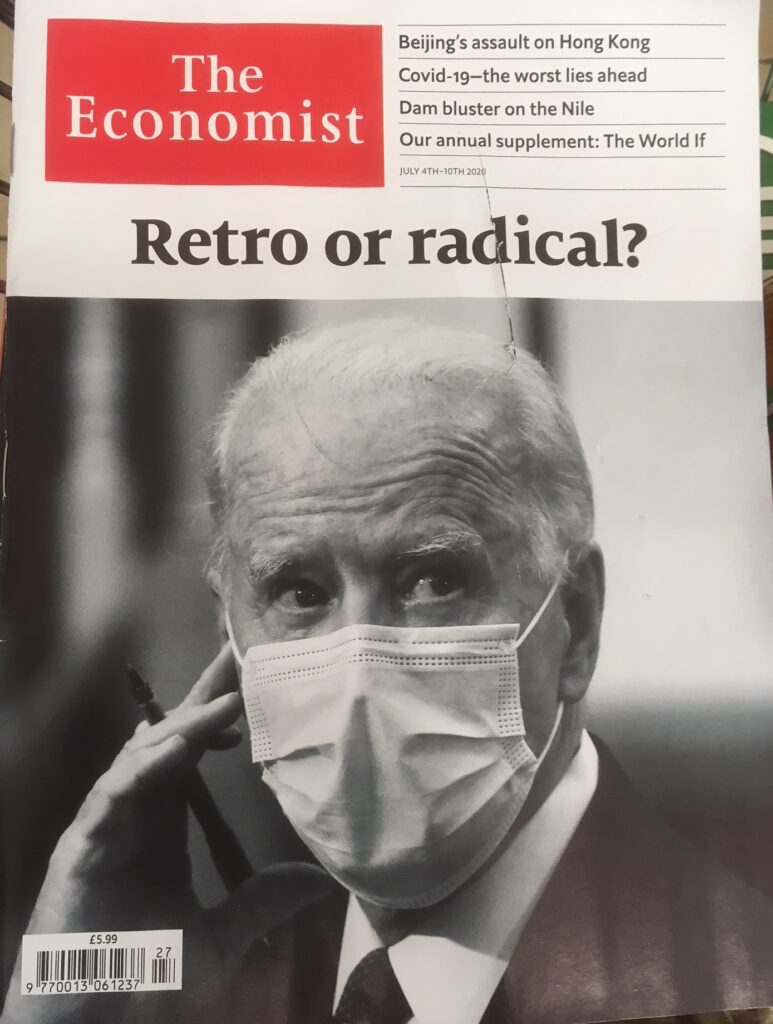
Myth of White Male Privilege Posted July 2nd 2020
How’s this for dark irony: throughout 2015, ‘white male privilege’ was the buzzphrase on every rad tweeter and liberal hack’s lips, as they fumed against the easy, pampered lives allegedly enjoyed by human beings who had the fortune to be born with a penis and pale skin. Railing against ‘white men’ and their cushy existences has become the stock-in-trade of many feminists.
Yet towards the end of 2015 it was revealed that there’s a social group in Britain more derided and less successful than pretty much every other social group. Guess who? Yep, young white men. Especially young working-class white men. A large sector of the group that the new identity-politics mob loves to ridicule for sailing through life unmolested and unchallenged is actually having a rough time.
Consider this: 18-year-old women are 35 percent more likely to attend university than 18-year-old men; and where 37 percent of black school-leavers go to university, only 28 percent of white school-leavers do. These stats were unveiled by UCAS in December, leading its chief executive to wonder if it isn’t time to initiate ‘outreach’ projects designed to get more white blokes into college.
Also in December, a YouGov analysis of 48 surveys of public attitudes found that young white men are viewed as ‘the worst ethnic, gender [and] age group’. They are ‘the most derided ethnic group in Britain’. YouGov’s number-crunchers confessed to being surprised by ‘the lousy reputation of young white men’, who are seen as drunken, promiscuous, prone to drug-taking, work-shy and impolite (even as other surveys reveal that today’s yoof actually drink less and do fewer drugs than earlier generations did).
What’s more, young women now earn more than young men: £1,111 a year more, to be precise. Between the ages of 22 and 29, women in general — covering all races — out-earn guys; by the time women hit their thirties, however, their pay falls below men’s. Those young, opinionated new media feminists who get handsome advances to write books spluttering about ‘white male privilege’ are far more privileged than many of the white males they splutter about — especially the ones who empty their bins or sweep their roads. It’s almost Orwellian in its topsy-turviness — the most well-connected, middle-class women denouncing the alleged privileges of some of the most derided people in society.
Partly this is just bad science: feminists, leftists and others see that parliament and the boardroom still have a hefty number of white men in them and they extrapolate from this to argue that all white men must have lovely lives. Hence they always use the ridiculously sweeping terms ‘white men’ or ‘male privilege’, as if whiteness and maleness were inherently beneficial. As if loads of white men aren’t dirt poor and awfully underprivileged. It’s like seeing the Queen and thinking: ‘Wow, white women in Britain have it good, don’t they?’
But there’s something else going on too, something more pernicious: the way the politics of identity elbows aside anything to do with class. Unlike radicals of old, the new identitarians — from feminists to shouty students — do not see the world in terms of the haves and have nots, or the ruling class and the working class; in terms of work or wealth or clout. No, to them it’s all about biology, race, gender: fixed traits, which they think define us as individuals and determine our destinies.
Such ugly, racial determinism is why they can use the blanket, dehumanising term ‘white people’ to refer to a vast group that contains all sorts of social classes and people: rich, poor, middling, left, right, good, bad, happy, sad, etc. The idea that all white men have a certain kind of life or outlook is as dumb, and foul, as saying all black men are criminals.Get Lionel Shriver’s new book in hardbackWhen you subscribe for just £1 a week
Identity politics doesn’t totally smother class considerations, however; it helps to facilitate a new, PC version of class hatred. The bile spat by feminists and others at certain white men — the uncouth, most derided ones — is really old-fashioned loathing for the lower orders dolled up as a radical stand against ‘male privilege’. When university students or media-based identity obsessives crow about drinking ‘white male tears’, they behave like modern-day Marie Antoinettes, laughing in the face of the less fortunate who will never experience the privileges enjoyed by these fashionable railers against privilege. ‘White male privilege’ is simply a myth.Written byBrendan O’Neill
Brendan O’Neill is the editor of Spiked and a columnist for The Australian and The Big Issue.
Playing behind closed doors could make the Premier League fairer May 7th 2020
Research shows the massive influence home crowds can have on players and referees – finishing the season behind closed doors could be a boon for smaller clubs
Football fans have always been convinced that referees are biased against their team, and for a while, they were actually right. In the years after the Second World War, teams in England were significantly more likely to lose when playing away, due largely – it’s thought – to the influence of the boisterous home support on the decision making of the officials.
This home advantage still exists across a range of sports – it’s around 60 per cent in football and baseball, and around 70 per cent in basketball. But, according to Alan Nevill, a professor in sport at Wolverhampton University, its effects have diminished considerably over the years. It was as high as the equivalent of an extra goal a game in the post-war years, but now stands at around half that.
That’s still enough to potentially play an important role in the remainder of the Premier League season, which could resume behind closed doors under plans being discussed by the division’s clubs. Playing games without crowds seems almost certain to go ahead, and there have been proposals to use neutral venues to minimise the risk of spreading coronavirus further. It’s even been suggested that the entirety of next season could be played with no supporters, with restrictions on mass gatherings unlikely to be lifted for some time.
Some clubs and fans have argued that the proposals for playing without fans risk threatening the integrity of the competition, which is usually balanced by teams playing each other home and away over the course of the season. But sports science research suggests that playing behind closed doors could help level the playing field, by reducing refereeing bias, and helping players perform to their best.
“In my research we find that the home advantage still exists, even if there is no crowd,” says Niels van de Ven, an associate professor at Tilburg University. In 2011, he analysed games between teams who share a stadium – such as Inter and AC Milan – to control for the impact of the physical setting. “In games in which both teams are equally familiar with the stadium (they share it) there is no home advantage,” he says. “All in all, this seems to suggest that familiarity with the stadium (the pitch specifics, but also the ease of your experienced routine) is more important for the home advantage than the crowd is.”
However, more recent research on a wider set of games has found the opposite effect. In 2014, researchers Michela Ponzo and Vincenza Scoppo found that even when teams shared a stadium, the “home” teams scored 0.45 goals more than the visitors, and were about 13 per cent more likely to win.
Harvard researchers looking at Premier League games have found that home teams scored an extra 0.1 goals on average for every 10,000 extra fans in attendance. This, they argue, was largely due to the crowd’s influence on referees, who were more likely to give red cards to the away team, and penalties to the hosts. “It’s difficult to say, and almost impossible to prove, but based on my research I would say that more than half of the home advantage comes from the crowd and the possibility of the crowd influencing the referees,” says Nevill.
His own research has demonstrated the effect that crowd noise can have on officials. In 2002, he carried out a study where 40 qualified referees were asked to assess recordings of various tackles, either with or without background noise. He found that the background noise made referees more uncertain, and less likely to award fouls against the home team. (He argues that VAR reviews should always be played back without sound to minimise this source of interference.)
So, a lack of crowds could actually lead to fairer outcomes for the teams that would have been playing away against sides with larger grounds – although obviously not all sides will benefit equally, as the CEO of relegation-threatened Brighton and Hove Albion, who play at the Amex Stadium, was quick to point out recently. “Five of our nine remaining matches due to be played at the Amex – all five matches are very difficult but four are against some of the biggest clubs in European football,” Paul Barber said. “The disadvantages of us not playing the league’s top teams in our home stadium and in familiar surroundings, even with 27,000 Albion fans very unlikely to be present at the Amex, are very obvious.”
But when it comes to those high-pressure games at the end of the season, there’s some evidence that a lack of supporters could actually make teams play better. In the 1980s, psychologist Roy Baumeister and colleagues analysed the Major League Baseball archives. They looked at championship games, which are played as a series of up to seven matches split home and away – the winners being the first to reach four wins. Baumeister found that the home team lost almost two-thirds of the time when they were one victory from clinching the series. Similar effects have been observed with golfers playing on their home course, and ice hockey teams vying for the Stanley Cup in front of their own fans.
In a series of lab experiments using video games, Baumeister also discovered that performance deteriorates rapidly if someone is watching. Players often report feeling pumped up by the roar of the home fans, but sometimes too much adrenaline can be a bad thing – as evidenced particularly by Brazil’s 7-1 defeat to Germany at home in the semi-finals of the 2014 World Cup.
Research in junior ice hockey players has found lower levels of cortisol – a stress hormone that has been linked to poor athletic performance – before away games than before home games, where they feel pressure to perform in front of friends and family. Cortisol triggers the fight, flight or freeze response, which can cause athletes to choke under pressure by causing them to pay too much attention to the automatic skills they’ve spent years developing.
Even if playing without fans leads to better player performances and refereeing decisions, that’s still a problem, because teams will end up playing an uneven number of games in front of their home fans, and so they’ll lose out on the home advantage (or gain from the lack of pressure) to varying degrees.
In the tense, nervy ending to a normal league season, home fans can sometimes be a source of stress as well as support. Finishing the Premier League behind closed doors will have a massive impact on the outcome, but perhaps not for the reasons fans might think.
Amit Katwala is WIRED’s culture editor. He tweets from @amitkatwala
Sultans of Swing – Best Live Version – YouTube
www.youtube.com/watch?v=pw_2PQhxMos
26/12/2010 · Mark Kopfler at his best. Legendary version from the 1988 “Sultans of Swing – Very Best of” CD. This live version can be found in the Special Edition Bonus CD.
- Gordon Lightfoot Sundown – Video Results
- 3:41Gordon Lightfoot Sundownyoutube.com
- Gordon Lightfoot – Sundown {HD} – YouTube www.youtube.com/watch?v=K7NMvpZ3PM0 04/04/2017 · “Sundown” is a song by Canadian folk artist Gordon Lightfoot, from the eponymous album, released as a single in March 1974. “Sundown” reached number one on the U.S. Billboard Hot 100 and easy …
- Gordon Lightfoot 1974 – Sundown – YouTube www.youtube.com/watch?v=MOOs-MqDOI0 19/10/2007 · 50+ videos Play all Mix – Gordon Lightfoot 1974 – Sundown YouTube Gordon Lightfoot – Wreck of the Edmund Fitzgerald – Duration: 6:54. RockandRollRevised 1,734,499 views
- Gordon Lightfoot – Sundown (Official Audio) – YouTube www.youtube.com/watch?v=1IBdZ645S-o 28/04/2019 · You’re listening to the official audio for Gordon Lightfoot – “Sundown” from his album of the same name. “Sundown” was Lightfoot‘s only single to reach No. 1 on the Billboard Hot 100 (1974).
- Gordon Lightfoot – Sundown (video/audio edited & restored … www.youtube.com/watch?v=De0RmykfzgU 06/05/2017 · 50+ videos Play all Mix – Gordon Lightfoot – Sundown (video/audio edited & restored) GQ/HD YouTube End Of The Line – Traveling Wilburys – 1080 – FULL EXTENDED VIDEO & AUDIO VERSION. – Duration: 5:35.
- Gordon Lightfoot – Sundown – 1979 – YouTube www.youtube.com/watch?v=dnlgkS3YYVs 22/03/2008 · Gordon Lightfoot – Sundown – 1979 Soundstage Chicago. Mark Knopfler & Emmylou Harris – Romeo And Juliet (Real Live Roadrunning | Official Live Video) – Duration: 9:07. Mark Knopfler 16,341,089 views
The Knack – My Sharona (1979) – YouTube
www.youtube.com/watch?v=BR2JtsVumFA
07/07/2011 · My Sharona – Get The Knack 1979 – by The Knack -chante-nous quelque chose- Lyrics: Oh my little pretty one, pretty one When you gonna give me some time Sharona When you make my motor run, my motor …
The Knack – My Sharona live – YouTube
www.youtube.com/watch?v=g1T71PGd-J0
04/12/2008 · The Knack – My Sharona live
Working Man I Am Canadian Girl Version – Video Results
- 5:37Working Man sung by Rita MacNeilyoutube.com
- 7:11Rush – Working Manyoutube.com
- 3:14Heritage – ‘Working Man‘youtube.com
- 3:29Sleepwalkingv.youku.com
More Working Man I Am Canadian Girl Version videos
Working Man – The Dubliners – YouTube
www.youtube.com/watch?v=EvFqVgz1AGo
06/08/2009 · Working Man – The Dubliners
- traw Dogs (1971) – YouTube www.youtube.com/watch?v=783Mq6dCfAI 12/08/2017 · Straw Dogs is a 1971 American-British psychological thriller film directed by Sam Peckinpah and starring Dustin Hoffman and Susan George. The screenplay, by . A young American and his English wife …
- Nedzne psy Straw Dogs 1971 polski dubbing – YouTube www.youtube.com/watch?v=0lni0WtlkYU 25/11/2017 · Straw Dogs is a 1971 American-British psychological thriller film directed by Sam Peckinpah and starring Dustin Hoffman and Susan George. The screenplay . A couple of good Jewish boy get real …
- Straw Dogs (1971) film Sam Peckinpah-a (Srpsko-Hrvatski … www.youtube.com/watch?v=7QpdpAgxqok 10/02/2018 · Straw Dogs (1971) film Sam Peckinpah-a (Srpsko-Hrvatski prevod) … Rating is available when the video has been rented. This feature is not available right now. Please try again later. Published …
- Popular Susan George & Straw Dogs videos – YouTube m.youtube.com/playlist?list=PL4MLNqdUvVeIZEtPqpTC-ZDfATeVFD6Nx 31/05/2018 · Straw Dogs behind the scenes Interview with Sam Peckinpah, Dustin Hoffman and Susan George
- Straw Dogs UNCUT Version – UK DVD MENU – YouTube www.youtube.com/watch?v=wEI3RtxFgmk 05/11/2012 · Prism Leisure
- Straw Dogs (1971) – video dailymotion www.dailymotion.com/video/xkx33k 06/09/2011 · Read Perros de paja/ Straw Dogs: Reflexiones Sobre Los Humanos Y Otros Animales/ Reflections
- Straw Dogs (1971) End scene – YouTube www.youtube.com/watch?v=zJ18Obzug9A 23/12/2016 · Rating is available when the video has been rented. This feature is not available right now. Please try again later. Published on Dec 23, 2016. The ending to Straw Dogs where David defended his …
La Belle De Jour
- La Belle De Jour Catherine Beuve – Video Results
- 4:04Belle de Jouryoutube.com
- 2:04Catherine Deneuve: “Belle de jour“youtube.com
- 6:52Catherine Deneuve- la belle de jour + mon amour meu bem ma femmevidoevo.com
- 3:31Belle de jour 3 4 Movie CLIP The First Client 1967 HDyoutube.com
- 1:35Belle de jour – Luis Buñuelyoutube.com
- 2:03BELLE DE JOUR, Luis Bunuel, 1967youtube.com
- 5:01BELLE DE JOUR (1967) Edition Introyoutube.com
- 7:16Belle de jour en 6 minutes – Blow Up – ARTEyoutube.com
Pink Floyd Brick The Wall – Video Results
- 3:19Pink Floyd – Another Brick In The Wall, Part Two (Official Music Video)youtube.com
- 6:01Pink Floyd – Another Brick In The Wall (HQ)youtube.com
- 7:49Pink Floyd – The Wall 1980 Another Brick in The Wallyoutube.com
- 12:05Pink Floyd – Another
Bob Dylan Knockin Heavens Door – Video Results
- 3:44Knockin On Heavens Doordailymotion.com
- 3:30Bob Dylan Knockin On Heavens Doordailymotion.com
- 4:33Bob Dylan – Knockin‘ On Heaven’s Door (Unplugged)youtube.com
- 3:29Bob Dylan. Knockin On Heavens Door.my.mail.ru
- 3:29Bob Dylan – Knockin on Heavens Doormy.mail.ru
- 3:29Bob Dylan – Knockin‘ on Heaven’s Doormy.mail.ru
- 3:29Bob Dylan – Knockin‘ on Heaven’s Doormy.mail.ru
- 4:32Bob Dylan – Knockin On Heavens Doormy.mail.ru
More Bob Dylan Knockin Heavens Door videos
Bob Dylan- Knockin’ on Heaven’s Door “Original” – YouTube
www.youtube.com/watch?v=rnKbImRPhTE
29/09/2014 · 50+ videos Play all Mix – Bob Dylan– Knockin‘ on Heaven’s Door “Original” YouTube Bob Dylan – Like a Rolling Stone (Subtítulos en Español) – Duration: 5:57. Luck Braun 1,917,409 views
Bob Dylan – Knockin’ On Heaven’s Door (Audio) – YouTube
www.youtube.com/watch?v=rm9coqlk8fY
11/03/2019 · 50+ videos Play all Mix – Bob Dylan – Knockin‘ On Heaven’s Door (Audio) YouTube Pink Floyd – Shine On You Crazy Diamond 1990 Live Video – Duration: 10:38. NEA ZIXNH 39,093,469 views
Bob Dylan – Knockin’ on Heaven’s Door (Live) – YouTube
www.youtube.com/watch?v=cCV84dTevX0
04/11/2017 · 50+ videos Play all Mix – Bob Dylan – Knockin‘ on Heaven’s Door (Live) YouTube David Gilmour – Wish You Were Here 1080p HD – Duration: 4:51. HDPinkFloyd 29,774,184 views
Bob Dylan- Knockin’ on Heaven’s Door “Original” – YouTube …
music.youtube.com/watch?v=rnKbImRPhTE&list=RDAMVMrnKbImRPhTE
Bob Dylan– Knockin‘ on Heaven’s Door “Original”
Knockin’ On Heavens Door – The Bob Dylan … – YouTube Music
music.youtube.com/watch?v=gazW7MOqHzQ
Knockin‘ On Heavens Door cover -The Klone Orchestra – The Bob Dylan SongBook If you need more gold music visit my playlists: https://www.youtube.com/channel/…
Knockin’ On Heavens Door – The Bob Dylan SongBook – YouTube



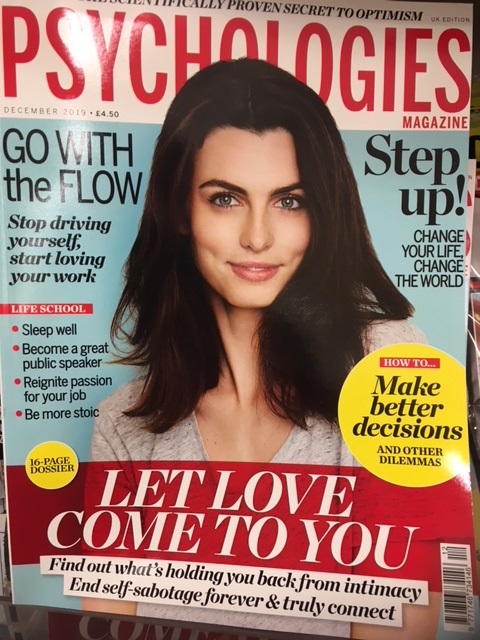


Diversity blocks free speech Posted January 15th 2020
Stephen King has faced criticism for his comments on diversity in the art world, which one director called “backward and ignorant”.
The writer spoke out on Twitter on Tuesday, the day after the Oscars nominations were announced – and denounced for their lack of diversity.
King was invited in 2012 to join the Academy of Motion Picture Arts and Sciences, which oversees the Oscars.

© Provided by The Independent “As a writer, I am allowed to nominate in just 3 categories: Best Picture, Best Adapted Screenplay, and Best Original Screenplay. For me, the diversity issue – as it applies to individual actors and directors, anyway – did not come up. That said…” he wrote, adding: ”…I would never consider diversity in matters of art. Only quality. It seems to me that to do otherwise would be wrong.”
BondAge Posted January 9th 2020
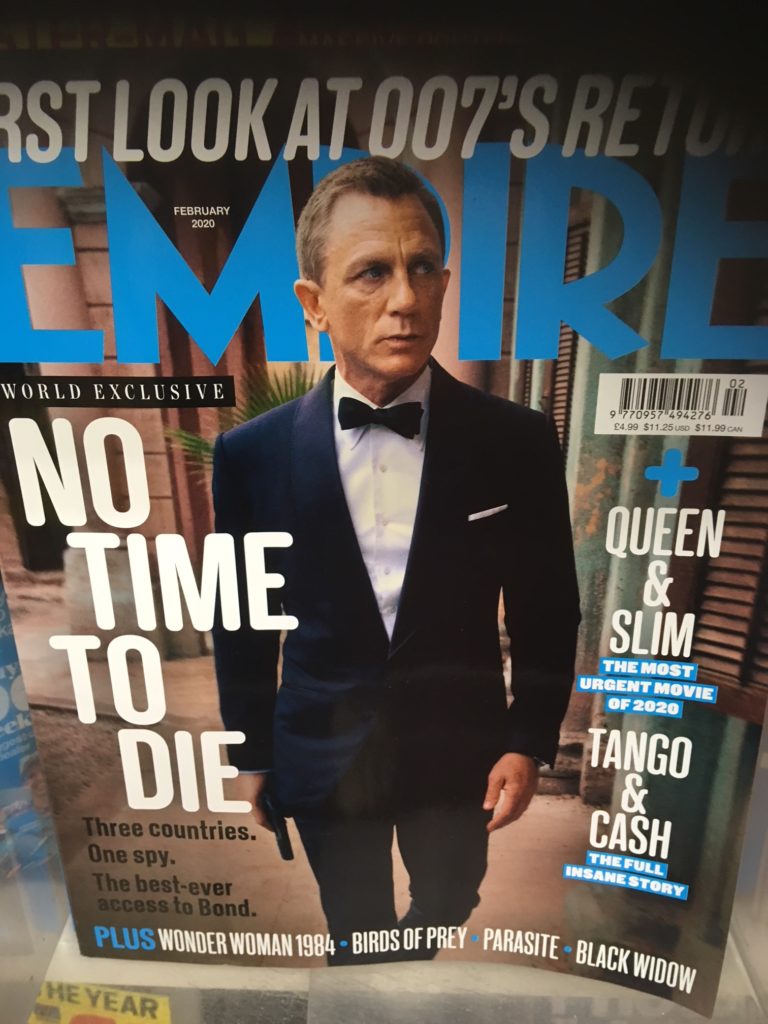
BBC Big Brother Calling Posted January 4th 2020

Robbie Gibb, who previously worked as a head of political programming at the BBC before becoming Theresa may’s head of comms, has now hit out at his former employer for failing to address the rising sense of distrust among the public.
Writing in the Daily Mail, Mr Gibb cited Radio 4’s Today programme, which features discussions and interviews on news and current affairs, as a key example.
He also criticised Tony Hall, the director-general of the BBC, for his weak response to the wave of complaints.
Mr Gibb said: “The fact the BBC received a record 24,435 complaints in just a two-week period during the election campaign should be cause for concern at the BBC. It is unwise for Lord Hall to dismiss these concerns so casually.
“Nowhere is impartiality more important than Radio 4’s Today programme, but its election coverage was a masterclass in why the BBC is losing the trust of its audience.
“Trapped by its own woke ‘groupthink’, Today — or Radio Misery as my friends increasingly call it — bombarded its listeners with a relentlessly negative and sneering tone and painted a picture of Britain that was monstrously out of touch.”
Lord Hall had said the fact that complaints came from people with different political options showed “we were doing our job without fear of favour”.
But Mr Gibb rubbished this claim, insisting that scathing reviews from all corners was not a reason to believe coverage was fair.
Royal Flush Posted November 23rd 2019
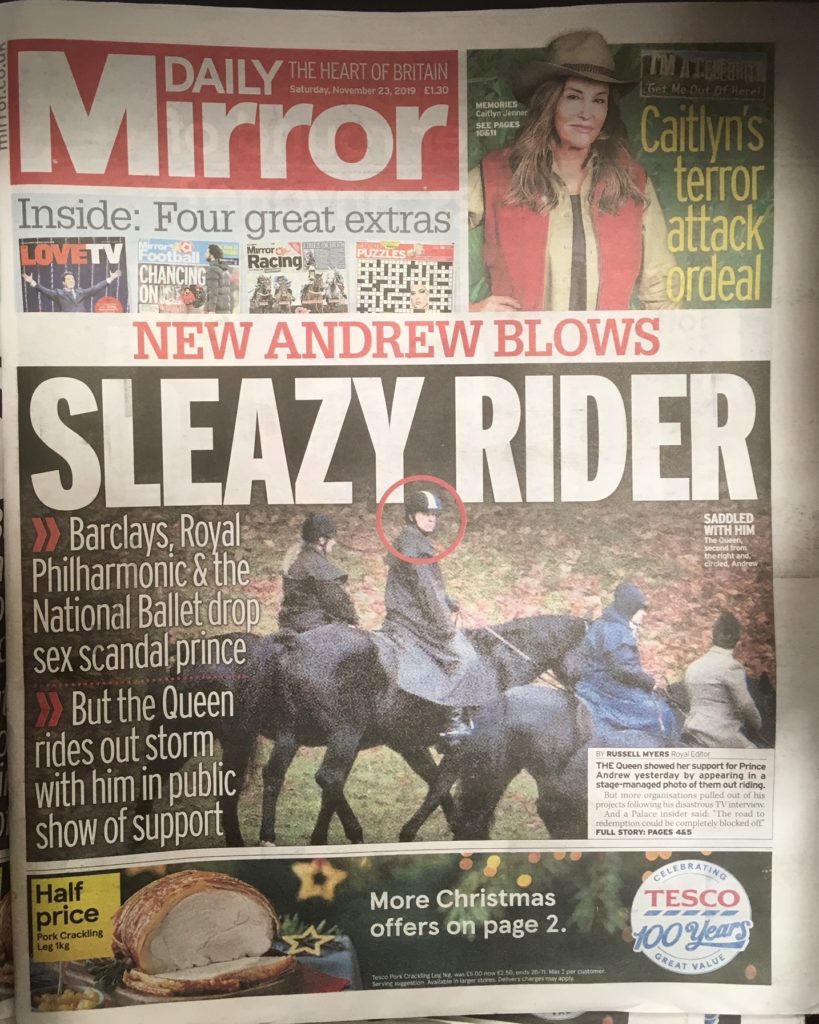
Girl Talk October 17th 2019
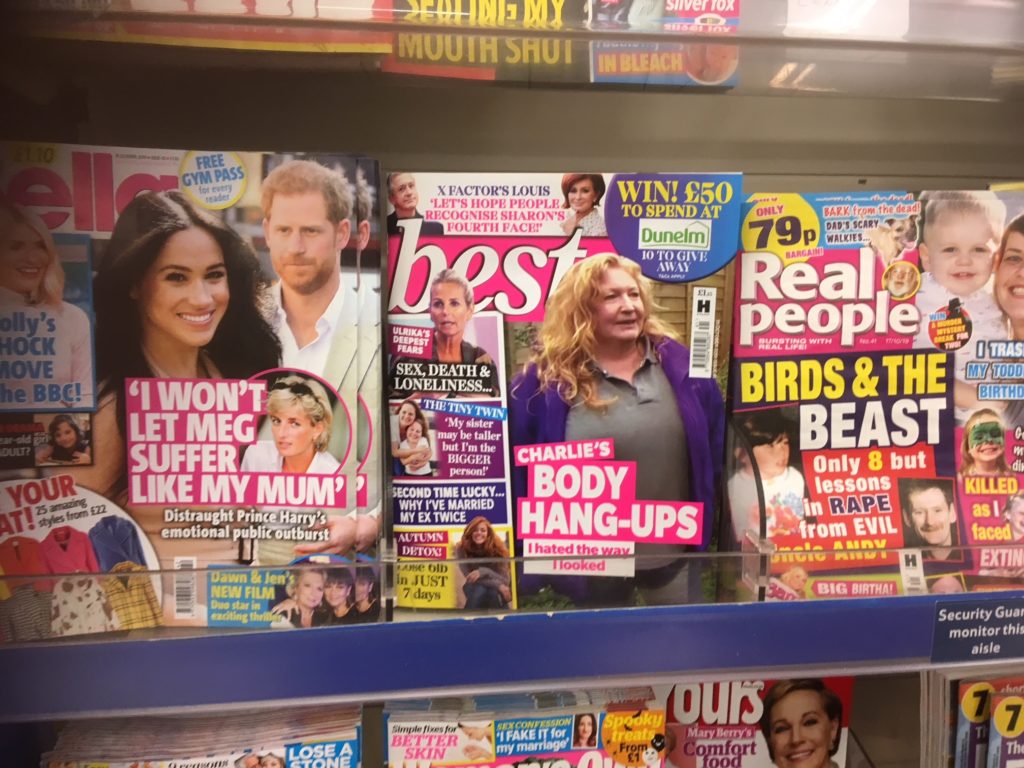

The President is Missing October 16th 2019
I am just taking a break from reading a novel by Bill Clinton and James Patterson- I am a great fan of the latter and love a great crime fiction writer. The book is called ‘The President is Missing.’
Crimes are like volcanoes, natural phenomena. They stand out a mile. The fault lines on which they so proudly and threateningly stand are not often so obvious.
Anywhere along these lines we might expect earth quakes and ooze, like the subtle and powerful crimes of the ruling elite, bankers, media moguls plus lackeys and police will often abuse their positions to enrich themselves.
So I have taken a short break from reading because I just came across the following paragraphs, words spoken from the President’s viewpoint :
‘ Participation in our democracy seems to be driven by the instant gratification worlds of Twitter, Snapchat, Facebook, and the twenty four hour news cycle. We’re using modern technology to revert to primitive kinds of human relations.
‘The media knows what sells- conflict and division. It’s also quick and easy. All to often anger works better than answers; resentment better than reason; emotion trumps evidence. A sanctimonious one liner, no matter how bogus, is seen as straight talk, while a calm, well argued response is seen as canned and phony. It reminds me of the old political joke: “Why did you take such an instant dislike to people? ” It saves a lot of time. ‘

‘
Shane Gillis: Saturday Night Live’s new hire fired for slurs Posted September 17th 2019
US comedy sketch show Saturday Night Live has dropped a new cast member after videos surfaced online of him making slurs about Chinese people.
Shane Gillis, 31, came under fire soon after his casting was announced when footage resurfaced from a podcast featuring the comic.
“After talking with Shane Gillis, we have decided that he will not be joining SNL,” said an SNL spokesman.
Gillis wrote on Twitter that he respected the show’s decision.
BBC Elite Fears Rise of Populism August 22nd 2019
The BBC started life as The Ministry of Information and that is what it still is, though the clever people and political elite who run it are very sophisticated. George Orwell, unfit for active service after fighting the Facists during the Spanish Civil War, spent a while working for them, coming to the conclusion that they were not the best of worlds. I have also done some insigmificant work for the BBC.

Orwell decided he would be better employed living in Hertfordshire and writing indepedently. His definitive work ‘1984’ and ‘Big Brother’ society has increasing relevance today.
Lord Reith was the BBC’s first boss. The job has always gone to the upper crust. Reith’s name lives on with the eponymous Reith Lectures. Today, I watched another upper crust fellow deliver the first of his Reith Lectures.
First let’s look at a few biog details of this great establishment person. Jonathan Philip Chadwick Sumption, Lord Sumption, OBE, PC, FSA, FRHistS (born 9 December 1948), is a British author, medieval historian and former senior judge. He was sworn in as a Justice of the Supreme Court on 11 January 2012, succeeding The Lord Collins of Mapesbury.[1] Exceptionally, he was raised to the Supreme Court bench directly from the practising bar, rather than from prior service as a full-time judge. He retired from the Supreme Court on 9 December 2018 upon reaching the mandatory retirement age of 70.
Sumption was the elder son of Anthony Sumption,[7] a decorated naval officer and barrister, and Hilda Hedigan; their marriage was dissolved in 1979.[8] He was educated at Eton College and Magdalen College, Oxford, graduating in 1970 with a first in History.[9][10] He was elected a fellow of Magdalen College teaching and writing books on medieval history, before leaving to pursue a career in law.[9] He was called to the bar at Inner Temple in 1975 and subsequently pursued a successful legal practice in commercial law.
In the 1970s, Sumption served as an adviser to the Conservative MP and cabinet minister Keith Joseph,[11][12] He wrote parts of Joseph’s controversial 1974 Edgbaston speech, which was generally thought to have doomed Joseph’s chances of becoming leader of the Conservative Party.[11][13] Sumption and Joseph also co-wrote a 1979 book, Equality, in which they argued that no convincing arguments for an equal society have ever been advanced and that no such society has ever been successfully created.[12] In the late 1970s Sumption was a regular contributor to The Sunday Telegraph.
The Guardian once described him as being a member of the “million-a-year club”, the elite group of barristers earning over a million pounds a year.[16][9] In a letter to The Guardian in 2001, he compared his “puny £1.6 million a year” to the vastly larger amounts that comparable individuals in business, sports and entertainment are paid.[16]
For a four-week trial (and all the preparatory work) in the UK in 2005 he charged £800,000 to represent HM Government in the largest class action in the UK, brought by 49,500 private shareholders of the collapsed national railway infrastructure company Railtrack.[17] The Government had money and reputation at stake. The case examined some of the actions of the government, especially of former Transport Secretary Stephen Byers. Byers became the only former Cabinet Minister to be cross-examined in the High Court in relation to his actions in modern times. The UK Government won the case.
With all of this in mind, it is not surprsing that Sumption is once again wheeled out by the BBC to talk about threats to our so called democracy and what threatens it, under the polite guise of the Reith lectures, where his clipped tones were regularly lubricated by a rather affected routine of sipping water from what was probably a crystal glass.
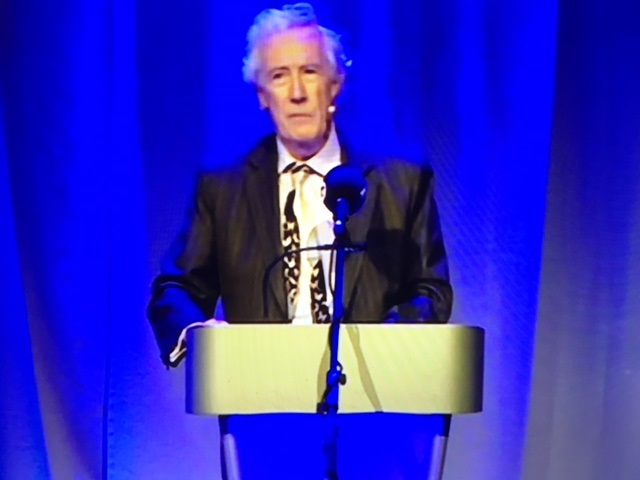
Lord Sumption- though the name Lord Presumption might suit him better- had much to say. Here is my summary of what this patronising long winded elitist said.
Political elites and career politicians have their uses, bringing breadth of experience, wide ranging view and sound judgement. Matters like Brexit should be entirely in their hands. He said ‘I am not going to express an opinion.’ Implying that he was offering only facts. Because 48% of those voting in the Brexit referendum voted remain, he said that it would not be democratic to leave the EU.
He did not balance this statement of what he calls truth with mention that the ground breaking and society destroying Thatcher landslide in 1979 was based on her party winning 40% of votes cast by the 60% of the electorate who bothered to vote for her.
Of course it is easy to deride and ignore those who don’t bother to vote as apathetic, rather than resigned to our sham democracy and the hopelessness of their lives.
Many years ago, back in 2003, I was a frequent guest on BBC Radio Solent’s live Saturday morning Peter White Show. Among other things we were discussing whether or not postal voting would increase voting. When Peter turned to me for an opinion, I said : “Can I start my answer with a joke? There was this man laying outside the House of Commons on St Stephen’s Green, very badly beaten up. Out comes a New Labour MP, bends down looking at the man, then says; ‘My God, you are in a terrible state. Whoever did this to you needs help. I must go and find him.’ Moments later a Tory comes out, looks down at the prostrate man, saying; ‘My God, you are in a terrible state. You need help. I must get help before you die.’ Off goes the Tory who is soon followed by a Liberal Democrat who bends down to the man, whispering in his ear; ‘Before I say anything, what did the other two fellows say?’ “
As someone who served for nearly twenty years as a senior member of my local council and was selected as a prospective parlaimentary candidate for the Lib Dems, I know a little of the career politcians ilk. John Bercow is also my local MP, which has enhanced my understanding and contempt for career politicians and hypocrits even more.
Smoothy Lord Presumption went on to tell us that political parties are creatures of national democracy. He falsely claimed that Britain invented democracy- yet also calims to be a historian.
He argued that this democracy has brought us, among other goodies and freedoms, a Freedom of Information Act, releasing documents unless it is not in the national ( by which he means Ruling Class ) interest to do so. These parties have to bid for support from a diverse group of MPs and an even more diverse electorate.
Much more of this and it would be more honest to call this a Wreath Lecture as Britain’s claim to democracy is rather like the Monty Python Parrot sketch: It is flaming well dead, no matter how stifly one might glue it upright to its perch- assuming it was alive in the first place, which I doubt.
Like the Monty Python Parrot, British Democracy has always been a con, sold by unscrupulous sales persons like Thatcher and Blair with help from spin doctors like Ed Balls.
It won’t matter how many feminists like posh Harriet Harman or self righteous Yvette Cooper you put in the Commons via women only short lists, it is still the House of Privilge and Disdain for the working class masses who are supposed to feed their egos with dreams of being on some awful reality TV show or a revamp of Jeremy Kyle.
Robert Cook August 22nd 2019
Control in a mass society August 8th 2019
The traffic was and always is awful on the M25, especially first thing. BBC Radio 4 ‘Today’ programme helps pass the time, though its smug comfortable overpaid out of touch presenters can be irritating, but always amusing because of these qualities. It is not the warm friendly harmonious programme as it was inj the days of Jack Demanio.
They never see themselves as part of the problem, always part of the solution. Their main concerns seems to be the gender pay gap and promoting fake Brexit. They are typical voices from privilged patronising public service broadcasting.
Yesterday they were lamenting the massive decline in viewers for terrestial BBC and ITV channels, in spite of all the wonderful home grown content. They were especially concerned by the decline in younger viewers who spend, on average, watching little more than an hour each week- preferring Netflix and YOU TUBE.
I suggest that the home grown content is far too patronising, politically correct and with messages meant to be subliminal but obviously loaded. So called new drama. with doyens like Dame Judy Dench, Helen Mirren and Sarah Lancashire rather predicatble and sickly to thev taste of most of us. The scripts are written by comfortable people, usually English literature grads, some writers hand picked from the ‘underprivilged groups’ like feminists.
I watched one nauseating Channel 4 production being partly filmed in my now twee home town of Winslow, I saw and talked to a production crew whe were from very different world to the one most of us live in. The production was called ‘The Little Visitor’ with story revolving around life in a big country house from long ago and far away, like these fim makers. Humourless and pretentious, like the book it was based on in my view.

The article below explains much of the mind set and why mainstream TV is primarily and overtly about social control. It talks down to the masses.
What is the future of public service television?
Jane Martinson Ofcom believes PSB is in good shape – but decisions on the BBC and Channel 4 could transform the landscape @janemartinson
Sun 25 Oct 2015 18.08 GMT Last modified on Wed 29 Nov 2017 08.34 GMT
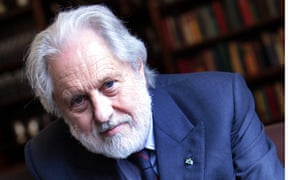
David Puttnam is launching an inquiry into public service television Photograph: Rex Features
Before they started at secondary school two years ago, my older children regularly read the sports pages over breakfast or cuddled up to watch The X Factor on a Saturday night. Nowadays, they constantly scroll through Instagram and YouTube on phones that appear to have been grafted on to their fingers. The biggest threat to public service television is there, live and kicking, in my front room.
Where do they get their news from? Or learn about the world? Surely not just from videos of how to paint nails in ever weirder ways, or from vlogs on how to beat their mates at imaginary football games?
Their ability to make and share video content or communicate with their friends and the world beyond is infinitely greater than mine ever was. But just how good, for want of a better word, is that content? Does it make them better citizens as opposed to just bigger consumers with a lot more choice?
It’s hard to be sure. Research on the behaviour of the i-generation born after 2000 is relatively limited. We know that their slightly older peers watch far less television than their parents did. Among 16-24 year olds, viewing of live TV news dropped by 29% between 2008 and 2014.
Public service television isn’t all about news, of course. Ofcom has a marvellously rounded definition of the term as “high-quality content, made for as wide a range of audiences as possible, and for public benefit rather than purely commercial ends”. It adds “diversity” and “plurality” and the need to “reflect and examine society as a whole”. Lord Reith boiled it down to “inform, educate and entertain”.
The entire debate probably sounds as Victorian to my children as my own grandmother’s description of pounds, shillings and pence did to me. Teenagers may well scoff at the idea of public service broadcasting (PSB), a vague thing that encompasses children’s content as well as religious broadcasting, arts and culture. Isn’t most of that for old people anyway? But what about national sporting events? Or homegrown drama about British lives, wherever they are?
Analysts at Ofcom, which published its public service broadcasting review in June, think it possible that once this generation reach 35, possibly with children of their own or at least less money or desire to go out every night, they could start watching more public service content on a range of platforms. But this appears less than scientifically based.
It seems clear that Ofcom’s overall view that “public service broadcasting is in good shape” with a relatively robust advertising market in television is only true for the next decade at most.
Some will argue that parental concerns about technology are akin to previous generations worrying about boy bands. Yet, decisions being made over the next 18 months – about the future of the BBC and Channel 4 but also the purpose of public service broadcasting – could help create a very different environment whether we like it or not.
The government is looking at the BBC, as is the House of Lords. Yet Labour peer and filmmaker Lord Puttnam is right to launch a broader inquiry into the nature, purpose and role of public service television today and I’m glad to be a member of the advisory committee. There are huge, broad questions to be asked and now seems as good a time as any to ask them.
The first may be why we still need public service broadcasting, or whether it should continue to come from the main public service channels which currently dominate. With investment in new, UK-originated content by these channels down by over £400m in real terms between 2008 and 2014, according to Ofcom, this might be a moot point anyway.
Education, arts and religion saw the biggest real-term declines, though the smallest overall totals. Yet in those areas, other providers have stepped in: Sky Arts in cultural provision, for example, or, in the field of formal education training, the teacher network run by the Guardian where professionals share resources.
But what about the impact of commercial competition in televised sport?
As many fans have argued, including my colleague Barney Ronay, the battle to broadcast Premier League football has ended up with consumers spending the same and getting less sport for their money.
And for those who argue that choice and competition will provide, it seems wise to point to the financial services industry. That didn’t work terribly well either, did it?
There are obvious hazards ahead, but the more questions we ask now, the better.

